- Why Trek With Us
- Legal Documents
- Terms & Condition


Viber/Whats App
Enjoy your trip, everest three pass trek.
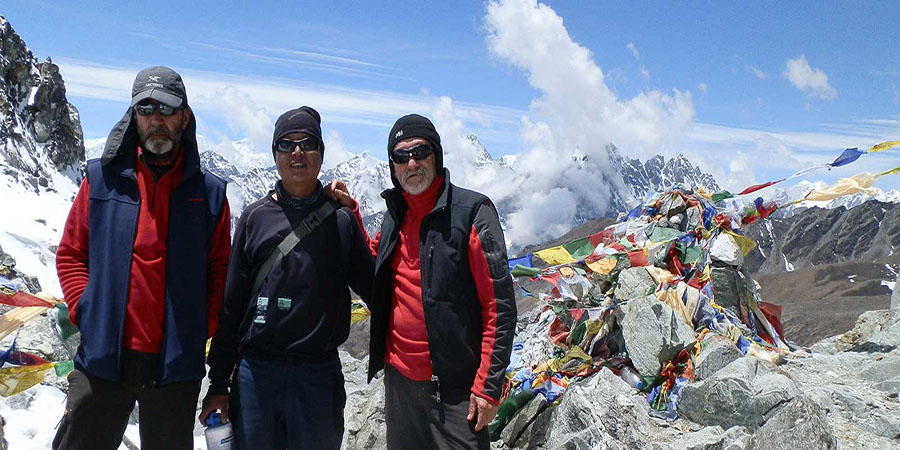
Three Passes Trek in the Everest region is one of the most adventurous, challenging, and extremely popular trekking trips in the Everest (Khumbu) region of Nepal which includes 3 high passes; Renjo La Pass (5,360m), Cho La Pass (5,420m) and Kongma La Pass (5,535m). Along with these other highlights of this trek are Gokyo Valley, Khumbu glaciers, Gokyo Lake, Kalapatthar, hidden Monasteries, Sherpa villages- Marlung and Thame where you can explore the hidden natural and cultural beauty of the Everest region, and Everest Base Camp. Three Passes Trek quenches the desire of adventurous trekkers who want the most challenging and adventurous trekking once in their life. During this trek, you can have a breathtaking view of the world’s highest mountains- “Mount Everest” (8,848m), Makalu (8,463m), Lhotse (8516m), and Cho Oyu (8201m). During this trek, you also pass through the Sagarmatha National Park where you can see different flora and fauna, wild animals and birds, pine trees, and rhododendron flowers forest.
Three Passes Trek is the ultimate Everest experience in the Khumbu Himalaya range. It is a great fusion of the highest passes in the region; offering incredible scenery, challenging high-altitude trekking, and coming into contact with the Sherpa people and their unique culture. This adventurous trek begins after you reach the Lukla airport which is located at an altitude of 2,866 meters.
From Lukla, this trek follows the classic trail to Namche Bazaar and from Lungden we cross the Renjo La pass where we can enjoy stunning views of the majestic views of high peaks like Mt. Everest, Mt. Lhotse, Mt. Makalu, and Mt. Cho Oyu. Also, admire the third major Gokyo Lake (among five) - Dudh Pokhari, and the Gokyo village. From Thagnak, we trek towards Dzongla via Cho La Pass enjoying the views of the mountains of Ama Dablam, Cholatse, Lobuche East, and Baruntse including the others from the top.
Finally, we cross the last pass of trek-Kongma La Pass. From the top, witness the magnificent views of Lhotse, Lhotse Shar, Makalu, Baruntse, and Ama Dablam. Then, return to Lukla airport to fly back to Kathmandu. Hence, crossing three spectacular high passes between the altitude of 5,330 meters and 5,535 meters with the view of breathtaking high mountain scenery makes this trek challenging and rewarding that surely leaves you with memories to cherish all lifelong.
- Adventurous, challenging, and popular
- Explore colorfully, culturally rich Namche Bazaar
- Acclimatize day en route
- Trek through 3 passes Renjola Pass (5,360m), Cho La Pass (5,420m), and Kongma La Pass (5,535m)
- Unique culture and lifestyle of the Sherpa people
- Sparkling, pristine blue and green waters of the Gokyo Lakes in the Gokyo Valley
- World-renowned Khumbu Glacier, Khumbu Icefall
- Stunning sunrise view and witness the intense panoramic mountain views of Mt. Everest, Mt. Nuptse, Mt. Lhotse, Mt. Pumori, and Mt. Ama Dablam from Kala Patthar
- Visit the vintage Tengboche Buddhist Monastery
Short Itinerary
Day 01: Arrival in Kathmandu, transfer to hotel. Day 02: Flight from Kathmandu to Lukla (2866 m) and trek to Phakding (2638m) Day 03: Phakding to Namche Bazaar (3440 m) Day 04: Acclimatization day Day 05: Namche Bazaar to Thame (3800m) (4 – 5 hrs.) Day 06: Thame to Lungden, (4380m) (7– 8 hrs.) Day 07: Lungden via Renjo La pass (5360m) to Gokyo (4800 m) (8 – 9 hrs.) Day 08: Gokyo – Ascent Gokyo Ri, (5357 m) Day 09: Gokyo to Thagnak (4750 m) (5 – 6 hrs.) Day 10 : Thagnak via Cho La Pass (5420m) to Dzongla (4830m) (7 – 8 hrs.) Day 11: Dzongla to Lobuche (4940 m) (4 – 5 hrs.) Day 12: Lobuche to Gorakshep (5170 m) to Everest Base Camp (5364 m) (8 – 9 hrs.) Day 13: Gorakshep – Kalapatthar (5,644 m), back to Lobuche (4940 m) (7 – 8hrs.) Day 14: Lobuche via Kongma La Pass (5535m) to Chhukung (4730m) (6 – 7 hrs.). Day 15: Chhukung to Tengboche (3867 m) (5 – 6 hrs.) Day 16: Tengboche to Namche Bazaar (5 – 6 hrs.) Day 17: Namche Bazaar to Lukla (6 – 7 hrs). Day 18: Fly to Kathmandu Day 19: Final departure
- All required land transportation as per required for trekking
- Hotel in Kathmandu with breakfast
- Domestic flight KTM-Lukla-KTM
- Sightseeing tour in Kathmandu Valley
- Foods and accommodation in trekking well equipped English speaking guide, necessary supporting Sherpa or Porters.
- All allowances for supporting crews including their insurance
- Trekkers Information Management System TIMS (Trekking permit), National Park permit o Conservation permit
- Emergency evacuation service if in case needed All Official taxes and service charge.
- Your personal gears and expenses
- Foods in Kathmandu
- Tip to Nepalese support crews
- Emergency rescue fee if in case
Detail Itinerary
Day 01: arrival in kathmandu, transfer to hotel.
Upon your arrival at the Tribhuvan International airport, the representative of Destination Himalaya treks gives you warm welcome in the adventurous Himalayan country Nepal. Overnight in a hotel.
Day 02: Flight from Kathmandu to Lukla (2866 m) and trek to Phakding (2638m)
Around 45 minutes flight, early in the morning we take a scenic flight to Tenzing-Hillary Airport, Lukla. Then, we start our trek and head to Phakding. We cross the Chauri kharka village and climb down to Dudh Koshi River and follow the bank of the river in the valley. Unnamed vegetation and seasonal flowers, pine forests, and wild animals with domestic animals are the major attraction of the trekking trail of Phakding. We finally ascend to Phakding. There we also visit the Monastery. The centuries-old monasteries around Phakding add to the beauty of the village. Overnight in Phakding.
Day 03: Phakding to Namche Bazaar (3440 m)
Crossing the suspension bridge and walking on the bank of Dudh Koshi is the usual activity of your trekking. Moreover, your entry to the Benkar village with the superb views of Mr. Thamserku is really spectacular. The Monjo is the entrance of the world’s highest national park, “The Sagarmatha national park”. In the national park, we can see various flora and fauna. If lucky, we can also see various rare wild animals and birds like Red pandas, snow leopards, wild boars, etc. From there, continue to Namche. Overnight in Namche.
Day 04: Acclimatization day
Namche is the first acclimatization place of our trekking. Namche bazaar is famous for many things. Most of the government offices lie in Namche. Furthermore, it is the doorway to the total Everest region. Namche bazaar is surrounded by snowy peaks and mountains, which can be seen from the various hotels stated in Namche. Tourist visitor centers, and long old monasteries, are the attraction of Namche. Email-internet, ATMs, glossary shops, bakeries, and restaurants, are easily available in Namche bazaar. We take a rest at Namche bazaar visiting the surrounding places. Namche is the Sherpa village where we can interact with them and get knowledge of their culture and lifestyle. On this day, we also visit another Sherpa village Khumjung near Namche. There we also visit the Buddhist monastery. Overnight in Namche.
Day 05: Namche Bazaar to Thame (3800m) (4 – 5 hrs.)
Thame lies at the end of Khumbu valley. Traverse Bhote Koshi river and pass the forested trail of pine and rhododendron. Pass the Thamo Gomba and walk on a steep trail to reach Thame. Overnight stay.
Day 06: Thame to Lungden, (4380m) (7– 8 hrs.)
Admire the lovely landscape, vegetation, and mountain vistas en route to Lungden. Traverse through Taranga, and Marlung to arrive at Lungden. Explore the beautiful Nakpa valley or hike to nearby Cho Relmo Lake at Lungden. Overnight stay.
Day 07: Lungden via Renjo La pass (5360m) to Gokyo (4800 m) (8 – 9 hrs.)
The exciting trek to Gokyo via Renjo La Pass is the first pass of the trek. Walk slowly and reach the summit of Renjo La. From there, enjoy the stunning views of majestic views of high peaks like Mt. Everest, Mt. Lhotse, Mt. Makalu, and Mt. Cho Oyu. Also, admire the third major Gokyo Lake (among five) - Dudh Pokhari, and the Gokyo village. Then, slowly descend and enter the Gokyo. Overnight stay.
Day 08: Gokyo – Ascent Gokyo Ri, (5357 m)
Today we explore the beautiful Gokyo. We view the largest Ngozumpa Glacier and the glacial moraine formed due to the Ngozumpa glacier. Exploring the other locations in the surroundings such as the third, fourth, and fifth Gokyo Lakes. Then, ascent Gokyo Ri. From the top, the views of Gokyo valley and Gokyo Lakes are phenomenal. Also, the breathtaking views of Everest, Cho Oyu, Lhotse, Nuptse, and Makalu are exceptional. Descend after witnessing the spectacular views. Overnight stay.
Day 09: Gokyo to Thagnak (4750 m) (5 – 6 hrs.)
We leave the beautiful Gokyo to move ahead in our trek. We have a short yet bit challenging side trip to the other side of the mighty Ngozumpa glacier. Past the first and the second lakes, the trail takes us to the east, the other side of the glacier through the steep pass. We then arrive at our destination Thagnak. Overnight stay.
Day 10: Thagnak via Cho La Pass (5420m) to Dzongla (4830m) (7 – 8 hrs.)
Thagnak is a small and lovely village with few houses. The trek starts with a gentle long uphill that becomes stiff before the ascent to the challenging Cho La Pass (5,420m). The pass connects the villages of Thagnak and Dzong La. The trail moves past the frozen lake to the Pass decorated with prayer flags. The marvelous view of the mountains of Ama Dablam, Cholatse, Lobuche East, and Baruntse including the others from the top of the pass is an amazing treat to the trekkers. The ice-greased trail may make the descent down to Dzong La a challenging one. The use of crampons for crossing Cho La Pass may be necessary depending on the weather condition. Overnight stay.
Day 11: Dzongla to Lobuche (4940 m) (4 – 5 hrs.)
Today’s section also serves as the preparation for stepping into the vicinity of the Everest Base Camp the following day. Through the ridges, on the edge of Awi Peak, we pass through the Cholatse Lake perched above the Cholatse Glacier. We join the busy trail from Tengboche to Lobuche as we turn left towards the Lobuche. As we continue our uphill climb, we have spectacular scenery in front of us wherein the majestic Nuptse seems to be rising above the Khumbu glacier. Overnight stay.
Day 12: Lobuche to Gorakshep (5170 m) to Everest Base Camp (5364 m) (8 – 9 hrs.)
This day we achieve our goal of putting our foot on the Everest base camp. From Lobuche, we walk up a rocky moraine path with a view of the Khumbu glacier. Then, we descend to Gorakshep where we take lunch. Then we head to Everest base camp. At Everest base camp, we stay for some time and observe the view of the surrounding mountains including Pumori, Ama Dablam, Nuptse, Lhotse, etc. Then, we return to Gorakshep where we stay overnight.
Day 13: Gorakshep – Kalapatthar (5,644 m), back to Lobuche (4940 m) (7 – 8hrs.)
This day in the morning we hike to Kalapatthar to view the panorama of Mt. Everest. Kalapatthar is the perfect vantage point of the Everest region for Mountain View. From there, we observe the panoramic view of Mt. Everest and other mountains of the Everest region like Mt. Lhotse, Mt. Pumori, Mt. Ama Dablam, Mt. Khumbutse, Mt. Nuptse, Mt. Thamserku, etc. Then, we return to Gorakshep. There we take lunch and then back to Lobuche for an overnight stay.
Day 14: Lobuche via Kongma La Pass (5535m) to Chhukung (4730m) (6 – 7 hrs.)
We head towards Chhukung via Kongma La Pass. The last among the three passes is at an elevation of 5535m. One of the most difficult passes to trek but with proper planning and walking carefully we can achieve it. Climb Kongma La and from the top witness the magnificent views of Lhotse, Lhotse Shar, Makalu, Baruntse, and Ama Dablam. Descend to the eastern side and enter the lovely Chhukung village. Nowadays, this village is a popular acclimatization destination as an entry point for Peak climbing. Overnight stay.
Day 15: Chhukung to Tengboche (3867 m) (5 – 6 hrs.)
An easy trek as we descend through Imja Khola valley traversing several villages such as Dingboche, and Pangboche, to enter the village of Tengboche. Witness amazing vistas such as Ama Dablam, Everest, Nuptse, and Lhotse. We can’t miss visiting the largest vintage Tengboche Monastery. Overnight stay.
Day 16: Tengboche to Namche Bazaar (5 – 6 hrs.)
We head towards Namche following the forested trail. Then, a steep climb takes us to a place with chortens and prayer flags. Adoring the natural scenery, arrive at Namche Bazaar. After long days of trekking, you can enjoy continental cuisine and hot coffee or bakery items at Namche. Overnight stay.
Day 17: Namche Bazaar to Lukla (6 – 7 hrs.)
We descend the trail slowly and cautiously due to the steep path and the shaky leg owing to the long trekking we earlier had. The magic of nature unfolds through the colorful rhododendron and pine forests, plains, and the amazing view of the snow-capped mountains that seem to be overlooking the trekking route. Sherpa villages, Buddhist culture reflected through the prayer flags, prayer stones, and Gompas, and lush vegetation make the trekking an enriching one. We stretch ourselves in this Sherpa town and recall the experiences gained during the strenuous yet amazing trekking. Overnight stay.
Day 18: Fly to Kathmandu
Our trekking comes to an end today. We fly back to Kathmandu and you are transferred to the hotel of your stay before you depart to your respective destinations. Overnight in a hotel.
Day 19: Final departure
You are escorted to the Tribhuvan International Airport (TIA) at least three hours before your scheduled international flight. We hope that this trip has created a fond memory of this amazing Himalayan nation and you have the urge to come again to this beautiful nation.
Travel Info
Accommodation
Accommodation in the Himalayas is mostly teahouses or lodges operated by locals. They are comfortable and simple with basic facilities. Extra facilities like hot showers, Wi-Fi, charging of electronic devices, and laundries are available by paying additional charges. Room sharing is common during the peak seasons and at high altitudes. So, prepared for it. Washrooms are mostly outside the teahouse or lodge.
We provide only breakfast in Kathmandu and 3 meals (breakfast, lunch. dinner) a day are provided during the entire trek. Meals are provided from the teahouses or lodges which is simple but organic and healthy. Nepali Dal Bhat is a chief dish with fresh green vegetable curry. Besides, noodles, soup, bread, roti, Sherpa stew, and hot drinks are also available. You can try continental cuisine at Namche at your own expense.
Drinking Water
Drinking water in the Himalayas is pure and fresh. One can directly drink the natural freshwater stream from the Himalayas. Or fill up the boiled water in a water bottle in the teahouses paying an extra charge. Always carry water purifying solutions for proper water treatment and to be safe. Drink plenty of water and keep yourself hydrated to prevent altitude sickness.
Internet connectivity & Mobile Network
Everest Link’s Wi-Fi card provides internet all over the Everest region. So, internet connectivity is easily available and stable in the lower regions. Mobile Network is also stable in the lower regions. You can also purchase a Sim and use mobile data from it. In higher altitudes, internet connectivity and mobile network are difficult to find.
Starting and Ending Point
Lukla is the starting and ending point for most trekking or climbing in the Everest region.
"Lukla-Phakding-Namche-Thame-Lungden-Gokyo Valley-Thagnak-Dzongla-Lobuche-Gorakshep-EBC-Gorakshep-Kalapatthar-Lobuche-Chhukung-Tengboche-Namche-Lukla"
Required Permits
Permits are mandatory in the Himalayas of Nepal. Our required permits are Khumbu Pasang Lhamu Rural Entrance
Permit, and Sagarmatha National Park Permit (SNP).
- Khumbu permit costs NPR 2000 (Foreigners), NPR 1000 (SAARC)
- SNP permit costs NPR 3000 (Foreigners), NPR 1500 (SAARC)
Click here to learn more about Trekking Permits. "DH Treks issues all the required permits for it's clients."
Travel Insurance
Travel Insurance is quintessential in the Himalayas. It must cover all emergency evacuation, medical extremities, luggage loss/theft, flight cancellations, altitude above 4000m, etc. Since this three passes trek is one of the challenging treks, travel insurance is compulsory. Thus, arrange travel insurance from a reputed agency as it is compulsory.
Safety and our guides
We assure you 100% when it comes to safety. Our client’s safety is our main concern. Our guides are certified and well-trained with years of expertise in this field. They are technically competent and have excelled in safety performance. They always carry essential safety equipment, gear, and first-aid kits. For the safety of our trekkers, the itinerary is properly scheduled and acclimatization rest days are properly set up to adjust to the high altitude and prevent altitude sickness. If any queries concerning safety, feel free to share them with our guides. We are always there for your services.
Best time for Everest Three Passes Trek
The best time to trek is the peak season for safety and to enjoy the spectacular and clear views. Spring and Autumn seasons are the best time. Winter and rainy seasons are riskier. The trail becomes muddy, snowy, and slippery. Also, the chance of flight cancelation and not getting rooms is very high. Only a few adventurous trekkers dare to trek. If one wishes to, we recommend you plan carefully to trek during the off-season.
Everest Three Passes Trek Difficulty
Everest Three Passes Trek is challenging due to the long trek route, high elevations, and challenging three passes at high altitudes, but still, it is adventurous. With the proper assistance and guidance of experts, it can be completed. When it comes to Everest Three Passes Trek, experience in trekking at high altitudes is a bonus. Besides this, trekkers must be in good health, and physically, & mentally fit as it is physically demanding. So, we recommend you participate in exercises, day hikes, and physical training months before starting the trek. Also, take necessary health tests before trekking to high altitudes. You can completely trust our assistance and guidelines throughout the trekking journey.
Altitude Sickness & Acclimatization
Altitude sickness is common in mountains above the altitude of 3000m. The trek starts from Lukla (2866m) and the altitude rises to Kalapatthar (5,644 m) during the trek. Besides this, the three passes Renjo La Pass (5,360m), Cho La Pass (5,420m), and Kongma La Pass (5,535m) are other challenges and high elevations. Namche and Gokyo are the acclimatization resting places to adjust to the altitude and prevent altitude sickness.
Symptoms of Altitude Sickness Primary: Headache, nausea, gasping, appetite & sleep loss, dizziness, fatigue, vomiting Extreme: primary symptoms and hallucinations & unconsciousness
Preventive Guidelines
- Immediately inform the guide
- Warm-up, and body stretch before the trekking journey
- Drink water and Hydrate yourself at regular intervals
- Frequent urination throughout the journey
- Ascend slowly and gradually
- Take plenty of rest and sleep
- Avoid salty foods, alcohol, and smoking
- Descend immediately when it’s difficult/uneasy
- Take medicine consulting a guide
Shoes: Trekking shoes, base camp shoes, Rubber sandals Clothes: Windcheater jacket, Thermals, Down Jacket, Base Layers, Fleece, Long sleeve shirts, Gloves, Towels, Inner garments, Trekking pants, Trousers, Shorts, Socks Accessories: Sunglasses, Ski Goggles, Hats/Caps, Beanie, Sunscreen, Lip Balm, Head Lamp, Trekking Pole, Pocket Knife, Personal Hygiene &Toiletries Sleeping: Mattress, Warm Sleeping bags Travel Bag: Duffel bag, a day pack, pack cover Medicine Kit: Wash Kit, First-Aid Kit, Blister Repair Kit, Medicines for preventing Altitude sickness, Prescribed Medicines (Personal use) Extras: Heat/Leak proof water bottles, Water Purifying solution (Iodine based), Water filters, Insulated cup/flask, Map, Binoculars, Travel Documents, Sewing kit, Cash, Extra batteries, Power bank, Pen, Diary, Book, Reusable (spoon, cup, plate), Reusable bags, Large Waterproof Disposable Bags, Snacks (Choco-bars, Mints, Nuts, Granola Bars)
Note: Customize and rent the above list as a necessity.
Add your Review
Similar packages, everest base camp trek, jiri to everest base camp trek, everest panorama trek, phaplu to everest base camp trek, gokyo lakes and gokyo ri trek, trip at a glance.

EVEREST THREE PASSES TREKKING ROUTE

EVEREST THREE PASSES
ROUTE GUIDE

Pin Tweet Share WhatsApp
A GUIDE TO THE TRAIL
In this guide we share detailed trail notes about the Everest Three Passes trekking route. This includes section distances and estimated trekking times, plus info about food, services, and accommodation options along the way. There is also a description of the trail and we offer a downloadable route map for online or offline use. As a visual accompaniment to this written guide you can watch our Everest Three Passes film, and for everything else you need to know to plan your trek, check out our Essential Guide To The Everest Three Passes Trek .
TREK OVERVIEW THREE PASSES FILM MAP & GPX DOWNLOAD THREE PASSES ITINERARY ELEVATION PROFILE
TREKKING ROUTE LUKLA → MONJO MONJO → NAMCHE BAZAAR NAMCHE ACCLIMATISATION DAY NAMCHE → PANGBOCHE PANGBOCHE → DINGBOCHE NANGKARTSHANG HIKE DINGBOCHE → CHUKHUNG CHUKHUNG RI HIKE CROSSING KONGMA LA LOBUCHE → GORAK SHEP KALA PATTHAR HIKE EVEREST BASE CAMP GORAK SHEP → LOBUCHE LOBUCHE → DZONGLHA CROSSING CHO LA DRAGNAG → GOKYO GOKYO RI HIKE CROSSING RENJO LA THAME → MONJO MONJO → LUKLA
*Some of the links in this post are affiliate links – if you purchase a product or service via these links, we may earn a small commission at no extra cost to you . This helps offset the cost of running this blog and keeps us travelling so that we can continue to produce great content for you. We greatly appreciate your support!*
EVEREST THREE PASSES TREK OVERVIEW
- DISTANCE | Approx 160 km (incl. acclimatisation/day hikes)
- DURATION | 17 – 22 days (incl. flying to/from Lukla)
- START/END | Lukla
- PERMITS REQUIRED | Khumbu Trek Card 2000 NPR; Sagarmatha National Park Fee 3000 NPR (SAARC nationals 1500 NPR / Nepali nationals 100 NPR)
- TREKKING SEASON | Best Seasons: April to Mid-May , October to Mid-November ; Shoulder Seasons: March, Late May, September, Mid-November to December ; Avoid: June to August, January to February
- TREK DIFFICULTY | Challenging
- ELEVATION GAIN/LOSS | +/- approx 13500 metres (incl. acclimatisation/day hikes)
- MAX ALTITUDE | 5611 m (Kala Patthar) or 5514 m (Kongma La)
- GUIDE MANDATORY? | Khumbu Pasanglhamu Rural Municipality has stated that it is NOT mandatory to trek with a guide in the Khumbu region
- ACCOMMODATION | Teahouses/Guesthouses in villages along the trail
- TREK COST | $34 – $140 USD per person, per day (budget independent trekker to fully inclusive package)
- RECOMMENDED TREKKING AGENCY | Himalayan Masters , Quote HOGG5 for 5% discount
DISTANCE Approx 160 km (incl. acclimatisation/day hikes)
DURATION 17 – 22 days (incl. flying to/from Lukla)
START/END Lukla
PERMITS REQUIRED Khumbu Trek Card 2000 NPR Sagarmatha National Park Fee 3000 NPR (SAARC nationals 1500 NPR, Nepali nationals 100 NPR)
TREKKING SEASON Best Season April to Mid-May October to Mid-November Shoulder Seasons March, Late May, September Mid-November to December Months To Avoid June, July, August January and February
TREK DIFFICULTY Challenging
ELEVATION GAIN/LOSS +/- approx 13500 metres (incl. acclimatisation/day hikes)
MAX ALTITUDE 5611 m (Kala Patthar) or 5514 m (Kongma La)
GUIDE MANDATORY? Khumbu Pasanglhamu Rural Municipality has stated that it is NOT mandatory to trek with a guide in the Khumbu region
ACCOMMODATION Teahouses/Guesthouses in villages along the trail
TREK COST $34 – $140 USD per person, per day (budget independent trekker to fully inclusive package)
OUR RECOMMENDED TREKKING AGENCY Himalayan Masters , Quote HOGG5 for 5% discount
EVEREST THREE PASSES TREKKING FILM
Get a sense of the Everest Three Passes trekking route in our ‘silent hiking’ style ambient film.
Watch the behind the scenes version of our Everest Three Passes trek on Instagram stories
Watch the behind the scenes version of our three passes trek on instagram stories .
Everest Three Passes Trek Stories
MAP & GPX DOWNLOAD
EVEREST THREE PASSES TREKKING ROUTE //
We have created a detailed Everest Three Passes digital trekking map to accompany this guide. The full trekking route is marked, including Everest Base Camp and Gokyo Lakes, along with day hikes around Namche Bazaar and Gokyo, and to Nangkartshang, Chukhung Ri, Kala Patthar, and Gokyo Ri. Alternative routes avoiding the passes are also marked, as is the overland route between Salleri and Lukla.
Detailed stats and an elevation profile are included for each route section. Guesthouse settlements and tea shops are also marked, as well as key sights and practical info such as checkpoints, hospitals, and transport hubs. Guesthouses as per our own trek itinerary are marked, including info about prices and services, phone numbers (where possible), and a copy of the menu. Photos are included with almost every pin.
You can use the digital map online, or download it for offline use with a mapping app such as Organic Maps, Maps.me or Gaia GPS. This is very helpful for navigation assistance on the trail. It allows you to quickly pinpoint key places and services along the way and calculate distances and elevation differences between destinations.
Note that while we’ve tried to be as accurate as possible when recording and mapping the route, changes on the ground are inevitable (especially on routes crossing glaciers) and this map should not be solely relied upon for navigation.
EVEREST THREE PASSES TREK ITINERARY
TREK ITINERARY
We have outlined below what we feel is an ideal itinerary for the Everest Three Passes trekking route. This is a 19 day itinerary which includes flying to and from Lukla. We have noted the trekking distance and an approximate trekking time for each day (excluding lunch stops, breaks, etc), as well as stats on elevation gain/loss and sleeping altitude.
Note that this itinerary outlines an anti-clockwise trekking route, crossing Kongma La first, and Renjo La last. You can read more about our thoughts on why this is the best direction to trek in the ‘Is it best to do the Everest Three Passes trek clockwise or anti-clockwise?’ section of our guide.
For a few alternative route options which you may wish to consider, check out this section of our guide .
If viewing on a mobile device or tablet, scroll to the right to see the full table or flip your screen to landscape mode
*On days 10 and 11 the standard itinerary that most people follow is to visit EBC after lunch at Gorak Shep, then hike up Kala Patthar in the dark for sunrise the next morning (when it is bitterly cold). If you swap these two around as per the above suggested itinerary, you are guaranteed to have a less busy experience at both EBC and on the trail up Kala Patthar. As the skies are usually clearer in the morning you are also likely to have better views at EBC, however it is possible that the views from Kala Patthar will be obscured by afternoon clouds. If you’re lucky and have clear afternoon skies, then you will be treated to a fiery sunset glow on Everest and the surrounding mountains. If you hike up Kala Patthar in the morning, your mountain views will be brief as the sun rises directly behind Everest and you’ll soon be looking directly into the sun.
OUR RECOMMENDED TREKKING AGENCY
We partnered with Himalayan Masters for our Langtang Valley, Gosainkunda, and Everest Three Passes treks, and found them to be very professional and committed to a high level of service
To enquire about booking your own trek, get in touch via email at [email protected] and mention the code HOGG5 to get a 5% discount off the cost of your trip
EVEREST THREE PASSES TREK ELEVATION PROFILE
ELEVATION PROFILE
The image below shows the elevation profile of the Everest Three Passes trek, starting and ending in Lukla and going in an anti-clockwise direction, crossing Kongma La first, Cho La second, and Renjo La third. The route shown here includes the various acclimatisation and side hikes outlined in this guide. Elevation is displayed in metres and distance in kilometres.

3D ROUTE MAP
Watch our 3D relief map video of the route to visualise the landscape and get a sense of the Everest Three Passes trek.
EVEREST THREE PASSES TREKKING ROUTE BREAKDOWN
ROUTE BREAKDOWN AND TRAIL DESCRIPTION
Below is the breakdown of the Everest Three Passes trekking route as outlined in the itinerary table above. Each day includes an overview, distances, elevation gain and loss, estimated trekking times without breaks, a detailed description of the trail, and info about food, services, and accommodation options.
The following route breakdown starts and ends in Lukla. For detailed information about the various ways of getting to/from Lukla, check out the the ‘How to get to Lukla’ section of our guide.
DAY 1: LUKLA → MONJO
Everest three passes trekking route day 1:, lukla → monjo, 12.6 km | + 1117 m / – 1148 m | 4.5 hours, + 1117 m / – 1148 m.
Today is a straightforward introduction to the trek. There are no lengthy ascents or descents and mostly wide stone paths to walk on, although there are plenty of short ups and downs throughout the day. There are a couple of checkpoints along the way and regular villages with guesthouses where you can eat or stop for tea. You’ll no doubt encounter plenty of pack mules and yaks – when letting them pass, be sure to wait on the side of the trail without a drop-off.

PLACES ON THE LUKLA TO MONJO ROUTE
The table below details the main guesthouse villages and services available along the route from Lukla to Monjo. On this section, there are also many smaller settlements and guesthouses that lie between those mentioned in the table. The distances and times noted cover the sections between the stops, not the total from the start.
If viewing on a mobile device or tablet, scroll to the right to see the full table or flip your screen to landscape mode.
Lukla → Phakding
7.5 km | + 472 m / – 687 m | 2.5 hours, + 472 m / – 687 m.
From the airport, the route leads through the town of Lukla, a bustling place with shop-lined streets and plenty of guesthouses and restaurants. Pass through the Pasang Lhamu Gate (celebrating the first Nepali woman to summit Everest) and at the bottom of the steps you’ll reach the Khumbu Trek Card registration desk.
It takes around 2 hours to trek from here to Phakding. The route leads downhill from Lukla before climbing towards Phakding, although there are plenty of flatter sections and some short ups and downs. The trail is mostly on wide stone paths, with a few bridges to cross along the way. You’ll pass through villages regularly and there are plenty of options for tea or food stops. There are also a number of mani stones and prayer wheels – be sure to walk on the left when passing these.
Phakding is a busy lunch spot and also a popular overnight stop for trekkers heading to Namche Bazaar. You’ll come to the main part of the village first, with a few more guesthouses situated across the bridge on the opposite side of the Dudh Koshi. Phakding is bigger than Monjo and tends to be the busier accommodation option. Continuing to Monjo means less people to share the trail with come morning.

Passing mani stones on the left between Lukla and Phakding

Phakding → Monjo
5.1 km | + 645 m / – 461 m | 2 hours, + 645 m / – 461 m.
The trail from Phakding to Monjo includes more uphill sections than before Phakding, but it isn’t too challenging. The route is similar: passing through various villages, walking on stone paths, and crossing a couple of bridges. There is another Khumbu Trek Card checkpoint at Toc Toc.
The village of Monjo is situated on a hillside and there are numerous guesthouses spread throughout, most with good views looking towards the impressive tree-covered cliffs opposite.
OUR MONJO ACCOMMODATION
NAME | Hotel Mini Tibet
ROOM | Two single beds, table, sheet and pillow, blanket + attached bathroom
ROOM COST | 1000 NPR
BATHROOM | Attached bathroom; sit down toilet; hot shower (solar)
DAL BHAT | 600 NPR (see full menu in our e-map )
SHOWER | 300 NPR for gas shower (no charge for solar shower in attached bathroom)
CHARGING | 200 NPR
WIFI | 300 NPR
PHONE SIGNAL | Phone signal, weak data
DAY 2: MONJO → NAMCHE BAZAAR
Everest three passes trekking route day 2:, monjo → namche bazaar, 5.1 km | + 983 m / – 390m | 3 hours, + 983 m / – 390m.
Today you’ll enter Sagarmatha National Park. You can enjoy lovely river and forest views and get to experience the thrill of crossing the 125 metre high Hillary Suspension Bridge (along with a couple of others). There is only one village along the way, Jorsale, which is around 40 minutes’ walk from Monjo. There are no teahouses after this however pop-up vendors can be found at a couple of spots on the climb to Namche, serving soft drinks, biscuits, fruit, face masks, strepsils, cigarettes… all the essentials ; ) Make sure you have enough water with you to last until Namche Bazaar.

PLACES ON THE MONJO TO NAMCHE BAZAAR ROUTE
Climb up through Monjo and you’ll reach the Sagarmatha National Park entrance on the edge of the village, where your permit will be checked.
Pass through the decorative gate and descend the wide stone staircase before crossing the Dudh Koshi on a suspension bridge and entering the small village of Jorsale. There are a few guesthouses, small shops, and cafes here.
Shortly after Jorsale you’ll cross a second suspension bridge and follow a wide trail alongside the river where you can enjoy increasingly beautiful views. About 1 km from the second suspension bridge you’ll reach a wonderful viewpoint where you can look up at the Hillary Suspension Bridge, the third and most impressive of the day.

The Hillary Suspension Bridge as seen from the valley floor, with the old bridge still in place below

From here you’ll be climbing all the way to Namche Bazaar, an ascent of about 700 metres. A wide stone staircase leads up to the bridge, where you may need to wait a few minutes depending on how busy the trail is. The Hillary Bridge can be pretty nerve wracking to cross, given its height from the ground (125 metres), and also if it’s especially windy and/or crowded.
After the bridge the climb continues up through pine forest on a rock and dirt trail which can get quite dusty, and which is also fairly steep in parts. This section can be a bit of a bottleneck, with lots of yak and mule trains, porters, and groups of trekkers moving in both directions. Look out for a convenient side trail favoured by porters which leads slightly uphill to the right shortly after the public toilets. This route runs parallel to the main trail for a while before rejoining it near the top, and it’s usually less busy. You’ll need to show your Khumbu Trek Card at the checkpoint on the outskirts of Namche, after which it’s just a short distance to the town itself.
Namche Bazaar has a mix of guesthouses and local homes, dotted up the terraced hillsides in a horseshoe shape. It’s a bustling place and the main hub for the region, with trekkers and climbers converging here on the way up and down to Everest Base Camp, the Three Passes, Gokyo Lakes, and elsewhere. There are lots of shops, bakeries, cafes, and even an ATM or two (although it’s best not to rely on this and bring cash from Kathmandu). If you need to pick up any extra gear, there are at least three genuine gear shops stocking Icebreaker, Osprey, Sea to Summit, Black Diamond, Salomon, La Sportiva, Katadyn, The North Face, etc, plus the usual fake gear shops.
OUR NAMCHE BAZAAR ACCOMMODATION
NAME | Hotel 8848
ROOM | Two single beds, table, sheets and pillows, blanket + attached bathroom
ROOM COST | 1500 NPR (attached bathroom); 1000 NPR (shared bathroom)
BATHROOM | Attached bathroom; sit down toilet; hot shower (solar and gas)
DAL BHAT | 750 NPR (see full menu in our e-map )
SHOWER | Free (rooms with attached bathroom); 500 NPR (rooms with shared bathroom)
CHARGING | Free in room with attached bathroom
WIFI | Free
PHONE SIGNAL | Yes
OTHER | Comfortable; great rooms (with attached bathroom) on top floor
DAY 3: NAMCHE BAZAAR ACCLIMATISATION DAY
Everest three passes trekking route day 3:, namche bazaar acclimatisation day, 5.6 km – 9.1 km | +/- 550 – 740 m | 3 – 6 hours, 5.6 km – 9.1 km, +/- 550 – 740 m, 3 – 6 hours.
It’s important to acclimatise properly throughout your Everest Three Passes trek. This allows your body time to get used to the ever-increasing altitude as you ascend to 5000 metres and above. Building in rest days, staying well hydrated, and going on acclimatisation hikes (where you climb higher during the day but sleep lower at night) are all good ways of helping your body acclimatise. Unless you are already acclimatised (for example you have been at altitudes of 4000 metres and higher within the previous week), spending a second night at Namche Bazaar is highly recommended, even if it seems like you feel physically fine. Use the extra day to go on an acclimatisation hike (no big backpack required!) and take the time to rest and hydrate.

The most common destination for an acclimatisation hike from Namche Bazaar is the Hotel Everest View (3880 m) , where you can get lunch or a drink and enjoy fantastic views from the terrace. It takes around 3 hours to hike up to the hotel and back down again.

Morning view of Namche Bazaar from the northeast

A must-visit on the way is Sagarmatha Next , a learning/experience/visitor centre and gallery championing waste management solutions for the Khumbu region. There are exhibitions on local culture, geography, history, climbing and trekking, flora and fauna, and the environmental challenges facing the region. There is also an art gallery showcasing artwork made from waste, a film salon showing documentaries, a VR experience, and a shop selling upcycled souvenirs made from waste plastic from the Khumbu, designed by Super Local. Check out this video to learn more about the great design project. At the Waste Lab artists and product designers work on upcycling projects, and workshops are held regularly. There is a cafe, too.
If you are interested in extending your hike for the day and seeing more of the local area, doing a loop via Khumjung village is a great option. Khumjung is the largest Sherpa village in the region, with an impressive monastery and a school founded by Edmund Hillary in 1960. The original classroom is now the Sir Edmund Hillary Visitor Centre , another great place to visit and learn about the Khumbu region. The loop hike (including Hotel Everest View) is around 7.5 km, and you should allow up to 5 hours for the hike. If you are interested and have the energy you could also include a visit to Khunde village (home to another monastery). This would extend the route to around 9.1 km and you should allow up to 6 hours.
SEE MORE FROM NEPAL

Everest Base Camp Trek: The Essential Guide

Everest Three Passes Trekking Route Guide

Everest Three Passes Trek: The Essential Guide

Gosainkunda Helambu Trekking Route Guide

Gosainkunda Trek: The Essential Guide

Langtang Valley Trekking Route Guide

Langtang Valley Trek: The Essential Guide

What To Pack For Trekking In Nepal

Upper Mustang Trek: The Essential Guide

Upper Mustang Trek Itinerary: A Day By Day Account

Annapurna Circuit Trek: The Essential Guide

Annapurna Circuit Trek Itinerary: A Day By Day Account

Manaslu Circuit Trek: The Essential Guide

Manaslu Circuit Trek Itinerary: A Day By Day Account
Day 4: namche bazaar → pangboche, everest three passes trekking route day 4:, namche bazaar → pangboche, 13.6 km | + 1541 m / – 1020 m | 6 hours, + 1541 m / – 1020 m.
This day offers fantastic mountain scenery and a beautiful trekking trail, with a mix of open hillside and forest paths. The start and end of the day is mostly straightforward, with a big climb in the middle section between Phunki Thanga and Tengboche. The monastery in Tengboche is well worth visiting, so be sure to allow enough time if you are interested.

PLACES ON THE NAMCHE BAZAAR TO PANGBOCHE ROUTE
Namche bazaar → tengboche, 9.5 km | + 1197 m / – 753 m | 4.5 hours, + 1197 m / – 753 m.
After climbing the steep steps through Namche Bazaar, the trail follows a fairly flat, wide dirt path that leads around the hillside. There is a bit of up and down but it’s generally easy going up until Kyangjuma (about 4 km). You’ll pass the Tenzing Norgay memorial chorten on the way, a great spot where you can see Ama Dablam, Lhotse, Everest, and other famous peaks. There are a few guesthouses in Kyangjuma and the views are nice. This makes a good tea stop, or a quieter alternative to overnighting in Namche.

Trekkers enjoy mountain views from the Tenzing Norgay memorial chorten

From Kyangjuma to Phunki Thanga it’s mostly downhill on a pleasant forest trail, passing through the small teahouse village of Lawi Schyasa a little beyond the halfway point. The options for food and accommodation are better at Phunki Thanga, and this is a common early lunch stop, good for fueling up before the big climb to Tengboche.
From Phunki Thanga, cross the Dudh Koshi on the suspension bridge and stop at the checkpoint before tackling the big climb. It’s around a 600 metre ascent up to Tengboche, a mixture of open hillside and forest. This can take about 2 hours. The first half is quite steep on dusty switchbacks while the second half is a bit more gradual.
Tengboche is dominated by the large gompa (monastery), with just two guesthouses in the village. The Tashi Delek bakery serves excellent cakes and real coffee along with the usual food menu items. The views from the balcony are wonderful, looking over to the monastery and up the mountainous valley. You can visit the monastery daily from 7am – 8am, 9am – 11am, and 1pm – 5:30pm. You can witness the monks chanting at 3pm, an option for those who choose to stay overnight in Tengboche.

The large monastery complex at Tengboche

Tengboche → Pangboche
4.1 km | + 344 m / – 267 m | 1.5 hours, + 344 m / – 267 m.
From Tengboche the trail descends about 150 metres to Deboche, a small settlement with a handful of guesthouses. From here the trail is fairly flat before climbing gently on a wide path through lovely forest, with trees dripping in Old Man’s Beard and views over the Dudh Koshi. After crossing a suspension bridge you’ll climb an open hillside on a mixture of paths and stone staircases, the final stretch to Pangboche.
Pangboche is a good sized village, quite attractive with a mix of teahouses and homes, and lots of farming fields stretching towards the river. There are fantastic mountain views when the skies are clear.
OUR PANGBOCHE ACCOMMODATION
NAME | Om Kailash
ROOM COST | 1000 NPR (attached bathroom); 500 NPR (shared bathroom)
BATHROOM | Attached bathroom with sit-down toilet and sink but no shower
DAL BHAT | 695 NPR (see full menu in our e-map )
SHOWER | 700 NPR for gas shower
CHARGING | 300 NPR (full battery charge)
WIFI | 600 NPR (Airlink for 24 hours)
DAY 5: PANGBOCHE → DINGBOCHE
Everest three passes trekking route day 5:, pangboche → dingboche, 5.7 km | + 602 m / – 250 m | 2.5 hours, + 602 m / – 250 m.
This is a short and easy day with wonderful views throughout. The trail climbs gently up the valley between the two villages of Pangboche and Dingboche. There are just a couple of short steeper sections, before Shomare and after the bridge.

PLACES ON THE PANGBOCHE TO DINGBOCHE ROUTE
Leaving Pangboche, a dusty trail climbs gently up the valley across scrubby hillside, with the river below and fantastic mountain views above. It takes about an hour to reach Shomare, with a bit of a climb at the end. Here you’ll find a number of teahouses.
The gentle climb continues and in less than 1 km you’ll reach the lone Sunrise Lodge, situated in a broad valley with braided trails approaching it. These eventually funnel back into a single trail which leads to a small metal bridge at the confluence of the Lobuche and Imje Khola rivers.

The trail leads down to a small bridge then climbs up and around the next hillside until Dingboche is revealed

The trail climbs a little more steeply after the bridge, up and around the hillside, but soon becomes a gentle incline once again. About 30 minutes beyond the bridge you’ll catch your first sight of Dingboche and arrive in the village shortly after.

First sight of Dingboche, a village with many guesthouses where people stay two nights for acclimatisation

First sight of Dingboche, a big village with many guesthouses where people stay two nights for acclimatisation
There are many guesthouses in Dingboche, as well as local houses, and the views of Ama Dablam from the village are wonderful. There are a few bakeries showing mountain-related films in the afternoon. Good options include the cosy Cafe Himalaya, which shows Sherpa at 2:30pm and has lots of old mountaineering photos and gear on display inside, and Cafe 4410, which has a large modern interior, a big food menu, and shows Sherpa and Everest from 2pm. The French Bakery (which also has a pharmacy) shows Free Solo , Meru , and a film about Helicopter rescues in the Himalaya on alternate days. Most of them also offer free device charging if you spend 400 rupees, which is more or less what it will cost to charge at your guesthouse.
OUR DINGBOCHE ACCOMMODATION
NAME | Mountain Heritage Inn
ROOM | Two single beds, sheets, pillows, blankets, carpeted room; spacious window ledge (no table); attached bathroom
ROOM COST | 1500 NPR (attached bathroom)
BATHROOM | Sit-down toilet and sink in attached bathroom, but no shower
DAL BHAT | 1000 NPR (see full menu in our e-map )
SHOWER | 800 NPR for gas shower
CHARGING | 500 NPR per device
WIFI | 24 hr/48 hr Airlink cards (700 NPR / 1500 NPR)
PHONE SIGNAL | No
OTHER | Spacious dining room and spacious rooms too; extra blanket charged at 200 NPR
DAY 6: NANGKARTSHANG PEAK DAY HIKE
Everest three passes trekking route day 6:, nangkartshang peak (5039 m) day hike, 5 km | +/- 766 m | 4 hours.
The hike up to Nangkartshang Peak (5039 m) offers fantastic views. It is also great for acclimatisation as you will climb high but descend to sleep at around 4300 m again. There is a clear path all the way to the top. The 766 metre climb should take around 2.5 – 3 hours, with the descent about half that. It’s best to start early (around 7:30am) for the best chance of clear views and calm conditions. Ensure you have plenty of water, snacks, and warm layers.

The climbing starts immediately from Dingboche, with the trail leading up from behind the French Bakery and Mountain Heritage Inn. You’ll pass under two white stupas with painted eyes near the start, then reach a series of small chorten on the ridge. From here you can see the classic Everest Base Camp trekking trail heading northwest to Lobuche. Alternative trails from the upper part of the village also lead to the chorten, skipping the stupas.
Continue climbing steadily uphill and you’ll pass some small prayer flags and rock cairns at various points. The views are fantastic, looking northeast up the valley towards Chukhung, across to Ama Dablam (6812 m), and to numerous other mountains all around. The final section to the top is a little steep so take your time, and there are some big rocks around the prayer flags with a steep drop-off on the eastern side, so take care.
After enjoying the views, follow the same route back down to Dingboche.

Trekkers climbing towards the second stupa above Dingboche

People rest and take in the views from the prayer flags (5039 m) on Nangkartshang

Fantastic view of Ama Dablam (6812 m)
COME JOIN US ON INSTAGRAM

DAY 7: DINGBOCHE → CHUKHUNG
Everest three passes trekking route day 7:, dingboche → chukhung, 5 km | + 451 m / – 19 m | 2.5 hours, + 451 m / – 19 m.
Today you will depart from the classic Everest Base Camp trekking route, so you can expect the trail to be much less busy until you rejoin the EBC route at Lobuche. It is a short trekking day. You’ll climb gently up the valley on a dirt trail through scenic rocky, scrubby landscape to the small teahouse village of Chukhung, situated at 4730 m. There are no other villages or teahouses on the route, so be sure to have enough water with you for the duration of the walk.

Start today’s walk by heading up through Dingboche to reach the extensive terraces of walled fields at the northeastern edge of the village. Leaving Dingboche behind, the trail climbs gradually up the valley, with the Imja Khola flowing to the right. Ama Dablam takes on a different look with her two distinct peaks appearing side by side, and Island Peak will come into view as you get closer to Chukhung.

A memorial to climbers who lost their lives on Lhotse, with Island Peak in view behind and to the right

A memorial to climbers who lost their lives on Lhotse, with Island Peak behind to the right
There are just a handful of teahouses at Chukhung, and it’s usually much less busy than Dingboche as it’s off the EBC trail.
OUR CHUKHUNG ACCOMMODATION
NAME | Yak Land Lodge
ROOM | Two single beds, sheets, pillows, blankets; spacious window ledge to store stuff (no table)
ROOM COST | 1000 NPR (shared bathroom option only)
BATHROOM | Shared Bathroom: 1 x squat toilet, 1 x sit-down toilet, separate shower room; kept very clean; no indoor sink
DAL BHAT | 745 NPR (see full menu in our e-map )
SHOWER | 650 NPR for bucket shower; gas shower not working when we stayed
CHARGING | 500 NPR (phone); 1500 NPR (power bank)
WIFI | 24 hr Airlink cards (700 NPR)
OTHER | Very nice owners; warm dining room; highly recommend
DAY 8: CHUKHUNG RI DAY HIKE (5380 m or 5516 m)
Everest three passes trekking route day 8:, chukhung ri day hike (5380 m or 5516 m), 4.9 – 5.9 km | +/- 645 – 810 m | 3 – 5 hours, 4.9 – 5.9 km, +/- 645 – 810 m, 3 – 5 hours.
This is a fantastic day hike for both views and acclimatisation. The main viewpoint is at 5380 m, with a higher viewpoint at 5516 m. Both are accessed from the same saddle, with the lower viewpoint to the southwest and the higher viewpoint up a steeper and narrower rocky ridge trail to the northeast. Expect it to take around 2 to 3 hours to climb to the viewpoint at 5380 m, and around 1 hour to descend via the same route. It should take about an hour extra if you want to continue to the upper viewpoint at 5516 m. Leaving early in the morning gives you the best chance of clear views, and you can aim to return to Chukhung for lunch. Ensure you have plenty of water, snacks, and warm layers.

Head northeast out of Chukhung and cross a small metal bridge. The trail continues up the scrubby hillside, climbing steadily on a dirt trail for around an hour. After ascending approximately 240 metres, you’ll reach an open plateau where you can take a moment to appreciate the views.
Heading north, the trail climbs gently before becoming steeper on the far side of the plateau. From here you’ll climb to the saddle 200 metres above, on a long straight trail that turns to switchbacks nearer the top. The saddle is marked by numerous cairns and the ground here is made up of large slabs of shale. It’s absolutely worth continuing the short distance up the trail to the southwest (left) viewpoint, marked by more flags, cairns, and complete with stunning 360° views. In clear weather you’ll see Lhotse, Nuptse, Island Peak, Ama Dablam, and numerous other majestic snowy peaks. It’s a wonderful spot to relax for an hour or so and soak it all up.

Stopping to appreciate the views after the initial climb up from Chukhung

Looking up at the south face of Nuptse from the main Chukhung Ri viewpoint (5380 m)

Looking southwest down the valley towards Dingboche and beyond, from the main Chukhung Ri viewpoint (5380 m)
If you are confident on such terrain and have the energy, you can continue up to the higher viewpoint (5516 m). To get there, return to the saddle and follow the trail climbing northeast up the narrow rocky ridge (very steep towards the end).
When you’re done, descend to Chukhung the same way you came.
HOW ABOUT TACKLING THE MANASLU CIRCUIT?

THE ESSENTIAL GUIDE

DAY BY DAY ACCOUNT
DAY 9: CHUKHUNG → KONGMA LA (5514 m) → LOBUCHE
Everest three passes trekking route day 9:, chukhung → kongma la (5514 m) → lobuche, 9.8 km | + 973 m / – 792 m | 8 hours, + 973 m / – 792 m.
Today you’ll cross Kongma La (5514 m), the first (and highest) of the three passes on the Everest Three Passes trek. The day involves a long but beautiful ascent, followed by a steep and tiring descent, with a moraine glacier crossing at the end. Make sure you have plenty of water and snacks, and take a packed lunch with you. Leave early (around 6am) to have the best chance of clear views and less windy weather, and to ensure you arrive in Lobuche well before dark.

Chukhung → Kongma La
5.8 km | + 870 m / – 90 m | 5 hours, + 870 m / – 90 m.
From Chukhung, cross the bridge heading west and start climbing the scrubby hillside. It’s a fairly steep and steady climb, flattening out a bit at around 4750 m and then climbing again. The trail flattens out once more at around 5000 m, following the contour line of the hillside and curving into the next valley. From here, a gradual climb up the valley (with a few short steep sections) leads to an open expanse of grass where a big lake lies cradled by surrounding mountains.
Have a break and a snack here because the next section is the steepest climb of the day! The trail becomes narrow and climbs 150 metres on tight switchbacks over a distance of just 400 metres. From the top of the climb the trail heads north and becomes much more gradual until the final section immediately before the pass. There are a number of lakes up here, often frozen earlier in the year, and the views are wonderful. The final stretch up to the pass (marked by a cluster of prayer flags) is on a very narrow trail of loose dirt and shale, a fairly steep climb up the rocky slope.

The section before the final climb to the pass is fairly flat and offers the chance to catch your breath and use a bit less energy

The view of Kongma La as you approach from the east; the pass is at the lowest point of this ridge, reached by a short but steep rocky climb
The pass is fairly narrow but there’s still plenty of room, with lots of big rocks to sit on and soak up the incredible views. To the southeast, you can still see the distinctive form of Ama Dablam, to the north is the imposing Nuptse Lhotse massif, and to the northwest, you can see Lobuche far below on the western side of the Khumbu Glacier, a moraine glacier you’ll have to cross to reach your guesthouse for the night.

The eastern view from Kongma La, looking down over the route just trekked

Resting, having lunch, and enjoying views at Kongma La, with Nuptse visible to the north

The way down begins steeply on jumbled rocks before a clearer path descends to the valley floor and leads up onto the glacier, which you must cross to reach Lobuche
Kongma La → Lobuche
4 km | + 103 m / – 702 m | 3 hours, + 103 m / – 702 m.
The initial 200 metre descent from Kongma La is very steep. Care and concentration is required on the loose dirt, shale, and small rocks which can slide away underfoot. The next part of the descent (approx 400 metres) is still steep and slippery, but less challenging. It takes around 1.5 – 2 hours to reach the valley floor (4900 m). From here, there is a 50 metre climb up onto the rocky Khumbu Glacier. The route through this jumble of rocks and glacial lakes is marked by cairns and flags. It follows narrow dirt trails and crosses big boulders between two lakes, with a fair bit of up and down. When you reach the other side, it’s just a short descent down the grassy hillside to Lobuche.

The route down onto the glacier, where flags and small cairns mark the way

There are about eight guesthouses in Lobuche, a small teahouse settlement on the main EBC trail, situated below Lobuche East peak. It’s a busy place, packed with trekkers and climbers in peak season, and you should aim to arrive as early as possible to secure a room. If you are trekking with a guide, they may be able to call ahead and book a room for you, and if you are trekking with a porter, they may be able to go ahead and secure a room for you.
OUR LOBUCHE ACCOMMODATION
NAME | New EBC Guest House
ROOM | Two single beds, sheets, pillows, blankets; spacious room with table and big window
BATHROOM | Shared toilet (sit-down, bucket flush); sink with running water; toilet and sink on each floor
CHARGING | 500 NPR (phone); 1000 NPR (power bank)
OTHER | Large, warm dining area; comfortable rooms on top floor
DAY 10 (PART 1): LOBUCHE → GORAK SHEP
Day 10 (part 1):, lobuche → gorak shep, 4.5 km | + 316 m / – 70 m | 2.5 hours, + 316 m / – 70 m.
Altitude aside, the walk to Gorak Shep is pretty straightforward, although the up and down through the moraine glacier towards the end can be quite tiring. It’s common to check into a guesthouse, eat lunch, and then head off to Everest Base Camp in the afternoon, with most people climbing Kala Patthar for sunrise the next morning. However, if the weather is clear, we’d suggest climbing Kala Patthar for sunset (see Day 10: Part 2) and walking to EBC and back the following morning (see Day 11: Part 1) . This way you will avoid the crowds on both routes, and enjoy the best views.

PLACES ON THE LOBUCHE TO GORAK SHEP ROUTE
The initial 3 km is pretty gradual as you head up the valley from Lobuche, with one notably steep part towards the end of this section. You’ll pass the turn off for the Pyramid Hotel (also a research centre) about 900 metres beyond Lobuche. The Pyramid Hotel is a 15 minute walk off the main trail. It’s then possible to continue on a high trail from the hotel to rejoin the main route further up the valley.
Shortly after the steep section, you’ll set out across the moraine glacier. There is a fair bit of up and down on a narrow trail through rocky terrain, but spectacular mountain views abound. When you reach the edge of the glacier you’ll arrive at Gorak Shep, the highest settlement on this trek.

The route to Gorak Shep leads across a rocky and undulating path on a moraine-covered glacier

The route to Gorak Shep leads across a rocky, undulating path on a moraine-covered glacier
Gorak Shep is a small teahouse settlement with just four guesthouses. It can get very busy as almost everyone trekking to Everest Base Camp stays here. There is no good water supply, with water to serve all the guesthouses being carried from a small spring nearby. Therefore, you are unable to fill and treat water here. Instead you’ll need to carry enough with you from Lobuche or buy bottled water (approx 500 NPR per bottle). The elevation and lack of a good water supply unfortunately contributes to poor sanitation and services here.
DAY 10 (PART 2): KALA PATTHAR HIKE (5611 m)
Day 10 (part 2):, kala patthar hike (5611 m), 3.8 km | + 495 m / – 495m | 3.5 hours, + 495 m / – 495m.
Kala Patthar, translating as ‘Black Rock’, rises above Gorak Shep and offers wonderful views of Everest and other impressive mountains around here. It is the highest point you will hike to on the Everest Three Passes trek. It’s common for people to start the climb before dawn, watching the sun rise behind Everest from the top. It can be bitterly cold though, and once the sun has appeared you will be looking directly at it, obscuring the good views of Everest, Nuptse, and so on. A good alternative in clear weather is to climb Kala Patthar in the afternoon, for sunset, when the white peaks will be illuminated with an orange magic hour glow. A lack of crowds is an added bonus on an afternoon Kala Patthar hike.

Whether you decide to hike up Kala Patthar for sunset or sunrise, the climb starts directly behind Gorak Shep, with the trail leading steeply up the hillside above the settlement’s one water source. It soon levels out on a wide open hillside at about 5270 m, and Everest can now be seen from here.
Carry on up the trail, which climbs gradually for a while before a steeper section leads up to the flags at the first viewpoint. From here the final 30 metre ascent becomes rocky and difficult under foot. The top, at 5611 m, is festooned with prayer flags and there is also weather radar apparatus.

Climbing the Kala Patthar trail; the blue roofs of Gorak Shep can be seen far below, sitting alongside the extensive Khumbu Glacier

Close to the high point of Kala Patthar (the prayer flags and antenna can just be seen on the left), with Pumori (7161 m) rising majestically behind
The clouds parting to reveal the massive bulk of Mount Everest, about 30 minutes before sunset
It takes about 2 – 2.5 hours to get to the top, and about an hour to descend the same way.
OUR GORAK SHEP ACCOMMODATION
NAME | Himalaya Lodge and Restaurant
ROOM | Two single beds, sheets, pillows, blankets
BATHROOM | Basic shared squat and sit-down (that you wouldn’t actually want to sit down on) toilets; not clean; bucket flush
SHOWER | No shower facilities due to scarcity of water
CHARGING | 350 NPR per hour or 2000 NPR for full charge of a power bank
PHONE SIGNAL | Phone signal; weak data
OTHER | Very basic accommodation; very unpleasant toilet facilities
DAY 11 (PART 1): EVEREST BASE CAMP
Day 11 (part 1):, everest base camp, 6.3 km | + 255 m / – 255 m | 2.5 hours, + 255 m / – 255 m.
Start the day with a return hike to Everest Base Camp (or Kala Patthar if you visited EBC yesterday).

Head northeast out of Gorak Shep, climbing gradually up the valley. You’ll soon reach the western edge of the Khumbu Glacier, which you’ll follow the whole way to base camp. The trail is rocky in places and there is a bit of up and down, but it’s a mostly gradual climb.
Fantastic views open up towards the Khumbu Icefall, and during the spring climbing season, a sea of yellow tents can be seen spreading up the glacier to the west. As you near base camp, a trail leads downhill onto the glacier, passing small glacial lakes and perhaps some striking blue ice pinnacles.

Everest Base Camp on an April morning during the spring climbing season

After a short climb you’ll reach the ‘Everest Base Camp’ rock, which sits at an altitude of about 5280 m (not the 5364 m painted on the rock). This should be quiet enough in the morning, but expect long queues for a photo in the afternoon! You can explore further up the glacier, wandering between tented camps during climbing season in April and May.
It takes about 1.5 hours to get to EBC and around 1 hour for the return to Gorak Shep, following the same route.
DAY 11 (PART 2): GORAK SHEP → LOBUCHE
Day 11 (part 2):, gorak shep → lobuche, 4.5 km | + 68 m / – 312 m | 1.5 hours, + 68 m / – 312 m.
Retrace your steps back down the valley to Lobuche.

The return route to Lobuche follows the same trail as the day before, traversing the rocky moraine near Gorak Shep then following an easier trail for the last 3 km to Lobuche.
PLAN A TREK IN THE LANGTANG VALLEY

PLAN YOUR LANGTANG VALLEY TREK WITH OUR COMPLETE GUIDE

DETAILED TRAIL NOTES AND OTHER INFO FOR THE LANGTANG TREK
DAY 12: LOBUCHE → DZONGLHA
Everest three passes trekking route day 12:, lobuche → dzonglha, 6.6 km | + 230 m / – 321 m | 2.5 hours, + 230 m / – 321 m.
The route from Lobuche to Dzonglha is scenic and easygoing, with moderate elevation gain and loss, and straightforward terrain. It’s a day with plenty of opportunity to rest. This is welcome after a few strenuous days, and it will give you the chance to prepare for the following morning when you’ll start early to cross your second pass – Cho La. There are no villages or teahouses along the way, so be sure to have enough water and snacks for the duration of your walk.
It’s possible to combine Days 11 and 12 if you don’t need the rest, you’re pushed for time, or the weather is due to turn bad. See here for more info.

The route to Dzonglha follows the classic EBC trail southwest of Lobuche for the first 1.2 km or so, after which the trail to Dzonglha branches off to the right – a signpost marked ‘Cho La’ points the way. Follow the trail around the hillside and cross the open expanse to reach the trail leading up the opposite hillside.
After an initial short climb, the trail becomes very easygoing for the next 2 km, curving around the hillside, undulating a bit, but mostly sticking to the 4850 m contour line. It then drops down a little into a valley, climbs up the other side, and continues again on a straightforward trail around the hillside.
After another kilometre or so, you’ll spot Dzonglha on the hilltop to the left. The trail leads down through an open expanse with large rocks and climbs 50 metres or so to the small teahouse village. There are 6 guesthouses here and the mountain views are fantastic.

The clouds part to reveal Taboche (6495 m) at sunset

Clouds part to reveal Taboche (6495 m) at sunset
Climbing the hill behind Dzonglha offers a great view of the village, and even better views of the surrounding mountains.
OUR DZONGLHA ACCOMMODATION
NAME | Cholatse Guesthouse
ROOM | Two single beds, sheets, pillows, blankets; spacious room
BATHROOM | Shared toilets: 1 x squat, 1 x sit-down; sink for hand washing inside; clean
DAL BHAT | 950 NPR (see full menu in our e-map )
SHOWER | Gas shower 800 NPR
CHARGING | Phone 800 NPR; power bank 1000 NPR – 1500 NPR (depending on size)
WIFI | 24 hr Airlink cards 600 NPR
PHONE SIGNAL | None
OTHER | Cosy dining room; well kept space and toilets; recommended
DAY 13: DZONGLHA → CHO LA (5368 m) → DRAGNAG
Everest three passes trekking route day 13:, dzonglha → cho la (5368 m) → dragnag, 8.6 km | + 653 m / – 803 m | 6 hours, + 653 m / – 803 m.
Today you’ll cross the second pass on the Everest Three Passes trekking route – Cho La (5368 m). The climb to the pass is a nice mix of gradual and steep rocky trail, with an impressive icy glacier to cross just before the pass. The surrounding landscape is hugely impressive, with jagged peaks and flashes of red stone across the dramatic rock faces. From the pass, the descent is steep and rocky initially, after which a gradual climb leads up onto the ridge of a hill. From here, the final stretch leads steadily downhill to Dragnag (also known as Thangnak or Thagnak).
It’s a good idea to pack microspikes for the glacier crossing to ensure good footing and rule out any potential slips. Be sure to have plenty of water and snacks with you as there are no villages or teahouses along the way. You might want to take a packed lunch too, although there’s every chance you’ll be in Dragnag/Thangnak by lunch time. Leave early (eg. by 6:30am) to ensure you have the best chance of clear and calm weather for crossing the pass.

Dzonglha → Cho La
4.1 km | + 557 m / – 22 m | 3 hours, + 557 m / – 22 m.
Head west out of Dzonglha and climb the trail up the hillside. This soon flattens out and turns a corner, heading north. The route leads gradually up the valley for about 45 minutes before starting to climb. You’ll gain about 100 metres of elevation before the trail becomes gradual once again. You’ll then gain another 50 metres by climbing a very steep rocky trail, after which another gradual climb awaits. At the top of the next steep section, the glacier comes into view.

Impressive scenery as you head up valley from Dzonglha

Impressive scenery as you head up valley
Follow the rocky trail to the right of the valley as it climbs gently to the edge of the glacier. The route across the glacier is marked by metal poles and a well trodden path is visible. The ice is usually crunchy and not too slippery, but microspikes definitely make this crossing (680 metres distance, 80 metres elevation) less taxing. The glacier ends just below the pass and a short steep rocky climb leads up to it, with a metal rope there to assist if needed.
The pass is fairly flat, not too narrow, and is marked by a ‘Cho La’ rock and the usual prayer flags.

Crossing the glacier towards Cho La

Climbing the final rocky section up to the pass
Cho La → Dragnag
4.5 km | + 96 m / – 781 m | 3 hours, + 96 m / – 781 m.
From Cho La, the initial descent (approx 250 metres) is very steep and rocky, although a welcome metal rope is there to aid you. This steep section then ends rather abruptly, after which a flat dirt trail leads you to a boulder field which is crossed via a mixture of trail and rock-hopping.

Passing a group of trekkers ascending from the west; the trail descends steeply from Cho La for about 250 metres, crosses the valley, and climbs about 100 metres to reach the next ridge

A fairly flat trail leads across the rocky valley at the bottom of the steep descent from the pass
Beyond the rocks, follow the trail up the hillside (you have about 100 metres to climb). After this it’s downhill all the way to Dragnag/Thangnak, via a narrowing grassy valley with jumbled rocks and a stream running through it.
Dragnag has five guesthouses.
OUR DRAGNAG (THANGHAK) ACCOMMODATION
NAME | Mountain Paradise Lodge
ROOM | Two single beds, sheets, pillows, blankets; spacious room with table
BATHROOM | Shared squat toilets; sink for hand washing inside; clean
SHOWER | 700 NPR
- CHARGING | Phone 500 NPR; power bank 1200 NPR
CHARGING | Phone 500 NPR; power bank 200 NPR
DAY 14: DRAGNAG (THANGNAK) → GOKYO
Everest three passes trekking route day 14:, dragnag (thangnak) → gokyo, 3.8 km | + 184 m / – 112 m | 3 hours, + 184 m / – 112 m.
A short day but with plenty of up and down as you traverse the expansive Ngozumpa Glacier that separates Gokyo from Dragnag/Thangnak. This part of the route varies over time due to changes in the glacier, but the trail is mostly rock and dirt, with no icy sections to cross. Gokyo lake makes a spectacular end point. There are no villages or teahouses along the route so be sure to have enough water with you for the duration of the walk.
It’s possible to combine Days 13 and 14 if you don’t need the rest, you’re pushed for time, or the weather is due to turn bad. See here for more info.

From Dragnag, take the trail heading northwest around the hillside. The trail climbs gradually for about 1.1 km before reaching the edge of the glacier. From here the view towards Gokyo Ri reveals just how expansive the glacier is. You need to traverse it for about 2 km and there is a lot of up and down.

Heading down onto Ngozumpa Glacier the morning after fresh snowfall

Cairns mark the route, but the route can and does change over time due to shifts in the glacier. In heavy snow it would be very difficult to find the way, unless a track has already been made by others. There is a steep descent to get onto the glacier and a steep ascent to get off it, with an undulating trail in between. You’ll pass by numerous lakes, some likely frozen, with others a brilliant blue.
After climbing up and off the glacier, the trail curves around the hill and a spectacular view of Gokyo Lake is revealed. Beyond the lake (west) is Renjo La and looming over its northern side is Gokyo Ri, with the guesthouses of Gokyo to the right, clustered around its northeastern corner.

First sight of Gokyo Lake: Renjo La is lost in the clouds, the bulky sloping hill is Gokyo Ri, while Gokyo village lines the shore on the far right

Gokyo Lake: Renjo La is lost in the clouds beyond the lake, the bulky sloping hill is Gokyo Ri, while Gokyo itself lines the shore on the far right
There are lots of guesthouses in Gokyo and a few bakeries too. Gokyo village sits on the shore of Gokyo 3rd lake, Dudh Pokhari (commonly referred to as Gokyo Lake), which is the largest in a string of six lakes dotted up the valley. The 1st and 2nd lakes are a little to the south and the 4th, 5th, and 6th lakes are to the north, all of them running parallel to the Ngozumpa Glacier.
OUR GOKYO ACCOMMODATION
NAME | Fitzroy Inn
ROOM | Two single beds, sheets, pillows, blankets; table and chairs; lake view; attached bathroom with solar shower
ROOM COST | 3500 NPR (attached bathroom, free in-room charging, hot shower: solar or gas if too cold); 500 NPR (room with shared bathroom)
BATHROOM | Attached bathroom with sit-down toilet, sink, solar shower; shared bathroom facilities include gas shower, sit-down toilets, and indoor sinks
DAL BHAT | 900 NPR (see full menu in our e-map )
SHOWER | 700 NPR for gas shower (free if paying for attached bathroom)
CHARGING | Phone 500 NPR, power bank 1000 NPR (free in-room charging if paying for room w/attached bathroom)
WIFI | 24/48 hrs Airlink cards (600/1000 NPR)
PHONE SIGNAL | No
OTHER | Lake view from dining room and some bedrooms
DAY 15: CLIMBING GOKYO RI (5340 m)
Everest three passes trekking route day 15:, climbing gokyo ri (5340 m), 3.6 km | + 605 m / – 605 m | 3 hours, + 605 m / – 605 m.
A fantastic hike offering one of the best views in the Khumbu, taking in Gokyo Lake, the Ngozumpa Glacier, and four peaks over 8000 metres (Everest, Lhotse, Makalu, and Cho Oyu). It’s not to be underestimated though, with the 600 metre ascent entirely on a steep zig-zagging trail that climbs the hillside over a distance of 1.8 km. Hiking up for sunrise is a popular option, but if you can’t face the pre-dawn cold, an early morning climb in the warmth of the sun is spectacular too. Just don’t leave it too late as the clouds are likely to obscure your view and the wind will pick up as the morning progresses.
Be sure to take warm layers and plenty of water and snacks, plus a headtorch if you’re departing before dawn. Further hikes up to Gokyo 4th and 5th lakes are also a possibility later in the day if you have the energy and inclination.

Gokyo Ri sits on the northern side of Gokyo Lake, the trail clearly visible and the trailhead clearly marked by a signpost. To start, walk around the lakeside from the village, cross the makeshift bridge of large stones near the helipad, and soon you’ll come to the signpost. From here the climb starts, a relentlessly steep dirt trail all the way to the top. The views are wonderful throughout, and you’ll likely hear (and perhaps see) snowcocks if you and any fellow trekkers are quiet.
The area at the top is quite spread out and is extensively covered in prayer flags. You can weave your way around the rocks to get various views in all directions.

Looking down on Gokyo Lake from just below the summit of Gokyo Ri

Prayer flags and mountain views atop Gokyo Ri

A hazy view of Mount Everest (back right)
The climb takes around 2 hours. If you’re fast you can descend in about 30 – 40 minutes, otherwise allow about an hour.
If you are keen to explore more today, a good option is to walk north to Gokyo 4th lake , a 5 km return hike from Gokyo which takes around 1.5 hours, or to the 4th and 5th lakes, a 12.5 km return hike which can take up to 5 hours. If you are planning to add a third night at Gokyo onto your trek itinerary, this hike to the 4th and 5th lakes is a great option for the morning of your extra day.
PLAN YOUR GEAR WITH OUR PACKING GUIDE

WHAT TO PACK FOR YOUR TREK
DAY 16: GOKYO → RENJO LA (5388 m) → THAME
Everest three passes trekking route day 16:, gokyo → renjo la (5388 m) → thame, 20.6 km | + 909 m / – 1872 m | 8.5 hours, + 909 m / – 1872 m.
The climb to Renjo La is largely straightforward, with just a couple of steep sections amidst a generally gradual ascent. We can’t testify to the views from the pass (having crossed in falling snow), but they are supposed to be spectacular in clear weather, with Gokyo Lake and the Everest Range on display. The descent from the pass is also largely straightforward, with an initial steep section on a wide stone staircase followed by a gradual trail down the valley, and a final short steep section before Lungden.
If you have the time and energy, we’d recommend continuing to Thame after having lunch at Lungden. It’s a relatively easy walk down the valley and shouldn’t take more than 3 hours. Thame is a large, attractive village with more comfortable guesthouses than at Lungden, and at 3800 m, it’s the lowest (and warmest!) you’ll have been in nearly two weeks! As with the other high pass days, it’s advisable to leave early (6:30 am) to ensure you have the best chance of clear and calm weather. Be sure to carry enough water and snacks to last until Lungden.

PLACES ON THE GOKYO TO THAME ROUTE
Gokyo → renjo la, 4.5 km | + 706 m / – 77 m | 3 hours, + 706 m / – 77 m.
From Gokyo follow the path along the northern side of the lake. Bypass the trail to Gokyo Ri, taking the left fork and continuing straight for Renjo La. The first couple of kilometres are gradual, climbing alongside the lake to a covered shelter. Shortly after the shelter, the trail climbs steeply, gaining 240 metres in elevation over a distance of 620 metres. It then levels out, climbing gently for about 1 km and curving round to the right in a northerly direction. After this you’ll come to a steeper section once again.
The location of the pass itself isn’t obvious until the final approach, which is on a steep and rocky switchback trail. You’ll emerge at a small flat area covered in the usual prayer flags.

Approaching Renjo La, the pass isn’t the obvious dip ahead but is hidden from view; the trail leads up across the rocky section and round to the right

Resting and refueling at Renjo La
Renjo La → Lungden
6.8 km | + 59 m / – 1080 m | 2.5 hours, + 59 m / – 1080 m.
The initial descent from Renjo La is on a wide stone staircase, dropping quite steeply for around 200 metres before the trail becomes more gradual. Although steep, the steps make it relatively easy and this is the least difficult descent of the Three Passes when trekking in an anti-clockwise direction.
After the steps, the route passes a large lake and continues down the valley. About 3.5 km beyond the lake you’ll reach a notable mound of stones with a few flags. From here the trail drops down to the left and descends more steeply for the last 2 km to Lungden. There are a handful of basic teahouses in Lungden offering meals and overnight accommodation. This makes a good lunch stop if continuing to Thame.
Lungden → Thame
9.3 km | + 144 m / – 715 m | 3 hours, + 144 m / – 715 m.
From Lungden the trail descends gradually down the valley to Thame, passing through, and by, numerous scenic villages surrounded by stone-walled farming fields. These are local villages and there are just a couple of guesthouses along the route – the River View Lodge just beyond Marulung, and the Yeti Valley Guesthouse shortly before Tarangar.
There is a little bit of climbing, but the trail is mostly downhill, sticking to the right side of the Bhote Koshi after crossing the bridge at Marulung. As the altitude decreases, shrubs and trees start to appear once again. Shortly after the stupas on the southern side of Hungmo, you’ll climb to the top of a rise where Thame comes into view below. Picturesquely situated in a narrow valley, it’s a lovely village with mountains rising behind and a gompa perched on the northern hillside.

The sizeable village of Thame (3800 m), its trees and green fields a welcome sight after so many days above 4000 m

The village of Thame (3800 m), its green fields a welcome sight after so many days above 4000 m
A short downhill walk takes you into Thame where there are lots of guesthouses and plenty of local homes too.
OUR THAME ACCOMMODATION
NAME | Yak Hotel
ROOM | Two single beds, sheets, pillows, blankets; table; shared bathroom
ROOM COST | 500 NPR (rooms with shared bathroom only)
BATHROOM | Two self-contained shared bathrooms, each with a sit-down toilet, gas shower and sink
DAL BHAT | 650 NPR (see full menu in our e-map )
SHOWER | 5 00 NPR
CHARGING | 500 NPR (according to menu) but there were free-to-use working sockets in the bedrooms
WIFI | Free (not very good)
OTHER | Very nice owners, excellent food, cosy dining room; recommended; porters also allowed to sleep and eat at the guesthouse which is unusual in the Khumbu region
DAY 17: THAME → MONJO
Everest three passes trekking route day 17:, thame → monjo, 13.9 km | + 910 m / – 1872 m | 5 hours, + 910 m / – 1872 m.
There is plenty of up and down on the trail between Thame and Namche Bazaar, but the route is very scenic, passing through numerous Sherpa villages and lovely forests. From Namche onwards you’ll retrace your route from the first couple of days of this Three Passes trek, descending steeply to the Hillary Bridge, then more gradually down the valley to Monjo.

PLACES ON THE THAME TO MONJO ROUTE
Thame → namche bazaar, 8.7 km | + 517 m / – 879 m | 3 hours, + 517 m / – 879 m.
Head down through the village to return to the main trail, following the path above the river. Pass through the decorative gate and stick to the left trail curving around the hillside, ignoring any other trails that branch off to the opposite side of the valley. You’ll reach a new suspension bridge over the Bhote Koshi, crossing above the old bridge and three paintings of Guru Rinpoche on the cliff face below. The trail sticks to the northern side of the river all the way to Namche.
You’ll pass through a number of scenic Sherpa villages as you work your way down the valley. The trail descends at first and then becomes more undulating before finally rising towards Namche. Keep a look out for the Himalayan Monal, the strikingly colourful national bird of Nepal, which can be commonly spotted between Thame and Phurte. There are also beautiful sections of rhododendron and pine forest to appreciate, along with a number of gompas, mani walls, and other cultural points of interest.
As you round the hillside by the Namche Helipad, you’ll be greeted by a wonderful view of Namche Bazaar, curving around the sloping hillside in amphitheatre-like fashion. After descending to the town (and stopping for lunch) the remainder of the trek (this day and the next) involves retracing your steps from Day 1 and Day 2, all the way back to Lukla.

The view of Namche Bazaar from the west as you round the corner near the helipad

Namche Bazaar → Monjo
5.2 km | + 393 m / – 993 m | 2 hours, + 393 m / – 993 m.
Shortly after leaving Namche Bazaar you’ll reach the Sagarmatha National Park checkpoint. From here, you’ll descend 550 metres on the 2 km forest trail back to Hillary Bridge. Memories of this steep climb on Day 2 will no doubt be jogged by the many sweaty out-of-breath trekkers coming the opposite way as they start their own trek. This section can be a bit of a bottleneck, with traffic jams caused by yak and mule trains. Look out for the convenient side trail favoured by porters, leading slightly uphill to the left near the start of the descent. This route is usually less busy and runs parallel to the main trail for a while before rejoining it near the public toilets.
After crossing the Hillary Bridge, descend the stone steps and follow the scenic riverside trail to the next suspension bridge, leading to Jorsale village. On the southern side of Jorsale, cross the final suspension bridge of the day and climb the steep stone stairs to the national park entrance. From here it’s a short walk to the many guesthouses in Monjo.
NAME | Mount Kailash Lodge
ROOM | Two single beds, sheets, pillows, blankets; table; attached bathroom
BATHROOM | Sit-down toilet; sink, solar shower
DAL BHAT | 700 NPR (see full menu in our e-map )
SHOWER | 500 NPR for gas shower (free solar shower if staying in room with attached bathroom)
CHARGING | 300 NPR (phone); 500 NPR (power bank)
WIFI | 300 NPR
OTHER | Nice coffee shop attached to guesthouse
DAY 18: MONJO → LUKLA
Everest three passes trekking route day 18:, monjo → lukla, 12.6 km | + 1155 m / – 1123 m | 4 hours, + 1155 m / – 1123 m.
Today you’ll repeat the trail from Day 1 of this Everest Three Passes trekking route, a section with plenty of up and down on stone pathways. You could easily make it to Lukla in time for lunch, or you could choose to stop at Cheplung or one of the many other villages along the way, before ending your trek in Lukla in the early afternoon.

PLACES ON THE MONJO TO LUKLA ROUTE
From Monjo the trail descends to Chumoa then crosses the suspension bridge to Benkar. There is a bit of up and down on stone paths as you work your way around the hillside to the permit checkpoint at Toc Toc. Descend the steps to the metal bridge and up the other side, continuing on to the next bridge at Phakding. It takes around 1.5 – 2 hours to reach the numerous guesthouses at Phakding, likely too early for lunch. The undulating trail continues to the small villages of Ghat, Thadokoshi, and finally, Cheplung, a good lunch stop before the final 45 minute climb to Lukla.
OUR LUKLA ACCOMMODATION
NAME | The North Face Resort
ROOM | Deluxe room: double and single beds, sheets, pillows, blankets; table; large attached bathroom
ROOM COST | 2000 NPR (deluxe, 24/7 hot water); 1500 NPR (attached bathroom, solar shower); 500 NPR (shared bathroom)
BATHROOM | Large attached bathroom (deluxe room), hot shower, sink, flushing sit-down toilet
SHOWER | 500 NPR for gas shower if staying in room with shared bathroom
CHARGING | In room (no cost)
That’s it for our guide to the Everest Three Passes trekking route. We hope you found it useful. If you’ve any thoughts or experiences to share, or any questions about this trek, drop them in the comments below.
THANKS FOR READING!
If you’ve found this guide helpful, please consider leaving us a small tip. Your support is greatly appreciated and helps cover the costs of running this blog.
Kim and Del Hogg
If you’ve found this guide helpful, please consider leaving us a small tip.
Your support is greatly appreciated and helps cover the costs of running this blog.
ORGANISE YOUR TRIP
Still not sorted your travel insurance it’s not too late get a quote now.
Liked This Guide? Pin It For Later!
3 leave a reply.
Great information. Whats the situation with the teahouses on the three passes trek? First come first served? Book in advance? Is booking in advance even possible? These question are all assuming hiking in season.
Thanks, glad you’ve found it helpful. Guides will often call ahead and book a teahouse in advance, or porters might go ahead of the rest of their trekking group and secure rooms. If you’re trekking independently it’s not so easy to call ahead (you might not have a number, there may be a language barrier, etc.) so it tends to end up being a first come first served situation for independent trekkers and you might need to try a few different teahouses to get a room. Sometimes, especially in places with fewer teahouses such as Lobuche and Gorak Shep, you … Read more »
Thank you for the information.

WORK WITH US
We use cookies to ensure we give you the best possible user experience on Going the Whole Hogg. By continuing to browse this site, we assume you're happy with this.
Cookie and Privacy Settings
We may request cookies to be set on your device. We use cookies to let us know when you visit our websites, how you interact with us, to enrich your user experience, and to customize your relationship with our website.
Click on the different category headings to find out more. You can also change some of your preferences. Note that blocking some types of cookies may impact your experience on our websites and the services we are able to offer.
These cookies are strictly necessary to provide you with services available through our website and to use some of its features.
Because these cookies are strictly necessary to deliver the website, refusing them will have impact how our site functions. You always can block or delete cookies by changing your browser settings and force blocking all cookies on this website. But this will always prompt you to accept/refuse cookies when revisiting our site.
We fully respect if you want to refuse cookies but to avoid asking you again and again kindly allow us to store a cookie for that. You are free to opt out any time or opt in for other cookies to get a better experience. If you refuse cookies we will remove all set cookies in our domain.
We provide you with a list of stored cookies on your computer in our domain so you can check what we stored. Due to security reasons we are not able to show or modify cookies from other domains. You can check these in your browser security settings.
We also use different external services like Google Webfonts, Google Maps, and external Video providers. Since these providers may collect personal data like your IP address we allow you to block them here. Please be aware that this might heavily reduce the functionality and appearance of our site. Changes will take effect once you reload the page.
Google Webfont Settings:
Google Map Settings:
Google reCaptcha Settings:
Vimeo and Youtube video embeds:
You can read about our cookies and privacy settings in detail on our Privacy Policy Page.
Halfway Anywhere
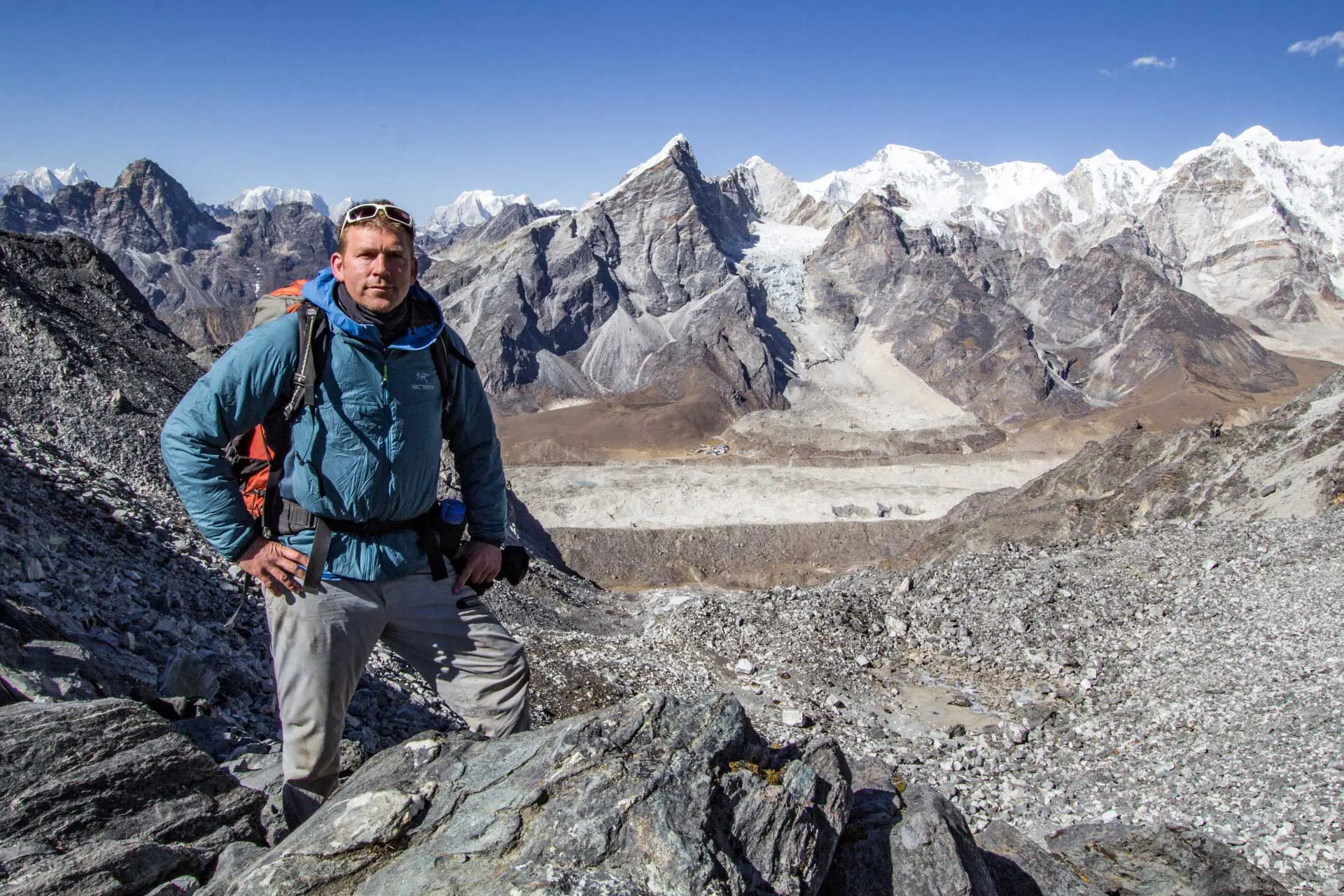
Guide to Nepal’s Three Passes Trek
The Three Passes Trek in Nepal is in the Everest Region (Sagarmatha National Park) and takes trekkers across three high passes, Kongma La (18,209 ft / 5,550 m), Cho La (17,782 ft / 5,420 m), and Renjo La (17,560 ft / 5,360 m) – hence, the Three Passes Trek. It’s a lollipop loop that can be done starting at Lukla (that scary mountain airport that you fly into) or further down the mountains at Jiri, Shivalaya, Salleri, or Phaplu (I recommend starting at Jiri if you have the time – it will also save you on having to buy plane tickets to/from Lukla).
If you’re only going to Nepal once in your life – as you should – and you’re intent on hiking (not doing a meditation retreat or growing dreads and hanging out in Pokhara), then you need to do the Three Passes Trek. And ideally, you need to hike in from Jiri. Fuck Everest Base Camp, fuck the Annapurna Circuit, fuck the Manaslu Circuit , and fuck Poon Hill. Three Passes Trek from Jiri. This is what you need to do. And if Everest Base Camp is really important to you, it can easily be done as a detour from the Three Passes Trek (normally this will add one day – if you’re slow, maybe two; if you’re fast, maybe none).
Are you required to have a guide for the Three Passes Trek? No. Do you need a guide for the Three Passes Trek? Not really (do not buy into all the fear-mongering in Kathmandu – these are just people trying to get you to hand over your rupees). Is hiking the Three Passes Trek expensive? No. Do you need to bring a tent, sleeping pad, or winter sleeping bag? No. Is it expensive to fly to Nepal? Usually, yes, but once you arrive, everything is cheap!
Three Passes Trek Facts
- (Unofficial) Capital: Namche Bazaar
- Language: Nepali
- Currency: Nepalese Rupee, NPR
- Time Zone: NPT (UTC+05:45)
- Calling Code: +977
- Drinking Age: 18
- Drinking In Public: Yes
- Drinking Tap Water: No
- Flushing Toilet Paper: No
- Vaccinations Required: CDC
- Credit Cards: Carry cash
- Tipping: Not expected
- Emergency Number: 100
- Outlets: Type C / D / M (230 V / 50 Hz)
- Visa Requirements: External Link!
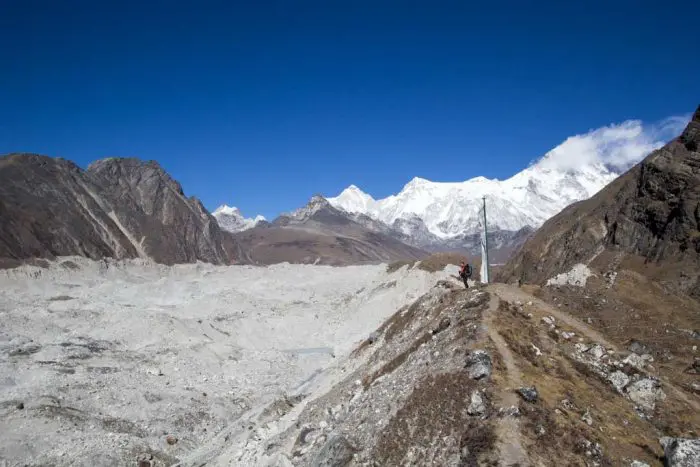
Three Passes Trek Basics
On the Three Passes Trek, almost everyone you meet will have some English language abilities (talk to the kids – they’re very interested in you), so don’t fret if your Nepalese or Hindi is rusty. The two words that you’ll need are namaste (hello) and dhanyabad (thank you). The Sherpa language, called Sherpa, is also spoken by some people. Sherpa is unwritten, which accounts for the various spellings of many of the villages (e.g. Dzonglha/Dzongla/Zonglha), so don’t worry if you’re confused by different spellings on your map versus the menu in your tea house versus your guidebook (which is probably too heavy to be carrying in the first place).
The route to the Three Passes Trek heads north into the mountains until Namche Bazaar. From here, hikers can choose to hike either clockwise or counterclockwise. Counterclockwise is the more common route and the one I recommend (particularly if it’s your first time at altitude). The Three Passes trek takes trekkers through four valleys in addition to the three passes, Kongma La (18,209 ft / 5,550 m), Cho La (17,782 ft / 5,420 m), and Renjo La (17,560 ft / 5,360 m). Kongma La is generally considered the most difficult (longest), Cho La requires you to cross a glacier (microspikes are helpful here), and Renjo La is commonly thought to be the easiest. Granted, this can all change depending on weather and conditions. For more on the Three Passes Trek route, check this post .
The tea houses (i.e. lodges) scattered throughout the villages along the Three Passes Trek are where you will (probably) stay each night (if you wanted to camp, you could, but it’s totally unnecessary and absolutely not required). During peak season, these can (apparently) get crowded. However, if you’re awesome and you go in the winter (more on this below), you shouldn’t have any trouble finding space in a lodge (as practically half of all the buildings in any given town are lodges). The tea houses usually cost between 100 and 400 rupees per night (~$1-$4) and have hot meals and beverages for purchase.
As much as you may imagine “trekking through the Himalayas” to be an exercise in solitude, this idea errs wildly on the side of “nope, sorry.” On the the Three Passes Trek, you will be constantly met with other trekkers, locals, pack animals, and, most exciting of all, villages. Depending on your route, you may pass through as many as five or six villages in a single day. They all (at least on the Three Passes Trek) have food, accommodation, and friendly mountain-dwellers to aid you on your way up into the mountains. If you go up alone and decide you need a guide, hiring someone from one of the villages to go with you on your trek will also be possible.
The most popular season for the Three Passes Trek is the same as Everest Base Camp, the fall (September to November). The second most popular season is spring (March to May), also the peak season for Everest climbers. The summer months are monsoon season in Nepal, so unless you are a huge fan of trekking through the rain with limited views, it’s probably best to avoid this time (unless you are willing to trade views for solitude – but maybe you’ll get lucky with the weather). Winter generally has limited crowds and great weather, but it is cold (I like the winter – more on this below).

Three Passes Trek Route
The Three Passes Trek trail is very well-defined. The scale of the mountains makes navigation much different than what you would find in a heavily forested area. Most of the time, you walk up, down, or across a valley and have few options for where to go. It’s not like you will suddenly make a wrong turn left and accidentally go over a 23,000 ft / 7,000 m. You can get a paper map in Kathmandu for the region, which should help you with the big junctions (if you somehow find yourself alone and with no locals to ask for directions). For more on the Three Passes Trek route, check this post .
As stated above, the passes are Kongma La (18,209 ft / 5,550 m), Cho La (17,782 ft / 5,420 m), and Renjo La (17,560 ft / 5,360 m). Again, Kongma La is generally considered the most difficult (longest), Cho La requires you to cross a glacier (microspikes are helpful here), and Renjo La is commonly thought to be the easiest. Granted, this can all change depending on weather and conditions. It’s wise to get an early start on the days you plan to cross each pass to give yourself adequate time and avoid the afternoon weather (typically worse than what you wake up to).
Everest Base Camp
This is completely doable if you want to detour to Everest Base Camp and/or Kala Patthar. The first village west of Kongma La (the second village east of Cho La), you can make it to Everest Base Camp and back in a day (via Gorak Shep). If you also want to hike Kala Patthar, you could either do one huge day back to Lobuche or stay the night in Gorak Shep and do Kala Patthar the afternoon before your stay or the morning after. For more on Everest Base Camp, check this page .
Hiking from Jiri
Taking a bus or jeep to Jiri (or Shivalaya, one village ahead) and then hiking to Lukla (instead of flying to Lukla) is a challenging and rewarding section of the region that is not as heavily trafficked as the trail above Lukla (where most trekkers start). If you’re short on time, instead of starting from Jiri, you can save yourself a day or two and take a bus or jeep to Salleri or Phaplu, which puts you about two days close to Lukla from Jiri.
Turning Around
Every time I have been up in the Everest Region, there has been much fear-mongering about the passes. “The passes are closed, there is too much snow” or “The passes are closed because ‘I don’t know why I just heard somebody say that.'” Listen, friend, if you’re in Nepal to hike the Three Passes, go and hike the Three Passes. Go and see for yourself. Start early in the morning, and if the trail, pass, or the weather turns out to be too much, turn around. In absolute terms, the passes really aren’t that far from the nearest villages. Don’t be afraid to go and check out the conditions for yourself, but don’t be afraid to turn around if things look above your experience level.
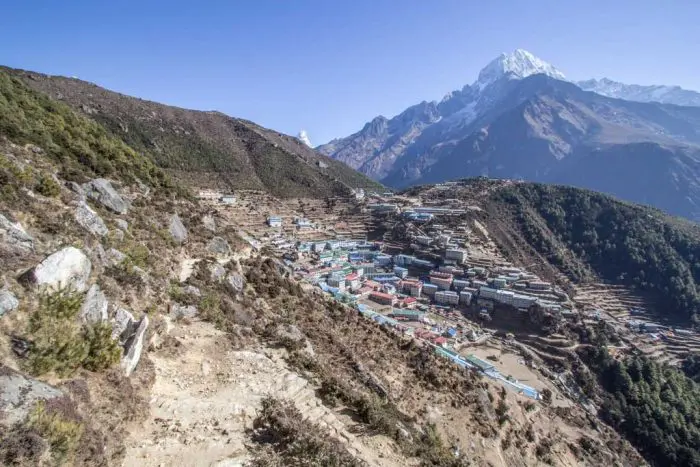
Three Passes Trek Food
Food on the way to Three Passes Trek is far more plentiful than you may imagine. Many lodges have many options, and you could easily eat something different every night (or be like me and stick to Dal Bhat, pizza, and momos). Check out this post for more on food on the Three Passes Trek.
Dal bhat is perhaps the most plentiful dish on the road to the Three Passes Trek and is certainly one that you should be eating to fuel your marathon mountain march. This traditional meal consists of rice, lentil soup (dal), and vegetables (and/or some meat if you’ve opted to eat animals on this trek). In addition to typically being one of the cheaper options on the menu, dal bhat also means refills. You get complimentary refills on your rice, lentil soup, and vegetables. It’s easy to see why this is what the guides and porters usually eat. Remember, “Dal Bhat power, twenty-four hours.”
There’s not a huge debate surrounding the quality of meat on the way up to Base Camp (that I’m aware of), but it’s something trekkers should consider. As much as I love eating roasted animals, I do not eat meat in the Himalayas. Do I have a scientific reason for this decision? No. It’s simply because I don’t know how many days in the sun each meaty meal spent on the back of a porter (and because the meat is generally more expensive). Also, since eating beef isn’t really a thing in Nepal, and since cows are my favorite animals (to eat), it’s not worth the risk.
As with meat, alcohol is something I avoid whilst hiking (upward) in the Himalayas. This is a personal decision, but drinking alcohol (especially in excess) can hinder your acclimatization efforts – and altitude sickness is not something to be taken lightly. A night of partying in Namche is not worth turning your Three Passes Trek adventure into an expensive (but probably awesome) helicopter ride back to Kathmandu.
So now that you’ve sworn off the bottle, it’s time to get serious about hydration. Water should be something you’re constantly ingesting on the Three Passes Trek. Chances are that your body will be in nonstop and desperate need of water to fend off the effects of altitude sickness, dehydration, and the possible fallout from your third helping of dal bhat last night. I bring a SteriPEN with me on my hikes in Nepal and purify water that I get from the tea house’s tap (you usually have to ask for this). Buying plastic water bottles contributes to the garbage problem in the mountains (and we all know plastic bottles are evil).
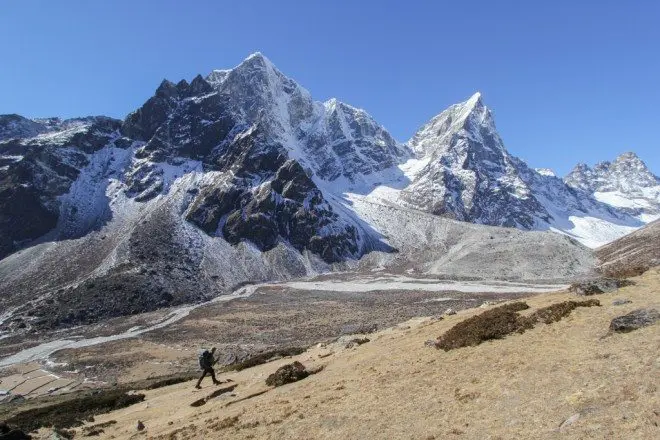
Three Passes Trek Tips & Tricks
Yes, “Winter in the Himalayas” may sound scary, but the truth is that it’s probably the best time to visit (this is based on my having been there twice in winter and once in spring). You may expect the Himalayas’ winter months to bring a ton of snow, but this is not the case. Most days, you can expect clear skies with very little precipitation. Just make sure to bring an extra base layer because it’s cold.
Yes, with the civilization in the Himalayas, you will also find wi-fi. Generally speaking, once you get above Namche Bazaar, getting free wi-fi will be difficult (if not impossible). Generally, you must buy cards from the lodges with passcodes to access the “EVEREST LINK” wi-fi network. These cards are sold in different denominations, the most expensive being 1,000 NPR (~$10 US) for 24 hours of use. These cards may not always be available, and lodges may not always sell them at face value. Also, many lodges turn off the electricity after a certain time (which means no more wi-fi), so be sure to ask beforehand. You will probably get a cell signal in many places if you have a SIM from Kathmandu (Ncell is what you want).
Lukla Flight
I highly recommend taking a bus to Jiri and beginning your hike from there, but if your time is limited, then a flight to Lukla may be your only option. The flight to Lukla is commonly referred to being “the most dangerous flight in the world”. This is largely because of its being placed on under-researched lists of random internet blogs (there have been three fatal accidents involving airplanes at the airport – the most recent of which was in 2010). Yes, the flight to Lukla is an adventure, but it’s certainly not a death sentence. The flight will cost around $150 each way – more on the flight here.
Yes, there are ATMs in the Everest Region. As of writing this, there’s one in Lukla and two in Namche Bazaar. None are guaranteed to work, so I would bring cash from Kathmandu to avoid headaches. Ninety-five percent of places do not accept cards. If the ATMs aren’t working, places in Lukla and Namche offer cash advances with a credit card. Some places in Namche Bazaar accept cards, but few places above Namche will take anything besides cash. Ensure you have enough money for the way up (and back down).
For more on the Three Passes Trek, visit my Three Passes Trek page .
Similar Posts
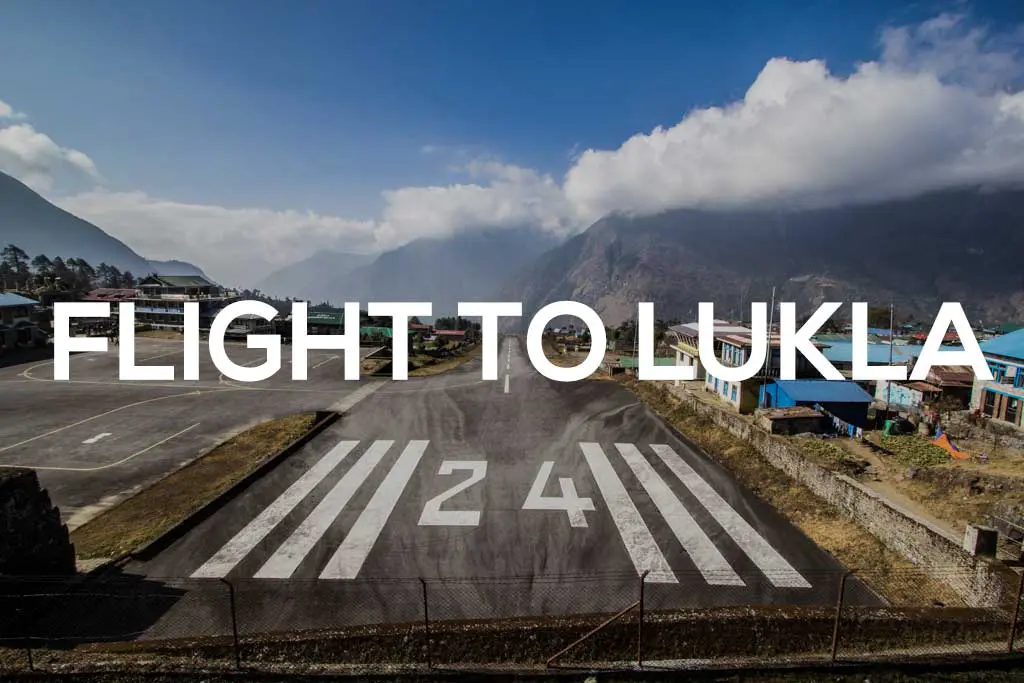
Catching (Or Not Catching) A Flight To Lukla
Most people visiting the Everest Region begin their journies by flying from Nepal’s capital city of Kathmandu to the Himalayan town of Lukla. As I…

Off To Nepal (And Certain Death)
I have already presented “The Ultimate Everest Base Camp Plan” and my exhaustive “Everest Base Camp Gear List”, so now if (when) something goes wrong…
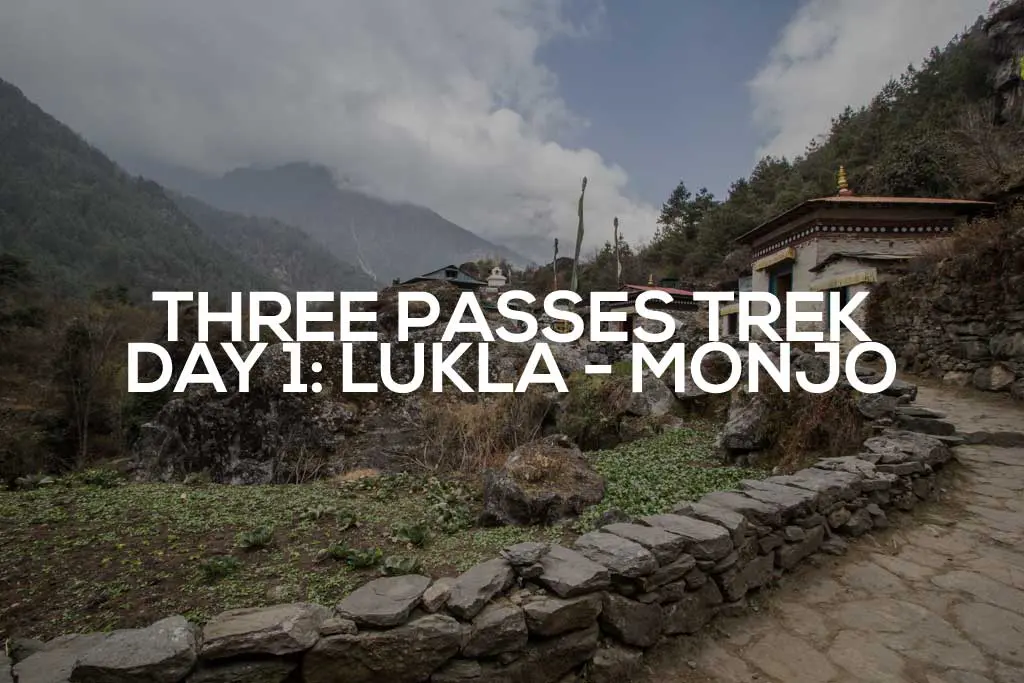
Three Passes Trek Day 1: Lukla to Monjo
After waiting around all day yesterday, it’s time to return to Kathmandu’s Tribhuvan International Airport for a second attempt at boarding a plane to Lukla…
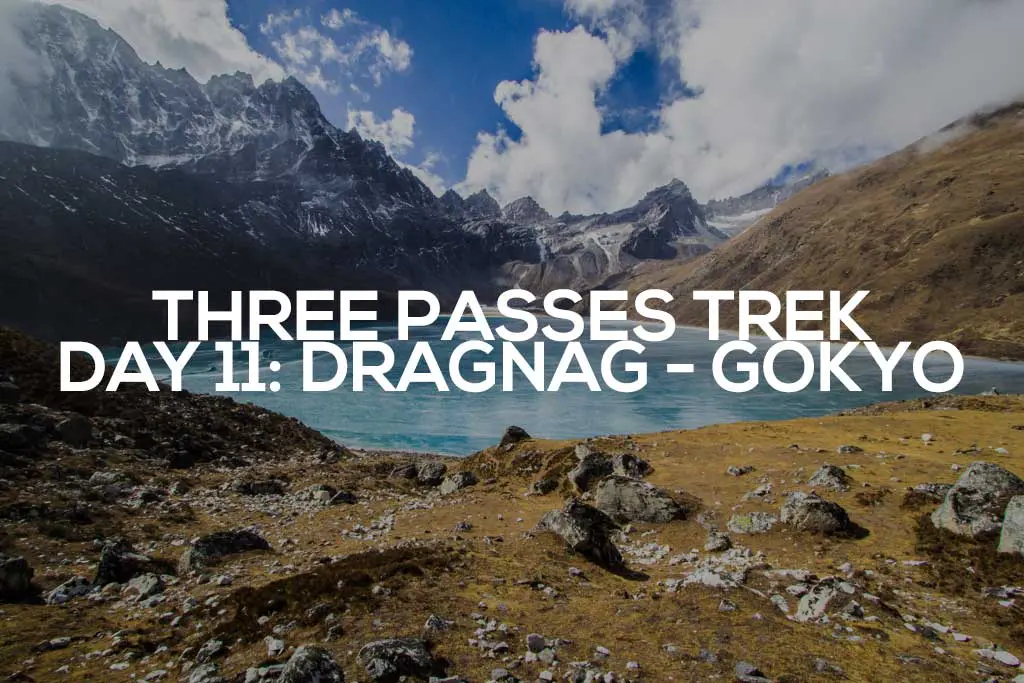
Three Passes Trek Day 11: Dragnag to Gokyo
I wake up and head to the common area for breakfast where I find the lodge-keep asleep behind the bar. It’s already eight o’clock, late…
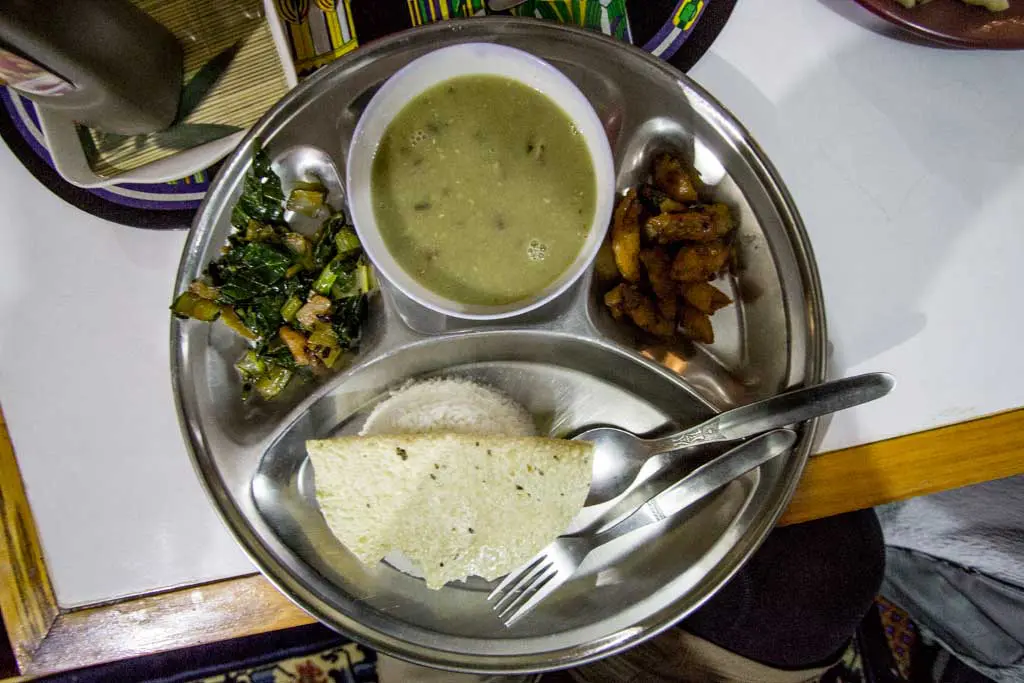
What Is Food Like In The Himalayas?
The Himalayas may be remote, but that doesn’t mean you can’t enjoy a huge variety of meals whilst trekking through the highest mountains on Earth….
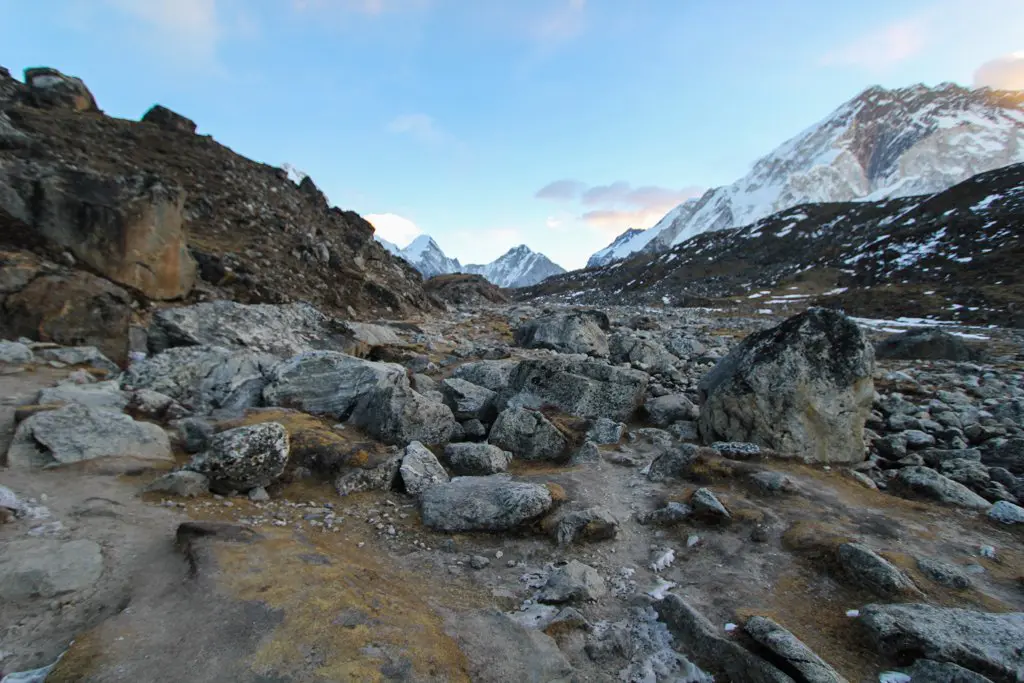
Everest Base Camp Day 9: Lobuche to Gorak Shep
Starting elevation: 16,142 ft / 4,920 m Ending elevation: 16,863 ft / 5,140 m Elevation change: +721 ft / 220 m Starting oxygen: 56% of…
42 Comments
What a fantastic article on the Everest Three Passes trekking in the Everest region! It provides extensive information about the breathtaking natural landscapes, towering mountains, and vibrant Sherpa cultures.
Glad you enjoyed it!
Thank you very much for the great post
Thank you for reading!
Thanks for sharing such an amazing post, The Everest Region is the hub for adventure, and adventure people complete their passion for adventure in this province. Your blog helps people plan their trip at the right time and the pictures are awesome.
This is very informative. Thank you for taking time in sharing your experience. I have just decided to do it in March 2024 as a solo backpacker, without a guide or porter. In case anyone here is going in the same month I’m more than happy to buddy up instagram handle: ikaterox
Thanks for the great blog. I will be retuning to Everest region in March 20224 and am trying to figure out of I can take on the 3 passes as a solo trekker (no guide, no porter) as a reasonably fit 56 yo woman. The other option is to repeat the amazing trek I did when I was 29 yo from Jiri to Gokyo Ri. Ideally Id like to do something differeint thoigh and dealing witht he throngs of trekkers heading to EBC is not really my thing. I’m wondering aboit path finding – how clearly marked are the passes? Im aware that I can most likely buddy up on the passes or even hire a guide for them but would love your thoughts. THANK YOU!
The trails over the passes aren’t well-marked (although they’ve added more markers since I first did this hike as I saw when I went up Kongma La once more a few years later). The passes themselves are fairly well marked as they’ve been covered in prayer flags.
Thank you Mac! Thinking for me either take a guide or choose an easier better marked trail.
Hi! What an amazing and encouraging trip report! I have done a similar trek in Peru called the Ausangate circuit that went over 4 high altitude passes, but it only took me about 6 days. I have a question about meat eating, however. Did you find plain meats available in the villages at all? I eat a keto low carb diet due to autoimmune issues. I’m fat adapted, so I fuel off of animal fats + meats. I’m planning on bringing pemiccan bars and jerky. I’ve heard I might be able to find yak butter available. Do you know if I can find any dried meats to carry, even in Katmandu?
I avoided meat in the mountains although it was generally available. I am not sure about the availability of dehydrated meals in Kathmandu as I didn’t eat any of these myself. Honestly, if you have a restricted diet I would suggest bringing as much as you’re comfortable with from home.
Thanks so much. Ya, it’s pretty complicated for me because I can’t handle any nuts, grains and seeds in my diet. I’m really hoping I can find dried meats at the very least in Katmandu. I’m a full time nomad so carrying foods from “home” won’t really be possible for a longer trek in Nepal. Anyway, thanks again for this amazing report!
@crystal , Hi im a sherpa living and studying in new york to be a nurse. In our culture we have a dehydrated meat called “sukuti” . In the past sherpas didn’t have a way to keep meat edible and not rot. We didn’t have fridges back then and still we don’t really have them. Sukuti is a goat/lamb dried meat , thats really chewy and tasty in my opinion. you can do a google search on it. Most tea houses and homes in this area will have sukuti , but its usually reserved for their family . Not really sold . BUT I am sure if you ask kindly , they might sell it to you and I think some places sell it to tourists anyway.
Wonderful information! I’m here now getting ready for my first trek. I’ll look for some sukuti in Katmandu!
Hi there, my brothers and I will do the Three passes, starting late March this year. Do we need crampons during this trek because we have to cross a glacier? If so, how big is the distance we have to cover through this glacier? I’m in doubt if my hiking boots (Hanwag tatra II) are suitable in case we need crampons.
Thanks in advance!
I used microspikes to cross the glacier on the east side of Cho La. If in doubt, it’s best to bring some traction with you – worst case you don’t use it.
Thanks for the advise.
I’m going to hike the three passes loop starting from Jiri. I’m traveling solo and would love to meet others to hike with. I’m planning on starting early March 2023. Anyone interested in joining me? I’m female and would prefer to travel with women or a combo.
Hi — I am considering this trip and leaving in the next few days. Have you already arrived / have a group together?
I am leaving for Nepal on 3/20 so will start hiking from Jiri probably on 3/24. No group, going to start solo and hopefully meet up with friendly trekkers. What is your plan???
A complete guide for Everest 3 High Pass Trek. Thanks for sharing your experiences here. Keep on sharing and inspire other people to trek in the Himalayas.
It’s a beautiful place to trek!
Hi there, I am looking at tackling the Three passes trek solo this upcoming late Feb, early march. I have scoured the web and haven’t been able to find any beta on potential snow conditions. Any idea what I may encounter? I am okay with some post holing but I am just curious about avalanche hazards and snowbound conditions. Any insight would be greatly appreciated thanks 🙂
I’ve been up there in March and there was little snow. The mountains get most of their precipitation in the summer months while winter is typically the dryest When I was there I went up Kongma La and there was a bit of snow (it had snowed three days before I hiked), but it was completely manageable.
Thanks for your speedy reply! I really appreciate it. That is good to hear. Any other high pass trekking you would recommend as well?
Hey Mac, Thanks for all the information and great website. There is one thing that is not clear to me about this route. Do I take a satellite/gps device or not? Does gps navigation on phone (with downloaded offline maps in Komoot) will suffice? I have always navigated this way but since the Himalaya are new to me… Is it necessary to have satellite reception on the pass in case of emergency? Hope to hear from you! Best Funs
GPS navigation on a phone will function so long as you’re familiar with it; phone apps will work the same in the Himalayas as they do elsewhere so long as you have the maps downloaded for offline use. When you ask “satellite reception on the pass in case of emergency” are you talking about calling for help? If you need to call for help with a phone you will need (and not have) reception. It’s best to bring a PLB for times like this.
Nowadays we can see many people blogging without information but this article is really informative which is important for travelers.
That’s the goal!
I’m doing the three high passes in October this year! You definitely have the most detailed blog I’ve found. I’m just curious what you do with your toilet paper if you can’t flush it? Do you carry a garbage bag full of toilet paper around? Thank you!
Throw it away or pack it out (bring extra Ziplocs).
I still remember when we met at Tengboche while you were doing this trek. We had some beautiful conservation went on and you were so adventurous. I follow you on Facebook as well love to see your post on there too. And Keep posting such a piece of great information to everyone who wishes the adventure in Nepal.
I remember when we met, too – I can’t wait to make it back to Nepal!
As a trekking guide, i have done this Everest three-pass trek couple of times every time i go there i feel more energetic and fantastic. Reading this article now while staying in the home because of the coronavirus and no trekkers in Nepal for the trek recall all my walking experience in those places.
It’s an awesome post, and really useful to get the information of an Everest Three Passes Trek. Thank you so much for publishing such a nice article.
Thanks for the feedback!
Amazing Trip.
Highly recommended!
It is a great guide Mac. We have a similar 3-passes trek in Indian Himalayas.
I have yet to get there – what’s it called?
Auden’s Col – Mayali Pass – Patangini Dhar trek
I would love to know too. Waiting for reply. Thanks!
Leave a Reply Cancel reply
Your email address will not be published. Required fields are marked *

How to Do the Everest Three Passes Trek Solo
This is possibly my favourite trek in the Himalayas. It’s 15 days of trekking through some of the tallest mountains of the world. It’s challenging and exhausting, but also one of the most rewarding hikes you’ll ever go on.
The Three Passes Trek is my favourite hike in the world. Stunning views, iconic sights (like the Khumbu glacier!), high altitude, comfortable tea houses, and so much culture all wrapped up into 17 days. This is going to be a pretty big post with everything you need to know about doing the Three Passes Trek solo, so before I jump into it, I’m going to give you a little table of contents. It’s a full three passes trek blog with loads of information about doing the 3 passes trek solo – this guide should have everything you need to know!
A Brief Summary of the Three Passes Trek

Not too many people know what this trek is! They know its a 3 pass trek, but that’s about it! I’m here to clarify.
The three passes trek is a two-week trip that follows the Everest Base Camp route before splitting off and taking you over three passes that give amazing views of the Himalayas and Mount Everest. It’s been dubbed one of the most beautiful treks in the world, and for good reason! While going on the Everest Base Camp route is nice because of its commercial status, the three passes trek takes you beyond that side of the region and show you even more of its beauty. The Gokyo Lakes trek is another popular trek in Sagarmatha National Park, and this takes you through the end point of that route.
Three Passes Trek in June?
The three passes can be a dangerous trek. You’ll only want to go when the weather is the best. The best months are November, December, and May. You want to avoid from June to September because it’ll be rainy and hazy, and flights to Lukla probably won’t operate. Furthermore, teahouses won’t be open. You also want to avoid from January to March, as it might be too snowy.
How hard is the Everest three passes trek?
You have to remember that this trek goes over three high passes. It’s definitely not easy, but it’s doable! There are some very technical paths over the passes, but if you’re fit and have mountain and altitude experience, you should be fine. That being said, I wouldn’t go alone – always make sure you’re going over a pass with other people! Everest three passes trekking is tougher than trekking just to base camp because of the tough terrain and high altitude over the three passes. This is NOT a trek for beginner hikers if you’re doing it alone.
Looking for hikes that are a little less intense? Everest Base Camp , the Annapurna Circuit, Annapurna Base Camp , Australian Base Camp , and Poon Hill are all stunning.
Three Passes Trek Itinerary

Fly to Lukla, walk to Phakding* | 3 hours | 2610m
*Alternatively, you can walk to Monjo, which is about 3 hours further, if you arrive early or are feeling up for it
Walk to Namche Bazaar | 6 hours | 3440m
Acclimatisation Day | A half day trek to Everest Viewpoint Hotel or up to Tenzing Norgay Statue
Walk to Tengboche | 4 hours | 3870m.
Walk to Dingboche | 5 hours | 4410m
Acclimatisation Day | Walk partly up Nagkartshang Peak
Walk to Chukkung | 3 hours | 4730m
Acclimatisation Day | Walk to Chukkung Ri
*Some choose to climb Island Peak from here, though you need to have a guide and proper training for that summit.*
Walk to Lobuche via Kongma La Pass (5535m)| 10 hours | 4940m
*From here, you can split from the Three Passes trek and go on to Everest Base Camp / Kala Patthar following THIS itinerary*
Walk to Dzongla | 3 hours | 4200m
Walk to Gokyo via Cho La Pass (5420m) | 10 hours | 4750 m
Rest Day | Go up Gokyo Ri or around the lakes
Walk to Lungde via Renjo La Pass (5340m) | 6 hours | 4380m
Walk to Thame | 3 hours | 3800m
Walk to Namche Bazar | 3 hours | 3440m
Walk to Lukla | 7 hours | 2850m
Budget for the Three Passes Trek or EBC

I’ve written a full budget breakdown of the Everest Base Camp trek HERE . The budget accounts for all necessary permits and your daily budget and includes a section on how much getting in and out of Lukla will cost. I would stick to this budget breakdown as a guide for the three passes trek as well.
Before You Go
You’ll need to get a TIMS card to do this trek. You can get a TIMS card in Kathmandu or Pokhara (directions here ), or on the trail in Lukla.
The trek starts in Lukla, a small mountain town. There are plenty of different ways to get to Lukla, which I’ve outlined below!
How to Get In/Out of Lukla

From Kathmandu, you’ll need to get up to Lukla for the start of the trek. You can do this many ways.
The most popular method of getting to Lukla is by aeroplane. Flights to Lukla only operate in good weather conditions (and while inconvenient, this is a good thing because the runway is VERY short), and they’ll only fly out of Kathmandu if they are sure to be able to do a round trip flight. There are often delays and cancellations, so make sure you have a couple days to spare before flights in and out of Kathmandu. You can book flight tickets online, but I recommend booking from a tour office in Kathmandu or emailing your hotel before you arrive to organise your tickets. Buy round trip! You can always cancel for a 10% (of the ticket price) fee, or if your flight is cancelled due to weather, you are entitled to a full refund of that ticket.
Helicopters
When flights are cancelled or delayed for days at a time, or for those who are on tight schedules, helicopters are the way to go. Helicopter flights are significantly cheaper going INTO Lukla than they are going OUT of Lukla. Helicopter prices depend on the season and demand. I’ve heard of people paying as little as $150 USD to fly into Lukla and as much as $500 USD to fly out. When there is a backlog of people in Lukla due to cancelled flights, helicopters are in high demand and the local “Lukla mafia” will charge as much as they please for a seat on a heli back to Kathmandu. It is standard to pay about $250 for a helicopter flight back to Kathmandu, but if there are many people who want to fly out of Lukla during peak season, I’d expect to pay $500.
That being said, if you are stuck in Lukla, you can take a helicopter to Phaplu, then a 10-hour jeep or bus ride . The helicopter will cost about $200 USD, and the jeep will cost 13,000r to 20,000r depending on the demand. I’ll go into more detail about this option in the last section.
Finally, you can walk in and out. It takes about 4 days of walking to get to Jiri or Salleri. It is hot and there is a lot of up and down, but you escape the touristy part of the trek and I’ve heard good things about this (if you like walking!).
Essential Items for Trekking in Nepal

After trekking in the Everest region multiple times, there are a few things that I’ve come to really appreciate bringing up into the mountains with me.
- • Babywipes
- • Hand Sanitizer
- • Sunscreen
- • Extra Pair of Socks
- • Trekking poles
- • Sleeping Bag (some people think relying on teahouse blankets is enough- its not!)
- • TRAVEL INSURANCE – this is very important in case you need to be helicopter evacuated out. Make sure your insurance covers this!
- • Some people like to take Diamox for altitude sickness. When I did EBC, I felt the altitude at Gorak Shep. On this trek, I didn’t feel the effects of altitude as much (excluding going over Kongma La).
Day By Day Overview / What to Expect / My Recommendations / Three Passes Trek Blog
While you can book flights to Lukla at around 8 or 9am, I’d go for the earliest flight, as those are the most likely to take off.
Our flight was early, and we got to Lukla no problem! In Lukla, you have to buy your trekking ticket. Just walk down the main street and you’ll be stopped to buy one. From there, head onto the trail! The walk to Phakding is downhill and pretty easy. Remember to walk left around the stupas and mani stones. We arrived in Phakding at about 11am, so we kept going onto Monjo, which is at a slightly higher altitude. There was more uphill on this section, but nothing so steep it was memorable.
Recommended teahouse: Mount Kailash in Monjo
The day starts off nicely. You’ll have to stop to get a national park permit and for a ticket check, and then you start walking along the river. I personally find this bit absolutely stunning! There’s a beautiful view of two suspension bridges. You’ll eventually cross the higher one. After this viewpoint, it’s all uphill to Namche. About an hour and a half into the uphill section, you’ll come up to a public bathroom. From there, you can see Everest. This is also halfway up the uphill section. You can refill water here. Continue uphill, and eventually, you’ll get to another ticket check. At this point, you’re only about 20 minutes from Namche!

Namche Bazaar is the biggest village on the trek, and it feels like paradise! I love going to the Liquid Bar at 3pm for a movie. Ordering popcorn is a must. There’s a Himalayan Java right next to the Khumbu Lodge that offers free wifi and charging if you purchase something. If you’re feeling the need for a massage, someone who summitted Everest and tried ALL the massage places in Namche recommended the one inside the Khumbu Lodge.
Recommended teahouse: Khumbu Lodge. We splurged on a room with an electric blanket, charging, an attached bathroom (with a hot shower!), and a double bed for $25 USD.
The weather for us was poop. We wanted to walk up to the Everest Viewpoint Hotel, but since it was so cloudy, we were sure we wouldn’t get a view and only went about a third of the way up. Instead, we walked to the Visitor Center and Tenzing Norgay Statue, which is the acclimatisation walk I usually do anyway. I love the Visitor Center and highly recommend going! Note that it is open from 8am to 4pm Sundays to Friday, and that it is closed Saturday and public holidays.
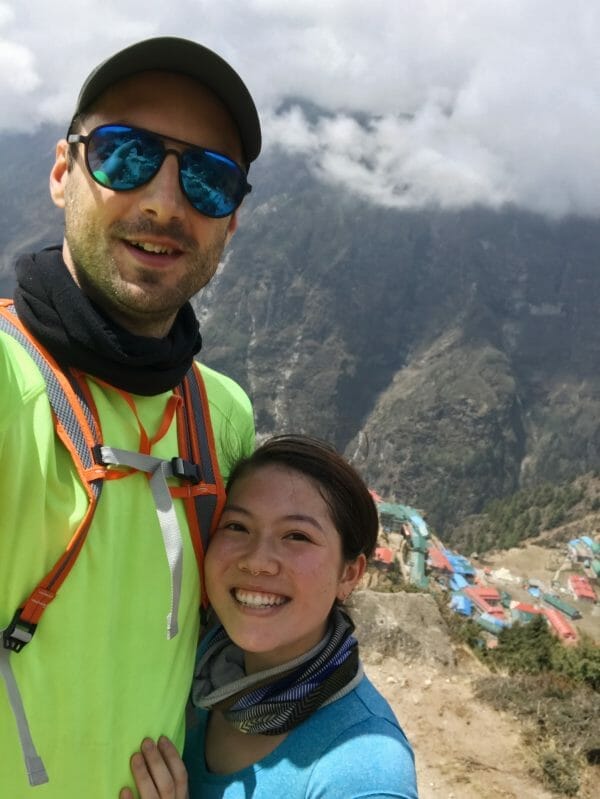
You’ll love the start of this day: it’s flat! And there are great views! Eventually, you’ll start going downhill. I’d stop at the river for a pot of tea or lunch, because after you cross the suspension bridge over the river, it’s a ticket check, then a lot of uphill! I always used to remember this bit as the WORST, but this time, I took it slow and steady, and it really wasn’t as bad as I remembered. Tengboche is absolutely beautiful. If you can, head into the monastery at 3pm for the prayer. You aren’t allowed to take photos.
Definitely go to the bakery to get a slice of apple crumble. It is necessary. And delicious.

Recommended teahouse: Tashi Delek
Our whole time in Nepal, the clouds had been really low and it was foggy, but this day, it cleared up! Tengboche is BEAUTIFUL on a clear day.

Your day will start with a downhill walk before it flattens out. The flat bit is full of blooming rhododendrons in March-May.
Once you hit the river, you’ll start heading uphill again. It’s a pretty bearable uphill hike to Dingboche. The land seems very vast and very barren here. It’s awesome.
In Dingboche, the first lodge you’ll hit is the Snowlion lodge. It’s attached to a French Bakery. I love this lodge and I love the chocolate truffles (more like a dense fudgey cake) at the bakery.
This is an acclimatisation day! Just above the Snowlion lodge is a stupa. Walk up there, and then further up the hill. There will be a rest stop. You can either continue up or stop around here. On my trips to this region, I’ve acclimated by going all the way to the top, to the rest area, and somewhere in between. I honestly don’t think that the height of your acclimatisation hike makes a huge difference, just make sure to get a hike in.
If the weather is clear, the peak offers some stunning views, but if it’s cloudy, I wouldn’t bother.

The walk to Chukkung is a very gradual uphill. It’s quite windy in this valley. I really liked this day because there was a great view, a gentle hike, and only 3 hours of trekking! We stayed at the Khangri Resort. Their dal bhat is fabulous and Skye (the manager) is soooo lovely! Again, the views from Chukkung are beautiful.

Another acclimatisation day! Walk up to Chukkung Ri. This is a pretty steep trail with a couple false peaks. You think you’re almost there, you make it over the ridge of the hill, and bam. Another hill to climb. That being said, the views are worth it! Once you get to the prayer flags, the rest of the trip up to the summit is a little scramble-y. It was really cloudy and we didn’t feel safe on the loose rocks, so we didn’t actually get to the summit, but maybe 30 meters below. Just be mindful of where you step! On the way down, you’ll be proud of how far you walked- it’s so much longer than it seems!

I would bring trekking poles with you- it’s a steep climb and on the way down, your knees will want that extra support!
Day 9: Kongma La
The day of the first pass! We didn’t really know what to expect regarding how long this pass would take… Lonely Planet said it would take 7 hours, online resources said 6, our guesthouse owner in Chukkung said 9. It took 10. This is a LONG day, guys.
You start by walking down towards Dingboche on the side of a hill. It’s a pretty gradual uphill. The walk isn’t too bad at the start, but it gets a lot steeper. Once you see the big frozen lake, it’ll flatten out. Even though it’s flatter, I found this section REALLY tough. I started seeing double, feeling nauseous, and feeling faint. For a moment, I thought I’d have to be med-evac’d out, but I took a breather and then continued when I was feeling better. It’s a steep scramble up to the pass. The view from the pass is amazing if you look behind you. Looking forwards, towards Lobuche, isn’t as impressive, so make sure to look back!

We spent about an hour at the top of the pass, but I would recommend instead having a quick snack and water and continuing to move. Though the uphill part of the pass is over, the hard part isn’t!

Going down, your walking on scree. It’s very slippery, so watch your step! There also isn’t a distinct trail; you’ll look out for rock cairns to guide you. After a couple hours of this, you’ll reach a valley. Unfortunately, you go down the valley only to go back up it. The uphill isn’t too bad, and it’s pretty short.
Once you get back to the top of the valley, you’ll meet the Khumbu Glacier. You have to cross this to get to any lodges. Again, there isn’t a distinct trail, so follow the rock cairns. Lonely Planet describes crossing this glacier as “a final sucker punch,” and I couldn’t agree more. It’s a LOT of up and down. Also, if you go in late May, the glacier will be melting from under you and rocks will be falling around you. It can feel a bit dicey. If you’re a solo trekker, DEFINITELY try to link up with others for this bit.
After you cross the glacier, you just have to walk up one last steep uphill bit, then go downhill, and Lobuche is there!
If you are skipping Everest Base Camp, go to Dzongla. We skipped EBC for two reasons. 1) I’ve already been there and the views are not that incredible compared to the passes. EBC is mainly something you visit to tick off the bucket list. 2) We were really effing tired.
The walk to Dzongla is amazing. It’s a gentle downhill, then a gentle uphill, and then you walk along a side of a mountain, so it’s flat! It takes 3-4 hours at a leisurely pace.

Recommended teahouse: Green Valley Lodge
If you are going to Everest Base Camp, read this post .
Day 11: Cho La
We woke up at about 5, had breakfast at 5:30, and were off by 6! I was honestly dreading another pass… Kongma La nearly killed me. But don’t worry if you’re feeling the same- Cho La is MUCH better.
It’s a gentle uphill for about an hour or two, and then you’re climbing up big boulders. Once you make it up the big boulders, you’ll see a string of prayer flags. There’s a great view from here, but it isn’t the pass.

Keep going up the gentle uphill. You’ll have to cross some very icy paths, which is technically challenging. If you have microspikes, I’d put them on for this section.
You’ll walk up a frozen glacier, then up maybe 10 meters of rocks, and you’ll have made it to Cho La!

The way down is steep and rocky. It was a little icy but not too bad. You’ll be walking on loads of boulders, and again, the path isn’t so clear, so follow the cairns. Once you make it through the boulders, you’ll have to walk up and down to a valley, from which it’s all downhill. You’ll go down the valley to Thangnag, a small town. You can either stop here or continue onto Gokyo. I recommend continuing on – Gokyo is THAT much more amazing when you’ve had a really tough day.
If you’re continuing onto Gokyo, you’ll have another glacier to cross. This one isn’t as tough as the Khumbu Glacier, navigation wise. Once you make it over the glacier, another uphill and downhill, and you’re in Gokyo!
I HIGHLY recommend staying at Thanka Inn. It’s a new hotel (only around 2 months old!) and it’s absolutely BEAUTIFUL. It’s right on the lakefront and the rooms are amazing. They have real duvets (a LUXURY to not have to use a sleeping bag), double glazed windows, and delicious food. I couldn’t recommend this place more.

This is the day most people go up to Gokyo Ri. We decided not to because we were feeling a little sick. Phil ended up having a bad cold with fevers and chills, and I just had some stomach troubles. We walked around the lake, which was more than enough for us.
The lake is beautiful.
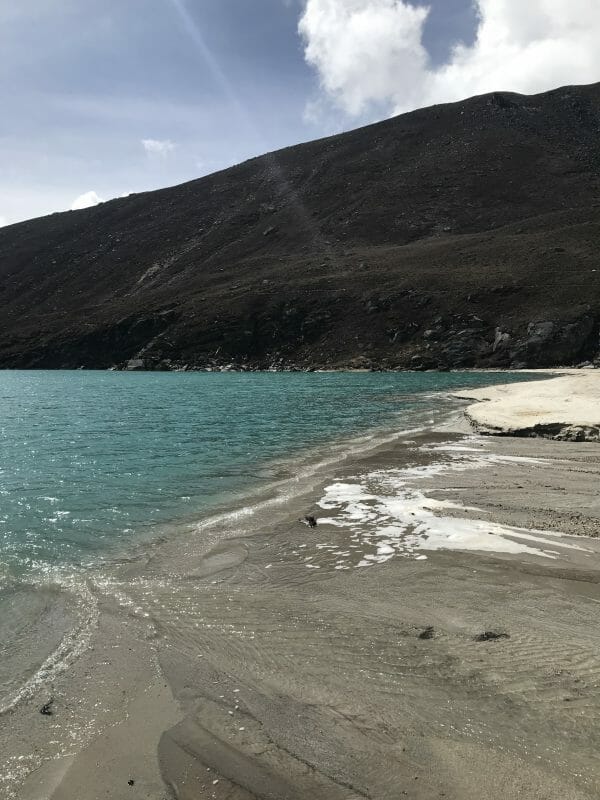
Day 13: Renjo La
The third pass- Renjo La! Follow the trail to Gokyo Ri, but instead of going up, continue straight. There is a sign that will make it easy to follow. It’s a very gradual uphill for about an hour, and then a steep uphill section all the way to the top. This is the easiest pass. That being said, I still found it quite tough- I think my body was just exhausted!

Luckily, once you make it to the top, it isn’t too bad. There was a LOT of ice when we were up there, so we had to be VERY careful for about 30 minutes on the way down. It was windy and cold, and the fog came out, so we couldn’t see very far in front of us. Total whiteout. If the weather is good, this part should be no problem.

It’s a steep downhill section, and then the trail flattens out. After about an hour and a half of walking on flat(ish) ground (HEAVEN), you’ll start going downhill again. It isn’t rocky so it’s easy to go down quickly. After losing 1000m from the pass, you’ll get to Lungdhen. There are a couple teahouses here, but we chose to just stop for tea, then continue walking down. 30 minutes below Lungdhen is another town called Marulung, but we continued down another 3 hours to Thame. The road is pretty flat and the scenery is absolutely beautiful, so it’s a nice day. It’s one of my favourite days on the trek. You get away from the commercial EBC route and get to see how people actually live.
You’ll be super excited to get going this day, because you’re heading to NAMCHE BAZAR! Namche feels like paradise after 2 weeks of trekking. There is a LOT of up and down the whole way to Namche, but with lower altitude is a lot more oxygen, so it doesn’t feel too bad.
It does feel quite warm compared to what you’ll be used to though, so wear short sleeves this day! You’ll make it to Namche in time for a movie at the Liquid Bar. We planned on doing that, but we accidentally fell asleep for about half the day. Our bodies were tired.
The trek down to Lukla is a lot tougher than you’ll have remembered. It’s steep downhill for the first hour or so, then lots of uphill and downhill, then just uphill. Again, it’ll feel really warm. Load up on sunscreen- I got SUPER burnt this day.
While the trek is pretty tiring, you’ll feel really motivated to make it to Lukla because it’ll mean you’re on your way to Kathmandu. Even if people dislike Kathmandu, after a trek in the Himalayas, you’ll crave comforts in Kathmandu you didn’t even know you had!
And that’s it! The Three Passes trek. Have any more questions? Don’t hesitate to leave a comment or email me.
Like this post? Pin it!

Related posts
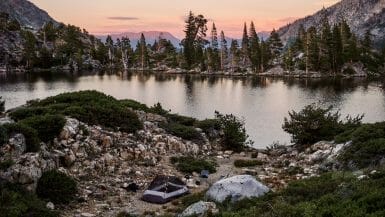
Everything You Need to Know About Backpacking the Grass Lake Trail in Desolation Wilderness
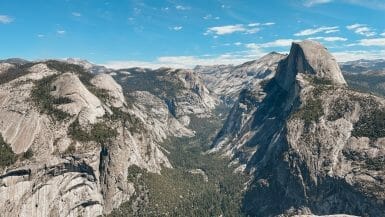
Glacier Point To Panorama Point Trail Guide: Everything You Need To Know About This Day Hike
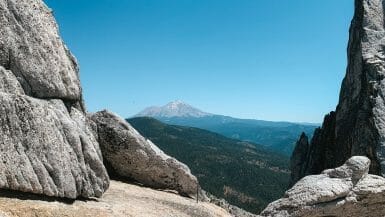
Hiking the Castle Dome Trail in Castle Crags State Park: Ultimate Trail Guide
Leave a reply cancel reply.
Your email address will not be published. Required fields are marked *
66 comments
This all looks amaaaaazing! Your photos are truly stunning! What an epic adventure!!
It was an incredible adventure! I couldn’t recommend it enough!
So jealous! This looks incredible!
We still need to go trekking together?!?!?!?
Hello. This looks amazing! I plan to do this trek next year. I have a question regarding permits: all the permits can be bought in Lukla? It is not necessary to go to Kathmandu first to get permits? Is it possible to exchange money in Lukla/Naamche Bazar as well? If not necessary I would like to avoid visit to Kathmandu and continue directly to Luka (to save one or two days and money in the process). I also have a question regarding shoes: for the last two years I have been trekking only in trail running shoes (adidas terrex), no boots. Would you say that boots are absolutely necessary? Was there snow (deep snow) in the passes in the spring?
All permits are possible to get in Lukla, however the only flights to Lukla go from Kathmandu. What month will you be going? There’s usually some snow, but not deep! I’d say micro spikes are a must!
Thank you for answer. I will be going in the middle of April-beginning of May. I know I have to go to Kathmandu airport, but after arrival I would like to continue directly to Lukla without visiting the city.
What time does your flight arrive? The flights to Lukla are all in the morning. Try to get the earliest one, as that has the highest chance of flying!
The plane should arrive 9:40 am. I hoped there would be flights around noon, but if all the flights are in the morning then I will have to stay in Kathmandu…
Hi Anya, Could you tell me what dates you did this trek,please? We are leaving in 4 weeks for Gokyo and plan to go over the Cho La Pass but in reverse. Did you meet many people coming the other way? It will be our third trek to the Khumbu. Louise
Hi! I did this in late may! We met loads of people going the other way- you just have to be more careful of acclimating! Have a BLAST! Xx
Fantastic post. It’s on my bucket list. I didn’t realise you could get flights into Lukla for as low as $150. I have a fear of flying and much prefer that idea to the teeny plane! Will look into it 🙂
Yes I loved helicoptering into Lukla and I think it would be a great way to make it to Lukla if you’re afraid of flying! But also, the pilots in Nepal that fly into and out of Lukla are some of the most skilled 🙂
Hey there Anya! Awesome post!! Sounds like yall had a fabulous time. May I ask for your advice? I want to do either EBC or the three passes trek solo in late march. I would much rather prefer the three passes trek as it seems far superior to EBC (as your post entails!) I am wondering, do you think I could find guides to take me across just the passes and not have them the whole way? I much rather prefer to hike on my own but am worried about the technical hiking that you spoke of with the glacier and Kongma pass. Would it be advisable for a semi experienced hiker (I am 24F) to go solo? Or should I do EBC? Thanks so much and happy trekking!!
I don’t think you need a guide IF you meet up with other people doing the same passes! If you can’t find anybody doing the Three Passes the same time you are, I’d definitely recommend hiring a guide, which you should be able to do in Dingboche or the towns right before the passes. The weather could be bad in March and if there’s a lot of snow, I’d do EBC. EBC is also an incredible hike and I loved it!!!
Hello, Thank you for your blog! How long are the distances without the internet access?
My son and partner are hiking the Three Passes Trek counterclockwise. We have not heard from them for 9 days.
Hi Claudia! Have you heard from them? Wifi can be spotty up along the passes, but you shouldn’t go more than a week without hearing from them unless they choose not to purchase wifi from their teahouses.
I am so glad I stumbled across your blog! We are planning to do the Three Passes trek but we won’t be starting until May 22. I realize this isn’t ideal. We are experienced in the mountains, but I am still a bit concerned. Any thoughts?
Great blog!
Thanks, Amy
I think you should be alright! I’d definitely go over Kongma La first, then Cho La, and then Renjo La with that timing. If you find Kongma La a little more slippy (and melted) than you like, I’d be careful over Cho La, as that’s the pass where there are crevasses. Definitely make sure other people are going over the passes the same days as you. I would give it a try, and if it feels too dicey, Everest Base Camp is a great backup. You could even hike down and go up to Gokyo if Cho La isn’t possible but Gokyo’s something you really want to see! 🙂
This is perfect & made me realize either a) I’m chicken or b) I’m never going to be prepared to do something like this. I’m glad you had an amazing time and got some awesome pictures!
Haha I guess it’s not for everyone, but there are loads of other amazing treks that are a little less scary in Nepal, too!
your blog more impressive how we start Everest Three pass trek.It very beautiful photos.Thanks for sharing best itinerary for my next trek.
Hi Anya! Thank you for such a detailed guide! My hubs and are planning to do this trek next October, and I had a question about the Lukla flight. We are looking at doing the trek without a guide. Do you know if we can change the date of our return flight from Lukla to Kathmandu, depending on when we return to Lukla? (Like, if we need to take an extra day coming back?) Is there a change fee? Thanks!
Hello! So sorry for the late reply! You can change the date of your return flight from Lukla, but you’ll need a phone! You won’t pay a change fee. You can easily get a SIM card in town, and you should have service from Namche Bazaar, which is a day hike away from Lukla. Alternatively, you could probably ask a very nice guide to help call for you in exchange for a beer or dinner 🙂
This hike looks so amazing! Those views and the sense of accomplishment you must feel when coming to the end. As an avid hiker, this would go on my bucket list of trails to do if it weren’t for the altitude. Nepal is a dream destination but not sure how many trails there are that stay under 2800m.
It is my absolute favourite trek! At 2800m, you can do some of the treks in the foothills- still great views!
WHAT?! How have I never heard of this?! This is so cool!!! It’s nice to know you get a comfy bed to sleep on after all the trekking you do! This definitely just went on my bucket list! (:
Thanks for the post, it’s very helpful! Just to let you know – the links to EBC are not working. If I’d like to connect two hikes together, how many more days would I need to add and would I need to go back from EBC the same route to continue with 3 passes? I was also wondering if it’s possible to stay longer on the trek to do some more rest days, I’d love to do that especially in some picturesque places away from main trails, at a local homestay, so I can enjoy being in the mountains and see the life of locals a would you advise that and which place would you recommend to stay longer? Thanks!
Hey! Thank you so much for letting me know. You can definitely do EBC along with the Three Passes – you’ll just need to add on an extra day to go from Lobuche to Gorak Shep. You’ll go to EBC the same day. And yes you can definitely do some more rest days. Typically homestays are only really available along the trails, but if you ask around I’m sure you’ll find something!
Anya, You post is really helpfull. Appreciated. Last year I did several treks in Annapurna region and the very comfortable thing in those was that you could adjust your daily itinenary on the go because the tea houses were quite abundant scattered between the main points of the trek. Therefore my question – is that the same when it comes to the Everest Three Passes. Are there any tea houses in between the start and stop daily points from your itinenary? And one more – how about the provisions (water, food). Can those be obtained only at your daily start and end point or is it easy to refill the water and purchase some snacks in between. Thanks a lot for the answer.
Hello! You can definitely adjust where you stays for most of the trek! The only days where you will not be able to adjust where you stay are the pass days – so you’ll have to stop in Chukkung before heading up to Kongma La and end in Lobuche, and you’ll have to stop in Dzongla before going up Cho La (though there is one place to stop before Gokyo). After heading up Renjo La, you can stop anywhere, as there are plenty of teahouses after you get over the pass on the descent. As for food and water, the same goes! You’ll be absolutely fine to fill up water bottles and eat anywhere there’s a teahouse, which are scattered around the three passes/Everest Base Camp route. On the days where you’ll be going over a pass, the teahouses can provide a packed lunch if you let them know you’re going over the pass the next day!
Thanks for the great blog, full of really helpful tips. Do you know if you can hire a porter who will also be your guide from Lukla? I have read you can only hire people from Naamche Bazar and also you can hire a porter and a guide but not a porter guide….
Thanks! Nathalie
Hi Nathalie! It’s difficult to find porter-guides in Lukla! I would suggest getting both a porter and a guide as it provides more jobs! Nepal’s been hit pretty hard by the pandemic, with those in the tourism sector losing out on both seasons for trekkers. Also, it’s rare to find porter-guides because there’s a hierarchy and most guides start as porters and don’t typically go back to being a porter-guide. Let me know if you have any other questions 🙂
Hello, I am 63 years old, fit & healthy with no known health issues, average 15 KM running daily. I did Kilimanjaro in 2018 (without any difficulties – Northern Circuit), ABC in 2019 and all the way planned to do EBC with Chola & Gokyo in 2020 & then The Great Himalayan Trail (High & Lower Route Mix)in 2023! Unfortunately, like many others, covid-19 pandemic forced to delay my trip. After reading your article & experience, now I have changed my mind, and would like to do 3-Pass trek with EBC. I have few questions.
Time is not an issue for me, and I never rush in the trail. I take my own pace as I go with my permanent guide & porter (through a Company) and keep more days for acclimatization etc.
Taking in to consideration of my age & fitness what is the difficult level of this entire trek? I can hike/trek long hours…
What is your advise on starting trek from Phaplu/Salleri or Jiri? and on our way back instead of taking a flight out of Lukla – get down to Salleri and take a local transport. (I would like to avoid taking a flight due to uncertainty/flight delays etc. and stick to our schedule as Oct/November is going to be too busy)
I will be doing it in end October/November, will it be the ideal time? If not, any recommendations?
As this will be my first and last trek inside Sagarmatha National Park, I wish to make this trip including EBC because of my forthcoming GHT. What is your opinion going first to Renjo La).
What is the best view at Kalapathar, Sunset or Sunrise? Your opinion matters…
Regards SOMAS
Hi SOMAS! Sorry for the late reply. You seem to be in much better shape than I am! You could absolutely do this trek! It’s definitely more difficult than base camp, but if you’re slow and steady, you shouldn’t have a problem. Of course, altitude can affect everyone differently depending on the day, even, so just be mindful of that and make sure that you aren’t pushing yourself should a problem arise. October or November is a great time as well! Starting from Jiri might be a little tough, especially if it’s been a rainy season because there can be lots of leeches. Let me know if you have any other questions!
I did the 3 Passes at your age. Fit, strong, experienced trail runner, trekker, cyclist, etc. Did this straight after Langtang trek. Was thinking of future ascent of Cho Oyu. You will do ok solo, but it is a challenge. I found 6000m my limit. Well worth doing you will love it. I am 83 now and will be back in Nepal later this year but sadly 3 Passes will be beyond me.
Hi Brian! That is incredible! I absolutely loved hiking the three passes, and completely agree that it was a challenge! Where are you heading in Nepal this year? All the best on your adventure!
Very inspirational account. I am so motivated to the 3 Passes 1st quarter 2023! I Did the ABC 2018 and EBC 2019. Thank you so much
I am planning to cross the 3 passes next Feb 2023. Solo. Anyone keen?
It’s a 17 days trek start n end in Lukla.
Thank you so much for your wonderful account!
Have the best time!
I want to do this trek starting october 21st ,22 i also want to cover base camp in between .Is it recommended to do this trek solo as a female traveller?how easy are the routes to follow if we are on our own
Hi Sneha! It’s definitely possible to do this trek as a solo female traveller, but I highly recommend going over all passes with at least one other person. With high altitude, you never know what to expect, so I personally wouldn’t attempt the passes alone! You’ll be able to find other groups on your schedule the night before most passes! The routes can be a little tricky over the passes—you end up relying on a lot of cairns, and because the glaciers are constantly changing, the route also changes.
I’ve read somewhere that doing that trek in oppsite direction (clockwise) is better. As I remember the reason was that you are gainig acclimatization in more gentle way. Also you are starting first with the “easiest” passes… What do you think about it?
Hi Krzysztof! I think you could do it either way! I did find Kongma La to be pretty brutal, so there’s probably a benefit to doing it clockwise. We chose to start with Kongma La because of the incredible views going counter clockwise. I don’t think you can go wrong 🙂
Wonderful post. Thanks alot! Just had a few questions: Do you think you could book guesthouses/teahouses on arrival or do they all have to be booked beforehand? Also, would you recommend microspikes in hiking in OCT/Nov? Thanks again!
I highly recommend booking on arrival; I think it would be very difficult to book ahead of time! October/November tends to be less snowy than the spring, but I’d still recommend bringing microspikes.
Hi ! I am planning to do this trek in a few months in October / November. If you are solo without a guide or travel agency, can you still easily find a room in every village without booking ? I read it was first come / first serve, but in high season i am worried to not find a room in crowdy places … Thank you !
There are plenty of teahouses to choose from and I’m sure there will be space! I have never had a problem, even in peak season!
Thank you so much for this! So helpful!! Can you share more details about the glacier crossings? Any need for mountaineering gear? Thank you!
Hi Nathalie! Unfortunately I can’t give out detailed information about the glacier crossings because the routes change every year. It’s definitely the trickiest part of the trek. I would highly recommend using microspikes and hiking poles, but full-on crampons aren’t required.
Hi Anya Thanks for your well documented blog. I’m leaving solo November 23, and have planned at least 15 days round trip. Are there others solo, late November ? What places do you recommend in Dzongla, Thame ? Many thanks. Andre
Hi Andre! There will most likely be other trekkers going the same time as you. I recommend trying to meet up with people in Kathmandu or on the route! 🙂 As for places to stay, I would turn up and see what looks good. Teahouses don’t really get full so you’ll have options!
Hi Andre, I am planning also to do it in late November 23. See you on the trek. Anton
Hi! I m planning to go there mid november 23, solo, do you guys know if this one is still allowed to do without a guide? If you want to team up, let me know! 🙂
Hi, thank you for sharing!! All the other guides I have read online state that it takes ~22 days to do the Three Passes Trek. How was your time significantly shorter / did you cut out a part of the loop? Thank you
We skipped EBC and combined a few days when it was safe and we were trekking quickly! In the bottom section of the guide, where I share our experience, I call out these days 🙂
hello, amazing blog.do I still need tims permit for three passes trek?
Yes, you do! Here’s more information about the TIMS card 🙂 https://ntb.gov.np/en/plan-your-trip/before-you-come/tims-card
Hello, when it comes to doing the three passes trek solo I am most concerned about navigation. What do you recommend bringing to be prepared for that ? Is the trail well marked ? I’m leaving on Friday and getting some final things together. How cold do you think it will be this time of year ? Please point me to whatever useful information you can ! And thank you
I love grabbing paper maps in Kathmandu and find them helpful. Over the glacier, navigation is quite tricky as the snow melt changes the route each year, but I’d recommend following the cairns and linking up with other travellers over the passes. The trail is incredibly well marked otherwise—it’s just the glaciers that are tricky to navigate!
Hi, I’m planning to do the 3 pass trek in the middle of January with 3 other mates (little scared as it is mid-winter), just wondering if you have any advice lol. Is this a bad idea? We are all fit and healthy but obviously worried about snow storm possibilities and the extreme cold.
Hey – great post! A tour company is advertising the three passes in 16 days. Would you say this is too quick?
What is the itinerary? I think it’s possible but you might be skipping out on some things.
Hi, thanks for posting an amazing blog about the Nepal three passes trek. I read your complete blog and you explained each and every thing very well. I am also planning to go this trek solo and from this blog i got wonderful information.
Once again thanks for useful content. Keep posting such types of blogs.
Thanks for the great informative post!
May I ask what maps you were using?
I used Himalayan Map House maps for this trek, although National Geographic also makes one. You can find the Himalayan Map House maps anywhere in Kathmandu or Pokhara and they’re what I’ve used for all my treks in the Himalayas.
- Everest Three Passes Trek – The Ultimate Trekking Experience
- travels tips
- 03/07/2022 11/07/2023
Trekking in Nepal is one of the best things you can do. The Himalayan range, with its snow-covered peaks, lush valleys, meadows, and forests, is a fantastic place for trekking. Unfortunately, it is among the world’s most popular and expensive treks. But, for those who love the Himalayas, it offers a unique experience they will never forget. You can choose a shorter hike, which takes about five days to complete or take on the 18-day Everest Three Passes Trek .
Everest Three Passes Trek by Himalayan Exploration is an excellent guide to the famous and legendary Everest Base Camp trek. You can find all the essential information every adventurer needs about the famous expedition.
What about the Everest Three Passes Trek makes it so unique? The answer to this question is simple. The combination of three essential factors makes it possible to reach the base camp of Mount Everest. This unique combination of elements has made the Everest Three Pass Trek the most popular Himalayan trek in the world.
The Everest Three Passes Trek is a spectacular and demanding 18-day trek to the magnificent Khumbu region at the foot of Mount Everest. This guide is for those who want to say that they have climbed Everest and for those who want to see what all the fuss is about.
Table of contents
Why go to base camp , the different types of treks, trekking in the everest region, what to bring, where to stay while trekking to everest three passes, how to prepare for an everest three passes trek, accommodation & food, what to expect in the everest three passes trek, what will be an itinerary of the everest three passes trek, when to go, hiking gear , how to go trekking to everest high passes, what to see , what to do , what to do after the trek, everest base camp trek , are there any health risks.
The trip is for both mountaineers and people who love nature. However, we wanted to offer something different, to open up a window to the Himalayas for everyone who hasn’t had the chance yet. While there are many other treks in the region, many are limited to tiny groups of people. In addition, you’ll be able to take your time to get to know the area and its people better than if you were jumping in with thousands of other people.
The trip is an opportunity to share the beauty of the mountains, glaciers, rivers, flora, and fauna with people who would appreciate such natural wonders and feel connected. The journey is about adventure and creating an environment that allows travelers to discover themselves and each other. Our team of experts will prepare you for the trip and teach you how to survive in a harsh environment.
There are lots of reasons why people travel to Nepal. Some love the mountains, some the culture, some the scenery, and others the adventure. But for the majority of people, the main reason for traveling to Nepal is trekking. This may sound simple, but it can be overwhelming if you’re new to the concept. There are three main types of treks: local, guided, and custom. Which one is best for you?
The trek up Mount Everest is no easy task. The sheer physical demands of reaching the top make it the deadliest ascent on the planet. But there are plenty of reasons to head to the world’s highest peak, including the breathtaking views of the Himalayan landscape and the rich culture and history. However, while the trek to Everest Base Camp is undoubtedly the most popular, it’s far from the only one to do.
There are two main reasons why people trek in the Everest region . First, they’re interested in visiting the highest mountain in the world. The trekkers enjoy the physical challenge of walking up and down the hill. They enjoy the accomplishment of standing atop the highest peak on the planet. Other people trek to the Everest region because they want to visit the culture of the Sherpas. They want to experience the breathtaking beauty of the Himalayas and the incredible hospitality and interact with the local culture and economy.
Trekking the Everest region is a challenging task. Many people want to visit the Everest region to look at the sight of Mount Everest. Many people want to go hiking around the Everest region . But, some people want to visit the Sherpas and interact with their culture. This is a big trip, but it can be fun. You will see some breathtaking scenery as you go along. You might want to go hiking to enjoy the beauty of the Mountains.
We’ve compiled some tips for those preparing to head into Nepal for the Everest High Passes Trek . First, make sure you bring the right equipment. If you’re hiking or climbing the mountain, the best chance of success is preparation before going on the trip. This means the right gear, such as a lightweight sleeping bag, hiking boots, and warm clothes, will protect you from high-altitude sicknesses. Also, you don’t get hungry during the journey if you pack plenty of snacks and food.
Many guesthouses, lodges, and campsites are along the trail to the Everest base camp and beyond. In addition, there are many lodges around the Everest region trekking. These lodges are known as the lodges above Namche Bazar. Most of these lodges offer basic amenities at a reasonable price.
Preparation for any climb is vital. If you’re planning for a three-passes trek , there are some basic steps that you should take before you set out on the trail. You need to plan, prepare, pack, and organize. Make sure you do all of these things before you leave. Once you’re away, there’s no turning back. Therefore, the preparation phase is crucial.
Preparing for an Everest three passes trek is similar to things that need to be prepared for multi-day hikes in the Himalayas. You only need to ensure you have the proper gear and plan accordingly. There are two main ways to approach planning for an Everest three passes trek.
First, if you’re planning on hiking up the mountain, you need to ensure that you can physically handle the challenges and dangers of the terrain. For example, many people who trek in the Alps are only caught off guard by a sudden and deadly avalanche. Likewise, if you’re going to the Himalayas, the cold temperatures can make fatal. Secondly, make sure you need to have the right gear and clothes.
The best way to do this trek is to stay at a lodge. This allows you to relax and enjoy the beauty of the mountains while being close to the river. The tea houses offer plenty of food, accommodation, and Wi-Fi.
If you’re going to do the Everest Three Passes Trek , you should consider bringing some snacks. You can buy it in Kathmandu or Thamel, which won’t be expensive.
As the Everest Three Passes Trek takes place across three different mountain valleys. These include the Gokyo Lakes, the Khumbu Glaciers, and the Chhukung Valley.
Each pass offers a different adventure and a unique landscape and view. During the trek, you will cross through many different terrains and landscapes. You will see many stunning views of Mount Everest, Mount Nuptse, Mount Lhotse, Mount Ama Dablam, Mount Makalu, Mount Thamserku, and many other peaks.
It is one of the best treks in the world. No doubt, it is a must-do trekking adventure in Nepa l.
This epic trek will take you to the remote Everest region of Nepal. The journey starts from Lukla and ends at Namche Bazaar, the gateway to the Khumbu region. You will see spectacular scenery, including lush green forests, towering Himalayan mountains, and rivers and streams.
You will also visit the famous Mount Everest Base Camp and the Kalapathar, the last pass before you reach the Everest Base Camp. You can also witness the sunrise over Mount Everest from Kalapatthar.
As the final part of the trek, you will walk across the Everest Base Camp and the Khumbu Icefall. The icefall is the narrowest part of the Khumbu Valley and is known for its frozen glaciers, beautiful lakes, and spectacular view of Mount Everest. The trekking route takes you along the Dudh Koshi River and is an easy walk with many ups and downs.
This question always arises when considering going on the Everest Three Passes Trek . And there is a good reason for that.
As with many of the best treks in the world, the best time to do Everest Three Passes Trek is between September and October. This is because it is around this time of year that the snow melts, and the path is much easier to travel.
It is also around this time of year. There is much less of a chance of bad weather.
However, if you plan on going on a very high-altitude trek, you should note that the higher you go, the colder it gets.
Because of this, the best months to do Everest Three Passes Trek are between April and May and from November to December.
Of course, you need to think about when you want to go. March and April are perfect for this trek if you prefer less crowded. However, October and November are also good months to go to the Everest Base Camp Trek.
You may also want to consider doing this winter trek from January to February.
You need to prepare your body and mind for an adventure. And if you are planning on going on an Everest trekking adventure, you should start by ensuring your body is ready for what’s ahead. This includes ensuring your feet are in good shape and your mind is prepared for the challenge.
For Everest Three Passes Trek , you will need the following items for your body.
Toiletries: No public toilets on the mountain, so you must bring all your toiletries. Pack a toothbrush and paste, shampoo, soap, deodorant, razors, nail clippers, a comb, and a hair dryer.
Laundry: You won’t find a washing machine on the mountain. So pack a small washer for your laundry or ask to lodge owner.
Clothing: Depending on the weather, you may need to change your clothing. It is recommended to bring 2-3 pairs of long pants, 2-3 short pants, 1-2 T-shirts, and 1-2 sweaters. Also, you should bring a jacket and a windbreaker.
Clothes for high altitudes: Pack enough clothes for the altitude. High altitudes mean low oxygen, which means you must wear extra layers of clothes and carry a high-altitude sleeping bag.
Footwear: Footwear is most important when it comes to treks. You have to pack sturdy boots and hiking shoes for your feet.
You can now check your Everest Three Passes Trek packing list , and you’ll know what you need.
We’ve already been told how to trek in Nepal, and now it’s time to find out about the Everest Three Passes Trek.
First, let’s start with the best trek in Nepal, the Everest Three Passes Trek . The reason why the Everest Three Passes Trek is so great. Because of the stunning views of the Himalayas that you get to see during your trek.
You can see the wide range of the Himalayas in the Everest region. From one side of the mountain to the other, you will observe the incredible mountain vistas on this trek. Another thing that makes this trek so unique because it allows you to explore all the valleys, which take about 18 days to complete.
As a result, you need to have good hiking skills, as well as stamina. If you’re on this trek, you should have a lot of patience.
Another thing you need to be aware of is comfort with the weather. It can be cold, it can be wet, and it can be snowy. So, be ready for the altitude, and you should pack accordingly.
If you’re on this trek, you must mentally prepare yourself. You’re going to need to be ready for the challenge, as you’re going to have to climb high mountains and you’re going to have to hike for about six to seven hours a day.
You’re going to need to be in good shape, and you’re going to need to be mentally strong.
A trip to Nepal is incomplete without visiting the Everest Three Passes Trek . This is one of the highest treks in the world, and it offers some of the most amazing views of Mount Everest and its surrounding Himalayan Mountains.
As you travel towards the base camp, you will be greeted by the mighty Mt. Everest. This is one of the most enormous mountains in the world and is the highest peak on Earth. This is a must-visit place during your trek.
The second part of the trek is to visit the Thame and Chhukung villages on the banks of the Dudh Koshi River and Imja River. These are two beautiful towns where you can enjoy the culture of Nepal.
The third part of the trek is to visit Namche Bazaar, a quaint and beautiful town. Here you can buy all the souvenirs and supplies you need.
The fourth and final part of the trek is to visit Everest Base Camp, one of Nepal’s best and most popular places. The view from here is impressive.
First things first, what do you need to pack? Here is what you need:
Pack light: You can pack up to 15 kg per person for a 3-week expedition. So, you must bring clothes, a sleeping bag, and anything else you may need.
Staying safe: Trekking in the Himalayas requires being fully equipped and prepared for eventualities. Therefore, in addition to having the necessary equipment, bring enough supplies and water.
Get ready : Make sure you are fully prepared for this trek before you go. If you are new to trekking, ensure you are fit and well-prepared before you head out. You may also consider getting a backpacking trip with our experienced guides.
Be aware: Keeping your eyes and ears open is essential while trekking. The Himalayas are beautiful, but they also pose a dangerous environment.
Get the best deals : You should save as much money as possible while on the trek. Then, when you arrive at your destination, you can always buy a few extra items if you still have extra cash.
Do the trek : Check the weather conditions before going on this adventure. You will need to plan your route based on the forecast, so ensure you get a weather forecast for your chosen way.
After you’ve completed the Everest Three Passes Trek, you will be excited to continue to other adventures.
Consider the Everest Three Passes Trek if you’re considering a trekking holiday. You can find many different trekking holidays, but the Everest Three Passes Trek is undoubtedly the highest and most challenging.
It is a popular choice because it is so remote, it is relatively easy to reach, and the scenery is spectacular. The views of Mount Everest, Lhotse, Nuptse, and the Khumbu Valley are breathtaking.
The Everest Base Camp Trek is one of the best trekking adventures in Nepal. The stunning landscapes of Mount Everest and the Himalayan mountains provide the perfect backdrop for the tour. It takes you through various high-altitude passes, alpine meadows, lush valleys, and spectacular mountains.
Embarking on trekking to Everest Base Camp presents an incredible opportunity to witness some of the most breathtaking vistas our planet offers. As you ascend to some of the highest altitudes in the world, you will see a thriving ecosystem of flora and fauna that have adapted to survive in these extreme conditions. This unforgettable journey promises to be an adventure of a lifetime.
You should know the health risks involved if you’re interested in participating. As with any trekking, there are various risks to consider. Here are the most common ones and how to prevent or manage them.
Altitude Sickness. Altitude sickness is one of the most common health risks encountered by trekkers. If you are a newbie to trekking, you are much more prone to altitude sickness than someone who has trekked before.
You are also at risk if you are a newbie to trekking. You are more susceptible to altitude sickness than someone who has trekked before because you haven’t acclimatized.
To avoid altitude sickness, it’s recommended that you start trekking 3-4 days before the start of the trek. However, you can reduce your risk if you do the following:
- Avoid caffeine and alcohol, which stimulate your central nervous system and make you more susceptible to altitude sickness.
- Start your trek at a lower altitude, ideally 1,000-3,000m, and gradually work up to 4,000m or higher.
- Take it slow at the start of the trek and build up your fitness level.
- Get yourself to at least 2,500m before the start of the trek.
- Exercise regularly throughout the trek.
- I am staying hydrated. Staying hydrated is the key to avoiding altitude sickness. It will help if you drink plenty of water throughout the trek.
- You can bring your water or buy bottled water at various stations.
- When drinking bottled water, ensure it doesn’t contain added sugar or caffeine.
- You are preventing the cold. However, you may encounter the cold on the Everest Three Passes Trek. You can combat this by wearing a jacket or fleece, keeping your hands warm, wearing gloves, and keeping your feet warm.
Keep yourself safe. You’re more prone to falling off the mountain while trekking. You can protect yourself from this by having a partner, trekking poles, and a helmet.
Hire a guide
You can find local trekking companies and guides in Kathmandu. Hiring local guides will help you get the best experience possible for your trek. In addition, you will benefit from saving a lot of money.
You’ll need a guide if you’re a beginner and have never trekked. A guide is essential because they know how to find the best routes, avoid getting lost, and find water and food.
They’ll also help you with any issues you encounter, whether the weather, your fitness level, or any other obstacles you may face.
A good guide is a priceless asset to have on your trip. However, if you don’t have one, you can contact a local company, which usually charges between US$30 and US$60 per day, depending on your trip duration and the services you need.
As always, you’ll want to look for the best deal. Unfortunately, a good guide will charge much, so you must shop around.
Everest Three Passes Trek is the ultimate trekking experience to conquer Mount Everest. It’s the only three-pass trekking option on the world’s highest peak and the only way to visit Everest Base Camp (5,364m) and Kalapatthar Summit (5,545m).
The trek offers two stunning routes: Clockwise and anti-clockwise. However, many people prefer to hike clockwise because of the overall acclimatization of the expedition.
If you go counterclockwise, on day 6, you must climb up to 5,360 meters on the Renjo La Pass and then sleep at 4,750 meters in Gokyo.
This is contrasted to getting to Dingboche on day five at 4,410 meters, spending two nights there with an acclimatization hike to 5,083 meters on Nangkartshang Peak. So overall, it is just a better acclimatization schedule going counterclockwise versus clockwise.
Both routes offer the same incredible scenery and amazing views. The combination of the ideas and the adventure makes this trek so unique. This is the ultimate Everest trekking experience .
Learn more about the Everest Three Passes Trek at www.himalayanexploration.com/tours/everest-three-pass-trek/ and get the details on their incredible new itinerary, including dates, prices, and availability.
About Author
Leave a reply.
You must be logged in to post a comment.

Classic EBC Trek
- EBC + Gokyo Trek
- Jiri to EBC
- 3 Passes Trek to EBC
- Island Peak and EBC
- Acclimatisation
- Packing List
Get a Trek Quote
Three passes trek to everest base camp .
This guide covers the clockwise variation of the Three Passes Trek circuit by providing a detailed itinerary, route maps as well as answering questions on cost, packing, best times to trek and more.
The Three Passes Trek to Everest Base Camp is arguably the most complete trek in Nepal as it covers most of the Everest region on its circular route. The trek is more challenging than the classic Everest Base Camp Trek and its other variations as it involves traversing the three high passes that lend the trek its name – Renjo La, Cho La and Kongma La – each over 5,000m.
The trek begins in the popular starting point of Lukla before heading north along the classic trek to Namche Bazaar. Here, the route veers west as it splits from the main trek and heads up the Dudh Koshi valley, where you will encounter the first of the Three Passes – Renjo La (5,370m). After reaching the high point, the trail descends to the idyllic Gokyo Lakes and further on to the village of Gokyo .
The route then turns east as you make your way to Everest Base Camp by crossing the second pass called Cho La Pass (5,420m). After the second pass you will have the opportunity to explore the intricacies of Everest Base Camp life as well as soaking up some of the best views of Everest and the surrounding peaks when you climb the iconic viewpoint of Kala Patthar .
The inwards leg of the trek involves traversing the final of the Three Passes – Kongma La Pass (5,545m) – to join up with the classic Everest Base Camp Trek route that will take you down to Lukla, where the trek ends.
We do not sell tours, we simply provide impartial advice . If you would like an exact quote from our recommended tour operator click Get a Quote.
[adinserter block="2"]
Three Passes Trek
Regional map.
The Three Passes Trek is situated in the Everest or Khumbu region of Nepal as indicated by the orange block on the map below. Your journey will begin with a flight into the international airport in Kathmandu, the capital city, followed by a domestic flight to Lukla where the actual trekking begins.

Instead of flying to Lukla – an experience itself – you can trek the Jiri to Everest Base Camp variation . This involves taking a bus from Kathmandu to Jiri where you trek through the Solu Khumbu Valley up to Lukla before re-joining the main trek. This variation can be used for any trek that starts in Lukla, but will add at least 6 days onto the trek.
[adinserter block="3"]
Trekking Map
This simplified map below shows the Three Passes Circuit and the major towns and villages it goes through. Both the clockwise and anticlockwise variations of the trek start with the 2-day trek to Namche Bazaar where you will spend a day exploring to acclimatise to the high altitude .
The clockwise variation, detailed in this guide, follows the route north-west through the Dudh Koshi valley and the village of Thame before reaching the first pass – Renjo La. You will pass through Gokyo as you move east towards the second pass of Cho La, which takes you to the town of Lobuche. From Lobuche you will trek north to Gorak Shep – your base while you visit Everest Base Camp and Kala Patthar viewpoint.
The trek back to Lukla crosses the third and final pass of Kongma La, reaching Chhukung before joining up with the classic route back to Lukla. The last few days of the trek involve the relatively easy descent back to Lukla where your flight will be waiting to take you back to Kathmandu.
[adinserter block="4"]
Recommended Guidebooks
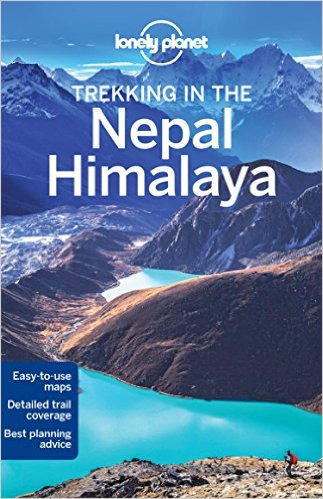
The Three Passes Trek is quite challenging as it involves traversing very high passes over 19 days of trekking. For this reason, we do not recommend trekking solo or without a guide who will have extensive knowledge and experience of trekking in the region.
A good guide book with a map, however, can be very useful when wanting to learn more about the area or when searching activities to do on your rest or acclimatization days.
The Lonely Planet Trekking in Nepal Himalaya guide is a regularly updated and informative guide that will include maps and sightseeing opportunities for a variety of treks in the region.
In terms of a map we recommend Nepa Maps – Three Passes and Everest Region map.
Detailed Itinerary
As with all treks, your journey to trek the Three Passes will start with an international flight into Kathmandu. A short flight to Lukla will precede the start of the trek that takes you through the Dudh Koshi valley before looping around through Gokyo and heading to Everest Base Camp. The inwards leg will take you east over your final pass and back to Lukla.
Most tour operators will list the Three Passes Trek as an 18/19-day trek. Of these days, usually 15 will be spent trekking with a further 1 or 2 acclimatization days, meaning 14 days of actual trekking can be expected.
Day 1: Arrive in Kathmandu
Arrive in the capital of Kathmandu after what is sure to be a long flight from home. Make your way to the hotel where you can relax for a bit before setting out to explore some of the vibrant city.
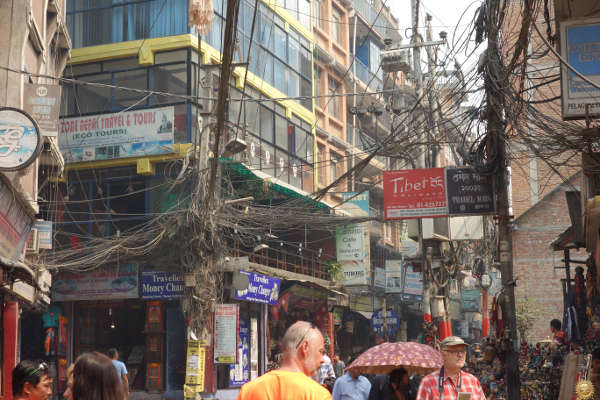
Vibrant streets of Thamel, Kathmandu
Day 2: Fly from Kathmandu to Lukla. Trek to Pkadking
An early morning flight will take you to Lukla, the starting point of the trek. Despite being only 35 minutes, the flight is a memorable one! Try to sit on the right-hand side of the plane for the best views of Everest as you approach Lukla.
The trek starts with fairly short descent to Phadking, where you will pass stone walls decorated with prayer inscriptions – called Mani in the local language. You will spend the night in Phadking.
Day 3: Trek to Namche Bazaar
The trek to Namche Bazaar will see you enter the Sagarmatha National Park , a UNESCO World Heritage Site. The village of Namche Bazaar is the central trading post of the region and is always bustling with life.
Day 4: Acclimatisation Day
Day 4 is an acclimatisation day spent in Namche Bazaar. Explore the village, stock up on some much-needed snacks for the trek ahead and be sure to check out the bakery – one of the best! The market on a Saturday is also a major attraction.
Day 5: Namche to Thame
The trail now splits from the popular base camp route and heads north-west through the small Sherpa village of Thamo before reaching Thame, where you will be staying the night. Take some time to learn a bit about the local traditions and their intrinsic connection with the mountain on which you are standing.
Day 6: Thame to Lumde
4-5 hours of trekking will see you cross the Bhote Koshi river before heading up the valley to Lumde. As you start to gain altitude you should get some great views of the snow-capped peaks in the region.
Day 7: Lumde over Renjo La to Gokyo
Today you will encounter your first of the Three Passes – Renjo La. The route starts off easy but will soon turn into a hard day of hiking as you near the end of the ascent of Renjo La. Try to think of the magnificent views you will get at the top to motivate you!
After the pass, you will descend to the third of the Gokyo Lakes and then trek onto the village of Gokyo for the night. After some rest you can even climb up the ridge to get some amazing views of the lakes, the highest freshwater lake system in the world.
[adinserter block="5"]
Day 8: Gokyo Ri (Acclimatisation Day)
Today you climb your first peak Gokyo Ri for fabulous views of Cho Oyu. You will do this climb early and then have the rest of the day to rest.
Day 9: Gokyo to Thaknak
Cross the Ngozumpa Glacier – the largest glacier in Nepal – over the course of an easy day’s trekking. Once again, keep your camera close as you trek through this beautiful part of Nepal!
You will reach Thaknak where you will go on a small acclimatization hike before lodging for the night.
Day 10: Over Cho La to Zungla
Often considered the hardest day of the trek, today involves traversing the second pass of Cho La. At over 5,300m, reaching the top will require some effort.
You will spot the famous prayer flags as you near the top of the pass, after which you descend over the other side of the pass to reach Zungla.
Day 11: Zungla to Gorak Shep
Start the day with an easy downhill portion to reach Lobuche, one of the major stops on the classic Everest Base Camp Trek. Join up with the crowds of trekkers as you make your way to Gorak Shep.
You will be afforded great views of the famous Khumbu Glacier as well as the peaks of Everest, Lhotse and Nuptse. Spend the night in the busy Gorak Shep.
Day 12: Gorak Shep to EBC and back
A short trek following the ridge of the Khumbu Glacier will take you to the Everest Base Camp. Make the most of your time here, as trekking groups are not typically allowed to stay overnight at the base camp.
Feel the buzz and excitement of the place, packed with potential future summiteers of Everest! Descend later that day down the same ridge back to Gorak Shep for some much-earned rest and sleep.
Day 13: Kala Patthar hike and then onto Lobuche
An early morning start is needed to summit the trekking peak of Kala Patthar – the iconic viewpoint of Everest. After snapping some pics, head back to Gorak Shep for a quick meal before descending further to Lobuche for the night.

View of Everest, EBC and Khumbu Glacier from Kala Pattar
Day 14: Kongma La Pass and onto Chukkung
You leave the classic base camp route today as you head east through the Khumbu Glacier to reach the third and final pass of the trip – Kongma La Pass. At 4,700m the pass is the highest of the three and lacks any shops or tea houses along the way.
After a tiring ascent to the top, descend into the Chukkung Valley and eventually to the village of Chukkung where you will stay in the lodge overnight.
Day 15: Chukkung Ri and then to Dingboche
Today you will climb Chukkung Ri (5,550m) and trek to Dingboche (4,410m)This peak is the hardest of the three you can attempt on this treks and involves some easy scrambling near the summit. The views from the top down the Khumbu Valley are superb. You descend to Dingboche where you will stay in a lodge overnight
Day 16: Dingboche to Namche Bazaar
A downhill trekking day will take you through the verdant fields and rhododendron covered hillside on your way to Namche Bazaar. Pass through the village of Khumjung where you can eat lunch before completing the descent to Namche Bazaar where you will stay overnight.
Day 17: Namche to Phakding
You continue through Namche Bazaar, descend Namche Hill and cross the Dudh Koshi. You are now sauntering back along familiar paths to Phakding. Overnight lodge.
Day 18: Phakding to Lukla
The last day of trekking will take you through some lovely pine scented forests before reaching Lukla where a cold drink and a hot meal await you!
Day 19: Fly back from Lukla to Kathmandu
Weather permitting, catch the morning flight back to Kathmandu to end off what is sure to be the trip of a lifetime.
Day 20: Depart Nepal
After your last night in Nepal, make your way to the airport to hop onto your flight back home, where you can tell all your friends and family about the time you had!
Altitude Profile
The altitude chart below shows the typical progression of the Three Passes Hike through the major stopping points along the way. The three spikes of the passes are clearly visible along with the spike of Kala Patthar – the iconic viewpoint.
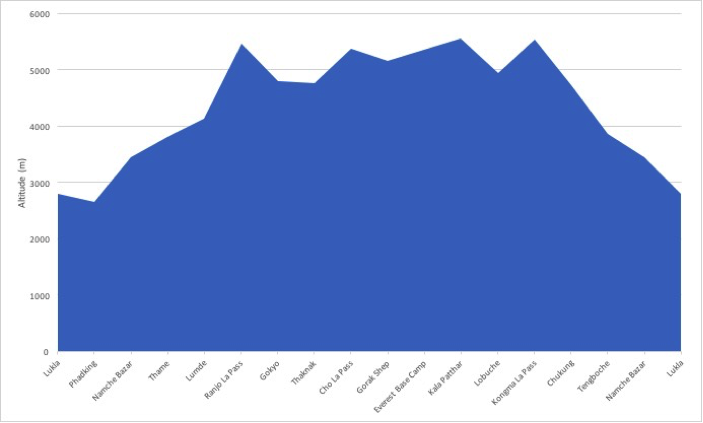
The ascent profile of this trek is slightly harder than the classic Everest Base Camp trek because it involves rapid ascents of the passes.
Three Passes Trek FAQ
How much does the three passes trek cost.
Tour operators will charge in the region of £1,200 to £2,500 for a guided Three Passes Trek. We definitely recommend using a tour operator for a trek of this difficulty and length – preferably a western tour operator whose guides and equipment will be of a higher standard.
The cost will include all board and lodging for the 18 days, all domestic travel and domestic flights, meals, shared equipment and knowledgeable guides. For a detailed breakdown of costs on the classic Everest Base Camp Trek, read our article here .
When is the best time to trek the Three Passes?
As with all treks in the Everest region, it is advisable to avoid the winter months as well as the peak summer months during the monsoon season. The shoulder months of February-May and September-October provide the most stable and dry weather conditions for trekking.
Our detailed article on the best time to trek in the Everest region will give a much more in-depth analysis of the conditions faced in different months.
How difficult is the trek?
The Three Passes Trek is considerably harder than the classic Everest Base Camp Trek so we recommend you have a good fitness level before embarking. Ascending the high passes involves long days of strenuous trekking that would not be encountered on the classic base camp trek and other variations.
6/7 hours of trekking per day is to be expected and altitudes of up to 5,500m are reached on the trek. That being said, the trek is still very popular among people wanting a bit more of a challenge. Read our training article to get an idea of how much you should prepare for a trek in Nepal.
Will I get altitude sickness?
Despite crossing some very high passes, the trek has been designed to follow the principle of trek high, sleep low. That means that you will not be spending extended periods of time at altitudes above 5,000m. The itinerary also has acclimatisation days as well as nights spent at lower altitudes to help the acclimatisation progress. If you follow the guide you should not have a problem.
That being said, altitude sickness can affect anyone regardless of age or level of fitness so we recommend doing some preparation reading. Our detailed article on altitude sickness and acclimatisation is a good starting point.
What gear should I pack for the Three Passes Trek?
The packing list for a trek of this length can look quite long! For this reason, we have dedicated an article to help you tackle the challenge that is packing. In our Everest Base Camp Trek packing list we provide list of clothing and equipment that you should bring, as well as some brands that we recommend based on our experience of using them.
What insurance do I need?
The short answer is yes. Trekking in Nepal at high altitudes comes along with various risks that are not covered by typical travel insurance. We recommend taking out insurance that covers trekking to altitudes up to 6,000m as well as medical evacuation from the mountain.
We have a detailed article to help to find the best policy that will suit your needs. Alternatively, use the quote calculator below from our recommended partner, World Nomads. They offer insurance that covers guided hikes up to 6000m and include a premium for Helicopter Evacuation in Nepal.
Route Variations
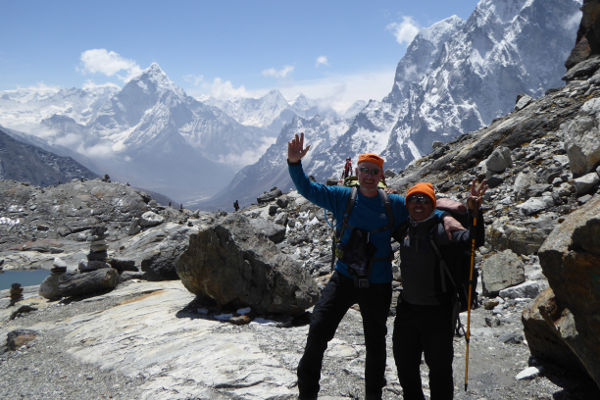
One of the more popular variations of the Everest Base Camp Trek , the Gokyo Lakes Trek, also starts at Lukla and follows the classic base camp trek to Namche Bazar where it forks north-west.
The trek proceeds through the towns of Dole and Machhermo before reaching the stunning Gokyo Lakes. From there you ascend to the peak of Gokyo Ri in the north, before traversing Cho La Pass and re-joining the classic trek at Lobuche.
The detour adds 2/3 days onto the trek but provides the wonderful opportunity to summit a peak while also avoiding some of the busier parts of the trek.
Gokyo Lakes Trek
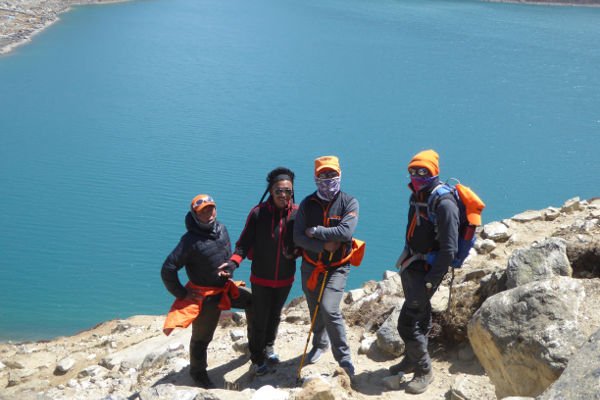
One of the more popular variations of the Everest Base Camp Trek, the Gokyo Lakes Trek, also starts at Lukla and follows the classic base camp trek to Namche Bazar where it forks north-west.
Jiri to Everest Base Camp

This variation of the classic trek offers an alternative to flying into to Lukla from Kathmandu to start the trek. The Jiri variation starts with an 8-hour bus ride from Kathmandu to Jiri, where the trek begins.
The variation adds an extra 5/6 days onto the trip as you trek through the Solu-Khumbu region and make your way past Lukla, where the trek then follows the same route as the classic Everest Base Camp Trek.
It involves a scenic, yet very long, bus ride as well as a lot more exposure to the Tibetan and Sherpa cultures. Expect to trek through more forests and streams as you start at the relatively low altitude of 1,800m and work your way up to Lukla and beyond.
Island Peak Climb

The variation trek that involves summiting Island Peak is significantly harder than the classic Everest Base Camp Trek. The climb to the peak is somewhat technical although and requires basic knowledge of using crampons and ice axes. Standing at just under 6,200m, however, altitude can be the real challenge.
Most climbers of Island Peak use the traditional base camp trek as a means of acclimatising before heading to the Island Peak Base Camp via Dingboche on the main trail, or by traversing the Chongma La pass. Summiting from the base camp typically takes two days and the whole variation will add around 4 days onto the classic trek.
Mark Whitman
Hi, I'm Mark! Welcome to EBC Trek Guide - the Web's No.1 Trekking Guide to Everest Base Camp. I have trekked all over Nepal, but the Everest region remains my favourite. I hope you find all the answers you are looking for on this site. If you have any questions don't hesitate to drop a comment below! Happy Trekking!
Leave a Reply
Your email address will not be published. Required fields are marked
Thank you. How slippery or rocky is the terrain on cho la pass? I don’t feel comfortable boulder hopping or walking on slippery terrain. You can train for uphill or distances but being able to balance on icy or scree surfaces is something else. We are looking at going in october . Any comments would be most welcome.
Hi Brigitte, the Cho La Pass consists of mix terrain that can vary quite considerably depending on prevailing weather conditions during the week you go. In general through you can expect mixed rock / scree terrain with areas that can be a little slippery with black / blue ice. Careful footing throughout is important. Show cover is quite likely too so it is worth taking basic yak tracks just in case you need additional grip. Hope this helps!
Is the path traveled and visible? Are there cairns, that Point the pass? Are there some kind of signs along the path? Is it easy to get accommodation for the night? Thank you
Hi Francisco, the three passes trek does follow a well defined route but it is not very well signposted. I would recommended taking a guide and / or getting a detailed map of the region. Accommodation throughout the route is not a problem, there are many small villages on the route and all have teahouse accommodation for trekkers. All the best!
What do you do for food along the route? The 3 peak pass in particular. Do you buy food for the day at every tea house? Thanks
Hi Frank, there are lots of teahouses along the Three Passes trek. In terms of lunch you can usually find a teahouse to stop at half way through your daily trek, or take a snack with you and only stop for dinner.
Thanks for the reply Mark!
Thanks for the useful information. Is this trek possible late December-early January? I did ACC last year late Dec-early Jan (including Tilicho), and it was wonderful, although desperately cold at higher altitudes. I assume this trek is colder as I would spend more time at higher elevation. I also appreciated that although less crowded that time of the year, there was good company in the higher teahouses and passes. Although I have no problem trekking alone, I would not feel completely comfortable spending days around 5000m completely alone. So my question would be, is this trek less crowded generally and colder than Annapurna Circuit?
Hi Daniel, I would say this trek will be colder than the Annapurna Circuit in Dec/Jan as you spend a lot more time at high altitude. The passes are also prone to closing in the winter if the weather is bad and there has been a lot of snow fall. I would definitely recommend taking a guide if you plan to trek the three passes.
I am planning for three pass trek in the first week of may. I have 15 days Itinerary. Is it possible to get it done including island peak. I am fit and I have plan to walk 9 hours per day. Plz let me know.
Thanks & Regards, Gopal
Hi Gopal, it’s possible to complete the 3 passes trek in 15 days, but the risk of altitude sickness (unless you are pre-acclimatised) is pretty high. Adding in Island Peak in addition would be a big ask, but doable if you are super fit and deal with the altitude well on the passes trek.
Hello there. I’m planning on attempting the 3 passes trek November 20-Dec 9 of this year. Is there a reason that you suggest clockwise? Most of the other places I have seen are suggesting counterclockwise. Any info would be greatly appreciated. Thanks!
Hi Murphy, thanks for getting in touch. I have no strong preference for either format. The reason why I suggest the clockwise route is because this is the I followed when completing the 3 Passes. The counterclockwise is equally as valid though.
Hi Mark, I am thinking about doing the Three Passes Trek. I have done Kilimanjaro one year before and further I do sport (mostly running, climbing, cycling) 3-4 times a week. However, I have never trekked for 19 days at high altitude and I don’t do a lot of trekking in my free time. Neither do I live in a place where my body is accustomed to higher altitude. I wonder if this is a trek I could do? Thank you in advance for your thoughts.
Hi Elene, you definitely sound fit enough to complete the 3 Passes. The key is to pace yourself, build in enough acclimatisation days to get accustomed to the high altitude, and make sure to look after your health with a good diet throughout. If you completed Kilimanjaro, you can definitely do the Three Passes. All the best!
Hi Mark thanks for all your useful information. I’m hoping to complete the Three Passes soon. I have years of experience. When would you suggest is the earliest I can expect to safely complete it. Mid-February OK?
Hi Rick, mid Feb can still be quite snowy and the passes may be closed. If you can push your dates a little bit further out – to mid March – then the probability of closed passes reduces (obviously there are no guarantees though). All the best!
Get a quote from the best local trek operator in Nepal!

- Duration: 21 Days
- Diffculty: Moderate Plus
- Best Time: Marc - May, Sept - Dec
- Max. Altitude: 5550 m
Three Passes Trek - A Complete High Altitude Route in Everest
Three Passes Trek offers the ultimate trekking experience in the Everest region. This 3 passes trekking explores the high pass routes in the Himalayas. This is a strenuous and less-trodden high-altitude trek in Nepal. It best suits to experienced trekkers with good physical fitness. The three-pass route links four distinct valleys in the Everest region. We hike the four valleys of Bhotekoshi, Gokyo, Khumbu, and Imja Tse simultaneously. We traverse the rugged high passes of Renjo La, Chola, and Kongma La. All of them are above 5000 meters. We climb three peaks of Gokyo Ri, Kalapathar, and Chukung by hiking to EBC. No need to have any climbing skills to join. It is purely a challenging trek. This high route offers an excellent adventure journeying in Nepal.
Everest Three passes trek with seven superb destinations over 5000 meters. Renjo La, Chola, Kongmala, Gokyo Ri, Kalapathar, EBC and Chukung Ri. A Truly Himalayan journey of a lifetime.
Everest 3 High Passes of Renjo, Chola, and Kongmala in Nepal
The Three Passes Trek in Nepal begins with an exciting flight to Lukla. Then, we spend two nights at Namche for proper acclimation. We hike to the less-trodden trail via Thame and Lungden on our way to Gokyo. These settlements are close to the Tibet border. However, The Renjo la challenges its rewards with stunning views. Arguably the best ideas of the entire journey. From the pass, you can get the parades of Himalayan giants, including Mt. Everest, with pristine Gokyo lakes in a single frame. We hike the Gokyo Ri, the first of three peaks on our list from Gokyo. We walk over the largest Ngonumpa glacier on our way to Chola. Later on, we join the famous Khumbu Valley trekking route at Lobuche. We hike the Kalapathar peak and explore the Base Camp of mighty Everest.
We cross the Kongmala, the less trodden and rugged pass. From Chukung, we climb our third peak: Chukung Ri. It offers a stunning view of Amadablam, Lhotse, Nuptse, and Makalu. On our way down, we trek via the Thyangboche monastery and Namche. It makes a big circle to complete this three-pass trek: great memories and a tremendous sense of achievement. Look no further if you are looking for Nepal's high pass, less trodden route.
Three Passes Trek in Spring or Autumn 2023 and 2024
March to May and September to November is the best time for Three Pass Trek. We have fixed departure dates to join in the Spring or Autumn seasons of 2023 and 2024. We accept individual and group bookings. We offer an all-inclusive package at an affordable cost. This cost includes all of your expenses on the trek. We provide the full board meal with a twin-bedded room at a tea house on a hike. We ensure permit and Lukla flight, a reliable guide/crew on service. We run a responsible trek with a dedicated porter for each trekker. This provides the required help and plan adjustment to each trekker if needed. Most importantly, we carry supplementary Oxygen on a trek. This is a life-saving in case of Acute Mountain Sickness (AMS).
Himalaya offers more adventure options besides the three Passes Trek. High-pass trekking combines with trekking peak climbing in the Everest region. You can choose the Everest High Passes and Peak trip. This trip combines the Island peak with high passes trekking. Another less challenging alternative is the Everest Circuit Trek . This trek connects the Everest base camp with Gokyo Lake via the Chola.
Trip in Nutshell
- Venture to 3 passes and three valleys in the Himalayas.
- Crossing the Renjo, Chola, and Kangmala passes.
- Climb the Gokyo Ri, Kalapathar and Chukung peaks.
- Explore the less trodden Thame, Gokyo valley with Khumbu and Imtatse.
- A responsible trekking policy of 1 Trekker: 1 Porter.
- Safety backup with Oxygen Cylinder and Medical box
- Full board meals and accommodation in a trek.
- Best Three passes trek cost with guaranteed group departure dates.
You'll see in Trip

Day 1-2: Arrival in Kathmandu and trek preparation
Mountain Monarch representative will receive you at the Airport. Then, transfer you to the hotel check-in briefing about Hotel facilities. Pre-trek briefing and trek pack distribution. Traditional Nepali dinner with a cultural show in the evening. The next morning, a half-day city tour followed by gear checking and trek preparation
- Accommodation Hotel
- Meals welcome dinner
- Altitude 1340 M
Day 3-5: Hike to Namche and Acclimatisation Rest Day
Early morning flight to Lukla. Three-hour picturesque trek to Phakding for the first night sleeping in a mountain. Enter the Sagarmatha National Park World Heritage site. It offers spectacular high mountain views, including the majestic Mt. Everest. The following day acclimatization hike to Everest View Hotel. Afternoon explore the Sherpa Museum and the local market of Namche Bazar.
- Accommodation Tea house
- Meals B, L, D
- Altitude 3440 m
Day 6-8: Walk to Lungden via Thame and an acclimation rest day
Today we hike to Thame, the clockwise direction of Everest Base Camp. We follow the West Bhotekoshi River valley towards Nyangpala Pass. This is a gateway of the Tibet-Nepal traditional way.
It is a short day trek from Thame to Lungden. It takes about 4 hours in the direction of the Nangpa La. This is the glaciated pass on the Nepal-Tibet border. At Lungen, we spend our second day hiking to the surrounding Hills.
- Altitude 4370 m
Day 9: Trek to Gokyo crossing the Renjo la pass 5445 m
Start early to reach Rinjola on top of time for a great view. The views from the pass are incredible Majestic. Mt. Everest, Nuptse, Lhotse, Makalu, the fourth highest in the world. Many more gigantic Himalayan peaks, Cho- Oyu above 8000 m, in close view. We descend to Gokyo at an elevation of 4,7900 meters.
- Altitude 4790 m
Day 10: Exploration climb to Gokyo Ri and hike to Thangna
We start a steady ascent of Gokyo Ri early in the morning. Average 4 hours walk to top Nepal's best panoramic viewpoint. Afternoon we cross the glacier sections on the way to Thangna.
- Altitude 4700 m
Day 11: Trekking to Zhongla via Chola pass.
We start walking in the early morning to avoid unforeseen situations. In addition, the frozen condition has more stability advantages. So there are fewer chances of falling loose rocks before a pass. After the Pass, there are no hazardous sections to come across.
- Altitude 4830 m
Day 12-13: Hike to Gorak Shep via Lobuche and explore Everest base camp (5,365 m).
We traverse high pasture land before we reach Lobuche. We get Lobuche by lunchtime.
Walk the western side of Khumbu Glacier and pass the moraine to Gorak Shep. We hike Everest Base camp after lunch. It is a strenuous day excursion due to the high altitude.
- Altitude 5140 m
Day 14: Climb Kalapathar and walk to Lobuche.
Early morning Ascent Kalapathar with the help of a flashlight. The trail is challenging to follow in the dark. But gets rewarding views from the summit of Kalapathar. We descend to the lodge and take breakfast before continuing to Lobuche.
- Altitude 4910 m
Day 15-16: Hiking to Chukung crossing the Kongmala and climb the Chukung Ri
The route leads to wilderness away from the main trekking area. We walk carefully to climb and cross the glacier. Then we reach nearby the Nuptse wall. Steady climb toward the Kongmala pass, 5535 meters, the highest pass on our trip. The walk leads higher up and then descends towards the glacier pond. Furthermore, the walk leads to the Chukung village.
Chhukung Ri, 5,550 meters, is an accessible trekking peak. It used to be an NMA peak that required a climbing permit. Don't require any specific climbing gear and skills to summit this trekking peak. The summit view of parades of peaks is simply breathtaking.
- Altitude 4730 m
Day 17-19: Descend to Lukla via Pangboche and Namche
Descend the windy trail to Pangboche. We pass the beautiful village Dingboche set on the Imjatse valley. We explore the Pangboche monastery, the oldest in Khumbu Valley.
There can be a tendency to rush on the way back. We visit Tengboche Monastery, which sits on the lap of Amadablam Peak. We retrace our route back to Namche, making a big circle.
We trek out to Lukla and spend the last night on the trek. We celebrate the success of the trek with our crew.
- Altitude 3930 m
Day 20-21: Fly to Kathmandu and back home
This morning we fly back to Kathmandu. This will likely have Lukla to Ramechhpa flight and then drive to Kathmandu. It is due to the heavy air traffic at Kathmandu airport. The next day we organized the airport transfer for the onward flight,
- Meals Breakfast
Everest Three High Pass Trekking Itinerary. Check out the hiking route, elevation, walking hours, accommodation, and meals.
- Airport transfers on both domestic and international flights
- Standard hotel accommodation in Kathmandu on a twin with breakfast.
- Full board meals while on three passes trekking.
- Responsible for trekking, having a Porter for each trekker
- Accommodation at a teahouse or lodge on twin shares a private room.
- Welcome dinner with cultural program as listed in the itinerary.
- Half-day guided city tour with world heritage entrance permit.
- All Domestic flights and airport taxes are listed in the itinerary.
- Free use of quality trekking gear - sleeping bag, fleece liner, down jacket, and rain poncho as required.
- Professional trek guide trained in Wilderness First Aid and trek crew with salary, wages, transportation, proper insurance, and required trek gear.
- Supplementary OXYGEN cylinder and comprehensive First Aid Kit as a safety backup
- Complementary trek Duffle bag, Mountain Monarch T-shirts, and trek map
- TIMS or VDC trekking permit, Everest National Park entry fees, VAT, all government taxes, etc.
- Nepal entry Visa fees, Your travel insurance of any kin
- International Airfare
- All beverage drinks
- Main meals ( Lunch and Dinner) in cities.
- Tips and Items of personal expenses like the hot shower, battering charge, telephone, and beverage drinks
Dates & Availability
Here is the list of Three passes trek in Nepal with departure dates for the years 2023 and 2024.
This trip can be booked privately if you’re travelling solo or private.
My husband and I had an amazing trip to 3 Passes and Everest Base Camp area with Mountain Monarch and Ram as our trusty guide. This area is one of the most beautiful areas in the world! This is our 4th trip with the company so we have a great relationship with them knowing that they will do exactly what they promise and more. It was great to see Pradip again when he picked us up from the airport in Kathmandu - really nice to know that we have a friend there for us.Ram and the porters were excellent! Very personable! My husband was celebrating his 79th birthday on this trek and they made it all possible. Ram and the porters gave me plenty of encouragement as we went up the high passes. Because it was just the 2 of us on the trek, Ram was very flexible with the schedule. It worked out better to climb Kalapatthar and Gokyo Ri mid-day instead of early morning and the weather was perfect.At the end of the trek, Pradip picked us up again at the airport and drove us around so we could change our flight back home.We highly recommend Mountain Monarch, a Nepali company; they are terrific at coordinating!
Just back in Australia after completing a wonderful 3-Passes adventure with Mountain Monarch. The trip was perfectly organised and executed. I was a sole client for my trek with an awesome guide (Calendar) and a porter. Being one-on-one with the guide allowed us to tweak the itinerary to jam in a few extra bonus walks (Gokyo Lakes 4 and 5, and Island Peak Base Camp and Imja Lake). Also a shout out to Finjo who was my guide for the first 3 days of the trek while I was with a bigger group before we went our separate ways (me to 3-Passes, them to EBC).I could not be happier with my experience. The 3-Passes trek is certainly a challenge but the amazing views make it all worthwhile. It seems so much better to me to tackle this walk to see a much larger range of mountains, valleys and lakes than just walking up and back to EBC with the masses.
Fantastic experience. We did the Three Passes Trek with Mountain Monarch, and everything was perfect. Pradip was flexible on our booking due to Covid, and we rolled the date forward twice. When we were finally able to travel, we were met at the airport, and Pradip was at the hotel to greet us and take us for a welcome dinner. He also took us to the airport to fly to Lukla, where our guides Nima and Horizon met us with our four porters - 1 for each trekker, so they had reasonable loads. Nima and Horizon were excellent - did the correct acclimatization, including walking at a slow pace uphill; very informative about the views, local life, wildlife, and culture. Renjo La and Cho La were tough, long days, but we got there at the steady walking pace set. We had great rooms in the teahouses, and they really looked after us well with dinners, teas, and chocolate bars. One of our parties had a medical problem, and Nima dealt with this expertly. Horizon gave good advice on our capabilities, including getting myself and my wife to EBC and then to the top of Kalapatthar the next day. We decided to skip the final Pass and make a leisurely way down the Khumbu - Horizon was happy to switch the itinerary to meet our needs. After 18 days of trekking, Nima and Horizon became friends and Guides. Once back in Kathmandu, we were met again by Pradip, and then he personally took us to the airport for our trip home. Everything was so well organized and ran smoothly - I would totally recommend this local Nepalese company for a future trek.
Similar Trips

Everest Base Camp Trek
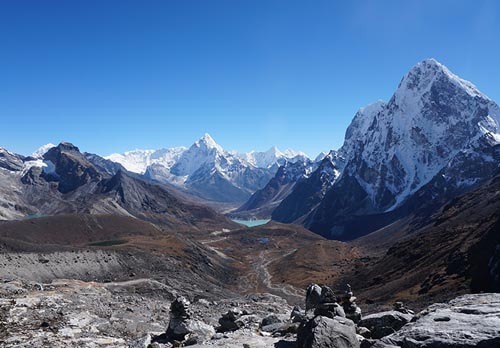
Everest Circuit Trek
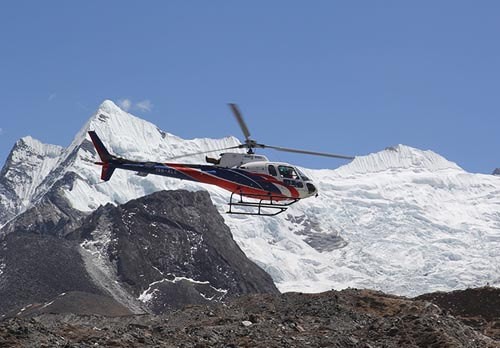
Everest Base Camp Heli Trek
We use cookies to ensure that we give you the best experience on our website.
- +9779851276377
- 977 01 5348594
- [email protected]
- Follow us on:
- Unternehmen
Everest Drei Pässe Trek
Direction indicator to renjo la pass, kongma la pass, on the way the to cho la pass, du kannst auch, was man vor dem trip wissen sollte.
- „Sicherheit, Zufriedenheit und Erfolg“
- 100% personalisierte Reisen
- Finanzieller Schutz und keine versteckten Kosten
- Gesetzlich eingetragenes Trekkingunternehmen in Nepal
- Umwelt und Gesellschaft Responsive
- Willkommen bei Nepal Mountain Trekkers
- Wir sind versichert. Bist du es auch?
Reiseeinführung
Unser Everest Drei Pässe Trek bietet Ihnen ein umfassendes Trekking-Erlebnis in der Everest-Region . Sie können drei hohe Pässe überqueren – Kongma La, Cho La und Renjo La. Dazu haben Sie noch Gelegenheit, das Everest Base Camp zu besuchen. Wenn wir in Richtung Gokyo Ri und Kala Patthar aufsteigen, haben wir einen atemberaubenden Panoramablick auf den Everest und weitere Gipfel. Der Trek gilt als anspruchsvolle Wanderung und wird von Besuchern bevorzugt, die möglichst viele Eindrücke mitnehmen wollen.
Everest Drei Pässe Trek: Kurzbeschreibung
Das Everest Drei Pässe Trekking-Abenteuer beginnt mit einem einzigartigen Flug von Kathmandu zum hochgelegenen Flugplatz von Lukla. Von hier wandern wir nach Namche Bazar, der Heimat der Sherpa . Nachdem wir uns zwei Nächte in Namche akklimatisiert haben, folgen wir dem beliebten Everest Trail durch Tengboche und Dingboche. Vor der Überquerung des ersten Passes Kongma La mit 5.535 m Höhe ruhen wir noch einen Tag in Chukkung aus. Anschließend setzen wir unseren Weg fort über Lobuche und Gorakshep zum Kala Patthar um denPanoramablick auf schneebedeckte Eisriesen wie Everest, Nuptse, Lhotse, Ama Dablam und andere zu genießen. Nach dem kurzen Aufstieg auf den Kala Patthar erreichen wir bald das Everest Basislager.
Unser Weg geht weiter über Dzong La bevor wir den nächsten Pass von Cho La überqueren um schließlich zu den unberührten Gletscherseen von Gokyo zu gelangen. Wir steigen dann auf den Gokyo Ri um einen großartigen Panoramablick zu genießen. Von dort führt uns der Weg zum letzten Pass Renjo La. Wir verbringen eine Nacht in Marlung und steigen in Richtung Namche Bazar und Lukla ab. Von dort fliegen wir zurück nach Kathmandu.
Everest Drei Pässe Trek: Anmerkungen
Dieser Trek ist perfekt für jeden Abenteuerliebhaber, der über eine gute körperliche Fitness verfügt. Die Überquerung dreier Pässe erfordert eine gewisse Ausdauer. Die beste Zeit für diesen Trek ist von Mitte April bis Mai und von Mitte September bis Mitte November. Denn das sind die Zeiten mit der besten Sicht und der geringsten Regenwahrscheinlichkeit. Nehmen Sie an unserem Everest Drei Pässe Trek teil und gönnen Sie sich diese unvergesslichen Momente. Die Erinnerungen werden Ihnen noch lange bleiben. Füllen Sie einfach das Buchungsformular aus und teilen Sie uns Ihr Interesse mit. Sie können uns natürlich auch mit einer E-Mail direkt kontaktieren um weitere Informationen zu diesem Trek zu erhalten.
Wenn dieser Ablauf nicht Ihren Vorstellungen entspricht oder wenn sie ihn ändern wollen, kntaktieren Sie uns. Dieser Trek kann entsprechend Ihren Zeit-und Budgetwünschen angepasst werden.
- Tag 1 Ankunft in Kathmandu (1,300 m/4,264 ft):
- Tag 2 Kathmandu: Sightseeing und Trekking Vorbereitung:
- Tag 3 Kathmandu - Lukla [2,840 m/9,320ft] - Phakding [2,652m/8,700ft]: 40 Minuten Flug, 3 - 4 Stunden Trekking (nur Trekking-Zeiten):
- Tag 4 Phakding zum Namche Bazaar [3,440 m/11,280 ft]: 7 - 8 Stunden Wanderung:
- Tag 5 Namche Basar: Tag der Akklimatisation:
- Tag 6 Namche Basar nach Tengboche [3,860 m/12,660 ft]: 5 - 6 Stunden:
- Tag 7 Tengboche nach Dingboche [4,360m/14,300 ft]: 6 - 7 Stunden:
- Tag 8 Dingboche nach Chhukung [4,750m/15,580 ft]: 3-4 Stunden:
- Tag 9 Akklimatisationstag in Chhukung:
- Tag 10 Chhukung nach Kongma La [5,535m/18,159ft] und dann nach Lobuche [4,940m/16,210ft]: 7 - 8 Stunden:
- Tag 11 Lobuche zum Gorak Shep [5,170 m/16,961ft], dann zum Everest Base Camp [5,364 m/17,594 ft] und zurück zum Gorak Shep: 8 - 9 Stunden::
- Tag 12 Gorak Shep nach Kala Patthar [5,545 m/18,192 ft] und dann nach Dzongla [4,830m/15,850 ft]: 6-7 Stunden:
- Tag 13 Dzongla nach Cho La [5,368m/17,611 ft] und dann nach Thangnak [4,680m/15,350 ft]: 8-9 Stunden:
- Tag 14 Thangnak nach Gokyo [4,800m/15,580 ft]: 3-4 Stunden:
- Tag 15 Ruhetag in Gokyo und Aufstieg zum Gokyo Ri [5,357m/17,575 ft]: 4-5 Std .:
- Tag 16 Gokyo nach Renjo La [5,360m/17,585 ft] und dann nach Marlung [4,210m/13,810 ft]: 8 - 9 Stunden:
- Tag 17 Marlung nach Namche Bazar: 5 - 6 Uhr:
- Tag 18 Namche Bazzar nach Lukla: 7 - 8 Uhr:
- Tag 19 Flug von Lukla nach Kathmandu: 40 Minuten Flug:
- Tag 20 Abreisetag:
Wegbeschreibung im Detail
Tag 1: Ankunft in Kathmandu (1,300 m/4,264 ft)::
Bei Ihrer Ankunft in Kathmandu werden Sie von einem Mitarbeiter der Nepal Mountain Trekkers an den Ankunftsterminals des internationalen Flughafens Tribhuwan abgeholt und zu Ihrem Hotel ( Hotel Green Horizon ) gebracht. Nach dem Einchecken im Hotel können Sie sich in der Freizeit im gemütlichen Zimmer entspannen oder bis zum Ende des Tages durch das Touristenzentrum Thamel schlendern.
Tag 2: Kathmandu: Sightseeing und Trekking Vorbereitung::
Wir beginnen unseren Tag mit dem Frühstück und besuchen das Büro der Nepal Mountain Trekkers in Thamel. Nachdem wir mit unserem Team bekannt gemacht wurden, machen wir uns auf den Weg zu den notwendigen Trekkingvorbereitungen und besorgen uns die notwendige Ausrüstung. Sie können die Sehenswürdigkeiten von Kathmandu zu erkunden, die zum Weltkulturerbe gehören. Kathmandu Durbar Square, Swayambhunath Stupa, Pashupatinath Temple und Boudhanath Stupa sind UNESCO-Weltkulturerbestätten, die wir bis zum Sonnenuntergang erkunden. Übernachtung im Hotel in Kathmandu.
Tag 3: Kathmandu - Lukla [2,840 m/9,320ft] - Phakding [2,652m/8,700ft]: 40 Minuten Flug, 3 - 4 Stunden Trekking (nur Trekking-Zeiten)::
Unser Tag beginnt mit einem gesunden Frühstück im Hotel in Kathmandu. Anschließend werden Sie zum Flughafen gebracht, um unseren kurzen Inlandsflug von Kathmandu nach Lukla, dem Tor zum Everest, zu nehmen. In nur 45 Flugminuten haben wir eine wunderbare Gelegenheit, schneebedeckte Berge zu sehen und landen in kürzester Zeit zwischen den Hügeln des Flugplatzes Tenjing-Hillary. Nach der Ankunft in Lukla werden wir mit unserer Trekking-Crew bekannt gemach. Danach beginnt unsere Trekking-Aktivität in Richtung Phakding. Es wird ein aufregender erster Trekkingtag in der Everest-Region. Übernachtung in Phakding.
Tag 4: Phakding zum Namche Bazaar [3,440 m/11,280 ft]: 7 - 8 Stunden Wanderung::
Wir frühstücken und beginnen unsere Reise mit wenigen Anstiegen und Abstiegen. Wir gehen über eine Hängebrücke den Fluss Dudhkoshi . Dann geht es schrittweise weiter in den Sagarmatha-Nationalpark in Monjoo und weiter in Richtung Jorasale, bis Sie das beliebte Sherpa-Dorf Namche Bazar erreichen. Heute machen wir einen kurzen Stopp in Chautara. Dort haben sie fabelhafte Ausblicke auf schneebedeckte. Wir übernachten in Namche Bazar.
Tag 5: Namche Basar: Tag der Akklimatisation::
Heute haben wir unseren ersten Akklimatisationstag. Es ist sehr wichtig, eine angemessene Akklimatisierung zu haben, um mögliche Risiken einer akuten Berg- oder Höhenkrankheit zu vermeiden. Während der Akklimatisationstage wird empfohlen, sich körperlich zu betätigen, anstatt sich nur auszuruhen. Wir machen daher eine kurze Wanderung in der Nähe von Thame oder schauen uns einfach Namche-Basar an. Hier haben wir auch die exklusive Gelegenheit, gleichgesinnte Reisende und Everest-Gipfelstürmer zu treffen und den Lebensstil der Sherpa-Einwohner aus nächster Nähe zu betrachten. Wir übernachten in Namche Bazar.
Tag 6: Namche Basar nach Tengboche [3,860 m/12,660 ft]: 5 - 6 Stunden::
Wir beginnen unseren Tag nach dem Frühstück und setzen unsere Reise nach Tengboche mit einer atemberaubenden Aussicht auf die Everest-Himalaya-Gebirge fort. Wir machen uns nach und nach auf den Weg über wunderschöne Everest-Wanderwege, entdecken die alpine Flora und Fauna, essen zu Mittag in Phuki Thega und erreichen schließlich am Ende des Tages Tengboche. Die Hauptattraktionen hier ist der Besuch eines alten buddhistischen Klosters in Tengboche mit reichhaltigen kulturellen / traditionellen Einblicken und der nahe Blick auf Everest, Amadablam und andere benachbarte Gipfel. Übernachtung in Tengboche.
Tag 7: Tengboche nach Dingboche [4,360m/14,300 ft]: 6 - 7 Stunden::
Wir stehen früh morgens auf, um den fabelhaften Sonnenaufgang über den schneebedeckten Gipfeln des Everest-Himalaya-Gebirges zu genießen. Weiter geht es durch Imja Khola, wandern durch wunderschöne Rhododendronwälder und erreichen Deboche. Mit zunehmender Höhe werden die Aussichten immer schwerer und außergewöhnlicher. Folgen Sie den beliebten Everest-Pfaden, genießen Sie den klaren Blick auf den Himalaya mit schmeichelnden Gebetsfahnen und überqueren Sie dabei mehrere Chortens. Endlich kommen wir in Dingboche an und übernachten dort.
Tag 8: Dingboche nach Chhukung [4,750m/15,580 ft]: 3-4 Stunden::
Heute ist ein vergleichsweise leichter Trekkingtag mit drei bis vier Stunden Wanderung durch Täler und Gletschermoränen. In Kürze wird ein herrlicher Blick auf den Island Peak geboten. Es gibt uns nur das Gefühl, auf der ganzen anderen Welt zu sein, umgeben von schneebedeckten Gipfeln aus allen Richtungen. Nach einer Stunde Fußmarsch von Bibrey erreichen wir Chhukung. Übernachtung in Chhukung.
Tag 9: Akklimatisationstag in Chhukung::
Chhukung ist der Ort, an dem wir zwei Nächte verbringen werden, um uns für große Höhen richtig zu akklimatisieren. Es ist sehr wichtig, an unserem Akklimatisationstag einige körperliche Aktivitäten zu unternehmen. Deshalb machen wir das Beste daraus, indem wir uns auf den Weg zum Gipfel des Chukkung Ri machen, der die noch nie dagewesene Südwand von Lhotse, den AmuLapcha-Pass und Amadablam bietet, umgeben von außergewöhnlichen Welleneis Wänden. Am Ende des Tages kehren wir zurück nach Chhukung für die Übernachtung.
Tag 10: Chhukung nach Kongma La [5,535m/18,159ft] und dann nach Lobuche [4,940m/16,210ft]: 7 - 8 Stunden::
Am frühen Morgen vor Sonnenaufgang stehen wir auf und beginnen unsere Tagesreise bei Sonnenaufgang mit Lunchpaket und Trinkwasser, da es bis Lobuche keine Teehäuser mehr gibt. Nehmen wir die vor uns liegende Herausforderung an. Den Kongma la Pass erreichen wir nach fünf bis sechs Stunden (maximale Höhe von 5535 m über dem Meeresspiegel), Genießen die raue Natur und den atemberaubenden Blick auf schneebedeckte Berge, Gletscher um uns herum. Endlich kommen wir in Lobuche an, wo wir eine Nacht verbringen werden.
Tag 11: Lobuche zum Gorak Shep [5,170 m/16,961ft], dann zum Everest Base Camp [5,364 m/17,594 ft] und zurück zum Gorak Shep: 8 - 9 Stunden:::
Wir lassen Lobuche hinter uns und machen uns auf den Weg durch die Moränen des Khumbu-Gletschers mit Blick auf den Nordgrat vom Everest, Mt. Nuptse und andere benachbarte schneebedeckte Berge. Nach der Ankunft in Gorakshep machen wir uns auf in Richtung des Basislagers des höchsten Gipfels der Welt, dem Everest-Basislager auf 5364 m. Bei der Ankunft im Everest-Basislager, wo wir den Campingplatz der Everest-Gipfelstürmer sehen wo sich diese auf die Everest-Expedition vorbereiten können. Später kehren wir zur Übernachtung nach Gorakshep zurück.
Tag 12: Gorak Shep nach Kala Patthar [5,545 m/18,192 ft] und dann nach Dzongla [4,830m/15,850 ft]: 6-7 Stunden::
Wir stehen früh morgens auf und beginnen unseren Tag mit einer Wanderung von Gorakshep nach Kala Patthar, wo die Wetterbedingungen ziemlich herausfordernd sind. Nachdem wir den Gipfel des Aussichtspunkts Kala Patthar erreicht haben, können wir einen atemberaubenden Panoramablick auf den Everest-Himalaya-Bereich genießen, der wie ein magisches Erlebnis erscheint, wenn die Sonne langsam schneebedeckte Gipfel wie mit goldener Farbe überzieht. Wir streifen einfach ein paar Momente durch die Schönheit, machen viele Fotos und kehren in Richtung Gorakshep zurück. Weiter lassen wir Gorakshep hinter uns und wandern drei bis vier Stunden in Richtung Dzongla.
Tag 13: Dzongla nach Cho La [5,368m/17,611 ft] und dann nach Thangnak [4,680m/15,350 ft]: 8-9 Stunden::
Unser Tag beginnt, in dem wir uns auf den Weg machen und vom Teehaus aus, die schöne Aussicht auf den nahen Himalaya genießen. Wir werden heute eine ziemliche Herausforderung erleben, wenn wir den hochgelegenen Cho La Pass überqueren und in Richtung Thagnak weiter gehen. Am Cho La Pass weiter auf grosse Höhen über 5300 m aufsteigen, tauchen wunderbare Aussichten auf schneebedeckte Gipfel auf, die sie noch nie gesehen haben. Besonders die Nahaufnahmen von Cholatse und Amadablam sind spektakulär. Während wir diesen Auf- und Abstiegen folgen, achten wir sorgfältig darauf, dass keine Verletzungsgefahr besteht, da sich möglicherweise rutschiges Eis auf die Felsen legt. Auf diese Weise kommen wir nach kurzer Zeit endlich in Thangnak an, wo wir übernachten werden.
Tag 14: Thangnak nach Gokyo [4,800m/15,580 ft]: 3-4 Stunden::
Wir machen eine gute Pause in Thangnak und tanken neue Energie, um unser Everest Three Pass-Abenteuer in Richtung Gokyo fortzusetzen, das durch den längsten Ngozumpa-Gletscher führt. Nach ein paar Stunden erreichen wir das wunderschöne Gokyo-Tal und erkunden die erstaunliche natürliche Schönheit der Gokyo-Seen mit ihrer spektakulären alpinen Umgebung. Wir übernachten in Gokyo.
Tag 15: Ruhetag in Gokyo und Aufstieg zum Gokyo Ri [5,357m/17,575 ft]: 4-5 Std .::
Es wird unser letzter Akklimatisierungs- oder Ruhetag in Gokyo sein. Wir besteigen heute den Gokyo Ri, einen bekannten Aussichtspunkt für atemberaubende Ausblicke auf die Everest-Himalaya-Kette. Die Erkundung von Gokyo wird auch zum Anlass genommen, kristallklare türkisfarbene Gokyo-Seen zu besuchen, die sich über 5000 Metern befinden. Wenn Sie mehr erkunden möchten, können Sie auch an den Ufern der Seen weiter gehen und eine hervorragende Aussicht auf Everest, Nuptse, Lhotse, Makalu, Cho-Oyu und andere benachbarte Gipfel genießen. Je nach Verfügbarkeit und Ihrem Interesse gibt es in der Umgebung von Gokyo viele andere exquisite Orte, die Sie besuchen können. Schließlich kehren wir zu unserem Teehaus in Gokyo zurück.
Tag 16: Gokyo nach Renjo La [5,360m/17,585 ft] und dann nach Marlung [4,210m/13,810 ft]: 8 - 9 Stunden::
Unter den drei Pässen in unserem Everest Three Pass Trek überqueren wir heute den letzten Pass von Renjo La und beginnen den Tag früh am Morgen, um unser Ziel zu erreichen. Nachdem wir das Gokyo-Tal hinter uns gelassen haben, nehmen wir den Weg in Richtung Renjo la Pass und erreichen nach ein paar Stunden Trekking durch die alpine Umgebung des Renjo La Pass, eine eisige Steintreppe. Wir gehen vorsichtig und kommen nach einer Stunde in Marlung zum nächtlichen Halt an.
Tag 17: Marlung nach Namche Bazar: 5 - 6 Uhr::
Der Weg, der von Marlung absteigt, ist eine bekannte alte Handelsroute für tibetische Händler. Auf demselben Weg überqueren wir einige Flüsse und Bäche und erreichen das kulturell reiche und schöne kleine Dorf Thame. Hier in Thame haben wir die Möglichkeit, das beliebte Kloster zu besuchen und die im Mai abgehaltenen Festlichkeiten mit herrlichem Blick auf die Stadt zu genießen. Wir sehen schneebedeckte Gipfel wie Kusum Kangaroo und Thamserku. Auf ähnliche Weise erreichen wir Namche Bazar wieder, indem wir mehrere Hängebrücken überqueren, malerische Klöster besuchen und eine wahre Himalaya-Essenz einfangen. Wir ruhen uns in einem der Teehäuser aus und übernachten in Namche.
Tag 18: Namche Bazzar nach Lukla: 7 - 8 Uhr::
Wir folgen dem Abstieg und kehren heute von Namche Bazar nach Lukla zurück. Wenn wir vorsichtig durch wunderschöne Rhododendronwälder, über schroffe Pfade mit einem schönen Blick voller erstaunlicher Erinnerungen wandern, haben wir einen anderen Blick und eine andere Perspektive auf die Umgebung. Beim Abstieg in Richtung Lukla erinnern wir uns an fantastische Dinge , die wir in den letzten zwei Wochen erlebt hatten. Übernachtung in Lukla .
Tag 19: Flug von Lukla nach Kathmandu: 40 Minuten Flug::
Die meisten Flüge von Lukla nach Kathmandu werden morgens durchgeführt, um Windstörungen am Nachmittag zu vermeiden. Bei ungünstigen Wetterbedingungen kommt es jedoch auch zu Flugverspätungen. Nach der Ankunft in Kathmandu feiern wir unseren Reiseerfolg zusammen mit unserer kostenlosen Spa-Behandlung. Am Ende des Tages genießen wir unseren Abschied im kulturellen nepalesischen Restaurant. Übernachtung im Hotel in Kathmandu.
Tag 20: Abreisetag::
Ihr Abenteuertrekking in Nepal heute zu Ende. Nachdem sie gepackt haben, bringen wir Sie zum Tribhuwan International Airport, damit sie Ihren geplanten Flug erreichen.
Im Preis enthalten
- Abhol- und Bringservice vom Flughafen
- 3 Hotelübernachtungen mit Frühstück in Kathmandu ( Hotel Green Horizon )
- Hygiene: Die von uns angebotenen Unterkünfte sind ordentlich und sauber mit herzlicher Gastfreundschaft und qualitativ hochwertigen Dienstleistungen.
- Einzelunterkunft: Sie müssen Ihre Unterkunft nicht mit anderen teilen damit Ihre Privatsphäre gewahrt bleibt.
- Sie erhalten einwandfreie hygienische Kost, um Sie wieder mit Energie zu versorgen.
- Verschwenden Sie keine Lebensmittel, die Versorgung im ländlichen Gebiet ist sehr schwierig
- Sie dürfen Ihre Mahlzeiten nicht mit anderen Personen aus einer anderen Gruppe teilen.
- Transportkosten: Inlandsflug in (Kathmandu – Lukla – Kathmandu) und alle erforderlichen Landtransporte.
- Lokale Mitarbeiter: Unsere Guides sind Einheimische aus der Region um zu gewährleisten dass Sie während der Wanderung bessere Informationen erhalten können als mit allen anderen Guides.
- Erfahrung: Unsere Trekking-Guides verfügen mit einer Erfahrung von mehr als einem Jahrzehnt über ausgezeichnete Kenntnisse im Briefing während des Trekkings und sie sind Experten im Umgang mit allen Arten von kritischen Situationen, die während der Tour auftreten können.
- Versicherung: Alle unsere Trekking-Mitarbeiter sind über unsere Agentur versichert
- Lokale Mitarbeiter: Unsere Träger kommen auch aus der Region, in der wir wandern und damit haben die Einheimischen eine Verdienstmöglichkeit und Sie können von ihrem Wissen profitieren.
- Trekking-Genehmigungen: Gebühren für die TIMS-Karte und den Sagarmatha-Nationalpark
- T-Shirt, Reisetasche und Trekkingkarte mit Firmenlogo
- Organisation des Rettungsdienstes
- Erste-Hilfe-Box
- Ausrüstungsgegenstände wie Schlafsäcke und Daunenjacken können gemietet werden
- 13% MwSt. Und 10% Servicegebühr
- Abschiedsessen
Nicht enthalten
- Visagebühr für die Einreise nach Nepal ( Visa-Informationen )
- Internationale Flugtickets und zusätzliche Gepäckgebühren
- Essen in Kathmandu und Pokhara
- Zusätzliche Übernachtungs- und Verpflegungskosten in Kathmandu aufgrund einer Änderung der geplanten Reiseroute
- Reiseversicherung / Rettungskosten
- Alle persönlichen Ausgaben
- Alkoholische /nicht alkoholische Getränke
- Trinkgelder für Führer und Träger
Nicht enthaltenTrip Gallery
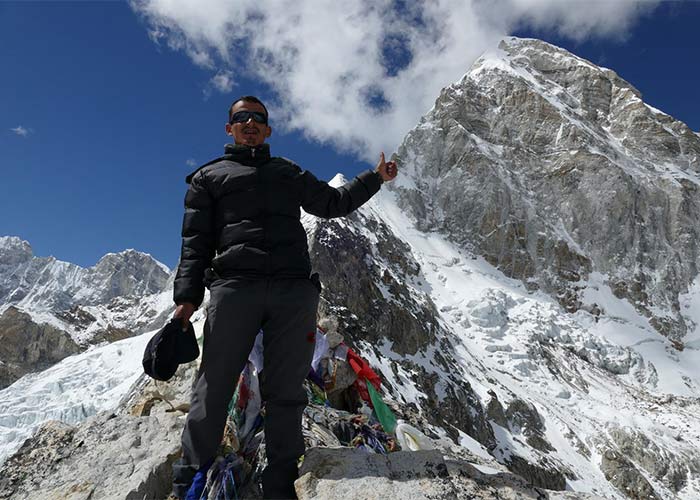
Ausrüstungsliste
- Sonnenhut oder Schal
- Leichte Sturmhaube oder warme Fleece Mütze
- Sonnenbrille
- Sonnencreme (40+) und Lippenbalsam
- Baumwoll-T-Shirts und Thermounterwäsche
- Fleecejacke
- Daunenjacke
Unterkörper
- leichte Baumwollhose (lang)
- Thermounterwäsche
- dünne Innensocken (3 Paar)
- dicke, warme Trekkingsocken
- bequeme Wanderschuhe
- Duschsandalen
- Handschuhe (Baumwolle und wasserdicht)
- Desinfektionsmittel
- Schlafsack bis -10 ° C +
- Trekkingrucksack / Tasche
- große Plastiktüten (um den Inhalt des Rucksacks trocken zu halten)
- Trekkingstöcke (optional, empfohlen)
- Wasserflasche oder Camelbag
- Toilettenartikel / Toilettenpapier
Erste-Hilfe-Sets
- Persönliche regelmäßige Medikamente
- evtl. benötigte Bandagen
- Blasenpflaster
Ähnliche Trips
Das Könnte lhnen auch gefallen
- View Details
- Enquire Now
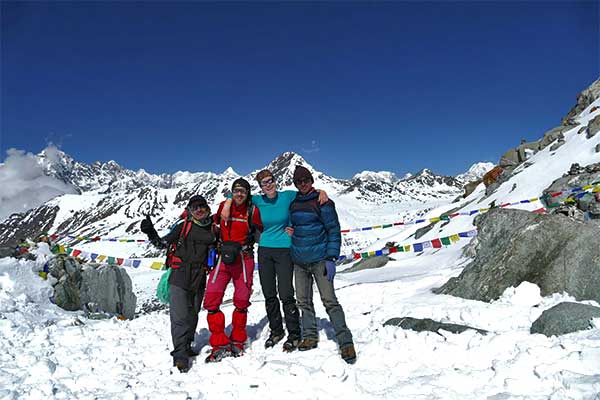
Everest Base Camp - Chola Pass Trek
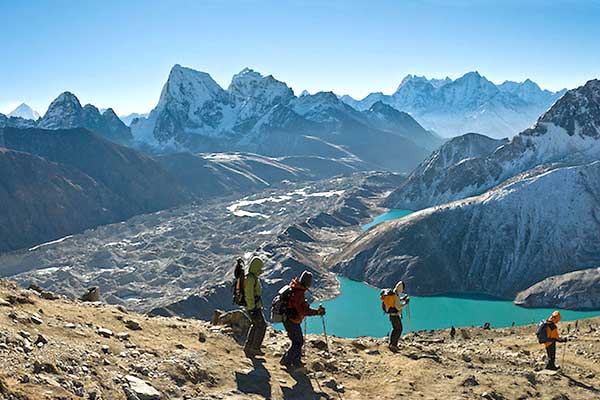
Gokyo Seen und Gokyo Ri Trek
- anstrengend
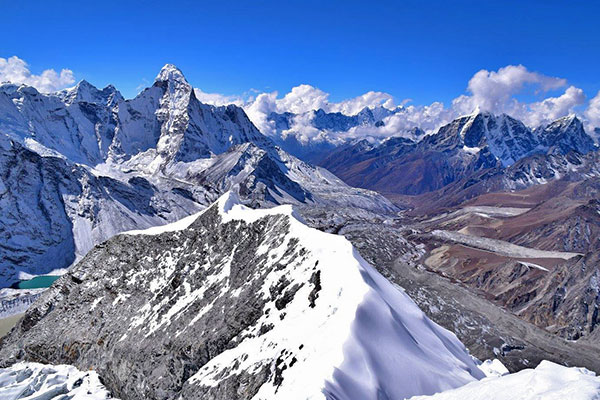
Everest Base Camp und Island Peak
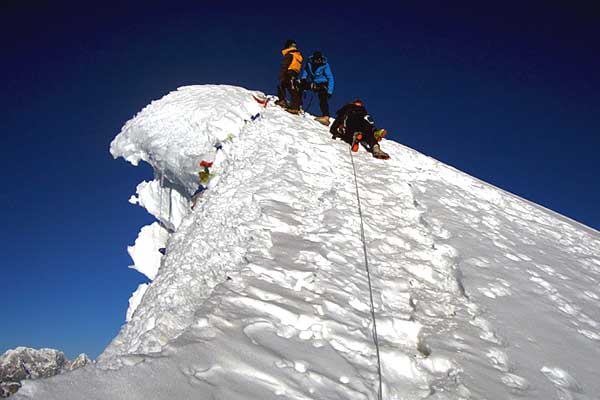
Everest Base Camp mit Lobuche East Peak Besteigung
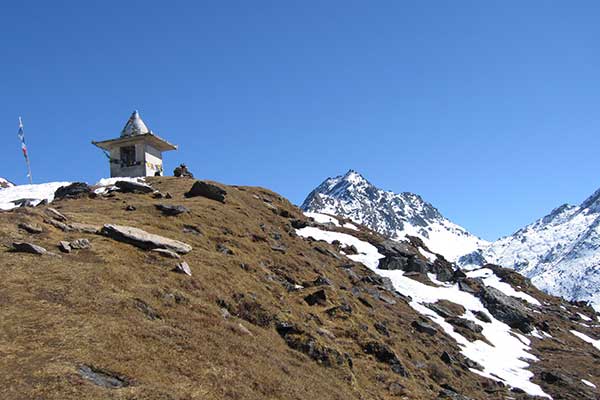
Langtang Gosainkund Laurebina Trek
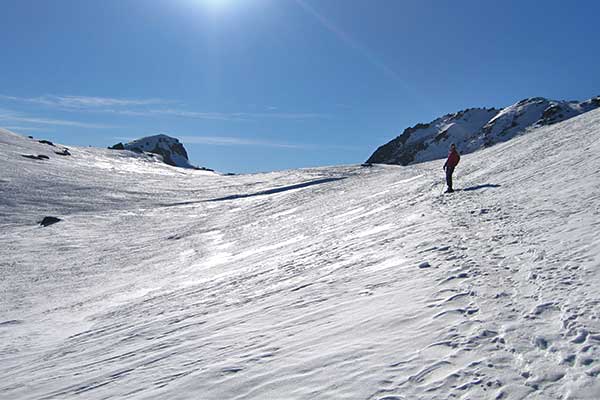
Gosainkund und Laurebina Pass Trek
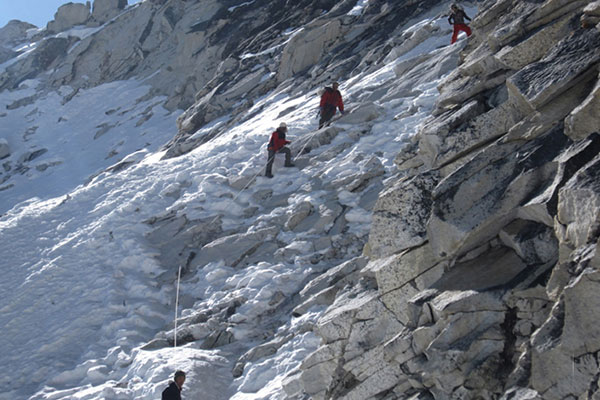
Mera Peak und Amphu Laptsa Pass
Partner von.
Schicken Sie eine Nachricht
Vor- und Zuname*
Ihre Nachricht*
- Africa & the Middle East
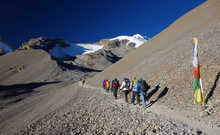
- The Three Passes Trek
- Kandoo Trekking
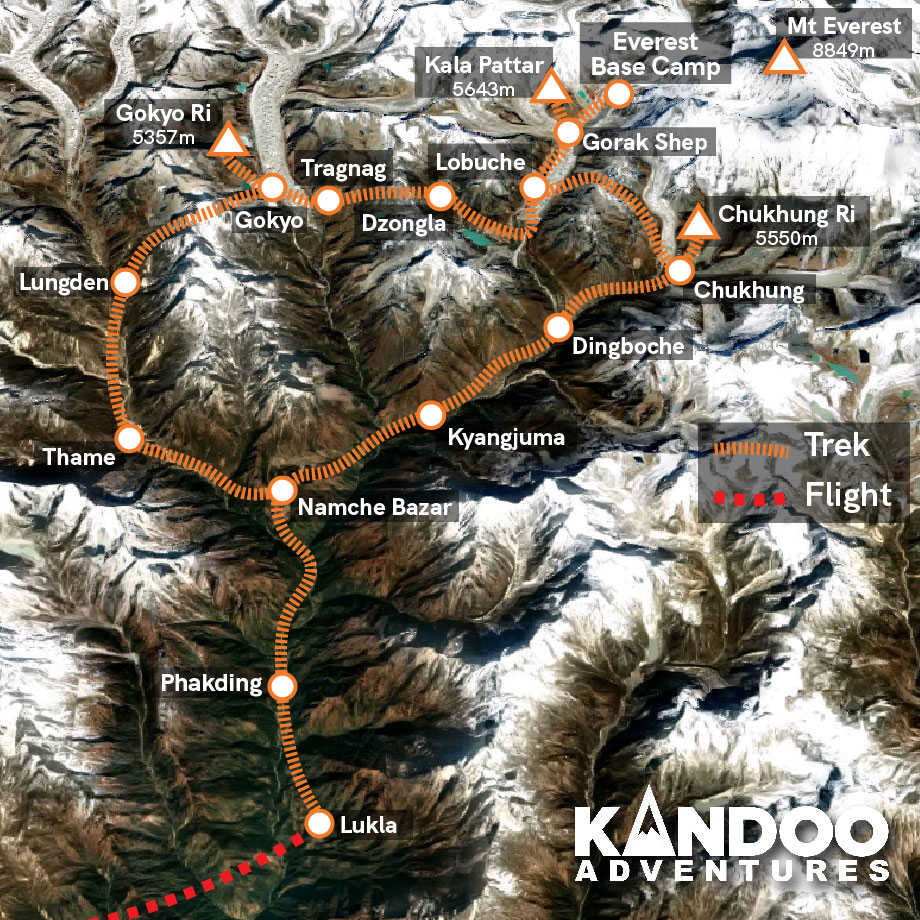
Contact our UK team
Our local team
Kandoo's view, trip highlights.
- An amazingly scenic circular route, climbing three peaks
- Cross the challenging Renjo La, Cho La and Kongma La Passes
- Lodge-based accommodation
Experiences
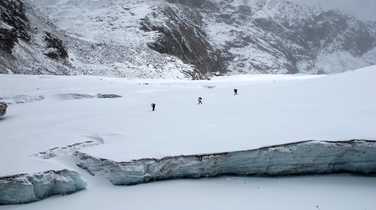
ARRIVE IN KATHMANDU
All trekkers need to organise their own flights to Kathmandu International Airport (KTM). From the airport we will arrange a private transfer to your hotel. That night you will meet your local Kandoo representative and have a full pre-trek briefing
- Accomodation: Hotel
FLIGHT TO LUKLA – TREK TO PHAKDING
The flight from Kathmandu to Lukla takes 45 minutes and is an adventure in itself with great views of the Everest region and ending with a hair-raising landing on a steep mountain runway. After meeting our crew, we will start our trek by heading up the Dudh Koshi Valley on a well- marked trail to Phakding.
- Transport: Flight (0.8 hour, 136 km)
- Hiking time: 3 - 4 hours
- Ascent: 1500 m
- Descent: 144 m
- Max. altitude: 2800 m
- Accomodation: Teahouse
- Meals included: Breakfast
TREK TO NAMCHE BAZAAR
From Phakding, we cross and re-cross the river on high suspension bridges. Beyond Monjo is the entrance to the Sagarmatha National Park. We then ascend steeply to Namche and along the way, if the weather permits, catch the first glimpse of Mt Everest. Namche Bazaar is the main trading village in Khumbu and has a busy Saturday market. You can enjoy an Illy coffee and amazing brownies here!
- Hiking time: 6 - 7 hours
- Ascent: 794 m
- Max. altitude: 3450 m
ACCLIMATISATION IN NAMCHE
Namche is tucked away between two ridges and has lots of lodges, tea shops and souvenir shops. Today we will trek up to the Everest View Hotel at 3880m for our first view of Ama Dablam and Mount Everest. Following the ‘walk high, sleep low’ principle, this hike will really help with your acclimatisation.
- Ascent: 430 m
- Descent: 430 m
- Max. altitude: 3880 m
TREK TO THAME
The trail now splits from the popular base camp route and heads north-west to the village of Thame where you will be staying the night. Take some time here to learn a bit about the local traditions and their intrinsic connection with the mountain on which you are standing.
- Hiking time: 4 - 5 hours
- Ascent: 434 m
- Max. altitude: 3884 m
TREK TO LUNGDEN
Today we will start to climb back up to higher altitude heading up the valley to Lungden. Make sure you have your camera at the ready as the higher you go the views across the snow-capped peaks in the region just get better and better.
- Ascent: 496 m
- Max. altitude: 4380 m
TREK TO GOKYO VIA RENJO LA PASS
Today wewill encounter the first of the Three Passes – Renjo La. The route starts off gently but will soon turn into a hard day of hiking as we near the end of the ascent to Renjo La. Try to think of the magnificent views you will get at the top to motivate you! After the pass, we will descend to the third of the beautiful turquoise Gokyo Lakes and then trek onto the village of Gokyo for the night.
- Hiking time: 7 - 8 hours
- Ascent: 1008 m
- Descent: 638 m
- Max. altitude: 5388 m
ASCENT OF GOKYO RI
Today you climb your first peak, Gokyo Ri, for fabulous views of Cho Oyu. We start the climb early and then have the rest of the day to rest to help our acclimatisation. If we still have energy, then later in the day we can hike up some of the surrounding moraine ridges and enjoy the views. As a treat for all our hard work we can then tuck into some delicious cake from the wonderful Gokyo bakery.
- Ascent: 733 m
- Descent: 733 m
- Max. altitude: 5483 m
TREK TO TRAGNAG
We leave Gokyo to cross the Ngozumpa Glacier. We descend to the second lake and drop down onto the glacier. The route across the glacier is marked by cairns and is generally quite well defined. We climb off the glacier and follow a shallow valley to Tragnag.
- Descent: 60 m
- Max. altitude: 4750 m
TREK TO DZONGLA VIA CHO LA PASS
An early start is required today to cross the Cho La Pass and make the long descent to Dzongla. Continuing up the valley, we cross a ridge and an old lateral moraine, before beginning the rocky scramble to the pass. From the top there are excellent views, across to the Rolwaling Valley in the west and Ama Dablam to the south east. The descent from here involves crossing a small glacier which is fairly straightforward. There are more excellent views of Ama Dablam and Cholatse as we descend.
- Ascent: 730 m
- Descent: 590 m
- Max. altitude: 5420 m
TREK TO LOBUCHE
The way to Lobuche contours the grassy slopes above a lake, the Tshola Tsho, to join up with the main Everest trail from Pheriche and Tengboche. The trail flattens out and follows the valley on the west side of the Khumbu Glacier to Lobuche.
- Ascent: 98 m
- Descent: 4928 m
TREK TO GORAK SHEP – EVEREST BASE CAMP – GORAK SHEP
To reach Everest Base Camp, we follow the Khumbu Glacier. The trail offers superb views of the surrounding mountains, especially where the path is forced to rise to cross a tributary glacier. We stop at Gorak Shep before making our way to Base Camp itself. This takes several hours as the trail weaves its way through ice pinnacles and crevasses of the Khumbu Glacier.
- Hiking time: 8 - 9 hours
- Ascent: 436 m
- Descent: 200 m
- Max. altitude: 5364 m
ASCENT OF KALA PATTAR - TREK TO LOBUCHE
An early morning start is needed to summit the trekking peak of Kala Pattar – the iconic viewpoint of Everest. After snapping some pics, we head back to Gorak Shep for a quick meal before descending further to Lobuche for the night.
- Ascent: 390 m
- Descent: 626 m
- Max. altitude: 5554 m
TREK TO CHUKHUNG VIA KONGMA LA PASS
We leave the classic base camp route today as we head east through the Khumbu Glacier to reach the third and final pass of the trip – Kongma La. At 5,535m the pass is the highest of the three. After a tiring ascent to the top, we descend into the Chukhung Valley and eventually to the village of Chukhung where we will stay in the lodge overnight.
- Ascent: 607 m
- Descent: 785 m
- Max. altitude: 5535 m
ASCENT OF CHUKHUNG RI - TREK TO DINGBOCHE
Today we will climb Chukhung Ri - the hardest of the three peaks on this trek which involves some easy scrambling near the summit. The views from the top down the Khumbu Valley are superb. We descend to Dingboche.
- Ascent: 800 m
- Descent: 1190 m
- Max. altitude: 5550 m
TREK TO KYANGJUMA
We now descend back to the main Everest trail through Pangboche before climbing to the monastery at Tengboche. From Tengboche we make a steep descent before climbing back up to Kyangjuma where we will stay overnight in a lodge.
- Descent: 696 m
- Max. altitude: 4360 m
TREK TO PHAKDING
We continue through Namche Bazaar, descend Namche Hill and cross the Dudh Koshi. We will trek back along familiar paths to Phakding where we will stay the night.
- Descent: 1008 m
- Max. altitude: 3664 m
TREK TO LUKLA
Our final day's trekking follows the Dudh Koshi back down to Lukla. This last evening in the mountains is the ideal opportunity for a farewell party with the Sherpa guides and porters, where you can look back on a memorable trekking experience.
- Ascent: 144 m
RETURN TO KATHMANDU
After an early breakfast, we will begin our return journey to Kathmandu.
FREE DAY IN KATHMANDU
A free day in Kathmandu to explore the city at your leisure
DEPART FROM KATHMANDU
We will collect you from your hotel and transfer you to Kathmandu Airport for your departing flight.
Trip information
Formalities & health, equipment & clothing.
Treks in the Himalaya present a substantial physical challenge , and the more fit you are before you start, the more you will enjoy your trek. However, the number one most important thing to cultivate is mental toughness . Most of the people who trek in the Himalaya aren’t professional athletes or mountain climbers; they are average people with an unusual degree of determination.
If you are comfortable walking for 7-8 hours with an ascent of 1000m every day for two weeks then you are certainly fit enough to succeed on this trek. We find that all successful hikers share a real Kandoo attitude and that means high levels of grit and determination.
Food & drink
You choose what you want to eat at the lodges, and settle your own bill in the morning. While you can eat heartily for very little money at any lodge, we do recommend that you budget £20 to £25 ($30 to $35) per day for meals and drinks. This will ensure that you not only have plenty of food, but that you enjoy it a lot more. Where once there was a choice of perhaps 5 different rice or lentil based meals at any one lodge, most now offer a wide menu of 40 or more choices from the basic (such as dhal bhat) to the sophisticated (yak steak with blue cheese sauce).Please note that we prefer some of the more expensive lodges, so the prices are higher than they might be at more spartan facilities.
One word of advice, place your meal order as soon as you can upon arriving at the lodge as it is strictly ‘first ordered, first served’, and the best lodges are quite busy at meal times.
Accommodation
Trekking in Nepal is more popular than ever. As a result, the standard of accommodation available on most of the trek routes has improved dramatically. Where there were once simple peasant huts, large hostels have been built featuring running water, indoor toilets (some en-suite) and electricity. However, while internet access, charging facilities and hot water are available, you will need to pay to use them - if you plan on using the internet and showering every day, then you should budget around $10 per day.
However, development is still ongoing, and as you get higher into the mountains the lodges become more basic. Furnishing is generally fairly spartan, and most rooms feature little more than a bench bed and a thin mattress, so your sleeping kit will probably see some early use. Showers are not always available and it tends to be just the communal areas that are heated.
The exception to that rule is Namche. Namche features some really great lodges, including the Hil-Ten (this is not a region that makes much of copyright infringement) and if you are in need of refreshment there both Illy and Lavazza coffee are available
Kandoo has a list of lodges that we prefer to work with, all of which are regularly inspected to ensure the best quality rooms available. Even at the worst, they are clean and well-kept. When the route is busy, we send a porter ahead to hire rooms for the night, as they cannot be reserved in advance.
The general standard of driving throughout Nepal is poor and badly regulated . Roads in Kathmandu are very congested, many drivers are not properly licensed and vehicles are poorly maintained. During the monsoon season (June to September) many roads outside the Kathmandu valley are prone to landslides and may become impassable.
We insist on using a high standard of vehicle and driver for all of our transfers. In Nepal it is not a legal requirement to have seatbelts fitted in the back of vehicles, and while we try to use vehicles that do have rear seatbelts fitted, this cannot always be guaranteed. If you are unhappy about any aspect of the vehicle or the standard of driving, please speak to the driver or our local office.
Duffel bags
You will be provided with a large duffel bag at the pre-trek briefing that will be yours to use for the duration of your trek. Your equipment will then need to be transferred into this bag. If you are travelling with a duffel bag then it is up to you which bag you choose to use for the trek, if you are travelling with a suitcase then this will need to be left at the pre-trek hotel and collected upon your return as our porters need the bags they carry to be flexible.
All items must be packed in your main equipment bag. They should not be attached to the outside, as we are not responsible if items fall off when the bags are being carried on the trek.
How do I get there?
Budget & change.
If you are relying on a credit or debit card for emergency funds, make sure you tell your card issuer that you will be using it abroad, or you may find that it won't work when you really need it.
We realize that tipping may not be a common practice in all countries but for Nepal it is a standard practice that all operators support. The decision on how much to tip should be determined by how well the team served you while you were on the trek. Tips are always discretionary and if you are not happy with the service you have received you do not have to pay tips. Tips can be made in US dollars or Nepali Rupees. It is very important that US bills be new (less than 10 years old), crisp and untorn.
We are members of the Trekking Agencies Association of Nepal and the Nepal Mountaineering Association, and follow their guidelines when recommending tip levels for guides and porters. We would suggest you budget $175-$225 per trekker for your tip contribution.
We say goodbye to our porters in Lukla before we return to Kathmandu. Any tips that you wish to give to the porters will need to be carried on the trek with you.
Vaccinations
Equipment supplied by kandoo adventures.
We do not have other gear available for rental but there are many places offering gear for rental in Kathmandu and we can recommend a number of places for you. The quality of rental gear is very variable and it is your responsibility to check carefully the condition of any item you rent. We accept no responsibility for the quality of equipment hired. An indication of the likely rental costs is below.
- Four Season Sleeping Bag - $2 per day
- Down Jacket - $2 per day
- Trekking Poles - $1 per day
Most of the rental shops close around 8pm, so if you are arriving on a late flight the day before the trek starts there will not be an opportunity for you to visit a rental store. If you are planning on renting equipment, you need to make sure you have allowed sufficient time at the beginning of your trip.
All rental equipment is included in your overall trekking bag weight, so make sure you have allowed for this when packing your bag at home. A sleeping bag will weigh around 2kg.
Clothing to bring
- Warm beanie style hat – knitted or fleece
- Neck gaiter or scarf. It can get dusty in Nepal and the air very cold. A scarf or balaclava comes in useful for keeping dust out and can double as a warm layer for your neck / face!
- Sun hat – preferably wide-brimmed for protection
- Sunglasses – high UV protection
- Headlamp (plus extra batteries)
- Thermal or fleece base layer (x2)
- Long sleeve shirt/tshirt – light or medium weight, moisture wicking (x3)
- Short sleeved shirt/tshirt – lightweight, moisture wicking (x2)
- Fleece or soft shell jacket (x2)
- Insulated jacket – down or primaloft
- Lightweight water/windproof hard shell outer jacket
- Gloves – lightweight, fleece or quick drying fabric
- Gloves or mittens – heavyweight, insulated, preferably water resistant
- Leggings – thermal or fleece base layer (x1)
- Trekking trousers – light or medium weight (x2) – convertible trousers work well
- Waterproof hard shell trousers – ski pants work fine (x1)
- Trekking boots – mid weight with good ankle support
- Training shoe or similar – to wear around the teahouses
- Micro-spikes – may be required in snowy conditions
- Mid-weight trekking socks (x5 pairs)
- Breathable, high-wicking liner socks (x3 pairs)
- Thermal trekking socks for upper reaches of your trek (x1 pair)
Equipment to bring
- Small Rucksack or Daypack (30-40 litres) to carry water and personal items
- Sleeping bag (4 season or -10 Deg C) and compression sack
- Trekking poles
- Water bottle or hydration bag – must be able to carry 1.5-2L of water
OTHER ACCESSORIES
- Sunscreen and lip balm - high SPF
- Toiletries, including toilet paper, wet wipes and hand sanitiser – please carry all rubbish back off the trail
- Camera and spare batteries
- Plug adapter, for charging devices in teahouses and hotels
- Personal medication and first aid kit
- Personal snacks and energy bars – dried fruit and nuts are also a good source of energy
- Isotonic drink powder / energy drink powder to mix in with your water. This improves flavour and helps replace electrolytes
- Microfibre towel for wiping hands and face each day
- Ear plugs, if you are a light sleeper
- Pee bottle, useful for late night toilet needs
- Dry bag (only required if your main duffle bag is not waterproof)
Dates & prices
Want to ask us a question or book a private trip? Don't hesitate to contact us!
Price includes
- Your hotel stay for one night before and two nights after the trek
- All airport transfers
- Return flight between Kathmandu and Lukla
- National Park entry and TIMS fees
- A fully supported trek with a qualified mountain guide
- All drinking water on the trek
- Teahouse accommodation on a room only basis
- Access to emergency oxygen and first aid kit
Price does not include
- International airfares and visas
- Tips for your guides and porters
- Personal items
- Travel insurance (you must be insured, and specifically for treks up to 6000m)
- Your personal trekking gear
- Your personal medicines or prescriptions
- Meals and drinks on the trek
- Meals and drinks in Kathmandu (breakfast is included)
- Additional hotel nights before or after your climb
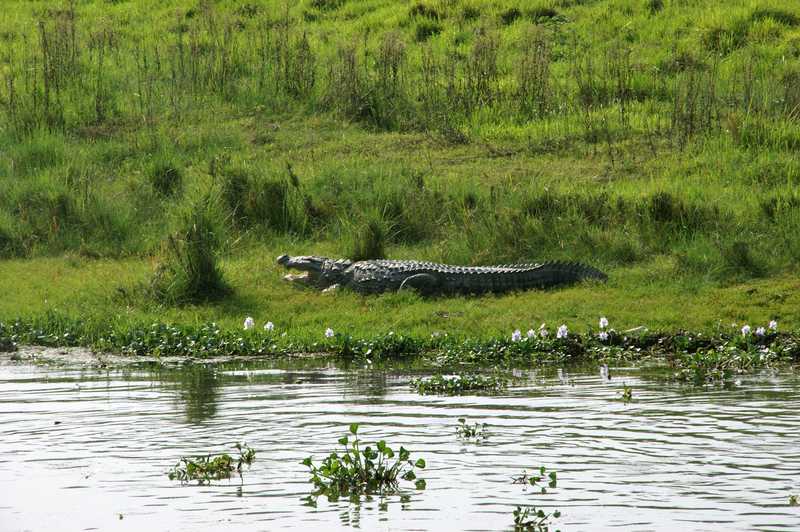
Chitwan National Park 3-day extension
You may also like.
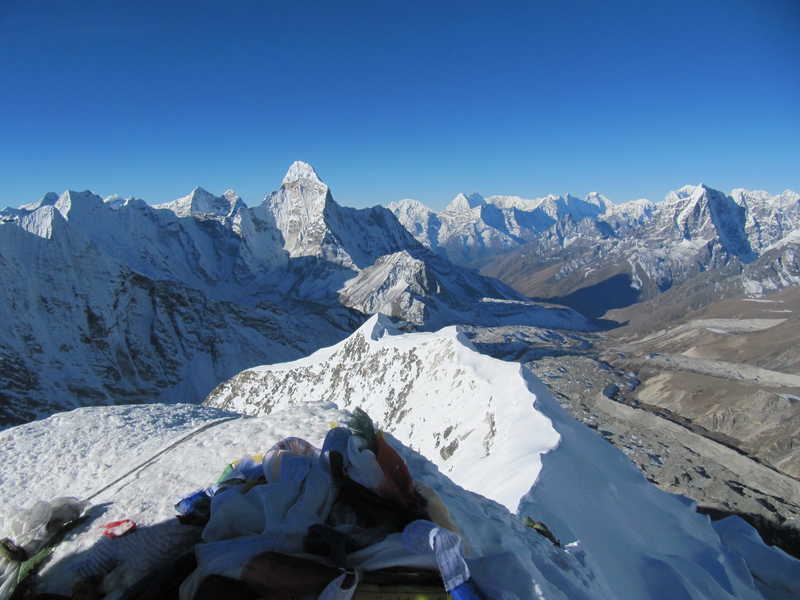
Everest Base Camp and Island Peak
- from $3,575
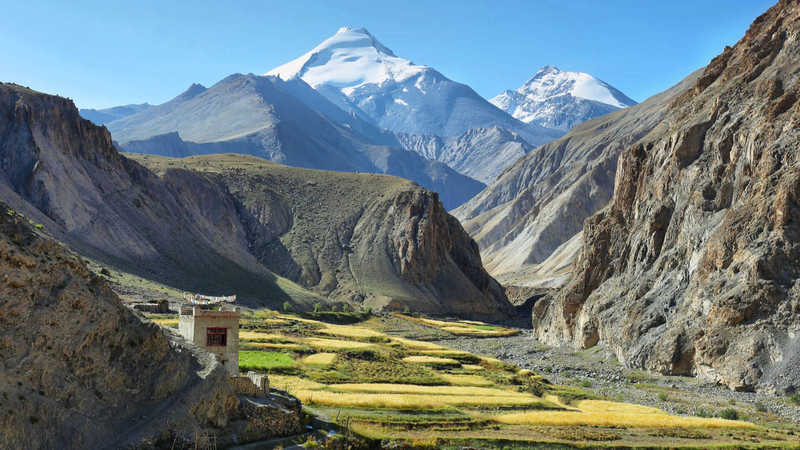
Markha Valley and Kang Yatse II
- from $2,335
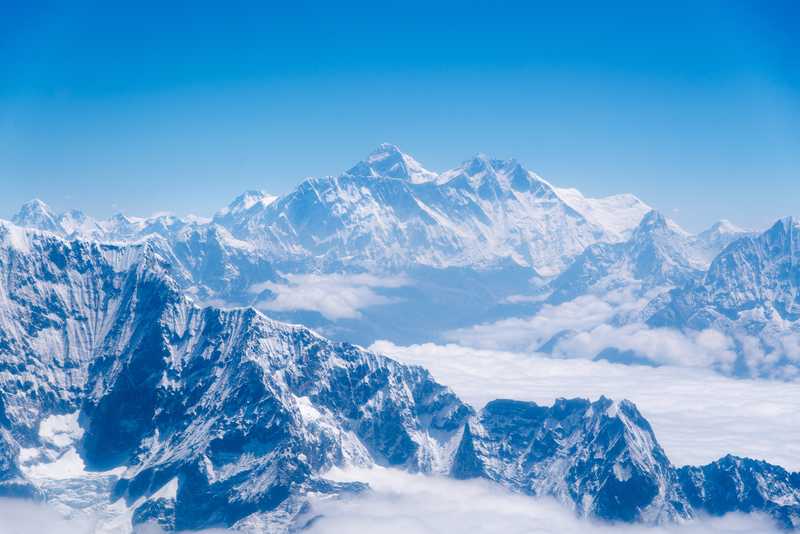
Everest Base Camp
- from $1,725
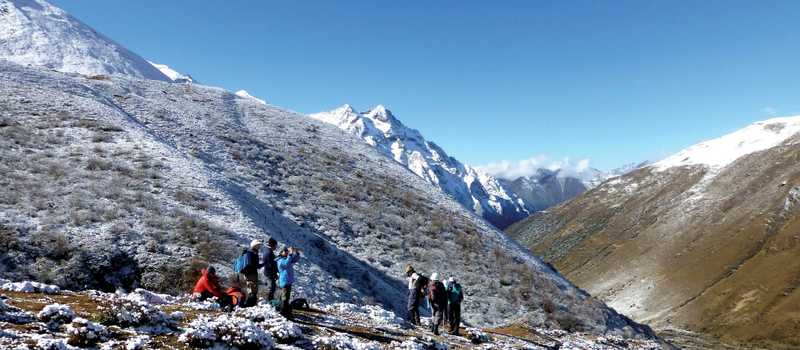
The Snowman Trek
- from $12,345
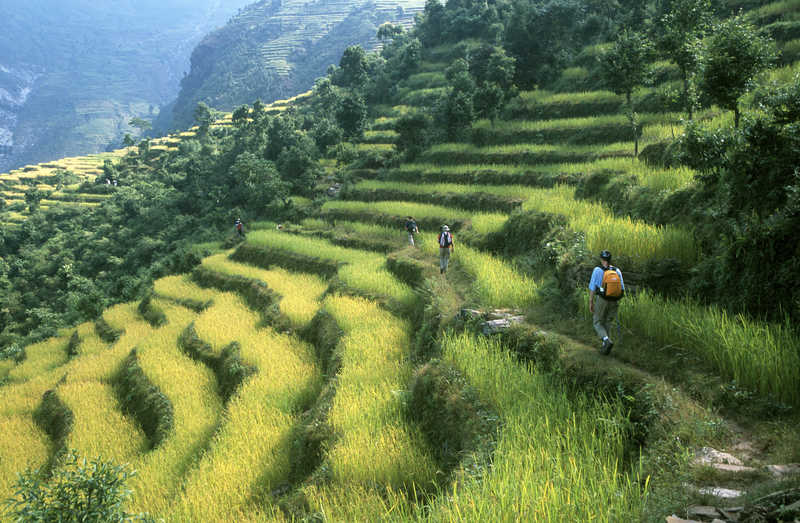
Poon Hill Trek
- from $1,365
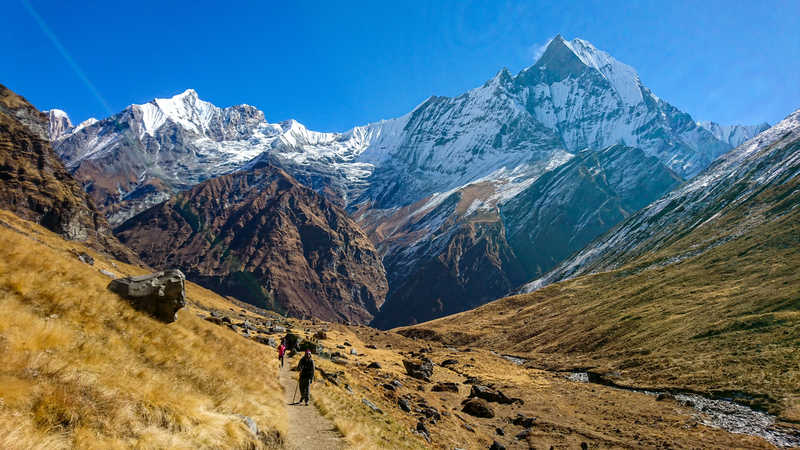
The Annapurna Sanctuary
- from $1,555
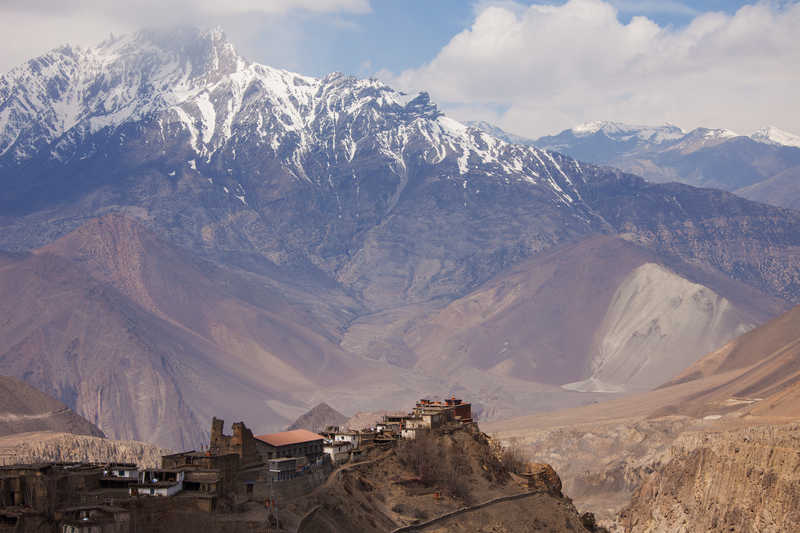
The Chomolhari Trek
- from $4,095
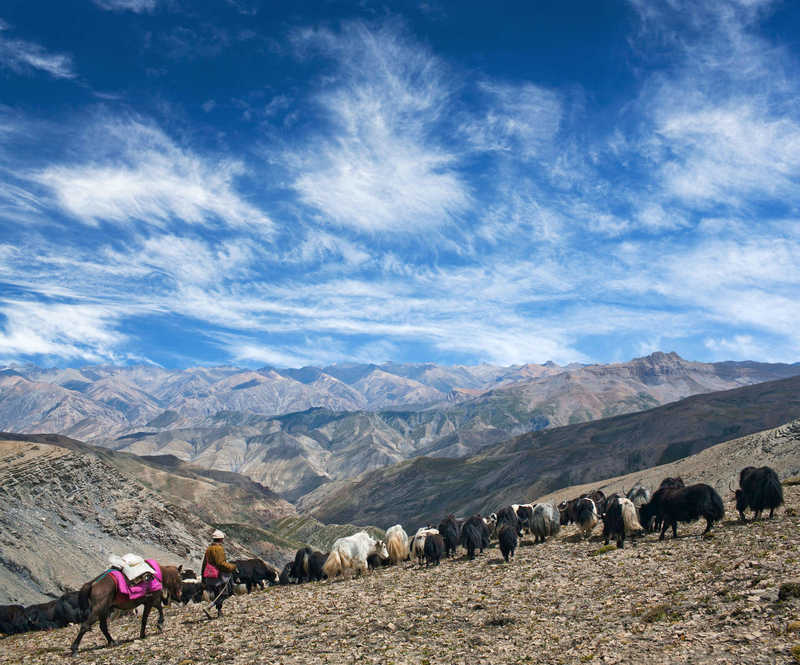
Changtang Lakes to Spiti Valley
- from $3,385
- Nepal Tourism
- Nepal Hotels
- Nepal Bed and Breakfast
- Nepal Vacation Rentals
- Flights to Nepal
- Nepal Restaurants
- Things to Do in Nepal
- Nepal Travel Forum
- Nepal Photos
- All Nepal Hotels
- Nepal Hotel Deals
- Last Minute Hotels in Nepal
- Things to Do
- Restaurants
- Vacation Rentals
- Travel Stories
- Rental Cars
- Add a Place
- Travel Forum
- Travelers' Choice
- Help Center
Three Passes Trek in December - Nepal Forum
- Asia
- Nepal
Three Passes Trek in December
- United States Forums
- Europe Forums
- Canada Forums
- Asia Forums
- Central America Forums
- Africa Forums
- Caribbean Forums
- Mexico Forums
- South Pacific Forums
- South America Forums
- Middle East Forums
- Honeymoons and Romance
- Business Travel
- Train Travel
- Traveling With Disabilities
- Tripadvisor Support
- Solo Travel
- Bargain Travel
- Timeshares / Vacation Rentals
- Asia forums
- Nepal forum

A friend and I are considering doing the Three Passes Trek in December (approx. 1-20/12. We have quite some experience doing Alpine hikes but are of course trying to prepare as good as we can, especially taking in to account additional challenges the winter months may bring. We're still having some questions, any insights would be greatly appreciated!
*For now it's still possible to hike Everest region without a guide despite Nepli restrictions, any indication what situation may be in December, or anyone's guess?
*Assuming it would be possible to start without a guide, how easy is it to find a guide "en route" for e.g. only the highest/most challenging passes if we would like so?
*Will a lot of tea houses already be closed, or on the contrary, likely increased odds of finding a spot due to low season?
*Can we expect a lot of snow high passes, are crampons or microspikes required?
*What are the odds of passes closing due to bad weather/too much snow? Are there alternative routes?
*At least one pass I saw crossing a glacier (Cho La), is there a risk of crevasses? I see most people crossing it without any ropes or other precautions.
*Is it possible to do the hike in the winter with trail shoes (e.g. Hoka Speedgoats, which already served me very well in the Alps), or are sturdier hiking boots?
*Are there other things to consider during winter months compared to high season? At the moment it looks like the only drawback is increased cold, but you get fewer crowds and clearer views in return. Provided you dress the part, it seems like a good trade-off. Anything we're missing?
*Sleeping bag or other cold clothing recommendations? (e.g. Temparature rating)
Thanks in advance for replying to any of these questions!
17 replies to this topic

December is a great time to do the Khumbu if you are well equipped. The weather tends to be super clear in December and it’s really quiet
Though many of the places will be closing there will still be enough places open and they will be happy to have your business.
Well equipped means I would say boots not shoes , decent merino socks , mini crampons and a sleeping bag that keeps you comfortable to minus 20 c bear in mind there will be plenty of blankets or duvets as well to put UNDERNEATH your bag.
It’s the Himalayas so there is always a chance of snow. My trip to Manaslu two years ago in November we had 50 cams of snow in two nights crossing the Larkye La and without the right gear I would have had to turn back.
I go with the same people but I am pretty sure you will be able to find a guide up there if thats what you want more likely though in say Namche but I’ve never done that myself .
Thanks, very useful.
Am a very big fan of Merino socks myself, typically even Merino liner + thick Merino sock. :)
Am not a big fan of heavy boots and very used to hiking with trail runners, even in the mountains, but not in the Himalaya, so will reconsider.
Currently have a down sleeping bag that goes to 3° C comfort (-18 extreme), I assume this won't be enough?
Indeed I read that typically there are plenty blankets, so a super warm sleeping bag is not required. Is a -20 comfort rating really required, or would e.g. -10 also suffice?
I used a -10 comfort bag last week of November/ 1st week of December in Khumbu no problem with a duvet underneath just depends on how you manage the cold it can easy be close to -20 at say Gorek Shep.
The boot issue is a moot one . I started off with a heavy pair of boots my first time which worked well with the micro crampons and the snow . I’ve migrated to lighter pairs now which the spikes don’t fit on quite so well or as comfortable when they are on but are less tiring than the rest of the time . My concern is shoes in wet snow even with gaters I feel i get wet feet with and maybe only physiologically boots even soft Goretex boots are safer for that
Finally I’ve talked to my mate who runs a trekking firm in Ktm he he says he is 90% certain this autumn season there won’t be an issue with solo trekking in the Khumbu but don’t hold me to that.
In any case have a good trip I’m in the Khumbu this year going to Gokyo in late November and back over the Renjo La and I doubt it will be much different to what you have maybe 2/3 degrees warmer but a lot busier . I would be going your time but I have commitments in the ski season which begin in the Pyrenees around 1 December

Hope your friend is right! I'm going to be in the Khumbu for about four weeks from November to early December!
Hey there I guess take guide for November to December three pass is difficult and hard .
Crampons are very important .
Sleeping bag is not needed nowadays it's very organised and good .
And also get your trekking insurance
And I guess the shoes will do good that you use in Alps otherwise there is the very good Nepali brand gold star just released new trekking boots did larke pass with it only 30$ so it won't be a huge problem.
Thanks @barcaranger and @balram for your insightful replies. :)!
For a bit of background, I have done the 3HPs 4 times, all in Dec - Jan, 2010-20. I have also done the full AC with aside trips 3 times in Dec - Jan, Langtang valley 3 times in those months usually with Gosainkunda, plus we attempted Manaslu in 2018-19, but could not get over the pass, as the lodges both sides were closed.
Mandatory Guide: impossible to say but my suspicion is that the situation in Dec 2023 will be much as it is now, ie that the new 'rules' will remain in place, but that people will still be able to trek without guides, especially in the Everest region. I trek with guides as I get on very well with the guides that I know, and trekking solo in the winter, especially on the high passes, would be quite risky (there were very few people trekking in mid winter back in 2010, when I started - this has changed, since). I find being with a Nepali really enhances my sense of being away somewhere different (from the UK, in my case). BTW I trek with the guides that I know (two brothers, one per trek) on a proper daily rate basis, so I get the same freedom as the indie trekkers. I engage and pay them directly, not via any middleman. Many people are under the impression that if you trek with a guide, you have to do so on an all-inclusive basis, or one where the guide makes all the decisions. All my treks with guides have been on a daily rate basis.
Finding a guide en-route: LingBKK I think is probably the best source - he has done this several times in the winter. Do make sure that if you hire someone, that they really do know the high pass trails, and are properly equipped. Many E region lodge staff nowadays are from other areas, and will not know the passes, how to trek at high altitude etc - if they are short of work, they may be tempted to overstate their skills, and could easily be more of a liability than an asset.
Lodges: for just about all my mid winter treks, even back in 2010-11, there have been enough lodges open to make standard treks viable (no way am I carrying tents etc). There have been some exceptions - as well as Manaslu (as above), twice the lodges at Tagnag have been closed (including 31 Dec 2019) - this has meant continuing to Gokyo, so quite a long day. For somewhere like Gosainkunda, there is a weekly rotation by locals who usually keep at least one lodge open, but it is best to check ahead (having a Nepali really helps with all this). This is why it is essential that people have enough reserves of stamina for the E region high passes (there are no rescue huts) and carry good thermals - if the worst happens, trekkers should be able to survive an uncomfortable night in the open (in say minus 25-30C). We carry down jackets (heavy duty), sleeping bags etc, plus body bags. Rural Nepalis are good at picking more sheltered spots (out of the wind etc) including little caves, and may even be able to make a reasonable fire - this could make a huge difference. I started to seriously think about stopping in the open after we last crossed Khongma La, as I got what I later found out was early stage hypothermia (there was a very rare, but monstrously strong and cold north wind). We were able to get to Dugla, but if I had been solo, I do seriously wonder how I would have fared - my legs were not doing what my brain wanted them to do...
Snow: the winter is the dry season in Nepal - the wet season is the summer monsoon. This does not mean that there is no rain/snow in the winter, but it does mean that there is much less of either. For my four 3HP's, only the most recent one was significantly affected by snow - there had been quite a fall in early Dec 2019, which had reduced a lot by the time that we got high up, but even 4-5 inches on the ground made the going quite a lot slower (I was then 57, so not a youth - I carry my own full backpack). That time, when we got to Gokyo (east to west) there was a lot of heavy cloud and sure enough quite a lot of snow fell. We gave up trying to walk to even the 4th lake. After yet more snow, and with lots of even heavier looking clouds, we did not attempt Renjo La that time, and walked down via Gokyo valley - this was quite a tricky walk in several places, even though we were on the main trail. Namche looked like the UK on a bad winter day, and we did not even attempt to go to Thame.
Most of the time in the winter, the lack of cloud and strong sunshine means that it is surprisingly warm (but not hot) during the day, even high up. I once walked up to Gorak Shep wearing just a tee shirt - the sun provided wonderful warmth. On another trek (Jan 2016) we walked up to Tilicho Lake and it was cloudy - it was very cold, even wearing a down jacket. The next day, the clouds had gone, clear blue skies, and we were back to tee shirts and the odd fleece. At night, high up in the winter (and in Nov and to a lesser extent in Oct) it will be cold to very, very cold. It is worth briefly going outside, just for the experience, and seeing the amazing night sky, with billions of stars - the clarity is extraordinary. The lodges keep at least one room (dining or communal area) warm - it would be impossible, otherwise. BTW, some people do camp high up in the winter, I have met people on 2 occasions, who were doing this - they knew what they were doing (and one said that they recorded an outside temperature of minus 35C). People will also be adapting to the much thinner air, so having lots of good thermals is essential.
Lodges: in 2019-20, Chhukung was busier than before, but the biggest surprise was Lobuche - there was a new lodge that we stayed in (for 2 nights), and one night it was completely full, and pretty busy the other night. Unthinkable back in 2010-11, or even 2015. I got there early (from Dugla - as above), and had the pick of the rooms, and selected one that got lots of daytime sunshine - the stone retains the heat and modern lodges are far less (air) leaky than older ones (older basically means colder for the lodges, often with some horrendous gaps that let in very cold air). Manaslu was surprisingly busy in 2018-19, and Gosainkunda was in early 2018 (my guide and I were the only guests in the whole of G in Jan 2011). I have wondered if I have shot myself in the foot, so to speak, by making too many aware that it is possible to trek high up, in the winter. 2021-22 was incredibly quiet (my AC5), but that was due to all the covid restrictions.
The passes: Khongma La and Cho La can both be walked round - for Renjo La, this vis not really possible, but if RL is not crossed, it is well worth going to Thame from Namche. I really like Thame, and there are some great valleys for day walks, including the one that leads to Tashi Labcha (a fearsome looking pass - twice we walked to near the rescue hut on the east side, as day walks from and back to Thame).
Gear: I would recommend carrying micro spikes. My first 3 crossings of Cho La, where you are on hard ice for 20 plus minutes, I was just about OK without spikes, but last time (31 Dec 2019) the route at the top had (yet again) changed, and was on the south side, up a slope. No way would I have tried it without spikes - a few weeks earlier, a tourist had slipped and suffered quite a bad head injury here. A very experienced and very fit porter was not using spikes, but everyone else was, including the various guides (I think about 15 people crossed that day - my previous mid winter crossings, it was just my guide and I). I understand that the trail at the top has again changed (as the ice moves about), and that it is now in the centre of the valley (roughly where it used to be). I will be carrying spikes for my May - June trek (yak tracks, limited but light weight and useful on hard ice).
There are crevasses on Cho La - if the trail is clear, it should avoid these. On 31 Dec 2011, very strong winds (from the south, so not so cold, but still pulling us about a bit) had blown away the trail, and as there was no one else around at all, we had to keep stopping to check the route, even though my guide (the older of the two brothers) had by then crossed CL well over 40 times. It was cloudless, and very clear. It took us 90 minutes to cross the ice that time. The winds were bringing in snow - this was the time that when we got to Tagnag, the yaks were clustering round the lodge, and the lodge owner said that that was a sign that it would snow - 2 or so hours later, it started to snow heavily and we had a cold and boring enforced rest day at T. That evening, the yaks wandered away from the lodge, and the following day it was clear and we were able to cross the Ngozumpa glacier (a lethal place in poor conditions - stay off of it, if the weather is suspect).
Footwear: I use medium weight boots, with lots of Goretex. I hate the old all-leather boots. If you get a lot of snow, but it is still trekkable, I would now strongly advise using gaiters. We had deep, incredibly powdery snow on Thorung La in 2021-22, which made the going very, very slow - I had stopped carrying gaiters, but regretted it, as ice (literally) formed round both my ankles and let water into my socks and feet. Good gloves are absolutely essential as are Cat 3 (or 4) sunglasses, as the sun is very strong, and that is before considering the reflections off ice or snow. People often overlook the need for good sunglasses in the winter.
Down jackets and sleeping bags: I carry very heavy duty ones for the winter, plus a 'body bag' each, and a good thermal head cover (I have read that you lose half of your body heat via the head). This is for night time - it is very rare that I have had to wear my DJ during the day, whilst trekking, due to the sun. I will PM you my list of mid winter trekking kit. You can hire DJs and SBs in Ktm and there are some very well equipped shops in Namche - one is (was?) owned by the owner of the Zamling lodge/hotel in N - it was like an Aladdin's cave, with lots of real western brand gear (for climbers etc).
Do also look at videos on YouTube etc of the passes, especially the trails. Khongma La west side is quite rough, steep and rocky in places, and part of the the bottom of the west side of Cho La involves boulder hopping. Cho La now has steel ropes for the top part and the west side - these make a huge difference.
Do not, at all, rely on electronic maps for things like the Ngozumpa glacier (the route is very narrow, convoluted and keeps changing) and probably parts of the passes. If the trail has been obliterated by snow or landslips etc, e-maps simply don't have the detail. On Thorung La in 2021-22, we spent 3 nights at the high camp, and a Russian guy and a Polish guy who also wanted to cross in the thick snow, found that their e-maps were of no use, and might even have been dangerous (we all had a good look). The Polish guy had been up Mera La in deep snow shortly before, and was very strong, but he paid the two guys in the high camp US$300 to guide him to the top of the pass. They knew the area incredibly well, as they had basically been stuck there for months, lodge sitting, and had to walk to the top of the pass to get a signal to speak to their families (the effects of the covid restrictions were incredibly hard on many people in tourism in developing countries). Also, they would only walk as a pair, never solo - worth keeping in mind, and they were very fit and not exactly nervous types.
Wow, this is a goldmine of information! Thanks a lot. I actually found a reference to this post somewhere on another forum but the Lonely Planet link was broken in the meantime. :(
This confirms our plans that it's not a bad idea (on the contrary) to do the 3PH in December. :)
I assume a down +3C comfort / -2C limit sleeping bag then won't cut it, as you mention -15 to -20? Reason I ask is because one of the other persons I contacted said there's even no need to bring a sleeping bag and blankets of huts would be adequate. This led me to believe that this sleeping +3C sleeping bag may be adequate after all.
Same or similar question for down jacket. I currently posses this one, which is not super thick but rated up to -10 (with layering). May be adequate with good merinowool baselayer + goretex & fleece jacket?
https://www.decathlon.in/p/8575717/mountaineering-clothing/men-mountaineering-down-jacket-alpinism-light-blue?id=8575717&type=p
W.r.t. shoes, I typically prefer trail shoes over boots -have quite some experiences with it in the Alps. I would take microspikes to complement the trail runners, but Vibram sole & grip of trail runners is typically the same or even better than that what I've experienced with boots. Only concern would be the cold or wetness, do you think that would be an issue? I'm typically wearing it with a Merino wool base + over sock, which in combination with trail shoe walks & dries pretty well when wet.
Re wetness …Long term outlook is for another dry winter in Khumbu but some preparedness for anything is always recommended!
Which is why a good sleeping bag is a good thing.
- Warning: Heavy Smoke Across Country 6:25 pm
- Sharjah - Kathmandu 132€ return ! 6:04 pm
- Delhi to KTM flights reliable mid Dec 5:45 pm
- Bus Travel : New Jalpaiguru to Kathmandu 11:11 am
- itinerary for nepal travel 7:35 am
- Help with 4 Days Itinerary for Nepal in May 2024 today
- Seeking rafting buddy for two day trip on Bhote Koshi River today
- Travelling Throughout Nepal Without Passport today
- 3 weeks skeleton draft -:Nepal today
- Nepal in June today
- A (Much) Better Gokyo Itinerary yesterday
- ebct yesterday
- English football bar yesterday
- Trek Apr 26, 2024
- World Expeditions- anyone used them? 7 replies
- Kolkata to Nepal/Kathmandu transport options 3 replies
- Nepal tour operators 5 replies
- Accommodation in Boudha, near the Stupa 3 replies
- Flight from Kathmandu to Pokhara 8 replies
- Hire car with driver from Kathmandu 94 replies
- ashrams in nepal? 29 replies
- Flight to Kathmandu from India 2 replies
- Is Nepal safe for travel: May 2012? 13 replies
- Dashain 2012 2 replies
- Itinerary for Gosainkund and Helambu
- New Sticky Thread for posters to add their recent Nepal trip / trek reports.
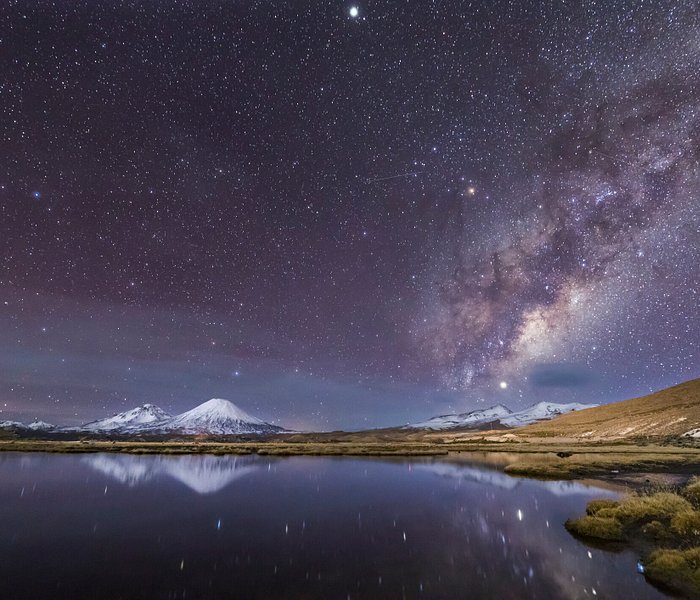

- Why Do You Choose NHTE?
- Who Are We?
- Legal Documents
- Terms and Conditions
- Clients Reviews
- Ghorepani Poon Hill Trek: Poon Hill Trek 3 Days From Pokhara
- Ghorepani Poon Hill with Mardi Himal Trek
- Short Annapurna Base Camp Trek
- Annapurna Base Camp Trek 6 Days
- 7 Days Annapurna Base Camp Trek
- Annapurna Base Camp with Poon Hill Trek 10 Days
- Annapurna Circuit Trek 10 Days
- Annapurna Base Camp Trek
- Annapurna Circuit Trek 12 Days
- Mardi Himal Trek
- Khair Lake and Khopra Ridge Trek
- Mohare Danda Trek
- Jomsom Muktinath Trek
- Annapurna Circuit Trek: Explore the world’s longest Thorong La Pass
- Annapurna Tilicho Lake Trek
- Ghale Gaun Trek
- Nar Phu Valley Trek
- Poon Hill Trek 3 Days
- Langtang Trek
- Langtang Valley Trek
- Short Langtang Trek 5 Days
- Langtang Gosainkunda Trek
- Langtang Tamang Heritage Trek
- Gosainkunda Pass Trek
- Helambu Trek
- Langtang Valley and Ganja La Pass Trek
- Everest View Trek
- Everest Base Camp Trek 9 Days
- Everest Short Trek
- Everest Base Camp Trek 10 Days
- Everest Base Camp Trek 12 Days: Everest Base Camp Short Trek
- Everest Base Camp Trek: Experience Nature’s Majesty at Its Peak
- 14 Days Everest Base Camp Trek
Gokyo Lake Trek
- Gokyo Chola Pass Trek
- Everest Base Camp Trekking
- Everest Three Pass Trek: Three High Passes Trekking in Nepal
- Everest Base Camp Trek Cost
- Ama Lapcha Pass Trek
- Pike Peak Trek
- Everest Base Camp Luxury Trek
- Everest Base Camp Trek Guide Cost
- Manaslu Circuit Trek
- Manaslu Trek
- Manaslu Circuit Trek 10 Days
- Manaslu Tsum Valley Trek
- Lower Dolpo Trekking
- Lower Manaslu Scenic Trek
- Rara Lake Trekking
- Rupina La Pass Trek
- Upper Dolpo Trekking
- Upper Mustang Trek: Discover the Hidden Nature & Culture of Mustang
- Chepang Hill Trek
- Ganga Jamuna Trek
- Kathmandu Valley Tour
- Kathmandu Chitwan Tour
- Kathmandu Chitwan Pokhara Package Tour
- Kathmandu Chitwan Lumbini Via Pokhara Tour
- Bandipur Pokhara Tour
- Bungy Jump in Nepal
- Helicopter Tour In Nepal
- Mountain Flight in Nepal
- Paragliding in Nepal
- Island Peak Climbing: Popular Trekking Peak Climb in Nepal
- Lobuche Peak Climbing:
- Mera Peak Climbing
- Pisang Peak Climbing
- Yala Peak Climbing
- Amadablam Expedition in Nepal
- Chulu West Peak Climbing
- Trekking in Nepal
- Packages Tour in Nepal
- Peak Climbing in Nepal
- Expedition in Nepal
- Rafting in Nepal
- Chitwan Jungle Safari
- Paraglading in Nepal
- Mount Kailash Tour
- Cho Oyu Expedition in Nepal
- Bhutan Tour
- Bhutan Cultural Tour
- Compulsory Equipment List
- Nepal Visa Information
- Currency & Payments
- Travel Insurance

Three High Passes Trek:
- Destination Nepal
- Region Everest Region
- Duration 18
- Transportation Flight/Drive
- Max Height 5545m
- Activity Trekking
- Trip Grade Adventure
- Accomodation Hotel/Lodge
- Group Size Mini. 1 Pax
- Best Season September - December & February to June
- Meals B.L.D.
- Start / End Point Lukla/Lukla
Trip Overview
Test your perseverance in the Everest region of Nepal. Trek the trail to experience the authentic high Himalayan wilderness. The Khumbu region of Nepal has numerous adventure trekking routes where one can relish the splendid harmony of Sherpa villages, the massive glacier, and various landscapes with gigantic mountains. Besides the three high passes trek is an engrossing high adventure journey in Nepal and it has incorporated numerous places. It is always fascinating to sweat in the high mountains crossing the high-altitude mountain passes.
Everest Base Camp with Three High Passes – Renjo La – Chola Pass – Kongma La Pass
It’s purely an adrenaline junkie kind of adventure. Join the Three High Passes Trek and experience the mini mountaineering feel. It’s an ideal and challenging destination to discover the hidden beauties and cultures of Khumbu Valley. Take your spirit to the next level by conquering three arduous yet gorgeous high passes of the Everest region. These high passes are Chola Pass (5420), Renjola Pass (5357 m), and Kongma La Pass (5550 m).
The trail of Three High Passes Trek traverses through authentic Sherpa Villages, mountain passes, and Everest Base Camp. Therefore, one can consider the journey as the Khumbu Circuit Trek. Explore almost every area of the Upper Khumbu region of Nepal. Get ready to visit the Everest Summiteers’ villages. Apart from the chance to leave footprints at the top of the mountain passes, the trip has cultural benefits too. The village-like Thame is on the trekking trail. Almost every house in the village has at least one Everest Summiteer. Therefore, it can become a fantastic opportunity to know the untold stories of the Everest Expeditions and the mountaineering lifestyle of Sherpa.
What makes Three High Passes Trek Adventurous?
To know about the things that make Three High Passes Trek adventurous, you need to know about the landscape where the trail traverses. The landscape is an ultra-Himalayan. Trekkers have to visit five amazing places located at more than five thousand meters from the sea level. The altitude alone can make it harder for people to walk. Moreover, the trail requires trekkers to walk at least 6 – 7 hours daily. On some days, the trip starts very early in the morning.
Altitude, trail conditions, unstable climate, and fatigue are the major factors that make Three High Passes Trek adventurous. Moreover, the Everest region of Nepal is not like a walk in the park. After all, it is an abode of the world’s tallest mountain Mt. Everest along with two other top ten mountains (Mt. Choyou & Mt. Lhotse).
Can I visit Everest Base Camp During the 3 Passes Trek?
Yes, the Everest Base Camp (5364m) is on the trail of a high three-pass trek. If you start trekking in a clockwise direction, you can reach the base camp after crossing Renjo La and Chola Pass. However, if you do the trek in an anti-clockwise direction, you can reach the base camp after crossing one pass i.e. Kongma La Pass. The presence of the Everest Base Camp on the itinerary adds gloss to this high-altitude trekking journey.
Best season to do the Everest Three Passes Trek
Monsoon and winter seasons are the worst time to do the trek. During the winter season, the crossing of mountain passes is not safe. Excessive snowfall may result in the covering of the walking trail. If you can’t see the trail, you might fall into the crevasses or glacier lakes. The monsoon season is also not a recommended time for trekking as the climate is unstable along with the view of mountains is also blocked. The best season to do Everest Three High Passes Trek is during the spring and autumn seasons. In fact, in these two seasons, trekkers can get fantastic weather and visibility.
17 Days Three High Passes Trek Cost and Itinerary
Do you know that the High Passes trek trail covers more than five trekking routes in the Everest region of Nepal? While you do the trek, you will experience the 10 Days Everest Base Camp Trek , Everest View Trek, Gokyo Valley Trek , Gokyo Chola Pass Via EBC Trek , and Everest Panorama Trek. Yes, the route is a detour of an entire Khumbu region of Nepal. Therefore, the cost of Three High Passes Trek is slightly higher that ranging from 1350 $ to 1950 $ per person. The itinerary of the trek is knitted by clubbing together all the itineraries of the above-mentioned treks.
Trekkers cross the Kongma la pass at first to reach the Lobuche. The trekkers leave the Everest Base Camp Trek route from Dingboche and head to the Chhukung area. They will again meet on the EBC Trek route in Lobuche. Again, it follows the EBC itinerary and explores the Everest Base Camp (5364 m) and Kalapathar (5545 m). After crossing the Chola Pass, trekkers reach the Gokyo Valley. On the shores of an amazing Gokyo Lake, the place offers solace in this tiring walking journey up in the Himalayas. Upon crossing the Renjo La Pass, trekkers reach the Everest Summiteers’ village, the Thame. Finally, trekkers rejoin the Everest Base Camp Trek route in Namche Bazaar.
How to avoid altitude sickness during the Everest Three High Passes Trek?
The trek is at an altitude where there is no vegetation above 4000m. Moreover, these places have thin air making it harder for the trekkers to breathe. A simple mistake in trek planning can become fatal. AMS (Acute Mountain Sickness) is the biggest hurdle in this high-altitude trekking. Therefore, you need to know about the things that help to avoid altitude sickness. Choose the best trekking agency for the trek.
It is the most important thing to do before the trek. Having a reliable company as your trek operator helps in tackling the arduous problems that may arise during the trek. Do the acclimatization activities sincerely. Some people tend to skip the acclimatization activities. This kind of thing must be avoided especially during the high-altitude voyage. Take good food and drink plenty of water or soupy foods. Heed the instructions of the trekking guide. Get travel insurance to cover emergencies and unforeseen events.
Why Nepal High Trek is an ideal trekking agency for High Passes Trek in the Everest region?
For a successful trekking trip, you need experienced crew members. Especially in high-altitude places like Chola, Renjola, Kongmala, and Everest Base Camp, navigating through the safe route is a high priority. Some sections of the trail are not trekked by many people. There are hidden crevasses and icy lakes. Moreover, trekkers have to traverse the vertical uphill trails with the support of rope too.
Because of these arduous hurdles, you need an experienced person as a support crew. Nepal High Trek deploys Sherpa guides and porters. These people are the locals and are known the world over as expert mountaineers. At an affordable cost, you can get the Sherpa guide and assurance of safety. So, don’t be late, contact the travel planners and book the Everest Three High Passes Trek now!
Related Picture Gallery

Details Itinerary
Day 01: arrive in kathmandu and transfer to hotel.
Upon reaching Kathmandu International Airport receive by our staff with a warm welcome then a short drive to your hotel in the main areas of Kathmandu city, here joining with other members of the Everest Three High Passes Trek, our guide will brief you with full information about the trek. Also we will check your gear for the trip.
Day 02: Fly to Lukla 2,820m and trek to Phakding village 2,640 m – 04 hrs.
Three High Passes Trek begins with a scenic flight to Lukla and it takes 30 minutes to an air view of the stunning mountain range with Mt. Everest. The plane lands at Lukla named ‘Tenzing-Hillary Airport’ in honor of the legendary climbers’ first summiteers of Mt. Everest.
From Lukla, our first-day walk starts on a winding downhill path with a short climb passing many traditional Sherpa farm villages with views of peaks, after a pleasant walk reaching at Phakding for an overnight stop near the glacier-fed Dudh Kosi (river).
Day 03: Trek to Namche Bazaar 3,440 m – 06 hrs.
After a pleasant overnight stop in Phakding, the morning walk starts following Dudh Kosi, and crossing bridges to reach Sagarmatha National Park at Monjo village. The trail from here walks to the last Jorsalle village before Namche Bazaar and then on crossing a last high bridge climb leads with beautiful views of Everest and other peaks. A quite strenuous walk finally ends at the famous Namche Bazaar for two overnights in this prosperous town. In the Namche Bazaar, you can get more amenities of ATMs, Cybercafes, stores, shops, restaurants, banks, and a fresh bakery with a busy colorful Saturday market.
Day 04: Rest day at Namche Bazaar for acclimatization
Namche an ideal spot for rest and acclimatization, free day with a morning short hike up to the park museum with the necessary information on mountaineering, flora/fauna with Sherpa culture, and Buddhist religions, this scenic spot offers grand views of mountains Mt. Everest, and stunning Amadablam, for interested people hike uphill to Everest View Hotel for best views of Mt. Everest and other mountains.
Day 05: Trek to Thame 3,880m – 04 hours
A good day walks with a pleasant trail through an enchanting forest of rhododendron, oaks, and pines trees, then passing small farm villages following the Bhote Kosi River upstream and to Thamo village with a small hydro project that supplies hydroelectricity to most of the Khumbu area, from this village continue to walk then reaching a small bridge, with beautiful Buddhist Rock Wall Paintings on the rocky wall, from the bridge a short walk to Thame a quiet and sleepy village seldom frequented by trekkers, at Thame with time visit one of the oldest monasteries of the region.
Day 06: Trek to Marlung 4,137 m – 04 hours
Morning with time visit of the monastery and then walk towards our first pass of the adventure, as the route leads to Marlung village above Bhote Kosi River, past the villages of Thyangmoche and Hungmo, and then walking into complete wilderness passing yak grazing land, onwards walk leads to arid terrain of sparse vegetation, finally, our walk reaches our overnight stop at Marlung after Taranga village
Day 07: Trek to Lungden 4,600 m – 04 hours.
The journey continues to Lungden near an old salt trade trail of Khumbu and Tibet, our route diverts from the Tibet border route heading northeast, walking for few hours to our overnight stop at Lungdeng a small village with fantastic views of the surrounding high snow mountains.
Day 08: Trek and cross over Renjo- La 5,465 m to reach Gokyo 4,800 m – 07 hrs.
From Lungden a long tough day to cross over the first high pass of the adventure, the walk follows to frozen ponds beneath Renjo La pass, our walk leads to cross the pass with marvelous views of Mt. Everest, Lhotse, Cholatse, and Taboche, and then crossing Renjo La pass at 5,465 m / 17,929 ft, one of the most difficult section of this adventure, after enjoying the views downhill to Gokyo valley for an overnight stop in the comfort of a nice lodge overlooking Gokyo glacial lake.
Day 09: Rest day at Gokyo Lake
A rest day allows you to acclimatize better, with time to skirt the surrounding area of this valley with stunning views of the first and the second lake of Gokyo valley.
Day 10: Hike to Gokyo Ri at 5,330 m and trek to Thangnag at 4,750 m.
A steep hike uphill early morning to catch striking sunrise over mountains from Gokyo Ri at above 5,357 m, after a climb rewarded with brilliant views of the world’s highest mountains from Mt. Cho Oyo 8,201 m, straddles the border with Tibet along with Gyachung Kang, Mt. Everest 8,848 m, worlds 4th highest Mt. Lhotse 8,516 m, Cholatse, Taweche and towards east worlds 05th highest Mt. Makalu at 8,463 m. After a great time on top of Gokyo Ri, downhill to Gokyo and then continue a few hours walk to Thangnag along the glacier and moraines to reach a small settlement of Thangnag for an overnight stop.
Day 11: Cross Cho-la (Tshso-la) 5,367m to Dzongla 4,850 m – 07 hrs
Today, is another Big Day! Crossing the high Cho-la pass ( Tsho-la) with an early breakfast walk leads to a step up and then crossing the glacier of the eastern side. The top of Cho-la at 5,367m and sometimes it can be challenging to cross in snow conditions; the top offers excellent views of high mountains and of Cholatse Glacier, from here descend carefully to a small lake on the way to Dzongla for an overnight stop after a tough morning and day walk.
Day 12: Trek to Lobuche 4,930 m – 05 hrs.
Today’s walk leads to Lobuche following a path that descends to yak herder’s summer pastures. Then the walk climbs up to the terminal debris of Khumbu Glacier and continues on the pleasant gradual path all the way to Lobuche for an overnight stay, Lobuche a small hidden settlement with about ten or more nice lodges.
Day 13: Trek to Gorakshep 5,170 m, Everest Base Camp 5, 364 m – 06 hrs.
The morning walk leads on a gradual trail with a few short steps up gaining high altitude with superb views of Mt. Pumori, Lingerie, Khumbutse, and Mt. Everest. After a few hours of scenic trekking reaching at Gorakshep after walking past the moraine and glaciers, Gorakshep with few nice lodges for an overnight stop, this isolated spot is located beneath Kalapathar Hill and Pumori peak on route Everest base camp.
Everest Base Camp is located beneath massive Khumbu Ice Falls and glaciers, this super spot with immense views can be crowded during peak expedition season around April and May months, here enjoy surrounding views with Mt. Everest hidden behind the high peaks of Lho-la and Nuptse and walk back to Gorakshep for an overnight stop.
Day 14: Hike to Kalapathar 5,545 m trek to Lobuche – 04 hrs
Morning climb to Kalapathar for a fantastic view of Mt. Everest and other adjoining peaks, Kalapathar at 5,545 m offers the entire south face of Mt. Everest at the closest, after an exciting moment heading back to Gorakshep and continue the journey all the way to Lobuche for lunch and overnight stop, afternoon at leisure rest and preparation for the last high pass of the adventure.
Day 15: Cross Kongma La 5,535 m to Dingboche 4, 330m – 08 hrs
Today is our last tough and Big Day! crossing the last pass over Kongma La, starting early before dawn, the morning walk leads towards Khumbu glacier and moraine, walk with care on the misleading icy glacial path, from here onwards our route leads on a rocky trail beneath Kongma-la and the peak of Kongma or Mehra, after a short good rest traverse the Kongma-La pass at 5,535 m / 18,159 ft enclosed between the great Nuptse wall, Mehara and Pokalde peaks, after a long descend walk leads on a pleasant trail to join at Imjatse wide valley with incredible views of Island peak, Amadablam, and other high peaks. On reaching at Bibre at Imjatse valley a few hours of nice walk brings you at Dingboche village with many fine lodges, after a hard day walk retires in one of the nice and cozy lodges for overnight at Dingboche.
Day 16: Trek to Tengboche 3,867 m – 05 hrs
Leaving Dingboche with super morning views of Amadablam, and then on a downhill walk with a short climb then losing altitude heading past Pangboche and from the bridge back into tree lines with an hour climb to Tengboche Monastery, a beautiful and scenic spot surrounded with mountain views including Everest and majestic Amadablam, time here to visit Tengboche interesting monastery.
Day 17: Trek to Monjo 2,880 m through Namche Bazaar – 06hrs
The morning walk leads to a long descent reaching at Imjatse River in Phunge Tenga, after crossing a bridge with a short steep uphill and then on a gradual winding trail to Namche Bazaar, after a short break at Namche, continue to walk on the downhill to Dudh Kosi River valley, and then with short ups and downs to reach at the entrance and exit gate of Sagarmatha National Park, a short walk from brings you at Monjo village for an overnight stop.
Day 18: Trek back to Lukla for the last overnight in Khumbu area – 04 hrs walk.
After a marvelous and enjoyable time on high Khumbu valley and ridges with super Everest Three Passes trek, our last day walks of this adventure leads you back to Lukla, reaching by Lunch and for last overnight stop, after lunch free and celebrate dinner with fellow members, staff and guides.

Day 19: Fly back to Kathmandu and transfer to hotel.
Waking early morning to catch the flight back to Kathmandu, transfer to Lukla airport terminal and then board in a small aircraft either twin otter or Dornier, for a super scenic flight to reach at Kathmandu, on arrival in Kathmandu airport, transfer to your respective hotels with rest of day free for individual activities and souvenirs shopping.
Day 20: In Kathmandu free and reserved day for individual activities
It an important and necessary to have one extra day in Kathmandu in case of flight delay and cancellation, due to bad unfavorable weather which can happen sometimes as Himalayan weather is unpredictable. If all goes well as per our itinerary days, one can join in our delightful and interesting tour of Kathmandu-Patan and Bhaktapur, all these places full of world heritage sites of historical-culture and religious importance.
Day 21: International departure for homeward bound
Your last day in Nepal, an amazing country of Himalayan wonders, as per your flight time leaving your hotel where our staff transfers you to an airport, after a great memorable adventure with an enjoyable time on Everest Three Passes Trek.
Cost Includes:
- Airport Pick up drop
- Two-night Hotel in Kathmandu with Breakfast
- Meals During Trek: (14 Breakfasts, 15 Lunch, and 14 dinners) during the trekking.
- Sagarmatha National Park Permit (Rs, 3000 per person)
- Pasang Lhambu Rural Manicipility entrance fee (Rs,2000 per person)
- Including Domestic airport pick-up and drop service.
- Both-way domestic flight ticket (Kathmandu to Lukla / Kathmandu)
- Government license holder mountain guide.
- 14 nights of tea house accommodation throughout the trek.
- Fresh fruit during the trek
- Trekking gear Down jacket, sleeping bag, duffle bag, and trekking pole.
- Adventure Certificate: NHT provides an Adventure Certificate.
- The arrangement of Emergency Helicopter service will be paid for by your Travel insurance company.
- Medical kit bag.
- Farewell dinner.
Cost Excludes:
- Nepal entry visa fee (you may easily issue the visa upon your arrival at Tribhuwan International Airport – Katmandu).
- Your Travel and rescue insurance.
- Personal porter.
- All the Food in Kathmandu except the breakfast & farewell dinner.
- All the expenses in the mountain over than scheduled itinerary (due to strike, delay, or canceled flight)
- Extra night Hotel in Kathmandu if arrive early or late departure than scheduled Itinerary.
- All the Bar bills and personal expenses (phone call, laundry service, battery recharge, a bottle of water, hot water, shower.
- Tips for the guide and porter.
Three High Passes Trek Route Map

Frequently Asked Questions
What is the difficulty of three high passes trek.
Definitely, the Everest Three High Pass Trek is a high adventure pass trek in the Everest region. This trek has included Kongma La Pass (5540 m), Chola Pass (5420 m and Renjo La Pass (5360 m). The trek requires a physical fitness level and quality gear too.
How many days are required to complete the Three High Pass Trek?
Usually, The Everest Three Pass Trek can be done 15 to 19 days from Kathmandu. However, if you’re fit and strong you can complete it within 15 days from Kathmandu. This trek combines the most popular places like Everest Base Camp, Kalapathar, Kongma la pass, Chola pass, Gokyo lakes, Gokyo ri viewpoint, cho oyu base camp, and Renjo la pass with a brilliant sherpa culture.
When is the best time to do the Everest 3 Pass Trek?
Nepal High Trek & Expedition highly recommends the spring and autumn seasons. Both seasons are the best and most favorable times to trek around the Himalayas of Nepal. The spring begins from March to May and the autumn season starts from September to December. The spring season would be warmer than the autumn season.
Which pass is more difficult to cross?
Three passes are more difficult and tough to cross the pass but the Kongma La pass is tough than the other two passes. Because nearly Kongma La passes a rocky trail that is difficult to decent.
How to complete the Three High Pass Trek without Altitude Mountain Sickness?
Before starting the trek you should be prepared in mentally and physically. This trek is a high altitude with adventure throughout the trek everybody has suffered from altitude sickness. However, you must eat very well, drink enough liquid and use Diamox during the trek, Moreover, you should avoid alcohol as well.
Can I complete Everest Three Pass Trek throughout the year?
Nepal High Trek & Expedition has been successfully leading the three high passes trek throughout the year but sometime in winter, the trail will be blocked by heavy snowfall. We highly recommend hiring a professional guide for the trek.
Do I need travel insurance to trek in the Everest Region?
Travel insurance is mandatory for the Three High Pass Trek. Your travel insurance should be covered your emergency helicopter and medical evacuation expenses as well.
What types of gear are required for this trek?
You have required quality gear such as a sleeping bag, down jacket, trekking boot, and other goods as well. Please visit our website and check out the compulsory equipment list. https://www.nepalhightrek.com/compulsory-equipment-list/
What is the maximum luggage weight for the porter and flight to Lukla?
The weight limit on flights to Lukla and available is 10 kg per person. If you want to bring extra goods you can pay an extra charge as well. A porter carries a maximum of 25 kg of two clients and Nepal High Trek provides you with one porter for every two people.
What documents do I need to bring to Three High Passes Trek?
You should bring some crucial documents such as your validated passport, Pasang Lhahmu Rural municipality entrance fee, and Sagarmatha National park permit.
What is the weather condition in the Everest Region?
However, the weather will be clear in the spring and autumn season. Around the mountain, the weather will change very quickly and sometimes very difficult to correctly predict.
Can I fly the drone around Khumbu valley?
Regarding the drone flying around the Khumbu valley, without an approved permit, you can’t fly the drone and it’s very hassle to get a drone permit. We suggest to you don’t bring a drone during the Everest Region Treks.
What types of accommodations are available during the trek?
The Everest region treks are completely based on the tea house. So each room has twins sharing beds. The accommodation is very good than Annapurna and Langtang regions
Where I can get a meal during the Everest 3 High Passes Trek?
Along the trail, there are no separate restaurants but there are some tea houses. You can get meals from the local Guest house. They have varieties items meals that you can order the meal to accordingly the menu card.
Do I need to bring medicines for trekking to Everest Treks?
We highly recommend to you bring your regular medicines and furthermore, Nepal High Trek will carry bring small first aid kit box as well.
Is there an airport pick-up service included in the package?
Yes, all ground transportation is included in the package.
How long do I need to walk per day during the Three Pass Trek?
Usually, you must walk 5 to 8 hours per day and some walks would be strenuous during the crossing of the pass.
Is Wi-Fi available during the trek?
Yes, paying Wifi service is available during the trek. The Everest link is more
How much should I give tip for the guide and porter?
The tipping is not fixed and it depends on the trekking difficulty and duration. The trekking crews highly appreciate the tipping. Even though you can give as you wish and you relish theier hard work on the high altitude.
Cost & Date
Client reviews.

Claudine Imhof
Switzerland, everest three high passes trek.
Last November I did the ‘Three High Passes Trek’ with Nepal High Trek. From the very beginning, I felt I was in good hands with this trekking agency. Anjan, the manager, answered all of my questions immediately (I was very short-term with my request for the trekking) and he organized everything very quickly and professionally. Anjan and our guide Pawan welcomed me and the other person of the group on the day before the trekking and helped us with everything that was left to organize and pack. They gave us very good advice of what to bring with us and informed very well about the whole trek and what to expect in terms of teahouses, weather conditions, temperature, and conditions of the path.
Pawan was definitely the best guide I could have imagined for this trekking in Nepal! He is doing his work with so much passion, and he has a lot of experience as a trekking guide and knows the region very well! You can always feel safe with him in the mountains. He was very professional, especially when I got sick, he took very good care of me and always measured my oxygen level, provided me with medicaments, and cared about my health condition. Even when I felt really bad, he was always motivating me. And on top, he is so nice and friendly, we had a lot of fun with him! We were singing and dancing and joking… he is not only a fantastic guide but also a very good companion! Because I was so happy with him as our guide, I booked him for another trek in the Langtang region right afterward. On that trek Pawan and I had no porter joining us, so he was even carrying my sleeping bag! On the first trek, we had Mahindra as our porter, and he did his job very well! He was also very nice and joined us on several day hikes.
These two trekkings in Nepal were a wonderful experience and I will definitely book again with Nepal High Trek and above all with Pawan as my guide!

Jim Enright
Three high passes trek.
Nepal High Trek rocks.
Kirk and I are two Babyboomer’s, 59 and 69, at the time we trekked Three High Passes and Everest Base Camp.
Nepal High Treks is a local family based business With strong ties to the mountains and Sherpa community.
We met 3 Sherpa’s, two of which summited Mount Everest 10 times. Certificates on the walls. Very neat!
We chose Nepal High Treks because we did not want to trek with a major company and 15+ other people.
We liked the idea of One on one attention and local knowledge that our guide Pawan (brother in Law) gave us during our trip.
Hiking with a large group of diverse age groups sounds Keen in theory. But, a 30 year olds trekking pace vs 50 or 60 year old is quite different, and you could feel pressure to push Yourself harder than necessary to keep up.
Pawan was very aware of the pace we needed to go In order to complete the trek. “Slow and Slower” were his Favorite chants as we were on the ascent.
Of special importance, as we were descending from Dingboche, my Acute Mountain Sickness hit a point where I needed to descend rapidly.
Anjan coordinated the helicopter. Was in the hospital for three days. During this time Pawan Was there until my discharge. Very helpful and Reassuring. If there were questions or concerns, Nothing was lost in translation.
I recommend Anjan and Pawan, Nepal High Trek, highly. We had a wonderful and informative trip.
Jim Enright North Carolina USA
Kirk Obeatan
I have been so very impressed with this tour company. From the initial contact and development of an itinerary to our pickup at the airport, an amazing welcoming dinner, a personal guided sightseeing tour of the area, a wonderful selection of the hotel and probably most importantly the diligent work done getting our flight to Lukla at a challenging time when the weather was not cooperating. What a great company!! Thank you for all you have done this far to make this a trip of a lifetime!!
Canberra Australia
We have done two fabulous treks with Anjan as our guide: The Annapurna Circuit and the Gokyo Three Passes Trek. On both treks Anjan took great care in planning each day’s stage, preparing us for the day’s terrain, checking on our health and wellbeing, as well as making sure each night’s accommodation was of a good standard.
Anjan has great knowledge and experience of many of the big treks in Nepal, and has completed years of training to deliver an excellent and safe experience to those wanting to travel in a smaller group. He listened to what we would like to achieve, and designed a route that met our expectations and abilities. We allowed several spare rest days in case one of us fell ill, and Anjan was able to adjust the itinerary accordingly when we had to call on the odd day to rest up or recover. that, I believe is THE benefit of going with your own personal guide such as Anjan, and not being beholden to a fast paced and immovable itinerary of other more established and larger trekking companies.
Our Goykyo 3-passes trek was indeed the hardest thing we have tackled. Our good friends Mark and Andrea and ourselves, all reasonably fit Aussies in our 50s, could not speak higher of Anjan’s calm and reassuring manner as we crested those massive passes, felt at times we had nothing left in the tank to go on, or collapsed exhausted but always exhilarated at the end of each day. The porters Anjan works with were lovely guys, who never complained and always had a cheery smile, a joke and were wicked at cards in the evening.
Pre-arrival communications were excellent, and Anjan was able to flexibly work around unfavourable weather issues when it cam to arranging flights to Lukla and return.
But the best thing about trekking with this company is this: You know that your money is going STRAIGHT back to Anjan, his family, his wider family and village, his porters, and the local lodges you stay in. Since the Nepal earthquake, small operators, like Anjan have suffered greatly from lack of trekking bookings. This has had a direct hit on his own small family, and his wider family in the Ghorka District that was devastated by the quake.
We would highly recommend Anjan/ Nepal High Trek & Expedition for any of your bucket list dreams of trekking in Nepal.
Mark Clinton
I traveled with another guy to Nepal in March – April 2022 and used Nepal High Trek team for all logistics and they handled everything with great care. Our trek was to be of the 3 High Passes. My hiking partner had some difficulty at altitude however the team worked diligently to get a helicopter in and transport him to a hospital. While many try to get by with the least expensive guide team they can it’s important to know that when the “stuff hits the fan” the guides can handle the issue. I was able to complete all 3 passes and EBC as well as some excellent “side trips” during acclimatization days. I am giving thought to going back for 2 months and if I go I’ll for sure use Nepal High Trek team again. No issues, no worries!!
Similar Trips

Everest Three Pass Trek
Three High Passes Trek is an adventure and ideal trekking route in the Khumbu region. Challenge your endurance and perseverance against the lofty high altitude Himalayan passes of the Everest region.

Everest Base Camp Trek
Everest Base Camp Trek in Nepal is the loftiest adventure walking destination on the globe. The Everest Base Camp T rail is one of the jewels of Nepal trekking and probably it’s one of the excessively preferred journeys too.

Up in the mountains, there is a gorgeous blue-turquoise glacial lake. With an image of gigantic mountains on the lake water, the scenery looks purely fictitious and mythic.

Everest Base Camp Short Trek 10 Days
Everest Base Camp Trek 10 Days is an adventure destination to discover all the best highlights of the scenic Khumbu Region. A perfect choice for visitors with a limited holiday duration, but with a keen interest in a trek to the base of Mt. Everest .

Our Partners

Sign Up for Our Free Newsletter
Make an inquery.
Trip Name : Your Name : Your Email : Telephone No : Your Message :

Details of Everest Three Passes Trek Map And Itinerary
- Last Updated on Dec 2, 2023
We at Mountain Rock Treks provide you with the best and most interactive maps and itineraries for the Everest Three Passes trek of the Everest region. Our Updated Everest three passes trek map and itinerary provides all the trekkable routes in the Khumbu region.
Our Everest three passes trek map offers all the new updated routes. Likewise, we have uploaded the map in its original and high quality, where the trekkers can experience an exact print copy of the Everest three passes geographic map online. Our map beautifully demonstrates the various trails and landmarks. Also, there is a feature of zooming in and out to discover the places and highlights you have been searching for in the Everest Three Passes trek.
Therefore learn more about the Everest Three Passes Trek Map and Itinerary.
Table of Contents

Everest Three Pass Trek | Booking Cost for 2024-2025
Understanding everest three passes trek map.
Talking about the Everest Three Passes trek is one of the most recognized treks close to the world, tales mountain- Everest. Many trekkers venture to the Everest region after a short flight from Kathmandu to Lukla to make a circuit trek successful. If you are considering completing the Everest three passes trek, remember to carry your Everest three passes trek map and itinerary with you provided by Mountain Rock Treks.
It is a modern ear, and technological gadgets are a must to make your trek in any place more hassle-free. Similarly, these technological gadgets are helpful, as you can learn and plan the route you will be taking in advance, allowing you to complete your trek more easily and quickly. However, one example of such technical gadgets is Handheld GPS, which has taken over the market recently.
However, the electronic device can fail, so to prevent you from being stuck, you can always carry a paper Everest three passes trek map and a compass or backup from Mountain Rock Treks. In fact, we, too, provide our guests with one full piece of ma before trekking to Everest three passes trek.
Everest is the tallest peak in the world, with its peak rising above 8,848.86 m (29,031 ft). and trekking to its base camp or around means trekking to the famous area, which is visited by almost thousands of travelers every year.
The trek through Everet's three passes gives you breathtaking views of the famous peaks rising above 8000m, 7000m, and 6000 m. Likewise, it also means trekking through the multiple Sherpa villages in g with the multiple landscapes and diversity of flora and fauna of Sagarmatha National Park. In simple words, Everest three passes is a trek to the area of Mt. Everest. Using our trek to Everest does not rise in its glory alone. There will be several peaks like Makalu (8,516m), Lhotse (8,516m), and Ama Dablam (6,812m) to accompany you as you second higher with the help of our Everest three passes trek map itinerary.
The trail of this trek is somewhat tricky as you need to pass through three high passes of the Everest region: Cho La Pass, Renjo la Pass, and Kongma La Pass. So if you are just a beginner in trekking, do some serious physical endurance training and more.
In addition, there are many routes for Everet's three passes to choose from. With this in mind, you can not opt to take on a regular Everest three passes trek and pick different starting points and ending points for this trekking. Therefore Mountain Rock Treks Everest's three passes trekking route and itinerary help you to decide about the track, which is very consuming and equally adventurous, so you do feel guilty about not taking the conventional route of Everest three passes trek.
With the help of this map, you can learn about the distance, altitude, places, etc., which is an essential piece of information. Following this map, many people have finished their trek quickly.
Our Everest three passes trek map and itinerary are carefully planned for trekkers. It provides information about altitude, distance, and various places (famous and remote). Everest’s three maps and itinerary have guided trekkers around the Everest region.
Everest Three Passes Trek Summary
Everest Three passes trek which officially takes place in the Everest region and contains some of the major attractions to visit, like Renjola Pass, Gokyo Lake, Khong Ma la Pass, Chola Pass, Everest Base Camp, Kala Patthar, and More. Therefore with our three passes trek maps and itinerary, you will take the same route as the standard Everest base camp trek but with many bonuses.
Everest three-pass trek map guides you to the remote and off-the-beaten path, which only 5-10% of the 60,000 EBC trekkers have followed.
The Everest Three Passes trek's standard starting point is the same as the Everest base camp trek , which you can see below on the map. Trekkers will first take a 35-45 minute flight to Lukla referred, the most dangerous airport in the world. The treks now start after you land in Lukla. Lukla airport is colored a most dangerous one probably because of its weather, altitude, size, and location.
Trekkers can choose from many route options as the trek lies within the Everest region's off-beaten paths. But trekkers should be considerate and choose the trails to reduce the risks of high altitude sickness gradually. If you choose the clockwise route from the Namche Bazaar to Thame, you will reach your first high pass in two or three days. This route has both advantages and disadvantages. The disadvantage because this could be risky as the highest pass is located above the 5000m elevation here, and the advantage is it's the perfect route if you want to avoid overcrowding.
If you go with the Everest Three Passes Trek clockwise, the route will include at least one acclimatization day in Mirlung. This will increase your trek success ratio without causing any sickness issues.
Clockwise Everest three passes trek is a fast way to complete the trek, but we at Mountain Rock Trek offer you the counter-clockwise route, which is far better than the clockwise route. This being said, you will follow the Everest three-passes trek map that takes you along the EBC trail up to Dingboche . You take another route from Dingboche to your first high pass, called Kong Ma La Pass, at 18,209 ft / 5,550 m. This route map is better for proper acclimatization before hiking through high passes. The only disadvantage is that trekkers may have to deal with overcrowding for the first few weeks.
Everest Three Passes Trek Map Explanation
Our Everest three passes trek map is an updated and high-quality map that will accurately describe the Everest three-pass trekking route in the Everest region. Trekkers have many options, from the starting point to the ending point.
For example, instead of taking a direct flight to Lukla from Kathmandu, you can travel by land from Phaplu or Jiri and then to Lukla for a more gradual ascend. Many options like this may confuse you, so we provide You with Mountain Rock Treks' detailed Map below, which will help you choose the best route, clockwise or anti-clockwise, for Everest three passes trek.
What is included in the Everest Three Passes Trek map?
Our Everest three-pass trek map shown above is the exact digital copy of the print version. With the coordination of the experiment, map developer Mountain Rock Treks has brought this Map online to provide its trekkers with the best experience during their Everest hike.
Our Everest three passes trek map is well-designed and presents both the physical features and terrains of the Everest region and the three passes. Our Map also shows the highest and lowest elevations, along with the. Moreover, you can also see many colorful symbols representing mountains, trails, driving trails, waterfalls, glaciers, roads, etc.
Our Everest three passes trek map includes:
- A comprehensive list of local villages is in blue, along with their respective elevations.
- The simple symbol represents the detailed mapping of all flights you will take.
- Identification of panoramic viewpoints along hiking trails, marked in numbers ensured in yellow circles.
- Collection of mountain names in the Everest region, along with their elevations, denoted by the mountain's symbol.
- Identification of temples.
- Provision of a map indicating alternative side trips apart from the classical route represented by a blue dotted line.
- A red flag represents the list of all high passes within the Everest region.
- Our map also shows the avalanche area denoted by the white mountain encircled in the blue circle.
Note: This representation of the Everest Three Passes trek Map allows you to zoom in and out for convenience. Just right-click on our map to enlarge it.
Everest Three Passes Trek Outline Itinerary
Day 1: arriving in kathmandu.
- Kathmandu Elevation- (1,400m / 4,593ft)
- Airport to Thamel Driving Time- 20/30 minutes
- Accommodation- Hotels
Day 2: Fly Kathmandu-Lukla and Trek-Phakding
- Lukla Elevation-(2,850m / 9,350ft)
- Phakding Elevation- (2650m / 8562ft)
- Flight Hours- 40 Minutes
- Trek Distance- 6.2km / 3.8miles
- Trekking Hours- hours
- Accommodation- Tea Houses
Day 3: Trek Phakding-Monjo and Namche Bazaar
- Monjo Elevation- (2,835 m/9,301 ft)
- Namche Bazaar- (3,440m / 11,285ft)
- Trek Distance- 7.4km / 4.6miles
- Trek Hours- 6 hrs
Day 4:Acclimatization Day
Day 5: Trek Namche Bazaar - Tengboche
- Tengboche Elevation- 3,870m/12,697ft
- Trek Hours- 5/6 hrs
Day 6: Trek Tengboche-Dingboche
- Dingboche Elevation- 4,360m/14,305ft
Day 7: Trek Dingboche- Chukung
- Chukung Elevation- 4,730 m/15,518 ft
- Trek Hours- 4 hrs
Day 8: Trek Chhukung to Kongmo la pass - Lobuche
- Kongmo la pass Elevation- 5,550 m/ 8,209 ft
- Lobuche Elevation- 4,940 m (16,210 ft)
- Trek Hours- 7-8 hrs
Day 9: Trek Lobuche - Gorakhshep
- Gorakhshep Elevation- (5,164 m/16,942 ft)
Day 10: Trek Gorekhshep-Kalapathar-Dzongla
- Kalapathar Elevation- (5,644.5 m/18,519 ft)
- Dzongla Elevation- (15,846 ft / 4,830 m)
Day 11: Trek Zongla-Chola pass and to Thagnak
- Cho la pass Elevation- (5,420m/ 17,782 ft)
- Thagnak Elevation-4700 m/ 15419 ft
- Trek Hours- 3/5 hrs
Day 12: Trek Thagnak to Gokyo
- Gokyo Elevation- (4,750 m/ 15,583 ft)
Day 13: Rest day
Day 14: trek gokyo to renjo la pass- marlung.
- Renjo la pass Elevation- (5,360 m / 17,560 ft)
- Marlung Elevation- (4,210m/ 13812 ft)
- Trek Hours- 8/9 hrs
- Trekking Distance- 9.5 km / 5.6 mi
Day 15: Trek Marlung to Thame-Namche Bazaar
- Namche Bazaar Elevation- (3,440 m / 11,286 ft)
- Thame Elevation- (3820 m/12,533 ft)
- Trek Hours- 7/8 hrs
Day 16: Namche-Phakding-Lukla
- Trekking Distance- 17.6 km / 10.7 mi
Day 17: Fly Back to Kathmandu
Day 18: final, departure or onward for the next program, details itinerary of everest three passes trek.
Today, we will pick you up from Tribhuvan International Airport and transport you to your hotel in Thamel, a bustling and lively district of Kathmandu. The journey from the airport to the hotel takes approximately twenty minutes or thirty.
Once you are all settled in and want to explore Kathmandu and Thamel, we can help you. The central lanes of Thamel are exclusively designated for pedestrians, creating a perfect environment for leisurely exploration, especially at night.
Day 2: Fly Kathmandu-Lukla and Trek-Phakding
Your official journey begins today with a short flight to Lukla, about 35-45 minutes. After landing at Lukla, we trek toward the Phakding past Chaurikharka village.
Today will be a short trek, which also helps in acclimatization. Overnight will be at one of the teahouses in the Phakding. During your leisure time here, feel free to venture out and discover the attractions in and around Phakding. Phakding lies in the lower elevation; you still enjoy the facilities like shops, hotels, swimming pools, and restaurants. Moreover, there are also famous local monasteries around here. Among them, the one not to miss is the monastery named Rimishung Monastery.
Today's trek will be harder than yesterday's and will take us up the Dudh Kosi Valley. Along the way, we will encounter the enchanting Toktok Waterfall near the park's entrance, providing an ideal spot for a brief rest.
As we trek, one of the most exciting aspects of today's journey will be many bridges that span the river, creating a fascinating crisscross pattern. Also, these suspension bridges are adorned with vibrant prayer flags and often tower high above the rushing waters. The Edmund Hillary Suspension Bridge is the main highlight, towering 125 meters (410 feet) above the river and stretching 140 meters (459 feet). We will reach Namche Bazaar shortly after crossing the bridge and stay the night there.
Day 4: Acclimatization Day
Today just enjoy your rest day at Namche Bazaar. Acclimatization at Namche Bazaar allows your body to acclimate to the increased altitude. However, there are numerous activities you can opt for, such as exploring the Sherpa Museum or the nearby monastery. Additionally, you can go on a short day hike to the Everest View Hotel, where you can relish a refreshing beverage and indulge in a delightful snack. Or you can watch Everest and enjoy the day at Namche Bazar.
After a whole day at Namche Bazaar, you will trek towards Tengboche (a village near Pheriche Valley). We will gradually reach the northeast following a smooth and level contour path. Eventually, the trail today will lead us down to the valley floor before ascending to Tengboche.
As we reach the Tengboche mountain peak, rising above the clouds like Tawache, Everest, Nuptse, Lhotse, Ama Dablam, and Thamserku will greet us. We will also visit Tengboche monastery, the largest one in the Khumbu region. This monastery is surely worth visiting due to its 20-foot Buddha sculpture. Likewise, you also get to learn about detailed wall hangings, Buddhist culture, and more. We will stay the night at Tengboche.
Leaving Tengboche, we will ascend to the Imja Khola valley passing through the woods and views of peaks rising above 700m and 8000m in front of us. After trekking for around three kilometers from Tengboche, we will pass by Pangboche (3,985 m), the highest year-round settlement.
Just before reaching Dingboche, there is a separation in the road. Those following the traditional EBC trek continue on the left path, leading to the village of Pheriche. However, we take the right path and cross a bridge, followed by a challenging ascent to Dingboche. We will spend the night in one of the tea houses. The surrounding Dingboche is beautiful, with mountain peaks like Kangtega, Cho Oyu, Ama Dablam, and Taboche.
Today, we will take on a less challenging journey, following a gentle slope along the Imja Khola valley floor towards the village of Chhukung (or Chukhung). This section of Sagarmatha National Park is notably peaceful, resulting in a less crowded trail than the route leading up to Tengboche.
Along the way, we will pass by fields enclosed by stone walls and eventually venture into the moraine area before reaching Chhukung.
Chhukung, originally established as a village of teahouses (lodges), serves as a convenient stopover for trekkers en route to Kongma La and climbers aiming to reach the peak of the Island Peak.
Day 8: Trek Chhukung to Kongma la pass - Lobuche
Today we will hike through our first high passes called Kongma La. Also, it surpasses the elevation of Everest Base Camp. Kongma La pass lies more easternmost and is the highest among the three passes and Everest base camp.
Considering these challenges , today calls for unwavering focus, crampons, and trekking poles, as a significant portion of the route is rugged and uneven. However, there are also stretches of the trail that are remarkably smooth during the ascent.
Upon reaching the summit, a feast for the eyes unfolds with awe-inspiring vistas for trekkers to the east and west. These panoramas make the difficult climb entirely worthwhile. Thus, proceeding slowly and at one's own pace is crucial. There is no need to rush.
As we are ned of the high pass, e ill pass the Khumbu Glacier, the same glacier that flanks Everest. Also, it is the largest glacier in Nepal. After crossing the Khumbu Glacier, we will reach Lobuche, where we will also spend the night.
Day 9: Trek Lobuche - Gorak Shep
Gorakshep lies ahead, trail winds through Khumbu Glacier's lateral moraine. Passing the pyramid signpost, we glimpse Everest's north ridge, Pumori, Mahalangur, Lingtern, Khumbutse, and Nuptse. Likewise, ThangmaRiju unveils a 360-degree vista of snow-clad peaks.
A top Changri glacier, Kala Patthar, reveals beneath Pumori's green knoll. Gorakshep offers a view of snow-capped mountains, including Everest. The trail leads to Everest base camp via Gorakshep Lake, Indian army memorials. At base camp, we will witness treacherous Khumbu icefall, Nuptse, and Khumbutse dominating colorful mountaineers' tents.
Kala Patthar tops everyone's list as it provides a breathtaking view of Everest. Today, we will head north for the climb. It's not too difficult, but the altitude makes it tiring for us to move.
After capturing Everest's beauty and other peaks, like Lhotse and Makalu, from Kala Patthar, we return south via the traditional Everest Base Camp trail. Passing through Lobuche, we will divert west near the Imja Khola River, heading to Dzongla village. The path to Dzongla is clear, offering incredible mountain vistas. Peaks like Arakam Tse, Cholatse, Taboche, and Chola Tsho Lake greet us.
Today we will go for our second high pass, Cho La, at 5,420 m / 17,782 ft and 5,420 m / 17,782 ft. Crossing Cho La Glacier during the ascent makes this pass quite challenging. But, reaching the summit grants us breathtaking panoramas in both the eastern and western directions, where many peaks surround us. On the way down, the descent proves to be even steeper than the ascent, so we need to be more careful during this section.
Once we successfully conquer the pass, our trek takes us through the picturesque village of Thangnak, which is nestled close to the base of the pass. This remote and stunning portion of Sagarmatha National Park remains hidden from the view of many.
Our third high pass is still uncrossed, so we will leave Thangnak early in the morning and hike toward Gokyo. Gokyo is a small village that proudly resides in the majestic presence of Mt Cho Oyu (8,150 m / 26,739 ft), famed as the sixth-highest mountain.
Ngozumpa Glacier is located directly above the village, and it stretches out, showcasing its magnificence as the longest glacier in the entire Himalayan range, spanning an impressive distance of 36 km (22 mi). Adding to its allure, Gokyo finds itself graced by one of the most remarkable features in the world—the Gokyo Lakes.
This pristine freshwater lake system sits at the highest altitude globally. These lakes hold deep significance for Buddhists and Hindus, with approximately 500 Hindus embarking on an annual pilgrimage to immerse themselves in their sacred waters every August.
Today holds a momentous occasion as we hike on a thrilling expedition to conquer the summit of Gokyo Ri (Peak), granting us extraordinary panoramic vistas. Our journey encompasses a relatively straight path leading us to the peak and back to Gokyo overnight.
From the pinnacle of Gokyo Ri, our eyes feast upon the majestic spectacle of Gokyo IV (or Tonak Pokhari), the largest among the Gokyo Lakes, sprawling beneath us in the north. Towards the southwest, the mesmerizing sight of Renjo La captivates our gaze, anticipating our forthcoming traverse. Extending beyond, to the north and east, an unending procession of illustrious peaks unveils itself, including four towering giants that surpass the formidable 8,000-metre mark: Everest, Lhotse, Makalu, and Cho Oyu!
Today, we will pass on the third and final leg of our trekking route, Renjo La (5,360 m), a pass lower than the previous two we conquered. Interestingly, you might encounter local people with their yaks along the way as they populate this path. Renjo La is relatively quiet compared to other passes, with only some trekkers passing through.
We begin our journey by leaving Gokyo behind and heading west, walking alongside the lake's northern edge. And as we gradually ascend the pass, the view behind us unfolds, revealing the breathtaking beauty of Gokyo and Ngozumpa Glacier. The higher we climb, the more magnificent the panorama becomes. The terrain leading up to Renjo La is rugged and uneven, making it a perfect day for using trekking poles.
Our overnight stop is Marulung, one of the few settlements in Sagarmatha's less densely populated area.
Today we trek from Marlung to Namche Bazaar. For this, we started our journey early and walked alongside the Bhote Kosi River. The valley initially presents a steep terrain but gradually widens as we continue t trek. Unlike some other regions, this serene valley remains relatively untouched by the effects of tourism, so we see very few travelers here.
Our journey takes us through the picturesque village of Thame, once inhabited by renowned Sherpa mountaineers such as Tenzing Norgay and Apa Sherpa. Visiting Thame Monastery, situated above the village, is highly recommended if time permits.
We will return to Namche Bazar from the very different path we took the previous time. This path will reward us with breathtaking scenery as we traverse along the contour of the northern bank of the Bhote Khosi, a tributary of the Dudh Khosi. Those fortunate enough to be in Namche on a Saturday can explore its vibrant market.
We again retrace our steps back to Lukla from the Namche bazaar.
We took a two-day journey from Lukla to Namche Bazaar during our ascend expedition, with a brief overnight stay in Phakding. However, on our way back, we will cover the same distance in a single day, allowing our bodies to relax and hike simultaneously. We will stay overnight at Lukla.
Today we will wake early and have our breakfast in Lukla. If everything goes well, we will board a plane for a 40-minute flight to Kathmandu. This flight will be relaxing with the landscapes and forest views below you. After reaching Kathmandu, you can relax in your hotel or just stroll around the Vibrant Thamel for some shopping.
As the last day arrives, you bid farewell to Kathmandu and take a flight back to your homeland, cherishing the remarkable memories of an extraordinary trekking expedition in the Everest region of Nepal.
- Latest Update

Dipak Pande
Dipak starts to step up from potter, guide, and trekking leader to the company owner. Sometimes he share his experience with others as well as wrote in local travel news. Most of time he spend his time on mountain and his company.
Drop a message
Recent posts.
- Why Manaslu known as a killer mountain in Nepal?
- Top 20 Winter Things to Do in Nepal - Hiking & Tour
- Who conquered Annapurna base camp trail?
- How to Obtain a Naya Kanga Peak Climbing Permit?
- Responsible Trekkers- Porter Support in Nepal
- Island peak climbing cost - Guide | Permit
Related Posts
- Everest Trek Guide
- Latest News and Update
- Map and Itinerary
- Nepal Trekking Cost
- Peak Climbing
- Tour in Nepal
- Trekking in Nepal
We use cookies to ensure that we give you the best experience on our website.
You are using an outdated browser. Please upgrade your browser to improve your experience.

3 Passes Trek
- Trekking in Nepal
- Everest Region
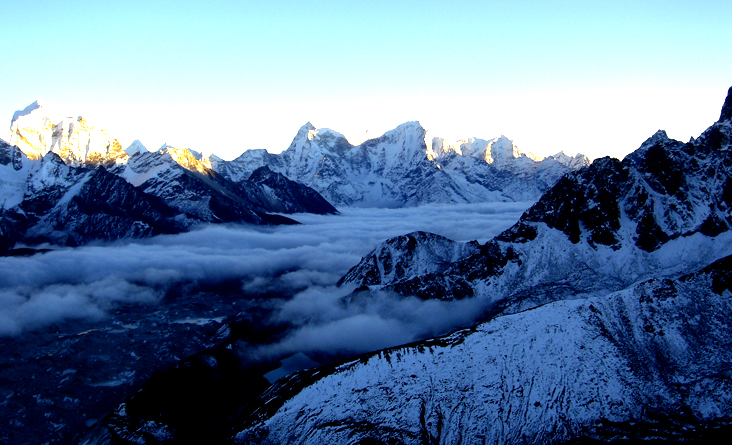
Since the terrain can be hard and the days long, hikers on these treks should be in good physical condition and have some previous mountain walking experience. Steep climbing may be involved, although it is never necessary to use ropes. Treks at this level can he arranged for periods of 16 to 21 days. Typically, a gradual ascent through a green river valley will lead you up to a number of high passes, where you will reach the altitude of 5416m. Often times, you will get a close insight into the Tibetan culture. Participants should expect to trek above 5416m/17872ft.
Group Price
Number of Travellers
- Detail itinerary
- Cost Includes/Excludes
- Fixed Departures
- Reviews (18)
Everest Three Passes Trek Nepal Itinerary
The 3 passes trek in the Everest region is one of the most popular treks in Nepal. The trek takes you through three different passes, each with its unique scenery. You’ll get to see the beautiful Himalayan scenery. The Everest 3 Passes Trek offers high mountains, and challenging trekking passes . green meadows, and high passes on the alpine plateau of the Everest Region. Additionally, Enjoy the three passes to trek the wonders of the famous Everest region, including Gokyo Lake on this 17-day hike from Lukla. fly from Kathmandu to Lukla and begin the Three-pass trek with Nepal Wilderness Trekking an expert guide and porters. Discovering the history and geology of each site, the old and historical monastery of Tengboche, Sagarmatha National Park offers countless Himalayan peaks, the gorgeous Dudh Koshi river, natural streams, and cool water flowing.
The three-pass trek follows the Everest Base Camp route for two to three weeks passes, which provides some stunning views of the Himalayas and Mount Everest during the trek. As one of the most scenic treks in the world, the Everest Base Camp trek can be enjoyable, but the Everest three-pass trek can offer you even more of the beauty of the region. There has been a lot of interest in the inner Sagarmatha National Park of the Gokyo Lakes trek and the EBC trek which includes the three passes, and this trek takes you through the endpoint of that trek.
The Everest 3 passes trek is through a remote alpine highlander area of Sherpa Villages, various landscapes , charming Sherpa village, Namche Bazaar , the Birthplace of Apa Sherpa “village THAME” which summits 21 times the top of the world’s highest peak Mt. Everest, glory Gokyo lake , and largest Khumbu glacier. The total distance of the Three Passes Trek is about 92 miles round trip, and it takes 17 days in total to complete the trek. Many solo travelers and small groups of travelers like to take the Three Passes Trek.
Everest 3 passes trek difficulty
Additionally, the Everest Three Passes trek is also a moderately difficult trek, which requires a lot of stamina for hiking skills, and requires well-prepared equipment with a set of microspikes if necessary. 3 passes in the Nepal trekking area are always covered in snow and ice. This itinerary is meant for those who are looking for a challenging and long hike 17 days of strenuous hikes up the mountains of 3 passes, the high altitude mountain (Bhanjyang), the Renjo la Pass 4,790 meters, the Cho la Pass 5,420 meters, and the Kongma-La pass 5,310 meters.
The best options route is clockwise to do Everest high passes trek that summits Gokyo Ri at 5,420 m (17,782 ft), and Kala Patthar at 5,644 m (18,519 ft). Chhukung Ri 5,550 meters (18,209 ft) or Mhra peak without climbing permits, from these Trekking peaks, you can film – take photographs of beautiful mountains Mt. Everest, Mt. Pumori, Mt. Makalu, Mt. Lhotse, Ama Dablam, and many white peaks, it is a breath-taking mountain view. December and January are remedied alternative paths via Phorche village instead of Cho La because Cho La will be closed if there is heavy snow.
The more hidden Peaks surrounding 3 passes of Everest Trek
Enhance, there are many hidden Peaks, surrounding the 3 passes Everest Trek, the Sundar Peak 5,360 m in Thame, Nangkartshang Peak 5,100 M in Lungden, Ngozumpa Tse Peak 5,553 M in Gokyo, Awi Peak 5,245 M in Zhong la, Pokalde peak (Dolma Ri 5,806 m) in Kongma-La ridge, Chukhung Ri 5,546 in Chhukung, and Nagartsang Peak 5,083 M in Dingboche. so if your time permits to ascend all peaks then can add some more extra days.
What is the reason for the clockwise itinerary rather than the counterclockwise itinerary?
Our previous experience leading the passes trek has shown that many customers give up after the Everest base camp and Kala Patthar because they have only set their minds on trekking Everest Base Camp. There are, of course, beautiful Gokyo Lakes and charming Gokyo Peak to admire.
If we lead clockwise from Renjo Pass , they all make their way to Everest Base Camp via Gokyo Lake, which is also excellent acclimatization for further passes via clockwise since Renjo Pass is located at 5380 meters, Chola Pass is located at 5420 meters, and Kongma Pass is located at 5540 meters.
Numerically, it doesn’t matter , but when you are on the spot, even climbing 30 meters matters. However, for us, it is no problem to lead you on both sides as you wish, so we listed both itineraries and so we do lead as you wish.
Trekking over the three passes
The highest 3 passes trek is the most popular trekking destination among those seeking extreme adventure around the world. Various trekking routes are available for you to choose from. You will be able to make the best choice according to the length of your stay, your desire for adventure, and your level of determination. You will encounter several trekkers and tourists along the way. As a result, the route is relatively safe. There is no doubt that the 3 passes trek is one of a high caliber, offering a truly unique experience. This package offers a 17-day trek with three passes, which is not only beautiful but also more adventurous.
Three passes trek distance of km
Three passes trek vs. Everest base camp Length is a total distance of 148 kilometers, per day hike is approximately 11.5 Kilometers, though depending on the altitude area, low altitudes can hike more than 11.5 km, and above the 5,000 altitudes is less km.
Everest three passes Trek is not recommended without a guide
A 3-pass trek is not recommendable without guides and porters for independent solo travelers, the reasons are miserable trails, difficult ascent climbs, icy, slippery Cliffs, high altitude passes, and often changing weather.
Nepal wilderness trekking guide team is an expert in the 3 passes trek route, we do lead a small group and solo trekkers every day at season time, our guide knows all and every corner of the Everest region, because of a local guide who did three high passes trek uncountable, every month at season time, so guides know every stone steps, mountains, peoples, cultures, area parameter trails
Three Passes Trek with Nepal Wilderness Trekking Company
Nepal Wilderness Trekking and Expedition is known as the top-rated company among many agencies because of the following salient features of the company. Locally Owned and Operated. As a local travel operator, we have a lot of experience regarding the Three Passes Trek and its surroundings. We know how to get you to the Three Passes route in the best way possible and how to get you there in the same way.
The rate of success of our Three Passes Trek is great because Nepal Wilderness Trekking is a very trustworthy trekking company in the sense that we are operating all Three Passes Trek based on reality, integrity, and honesty. We are committed to meeting your needs. We highly value all trekkers and are responsive to their needs and preferences. Depending on the interests and plans of our customers, we can customize our Three Passes Trek package to suit their needs.
Value for money. Nepal Wilderness Trekking provides the value of what you buy of our services at least equal to the amount you pay. You will not be charged any middle and hidden fees when you purchase our services. Our one travel consultant or our local expert trekking guide will stay in close contact with our clients every step of the way. Our company ensures customers’ safety at all times so that they will have peace of mind while trekking to Three Passes with us.
Everest high passes Trip Highlights
- 3 Best Places for Photographers during Everest High Passes Trek from Gokyo Ri, Kalapathar, and Chhukung Ri.
- The unsurpassed breathtaking view of Mount Everest, Cho Oyu, and Makalu from Gokyo Ri, Kalapathar, and Chhukung
- Experience vibrant Sherpa communities’ cultural heritage
- Stunningly Buddhist religious old monasteries
To do a three-pass trek are only 2 types of permits required, it is Everest National Park Entry Permit and Khumbu Pasang Lhamu Rural Municipality Entrance Permit. this norman permits coverage entire region.
Note: All published dates below are guaranteed departures. If they don’t fit your schedule, we’re happy to arrange a trip on your preferred dates. Share your desired trip details, and we’ll make your dream destination a reality.

Detail Itinerary
- Day 01: Tara air to Lukla Hillary airport early in the morning ( 2860 meters , 35 minutes) and treks to Phakding ( 2640 meters, 3 hours). Overnight at Lodge . During the evening village tour,
- Day 02: Trek to Namche Bazaar ( 3440 meters. 6/7 hours walking) and stay the night at the lodge.
- Day 03: Rest day in the same place for acclimatization. Visit the Sherpa Museum and Everest View Lodge for panoramic views of the Himalayan mountains.
- Day 04: Trek to Thame (3750m) walking for 4 hours. This village is well known to Everest climbers and is a comfortable place to stay overnight.
- Day 05: 5-6 hours walking) to Lungdeng (4600m) and stay overnight at the lodge.
- Day 06: Gokyo ( 4700 meters. ) via Renjo Pass (5360 meters.) 6-hour walking trek) Stay overnight at Gokyo.
- Day 07: Gokyo Peak ( 5357 meters ), our highest point (four and a half hours walking), offers sunrise and an expansive view of the mountain range. Return to Gokyo, and stay overnight at the lodge.
- Day 08: 5 hours walk to Tangnak 4843M . overnight at the lodge (if you have extra days, you can stay one more night in Gokyo and visit the 5th Lake for even more incredible mountain views).
- Day 09: Trek to Zhong La ( 4830 M. via Chola Pass ( 5420 meters. Six or seven hours walking) today the path is narrow and tiny ascending to the top of Cho La. Stay overnight at the lodge.
- Day 10: We trekked to Lobuche ( 4940 meters ..4 hours walk) and stayed at a lodge.
- Day 11: Trek to Gorakshep 5164M , visit Everest base camp 5,364 m the same day, and return to Gorakshep, totals hike will be 8/9 hours, overnight at lodge.
- Day 12: Explore Kalapattar ( 5,545 meters). for the most stunning view of Everest, climb up in the morning before trekking back to Lobuche (5 hours of walking), and spend the night at a lodge.
- Day 13: Cross Kongma-La (5540m), and stay overnight at Ding Boche Lodge.
- Day 14: Trek back to Tyangboche 3860m in five hours and spend the night at the lodge.
- Day 15: Trek back to Namche Bazaar ( 3440 meters , 6/7 hours walking). Stay overnight at the lodge.
- Day 16: Trek back to Lukla (7/8 hours walking) and overnight at the lodge.
- Day 17: Fly back to Kathmandu around 7:00 AM (35 minutes)
Itinerary Options B:
- Day 01: Tara air to Lukla Hillary airport early in the morning ( 2860 meters , 35 minutes) and treks to Phakding ( 2640 meters, 3 hours). Overnight at Lodge . During the evening village tour,
- Day 02: Trek to Namche Bazaar ( 3440 meters 6/7 hours walking) and stay the night at the lodge.
- Day 03: Rest day in the same place for acclimatization. Visit the Sherpa Museum and Everest View Lodge for panoramic views of the Himalayan mountains.
- Day 04: Trek to Tyangboche 3860m in five hours and spend the night at the lodge.
- Day 05: Trek to Dingboche 4,340 m 5-hour hike, overnight at lodge.
- Day 06: rest day for acclimatization, or hike Chhukung RI, overnight at lodge.
- Day 07: Trek to Lobuche ( 4940 meters . Via Kongma-La pass (5540m.6.7 hours walk) and stayed at a lodge.
- Day 08: Trek to Gorakshep 5164 M , store the bags in the lodge visit Everest base camp 5,364 m the same day, and return to Gorakshep, overnight at lodge. total hike will be 8/9 hours.
- Day 09: Explore Kalapattar ( 5,545 meters). for the most stunning view of Everest, climb up in the morning before trekking back to Zong la 4830 M (5 hours walking), and spend the night at a lodge.
- Day 10: 6 hours walk to Tangnak 4843M . via Chola Pass ( 5420 meters, overnight at the lodge
- Day 11: Trek to Gokyo ( 4700 meters. ) 3-hour walking trek) Stay overnight at Gokyo.
- Day 12: visit Gokyo Peak ( 5357 meters ), our highest point (four and a half hours walking), which offers sunrise and an expansive view of the mountain range. Return to Gokyo, and stay overnight at the lodge.
- Day 13: 5-6 hours walking) to Lungdeng (4600m) via Renjo Pass (5360 meters and stay overnight at the lodge.
- Day 14: Trek to Thame (3750m) walking for 5 hours. This village is well known to Everest climbers and is a comfortable place to stay overnight.
- Day 15: Trek back to Namche Bazaar ( 3440 meters 4 hours walking) and stay the night at the lodge.
- Day 16: Trek back to Lukla (7/8 hours walking) and overnight at the lodge.
- Day 17: Fly back to Kathmandu around 7:00 AM (35 minutes)
Cost Included
- Domestic flight tickets from Kathmandu to Lukla and Lukla to Kathmandu
- Italian, Chinese, Nepali, Indian, and other European foods are available three times a day (breakfast, lunch, and dinner).
- Accommodation in tea houses according to the itinerary
- Kitbag for storing your belongings
- Sleeping bag for a comfortable night's sleep on a trek in minus-25 degrees
- Everest National Park Entrance Trekking Permit
- Khumbu Pasang Lhamu Rural Municipality Entrance Permit
- Experienced English-speaking trekking guide licensed by the government, familiar with the area.
- One porter for every two to three participants. (Note: An additional cost applies for solo clients requiring a porter.)
- Guide, and Porter meals, accommodation, salary, and insurance
- Necessary paper works, all government, and local taxes
- A certificate of appreciation from Nepal wilderness trekking after a successful trek
Cost Excluded
- Airfare for international flights
- Upon arrival at Tribhuwan International Airport, Nepal entry visa fees vary by duration (15 days - $25-30, 30 days
- Accommodations and meals in Kathmandu before and after our journey
- Personal equipment for high and cold temperatures
- Emergency high-altitude rescue and evacuation are covered by travel insurance
- All beverages, Soft and coffee table drinks such as coke, beer,
- Drinking water/mineral water, Dessert, etc. Hot shower, laundry
- Tip for guide and porter
- Excluded are all costs and expenses not listed under "cost includes"
- Inclusion of costs or delays beyond the control of the management, such as landslides, weather conditions, itinerary modifications due to safety concerns, illness, changes in government policies, strikes, etc.
Wild time with NWT!
My wife and Mirthe I completed the Three Passes Trek with Nepal Wilderness Trekking and had an amazing time. Upon arrival in Kathmandu we visited several trekking agencies and immediately had a good feeling with Himal, the owner of NWT. We choose his company and are very happy we did. Himal professionally took care of all the organization and we left two days later with our guide Abinta and porter Ram. Our guide Abinta was very professional, proactive and social and had excellent English skills and a great sense of humour. It often felt like we were on the trail as a group of friends, while we could rely on Abinta for her help and guidance as well. Ram was a very strong and friendly porter and we could not have completed the trek without him.
Overall, we can recommend Nepal Wilderness Trekking for the experience of a lifetime!
Stunning Three Passes Trek
My friend and I booked the trip with Nepal wilderness, modified Three Passes Trek with the Everest Base Camp add-on, and it was truly an incredible experience! Our guide, Yakub, played a crucial role in making this trip so memorable for us. His attentive care and wealth of knowledge made all the difference.
We encountered a travel delay with our flights into Lukla at the start of our journey, but Yakub handled it brilliantly. He remained positive and quickly arranged an alternative, ensuring that our trip proceeded smoothly.
Thanks to his efforts, we were able to fully enjoy our adventure without any hiccups. It was an unforgettable journey!
Base Camp, Cho La Pass, Renjo La Pass, Kongma Pass, Gokyo Ri, and Kala Patthar
It was under the provision of Mr. Himal Ghale’s Nepal Wilderness Trekking Agency that I participated in one of the most beautiful treks in Nepal, the 17 days Everest Base Camp and three Passes.
As a result of being free from work, I returned to Nepal on October 5th. I felt a sense of misgiving as the plane landed at Tribhuvan since I saw rain out the window. The monsoons lasted longer than expected this year, and the rain followed Rajesh Gurung and me for the first few days. Because of the rain, we spent three days in Dingboche waiting for the rain to stop instead of the two days planned for acclimatization. The rest of the days, however, were sunny and crystal-clear, so we didn’t miss anything.
Visitors are often caught in the defilements caused by high altitudes. It happened to me more or less this time as well. As a result of Rajesh’s assistance on the way, I was able to reach the Everest Base Camp and all three passes with three peaks by October 23rd. As a result of Rajesh’s assistance on the way, I was able to reach the Everest Base Camp and all three passes with three peaks by October 23rd.
Kongma La Trek was a bit of an adventure since the sun had already set when we reached the edge of Solukhumbu Glacier, where the Lobuche direction marker was. Therefore, we had to continue crossing the glacier in the dark. Currently, it appears that we have lost our way. Unfortunately, when I had already resigned to the fact that we would spend the night there, listening to the rocky boulders falling into the water, Rajesh detected the way.
The assistance of his knowledge, patience, and thoughtfulness can match the requirements of critical trekking incidents.
The beauty of nature was worth dying for, so I didn’t regret any shortness of breath. The beauty of nature was worth dying for, so I didn’t regret any shortness of breath. My camera captured some unforgettable moments.
The best of the best are Himal and Riddhi! If you are looking for an agency that can help you plan your Nepal hiking trips, I highly recommend Nepal Wilderness Trekking. We did the 3 Passes Trek, and I have to say, that this is by far the hardest trek that I have ever done, however, it is also the most rewarding.
We are really lucky to have Riddhi as our guide, and the two porters taking care of us the whole time we are in the mountains. There is no doubt that Riddhi is considerate, caring, and has a wealth of knowledge about the area in which he lives. As a result, I really appreciate that he constantly makes sure we have a good time by adjusting our pace and itinerary to ensure we are having a good time.
The purpose of this comment is to thank Himal, Riddhi, and the two porters for their hard work in making this 17-day three passes trek so special to me and memorable for me.
Nepal Wilderness Trekking is a company that is completely trustworthy and seriously committed to its clients. For me, it was a DREAM COME TRUE!! I hiked in the KHUMBU Valley for 16 days to Gokyo, Renjo, and Kongma La, it was an awesome experience, I wanted to go alone to the Everest Region and this trip was incredible, I was with a fantastic guide GUNESH, who took care of everything for me, including logistics, food, and helped make this an incredible experience.
Nepal Wilderness Trekking is a trek I highly recommend. Himal, the owner of the property, was always responsive both leading up to and during the trip. Furthermore, after my hospitalization, Himal took very good care of me and made sure that I still had a memorable experience while I was in Nepal.
As soon as we arrived in Kathmandu, we met up with him for a pre-day check-in and he made himself available for any further questions our group may have. Furthermore, he gave us the option of storing our luggage at his office if we did not want to store our luggage at the hotel. As well as offering some trekking tips, he also gave us the option of either using the duffel bags from his trekking company or the ones we brought with us. The porters would be responsible for carrying the duffel bags.
I am very grateful to have had a trekking guide and a porter to accompany me on the trip. Our trekking guide took care of all the logistics related to permits, and teahouses, and guided us on the right path all by himself. All of the items that I was not going to use while trekking for that particular day was carried by the porter. The result of this was that I was able to trek with a light daypack (maximum recommended weight of 7kg) while the porter carried the remaining 10kg to 15kg of my luggage. The trekking guide we had was Riddhi and my porter was Sid. Both were caring, thoughtful, and wonderful people.
I had the unfortunate experience of getting Acute Mountain Sickness (AMS) on day 3 of my 17-day trek and had to be med-evacuated to the hospital. Since I was unable to be at high altitudes as a result of my medical condition, the Himalayas were no longer an option for me. Instead, Himal and I worked together to design a low-altitude itinerary that would align with all of the parameters of my health requirements. In addition to a personal trekking guide/porter, I visited the cultural and culinary history of Kathmandu, spelunked, and went sightseeing around Pokhara, including a 2-day trek to Poon Hill. I also visited the Buddhist monasteries of Lumbini (birthplace of Buddha) and took a mountain flight through the Himalayas.
Despite the fact that I was unable to complete my 17-day trek through the three passes which included Everest Basecamp, Himal helped me salvage my trip and put me on a custom trip that he and I planned together. Himal was thoughtful, responsive, and did his best to ensure my experience in Nepal was good. He even visited me the first two days I was in the hospital. It was a great pleasure to book my trip through Nepal Wilderness Trekking. I doubt that any other trekking company would have worked as hard as Himal did to help me create such a wonderful 3-week experience in Nepal despite my inability to hike the Himalayas.
I have done the 3 Pass Trek with this company and I have to say it was very challenging, but rewarding and worth it nonetheless. It was one of the hardest ones yet compared to the ones that people usually do (16 days, several nights above 15,000 ft and counterclockwise direction), so it can really push you to the very edge of your abilities. I recommend this trek only to those who are in pretty good hiking shape as even in the best shape, you will still be able to kick your butt out of this trek.
It was a great pleasure to have a guide and porter with us. As a group, we were led by Riddhi who was a great guide – he was warm, welcoming, and took great care of us (there was a lot of adjustment needed to get used to the altitude, cold, and physical requirements required for this trek). We were together for a long time doing this hike and it was wonderful to have someone who knew what they were doing and could take care of the lodging and details for us. In addition, it was really nice to see that the guides also got excited about the mountains as well. He was just as excited as we were to see the views from the passes and Mt Everest from up there.
We also had our porters carry our extra luggage, and they did a great job. In hindsight, it is hard to imagine having to carry everything you would need for this trip all by yourself. Our guide manager, Himal, prior to our trip was very communicative and responsive. We asked him all the questions we had, and he was very helpful when one of our friends needed help during the trip. I would highly recommend him as someone to know when going on a trip like this. As a whole, I found the value and price for this tour to be very good, and I would recommend this company to others.
During our trek to the Everest area, we did an amazing and epic 17-day trek covering three passes. Our guide Riddhi did an outstanding job of setting up a challenging yet spectacular itinerary through some of the tallest mountains in the world with our owner Himal, who was extremely communicative and helpful throughout the trip. On this trek, we had a guide and porters – this made things a lot less stressful, and the passes were all quite challenging (the few people we saw out there carrying all their stuff were suffering).
Also, they were there for us when things went wrong and one of our group members came down with altitude sickness due to an underlying heart condition that they were not aware of. Himal and Riddhi got them the medical care they needed on the mountain, arranged for the helicopter evacuation and subsequent care, and arranged an alternative adventure at a lower altitude after they had recovered. Throughout the whole process, we felt very well taken care of and supported.
Kevin James
Very great place to plan a trek. Walking into Himal’s office you can tell he is a great and experienced trekker himself. If I recall correctly, he has been running the agency since 1990. I asked him for a very strong guide because I wanted to do the Everest Three Pass Trek in 7 days and he gave me a great guide, Parkhidhan Tamang. At first, I was unsure that I needed a guide, but Parkhi helped me so much, that I don’t think I could have done it without him. He guided me through tricky and technical sections of the route – he had friends at all of the best local teahouses and facilitated my stay at each one. Sometimes when we were running late he would call ahead to reserve our spot. He had the strength to both complete my ambitious trek and also support me at the same time.
Ron & Lara
The 3 passes trek was amazing. Himal is a friendly owner who responds quickly to questions.
Mingmar, our guide, was excellent. We are grateful for everything he did for us. He is very familiar with the route and knows everybody and every town up in the mountains. He is fun to be around. He made us feel safe and we highly recommend him to anyone who goes trekking.
Our porter Fulonn was also great. Incredible to see how easily he is walking through the mountains. We considered doing the trek without a porter, however, you’ll provide the opportunity for someone to work and get some extra income. And then we would recommend Fulton.
Arrived alone, left with friends – best agency!
Wilderness Trekking is an excellent agency for trekking and climbing tours in Nepal. Himal’s professionalism has greatly impressed me. Throughout the trip, he never tired of answering my thousand questions – and this almost instantly! Because he has done many kinds of treks himself, as a pleasure or even as a guide, he knows what he is talking about. He remains attentive to any requests or sudden weather changes. Parkhi Dhan, my guide, was absolutely great, trustworthy, and knowledgeable. Parkhi Dhan was one of the most sociable guides I met along the way.
Due to heavy snowfall, I was unable to cross the three high passes, so I trekked each valley separately to the end, then into the next one and back again. The most beautiful panorama and view on Mount Everest can definitely be seen from Gokyo and Gokyo Ri if you have limited time and are not sure which valley to go to. The Khumbu Valley is also beautiful, especially with snow.
Despite going to Kathmandu knowing nothing or anyone, I have left with two new friends – THANK YOU HIMAL and PARKHI DHAN!!!
Three-passes-tour breathtaking
I just finished a trip with my husband, Three passes trek (Ama Dablam BC, Island Peak BC, EBC, Chukhung Ri, Kala Patthar, Gokyo Ri, Bhote Koshi Valley) over 24 days. We met our wonderful porter/guide Makaraj Tamang thanks to Himal Ghale who responded to all our e-mails promptly and competently.
In all situations, Makar was willing to help (finding the most suitable lodges at the best price, giving information on the landscape, culture, and food). It was a joy to start every new day seeing him smile and have fun with me. Throughout our stay, he was very attentive and considerate so that we always felt safe. Trekking in the Everest region is possible with Nepal Wilderness Trekking and Guiding Makar Tamang.
Agnieszka K
Everest Three Passes Trek from Bupsa
In April of this year, my husband and I hired a guide from the agency, Mr. Makaraj Tamang. We had a great time. Mr. Himal, the owner of the agency, answered all of our online questions quickly and efficiently. He was also very helpful on-site. In addition, he respected our “independent trekkers” attitude. It was highly appreciated that he did not try to upsell us services we did not need, so thank you Himal, and 5 stars for not being pushy.
Mr. Makaraj was very knowledgeable and talkative. We learned a lot about Nepal’s culture. During the snowstorm, he walked us through glaciers like it was a stroll in the park on Sunday. He made us feel safe. Thanks for making our trip enjoyable.
I had a great time on the trek. It was likely caused by a pandemic, but to be alone at all the peaks was amazing. This trek is well worth trying even during crowded times since it is so breathtaking. Nepal Wilderness Trekking and Makaraj as a guide are highly recommended.
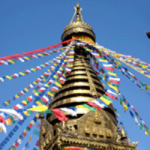
Three Passes Trekking
Our trip with Prakash over Cho La and Renjo La was beautiful! We were delighted with the service and support that Prakash delivered. He has a bright future and is suited to his role as guide. Even though we only needed his services as a porter, we would recommend him to anyone as a guide due to his professional attitude and excellent English.
I will be pleased to provide a testimonial shortly and look forward to using your services again in the future.
Until then, may you have good health and good fortune
Kind regards, Jude Trevillien
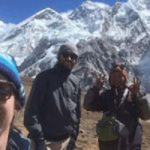
Dean & Laynni
Three pass trek.
Hi, Himal. Just wanted to let you know that we had a fantastic trek up to EBC. We had fantastic weather all the way up. The clouds started only on our way down from Kala Pattar and stayed most of the way down, but the mornings were still lovely.
We wanted to thank you for your help in organizing our porter/guide and porter. They were great guys and worked very hard to make sure our trip went well. Prakash was always very eager to help us in any way possible. He was still watching the other guides and improving his guiding skills as the trip went on and his English was better than we expected for a porter/guide.
We were also surprised by how much English Milan knew, and he often helped us communicate. Thanks again, hope the rest of the season goes well Dean & Laynni
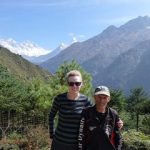
Lex and Kerry
Three pass trekking.
We used the Nepal Wilderness Trekking company for a 19 day “3 Pass Trek” in the Everest region, in October 2012. Himal Ghale, the owner, was highly knowledgeable about the Everest Region having worked there as a Guide in the past.
Himal organized a tailor-made itinerary for us, based on our interests, abilities and time commitments.
That is included the “3 Passes” route, Everest Base Camp and Kala Pattar, and the addition of a summit of Island Peak. Himal was very responsive in answering our initial questions (remotely), meet with us in Kathmandu, and dealt with some challenges that arose from unforeseen weather conditions.
We were also delighted with our assigned Porter/Guide – named “BB.” BB provided first class support to us throughout the trek and lived up to his reputation as a reliable and highly experienced Porter/Guide. Amazingly, BB had competed over the past eight years in the Tensing/ Hillary Everest Marathon!! He knew the region exceptionally well, including the many route variations and options we could take for different terrain/altitude, and chose excellent guest houses for us to stay at BB was well known, respected and welcomed by guest house proprietors along the way. He was also a very kind and caring gentleman – we will always remember BB with great fondness, respect, and gratitude for a wonderful trekking experience.
We wish Himal well over the future years and would recommend the Nepal Wilderness Trekking company to other trekkers for the Everest region.
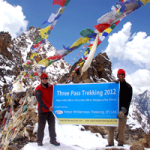
3 pass trekking reviews
Just finished the 3 Passes Trek (Renjo, Cho La and Kongma La pass), EBC and Kala Patthar, and finally, Island Peak summit with Nepal Wilderness Trekking Had a great trip. Himal and our guide Purna worked everything out perfectly. This team comes highly recommended from me.
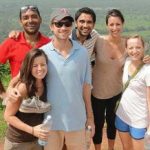
Fred and Evan
3 pass trekking.
We enjoyed our three pass trek. Challenging but rewarding. Magnificent views, Purna + Bir did a very good Job-they were very flexible when we wanted to alter our plans, and we always helpful + supporting their attitude + personality helped us a lot on some of the long climbs, and through the cold +wind. It was a very memorable trip – thanks to Himal + everyone else who helped us along the way!
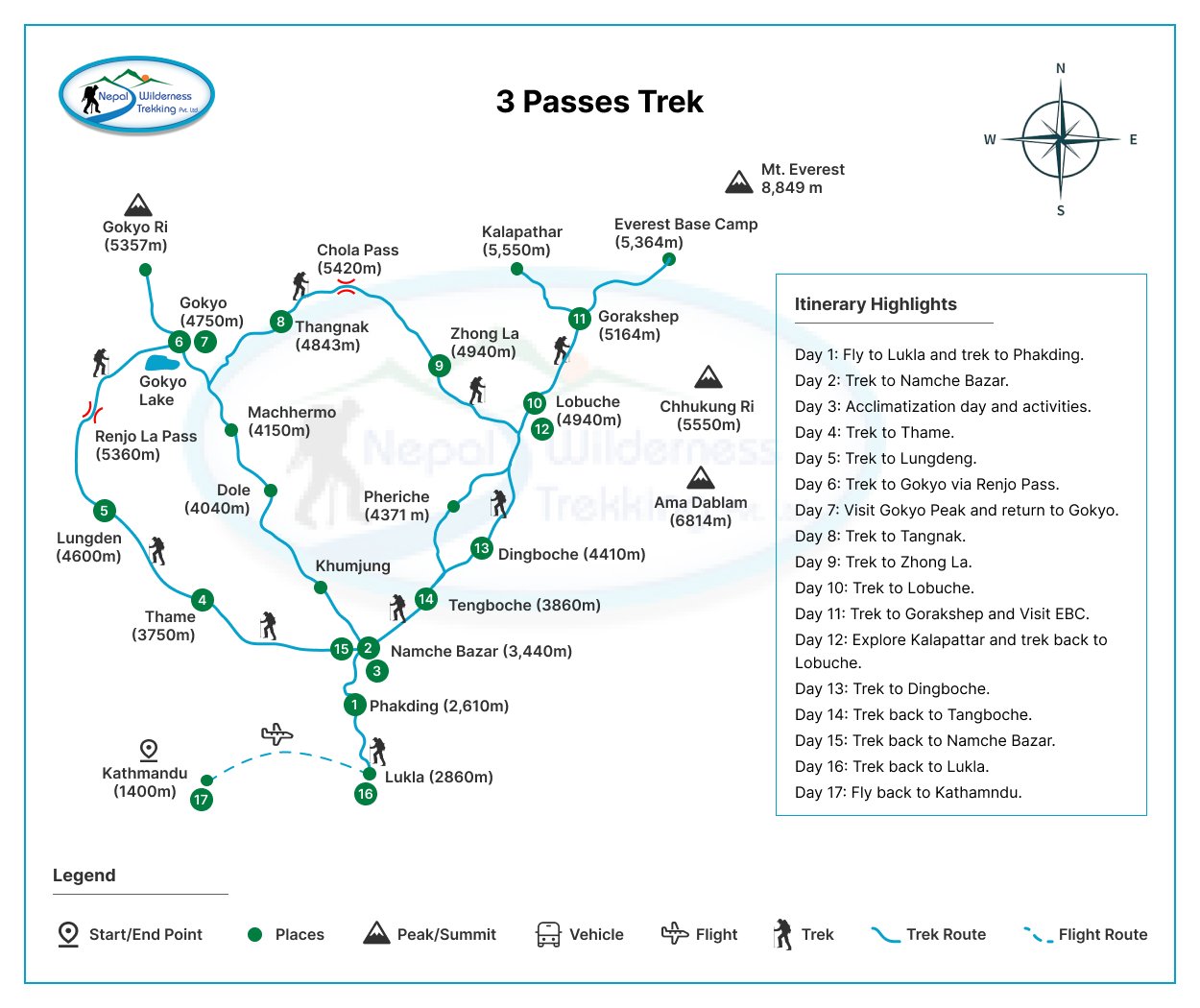
Frequently Asked Questions
How difficult is everest high passes trek, what is the maximum height of this trek, is it possible to do private trek, when is the best time to do the trek, what is the temperature in october and april, what is the accommodation type, are there atms available along the trail, how to prevent altitude sickness during the trek, why are acclimatization hikes necessary, what kind of clothes, gear and equipment do i need for the 3 passes trek, is drinking water available during the trek is it safe, what is acute mountain sickness (ams) and how likely am i to experience it, altitude chart, similar packages, nangpa la pass trek, short trek to everest, luxury everest base camp trek with helicopter return, 13-day everest base camp trek, chola pass trek, numbur cheese circuit trek, we are recommended on.
Nepal Wilderness Trekking Pvt. Ltd.
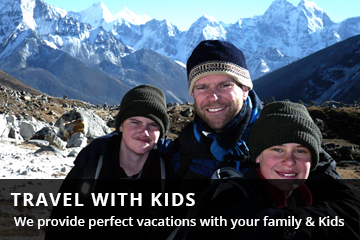
Nepal Traveller's Information
- Nepal Information
- Nepal Visa Information
- Entry Procedure to nepal
- Altitude Mountain Sickness

Three-Passes Trek in Nepal – Teil 1 “Ankommen”
3 wochen durch das hochgebirge der khumbu-region im himalaya.
Fast den gesamten April hatte ich mir freigenommen, um diese Wanderung endlich zu machen, die ich eigentlich für das Frühjahr 2020 geplant hatte, als uns allen Corona einen Strich durch die Rechnung machte.
Ich wollte das Everest Base Camp sehen – und zwar nicht im Herbst, als ich das letzte Mal mit Insa in Nepal wandern gewesen war, sondern im April, wenn es dort von Zelten und Menschen wimmelt, die den zahlreichen Expeditionsteams angehören, die in dieser Saison auf den höchsten Gipfel der Welt steigen wollen.
Aber in diesem Jahr würde ich arbeiten und eben „nur“ meinen Jahresurlaub nehmen können, um eine Wanderung zu machen, von der ich wusste, dass sie nicht einfach und auch nicht kurz sein würde. Klar, kann man das Everest Base Camp (EBC) in recht wenigen Tagen erreichen, aber ich wollte die „Three Passes“-Wanderung machen, einen Rundkurs mit einem Abstecher zum EBC. Und etwas mehr als 3 Wochen lassen keinen großen Puffer zu, denn man muss Akklimatisierungstage einplanen, damit rechnen, dass das Wetter nicht gut genug sein wird und man abwarten muss, oder es einem einfach mal auch nicht gut geht. Es würde also sportlich werden, aber ich hatte Lust auf diese Herausforderung und so buchte ich meine Flüge.
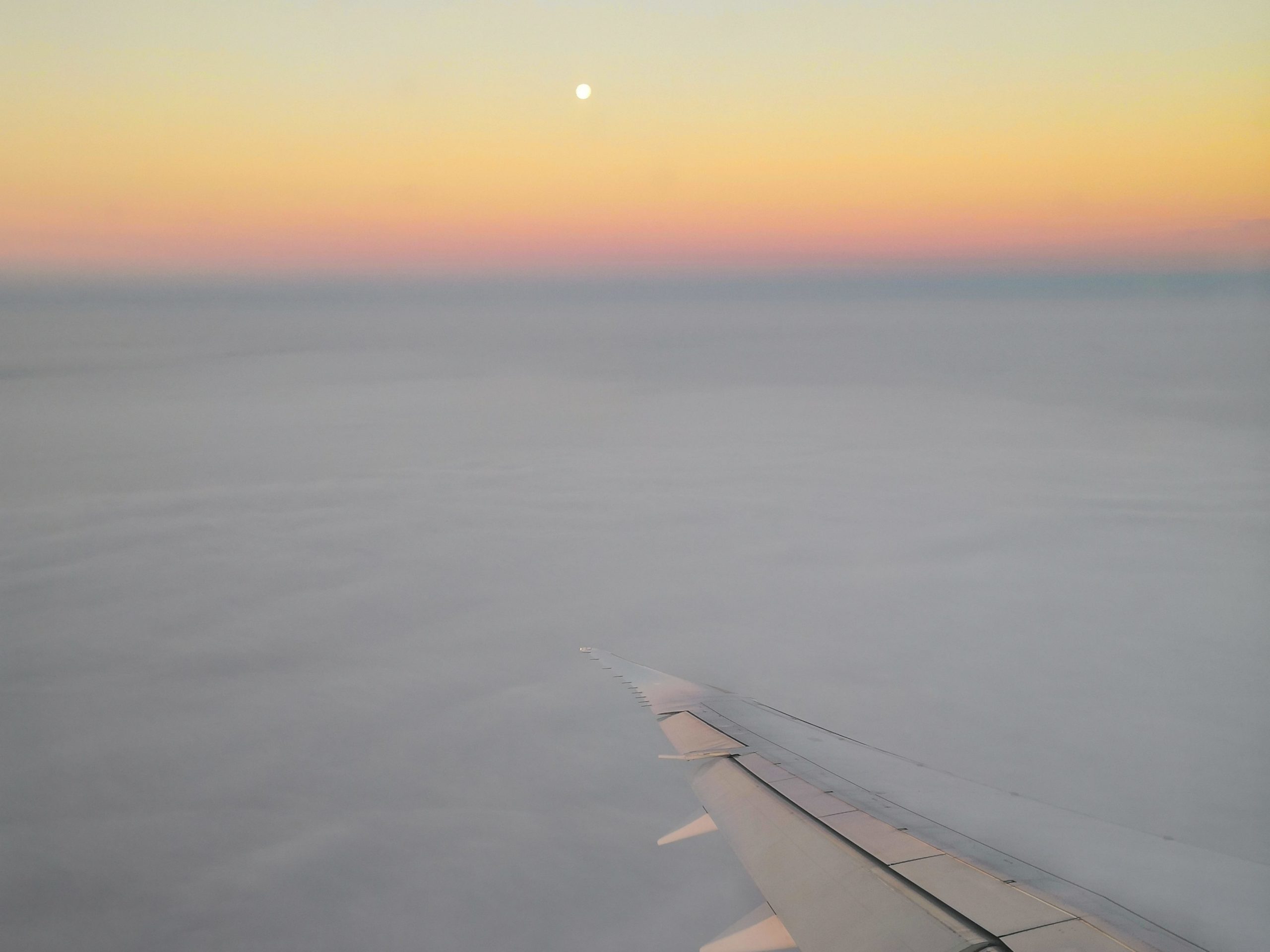
Anreise: Bremen – Kathmandu – Lukla
In Kathmandu angekommen, lief alles wie am Schnürchen, denn Mark – der sich schon etwas länger in Nepal aufhielt – hatte mir ein Taxi vom Flughafen zum Hotel organisiert und schon auf der Fahrt in den Touristenstadtteil Thamel kamen mir immer wieder einige Gebäude und Straßen bekannt vor und ich konnte ein fettes Grinsen nicht unterdrücken. Es war warm und stickig und der Verkehr in Kathmandu war so verrückt wie immer, nichts schien sich verändert zu haben. Auch in Thamel sprachen einen die gleichen Leute an, um ihre zahllosen Kleinigkeiten – von Obst über Flöten und Souvenirs bis hin zu Drogen – zu verkaufen. Willkommen zurück!
Mark hatte mir auf meinen ausdrücklichen Wunsch den „dicksten und wärmsten“ Schlafsack organisiert, den er finden konnte. Ich musste also nur noch einen Haufen Bargeld abheben, entspannt abends Essen gehen – oh, wie habe ich die guten Gewürze vermisst – und dann meinen Rucksack packen, wovon mindestens ein Drittel des Volumens von dem Schlafsack eingenommen wurde, und schon konnte es losgehen. Aus Zeitgründen hatten wir nämlich beschlossen direkt von Kathmandu nach Lukla zu fliegen und nicht, wie ich es vorgezogen hätte, einen Jeep zu nehmen und dann 2 bis 3 Tage hinaufzuwandern.
Somit fanden wir uns am nächsten Morgen am Domestic-Terminal ein und warteten. Und warteten. Und warteten. Unser Flugzeug war eine kleine Twin Otter, ein winziges Propellerflugzeug, das zu den wenigen Modellen gehört, die auf dem Flughafen in Lukla landen können. Neuerdings fliegen die meisten Flugzeuge von Ramechhap nach Lukla, um den Luftraum über Kathmandu zu entlasten, doch wir hatten eins der wenigen aus Kathmandu startenden Flugzeuge erwischt, das wir mit einer Expeditionsgruppe teilten. Leider jedoch wurde unser Flug immer weiter nach hinten verschoben und wir wurden langsam nervös. Ab mittags kann man im Normalfall nicht mehr in Lukla landen, da dann durch heraufziehende Wolken die Sicht zu schlecht wird. Nach einem Unfall 2008, der auf schlechte Sicht zurückzuführen war ( Quelle ), verhielt man sich etwas vorsichtiger an diesem „gefährlichsten Flughafen der Welt“.
Plötzlich ging es ganz schnell, wir wurden in einen Bus verladen und warteten kurze Zeit später irgendwo auf dem Flughafengelände. Als das Personal hektisch wurde, wussten wir: das Flugzeug ist gelandet. Und schon kam es angefahren, ein winziges Stück Blech, von dem ich mich merkwürdigerweise fragte, ob es überhaupt fliegen könnte. Ein schneller Wechsel der Passagiere und schon saß Mark am Fenster direkt hinter den Piloten, nur ein Vorhang trennte uns von den Gerätschaften und ich vermutete, dass es nicht allzu häufig vorkam, dass jemand versuchte diese Flugzeuge zu highjacken. Während des Fluges döste ich immer wieder ein: eine lange Anreise, Jetlag und eine kurze Nacht lagen mir in den Knochen. Als es jedoch turbulent wurde, musste auch ich hinausschauen, denn nun waren wir über den Bergen und den unterschiedlich warmen Luftströmen angekommen.
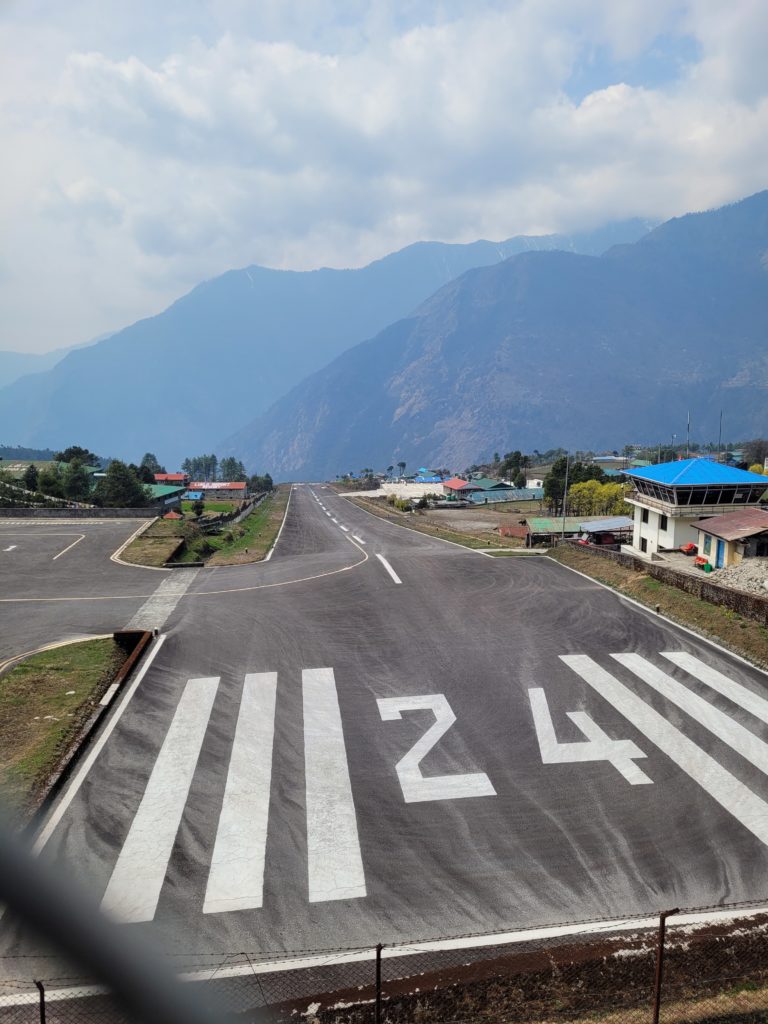
Laut Mark war der Landeanflug auf die winzige Start- und Landebahn in Lukla, die auf der einen Seite einen Absturz über die Klippe vorzeigt und auf der anderen Seite von einer massiven Bergflanke begrenzt wird, das Gruseligste, was er je hat mit ansehen müssen. Ich war einfach nur völlig verdutzt, als die Räder aufsetzten, denn ich hatte Sekunden vorher noch vorbeiziehende Berge gesehen, die vermuten ließen, dass wir noch hoch oben waren…
Und dann waren wir da. Am Rand der „Khumbu“-Region in Lukla, 2.800 m hoch, die Luft noch warm, aber deutlich frischer und reiner als im versmogten Kathmandu.
Three Passes – Wanderung
Wir würden 21 Tage in den Bergen sein:
Aufstieg in die Berge: Lukla – Phakding – Namche Bazaar
Nach der Landung blieben wir nicht lange in Lukla, sondern setzten direkt unsere Rucksäcke auf und wanderten los. Wir würden dem Fluss Dhud Khosi in seinem Tal immer höher hinein in die Berge folgen bis nach Namche Bazaar, das auf etwa 3.400 m liegt und den Eintritt in die höhere Everest-Region dahinter markiert.
Aber zunächst mussten wir an einigen Checkpoints stoppen, um unsere Wandererlaubnis zu besorgen, die Eintrittsgelder zu bezahlen und uns anzumelden. Hier wurde jeder Wanderer akribisch erfasst und auch der Austritt aus der Region später festgehalten. Checkpoints gab es so einige und wir waren oft die einzigen ohne Guide, die sich dort anstellten, um erfasst zu werden. Die Checkpoints gibt es schon lange und in allen Regionen in Nepal, aber dieses Jahr hatte es im Vorfeld unserer Reise einige Diskussionen und Bangen gegeben, denn Nepal hatte ohne Vorwarnung im März verkündet ab dem 1. April keine individuellen Trekker mehr in ihrem Land zu erlauben. In anderen Worten: jeder Wanderer, egal wie kurz oder lang und wie hoch er gehen wollte, würde einen Guide benötigen. Natürlich absolut nicht das, was wir wollten. Diese kontroverse Entscheidung hatte international zu einigen wenig unterstützenden Artikeln und Meinungen geführt und auch ich war sehr verärgert gewesen ( falls jemand mehr Infos möchte ). Kurz vor meiner Ankunft kam dann die erlösende Nachricht: die Khumbu-Region stellte sich gegen diese neuen Bestimmungen der Tourismusbehörde und würde individuellen Trekkern auch weiterhin den Zugang erlauben. Jedoch waren wir besonders am ersten Tag noch ein wenig angespannt, denn wer weiß wer sich am Ende durchsetzt bei diesem internen Machtkampf.
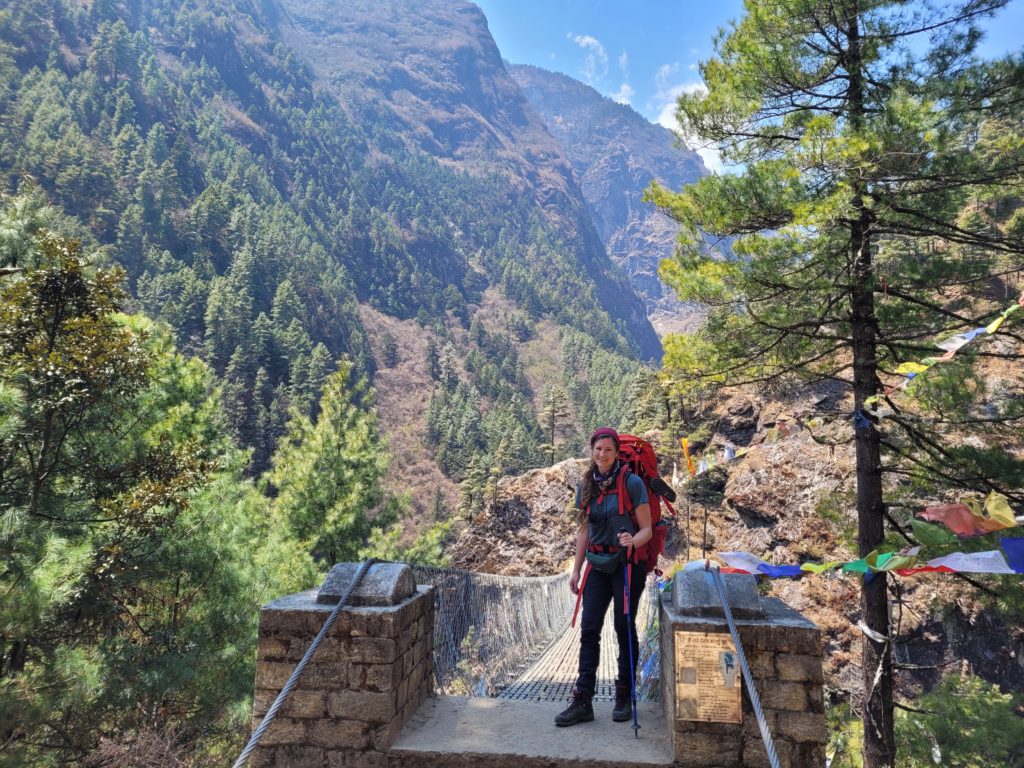
Etwa 8 typisch nepalesische Hängebrücken führen auf dem Weg nach Namche immer wieder von der einen Talseite auf die andere und wenn einem eine Tierkarawane entgegen kommt, ist Pausenzeit angesagt. Wir machten am ersten Tag jedoch nur etwa die Hälfte der Strecke hoch – etwa 7,5 km bis nach Phakding, einem Dorf, das etwa 200 Meter niedriger liegt als Lukla. Es war eine wirklich schöne Wanderung durch die blühenden Obstbäume und Rhododendren, die die Wege säumten. Der Frühling war hier schon im vollen Gange.
Mein Rucksack kam mir sehr schwer vor und ich merkte, dass ich mich definitiv noch an das Gewicht und das Wandern in den Bergen gewöhnen musste. In einem kleinen Dorf zeigte uns eine nette alte Dame ein paar heilige Mani-Steine. Hier im Norden hin zur Grenze zum Tibet sind die meisten Menschen buddhistischen Glaubens und das sieht man an jeder Ecke. Gebetsmühlen, beschriebene Steine, kleine Stupas und natürlich an jedem Berghang, jeder Brücke und jedem Gipfel die bunten Gebetsfahnen: blau – weiß – rot – grün – gelb. Om Ma Ni Padme Hum .
Ich schaffte es am ersten Tag direkt schon den Dichtungsring meines Wasserfilters zu verlieren und musste somit auf Chlortabletten umsteigen, was mich ziemlich ärgerte, aber Ersatzteile kann man hier natürlich nicht kaufen, also musste ich damit leben. Außerdem merkte ich abends mit leichten Kopfschmerzen, wie mein Körper sich langsam an die Höhe gewöhnte, denn zwei Tage zuvor war ich noch auf Meereshöhe gewesen. Noch waren wir allerdings nicht zu hoch und so musste ich mir momentan erstmal keine Sorgen machen.
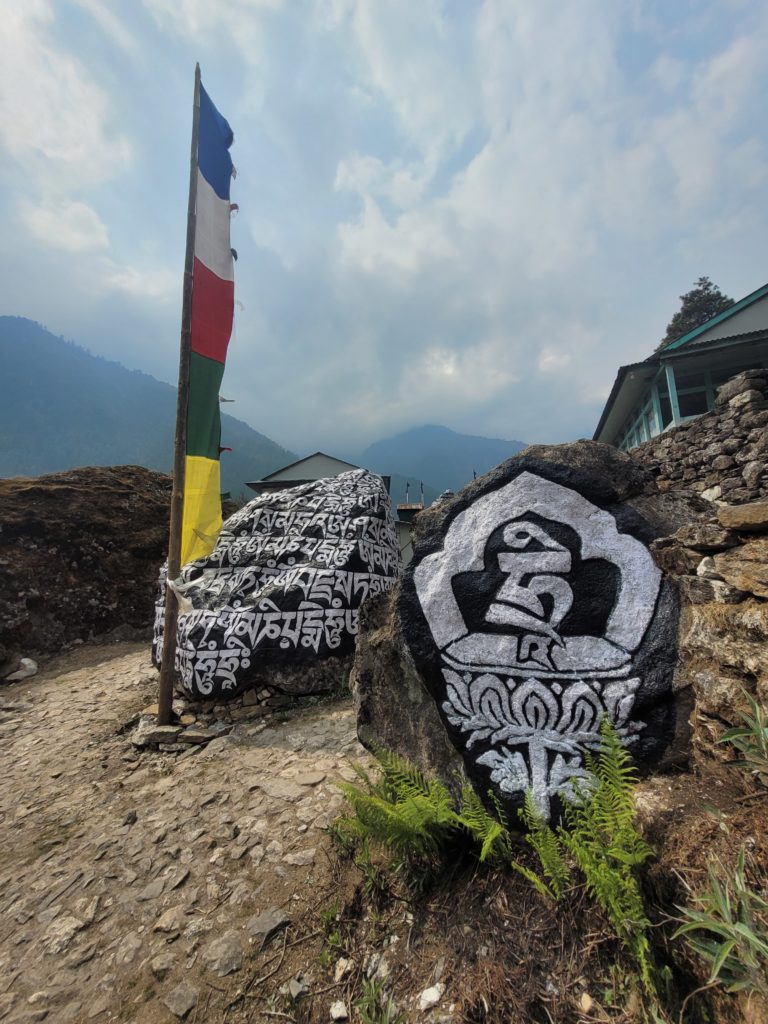
Am nächsten Tag ging es dann hauptsächlich aufwärts in 11 langen Kilometern nach Namche, das auf 3.440 m Höhe liegt. Da es zwischendurch immer wieder hinabging, machten wir in etwa 1000 Höhenmeter an Anstieg und ich kämpfte mit dem Gewicht des Rucksacks und der Höhe. Trotzdem kamen wir im warmen Sonnenschein recht gut voran; ich hatte morgens noch leichte Handschuhe angezogen, konnte diese aber schon nach kurzer Zeit ausziehen und im T-Shirt wandern.
Bei einer Teepause in einem kleinen Bergdorf redeten wir mit dem Besitzer der Unterkunft, der uns erzählte, dass er als Guide schon auf dem Everest gewesen war. Die Khumbu-Region ist die Heimat der Sherpa und somit würden wir auf unserer Wanderung immer wieder auf Menschen treffen, die schon mindestens einmal auf dem Gipfel des höchsten Berges der Welt gestanden hatten. Mark hat das beneidenswerte Talent alle Menschen begeistert von sich erzählen zu lassen und so erfuhren wir viel über die Menschen dort. Anstatt des nepalesischen „Danyabad“ für Danke, sagten wir nun häufig „Tuche“, das Äquivalent in der Sherpa-Sprache. Da es eine Sprache ist, die nur gesprochen wird, gibt es auch keine einheitliche Schreibweise für die Wörter, so dass Dorfnamen immer wieder unterschiedlich geschrieben werden und man bei ähnlichen Namen schon mal durcheinanderkommen kann. Dies würde mir in den ersten Tagen auf jeden Fall öfter passieren.
Beim Teetrinken beobachtete ich die vorbeiziehenden Wanderer und war überrascht so viele Gruppen zu sehen. Auch das Verhältnis zwischen Touristen zu Guides und Trägern war fast 50:50. Ich konnte es fast nicht glauben, da wir in den anderen Regionen deutlich mehr individuelle Wanderer getroffen hatten in 2019.
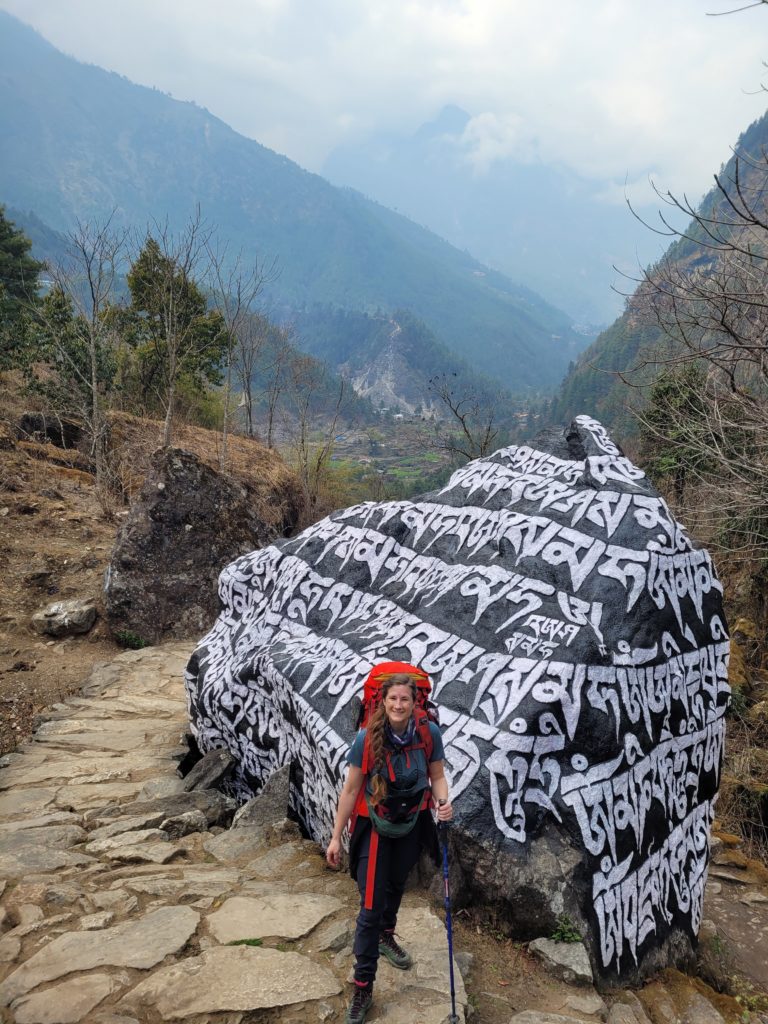
Bevor es an den letzten langen Anstieg hoch nach Namche ging, mussten wir am Eingang in den Sagarmatha National Park (Sagarmatha ist der nepalesische Name für Mount Everest) die Eintrittsgebühr entrichten und uns noch einmal registrieren lassen. Auch hier wieder die skeptische Frage nach unserem Guide, den wir nicht hatten. Aber alles war gut und so konnten wir weiterziehen. Es war an diesem Checkpoint sehr voll und auch die Wege waren nicht leer, aber die meisten würden wohl „nur“ zum Everest Base Camp direkt wandern und wieder auf dem gleichen Weg zurückkommen, weshalb an diesen Stellen so viel „Verkehr“ war.
Die Vegetation veränderte sich auf dem Weg hoch allmählich und die blühenden Büsche wurden von Nadelwäldern ersetzt, die sich an die recht steilen Flanken der Talwände schmiegten. Auf einer der letzten Hängebrücken kam der eisige Wind aus den Bergen mit so einer plötzlichen Wucht auf uns zu, dass Mark seinen Hut verlor und ich ihn über das Rauschen des Flusses und die Geräusche des Windes nicht rufen hörte. So wartete ich verwirrt auf der anderen Seite bis mir ein anderer Wanderer von dem kleinen Unfall erzählte und dann sah ich Mark auch, wie er auf der anderen Uferseite seinem Hut hinterherlief, den er glücklicherweise wiederbekam. Die Wanderung fing pannenreich an, denn wir hatten beide schon jeweils einen Wanderstock eingebüßt und mein Filter war ja auch nicht mehr brauchbar…
Auf dem letzten Anstieg fand ich einen guten Rhythmus aus Hochsteigen und Atmen und so kamen wir schon bald in das terrassenförmig aufgebaute Namche, eine Stadt, die in einem Talkessel an den Hängen der Wände klebt. Ein faszinierender Anblick. Wir hatten eine gute Unterkunft für zwei Tage gebucht, die leider noch einmal 150 m höher am oberen Rand der Stadt lag und ich verzweifelte fast auf den letzten Metern. Mein Körper hatte entschieden, dass er nun angekommen war und wollte nicht noch höher steigen. Aber immerhin würden wir hier die nächsten beiden Nächte verbringen und uns akklimatisieren, also war der erste Aufstieg in die Berge geschafft und ich durfte den schweren Rucksack erleichtert absetzen. Ich belohnte mich mit Hot Chocolate und einer Knoblauchsuppe, da Knoblauch mit der Höhe helfen sollte. Ein nasses, heißes Handtuch für Hände und Gesicht vor dem Essen fühlte sich wie Luxus an nach diesem anstrengenden Wandertag.
To be continued…
-> Teil 2 der Wanderung
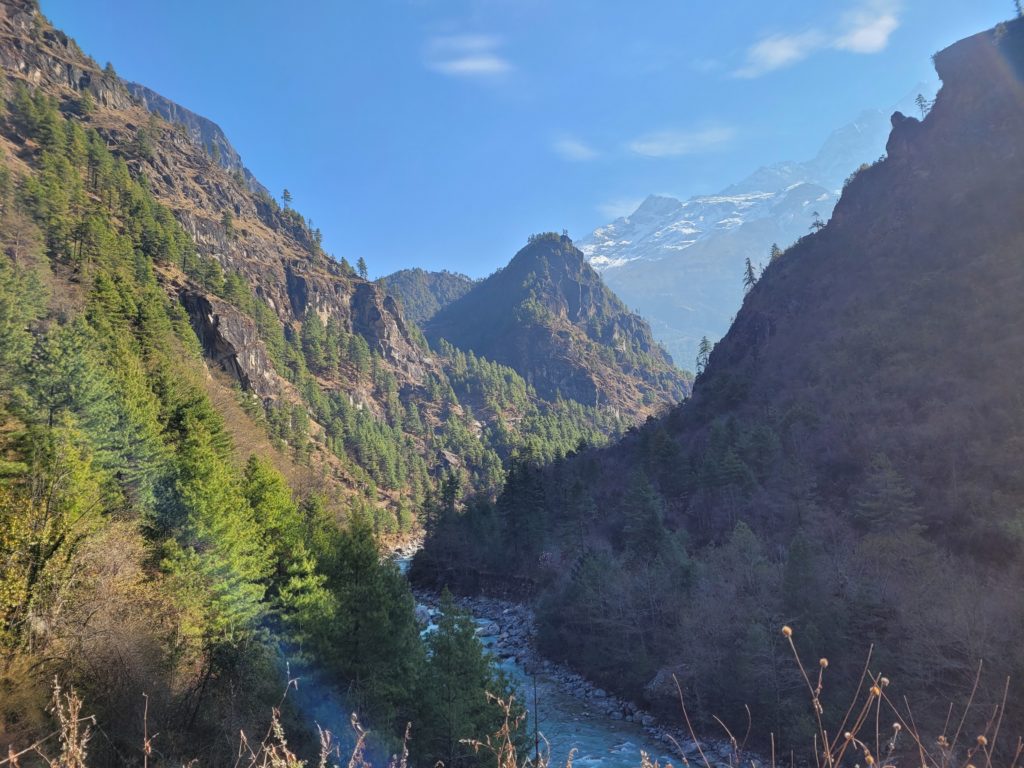
Schreibe einen Kommentar Antworten abbrechen
Deine E-Mail-Adresse wird nicht veröffentlicht. Erforderliche Felder sind mit * markiert
Meinen Namen, E-Mail-Adresse und Website-URL in diesem Browser speichern, bis ich wieder kommentiere.
- Suchen Suchen
01/2024: Wir hoffen ihr habt die Feiertage gut überstanden und seid wunderbar ins Neue Jahr gestartet! Wir haben schon unsere 1. gemeinsame Wanderung hinter uns. 🙂
WIR WÜNSCHEN EUCH EINE TOLLE WANDERSAISON 2024!
09/2023: Wir haben unsere Wanderübersicht überarbeitet und versucht die Seite etwas übersichtlicher zu gestalten – bei fast 150 Artikeln kann man schnell den Überblick verlieren. Viel Spaß beim Stöbern!
06/2023: Unsere 1. Community-Wanderung war ein voller Erfolg!
Meldet euch zu unserem Newsletter an und bleibt auf dem Laufenden!
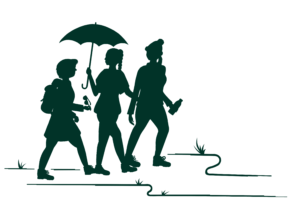
Motivierte Mitwanderer
Lerne unsere Wander Community kennen!
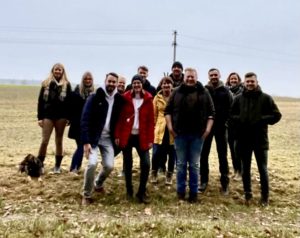
- Werde Gastwanderer
Privacy Overview
Ace the Himalaya
Trekking in Nepal, Peak Climbing, Mt Biking and Tours in Nepal, Bhutan and Tibet
- Everest Base Camp Trek - 14 Days
- EBC Trek with Helicopter Return - 12 Days
- Everest Base Camp Luxury Trek - 14 Days
- Everest Base Camp with Island Peak - 19 Days
Everest Three Passes Trek - 20 Days
- Annapurna Base Camp Trek - 13 Days
- Annapurna Circuit Trek - 19 Days
- Ghorepani Poon Hill Trek - 9 Days
- Manaslu Circuit Trek - 15 Days
- Gokyo to Everest Base Camp Trek - 17 Days

Get the chance to cross the three passes of everest region, the Kongma La Pass, Cho La Pass and Renjo La Pass witnessing the remarkable views of Gokyo valley and Khumbu glaciers.
Three Passes Trek Highlights
- Scenic flight to and from Lukla.
- Step inside and experience life as the “mountain people” live, in the heart of Himalayas.
- Everest Base Camp and walking on the Khumbu glacier.
- Encounter the turquoise water of Gokyo Lake.
- Hike up to Kala Patthar and Gokyo Ri, the astounding viewpoints in the Everest Region.
- Witness the remarkable views of super Gokyo valley, massive Ngozumpa glacier and incredible view of Khumbu Himalayas.
- Visit Tengboche Monastery – one of largest Buddhist Monasteries.
- Wonderful staying Experience in remote region.
- Cross the 3 beautiful high elevation passes- Kongma La Pass, Cho La Pass and Renjo La Pass of Everest Region.
Everest Three Passes Trek Overview
Everest Three Passes Trek presents an exceptional chance to witness gigantic Himalayas over 8,000 m. This includes the highest Mt. Everest, Cho Oyu, Lhotse, Makalu, and the Ngozumpa Glacier– the largest glacier in the Nepal Himalayas.
We get to see the sights of Gokyo valley which has a collection of stoned houses and meadows on the shore of a great lake, Dudh Pokhari. Most importantly, we will cross the three high passes in the Everest Region namely Kongma La Pass, Cho La Pass and Renjo La Pass.
The beautiful view from the Everest three passes trek almost knocks everyone off their knees. However, it is equally challenging. This part of the trek is thus one of the most adventurous yet beautiful experiences the trekkers can have.
To begin our trekking from Lukla Airport , we walk down to the Dudh Koshi River. From here we will stick with the major track to Namche Bazaar, the administrative hub of Everest region.
And the remarkable sight of the Khumbu mountains like Ama Dablam (6,856 m), Thamserku (6,608 m) as well as the immense vistas of Everest will spell-bind you. We will also walk on the messy, risky moraines of Ngozumpa Glacier – the main glacier in Nepal.
The varied scenery of the Gokyo Valley including the series of beautiful Gokyo Lakes is enchanting. We will get to observe the first lake Longpongo situated at a height of 4,690 m.
Subsequently, the second lake, Taboche Tsho totally enthralls us with its shiny turquoise blue water alluring in the sun. The Gokyo village set by the third lake and Cho-Oyu peak as a backdrop provides a wonderful sight here.
Short Itinerary
Arrival at Tribhuvan International Airport in Kathmandu (1,400 m) and transfer to hotel. Overnight at a hotel.
Fly to Lukla (2,840 m) from Kathmandu – 35 minutes or drive to Manthali/Ramechhap – 5 to 6 hours and a – 20 minutes flight to Lukla, and then trek to Phakding (2,610 m) – 3 to 4 hours. Overnight at a guesthouse.
Trek to Namche Bazaar (3,440 m) from Phakding – 5 to 6 hours. Overnight at a guesthouse.
Acclimatization Day at Namche Bazaar. Hike to Hotel Everest View (3,880 m) and back – 4 to 5 hours. Overnight at a guesthouse.
Trek to Tengboche (3,860 m) from Namche Bazaar – 5 to 6 hours. Overnight at a guesthouse.
Trek to Dingboche (4,410 m) from Tengboche – 5 to 6 hours. Overnight at a guesthouse.
Acclimatization Day at Dingboche. Hike to Nangkartsang Peak (5,083 m) and back – 4 to 5 hours. Overnight at a guesthouse.
Trek to Chhukung (4,730 m) from Dingboche – 4 to 5 hours. Overnight at a guesthouse.
Trek to Lobuche (4,910 m) via Cross Kongma La pass (5,535 m) – 7 to 8 hours. Overnight at a guesthouse.
Trek to Everest Base Camp (5,364 m) and then back to Gorak Shep (5,164 m) – 8 to 9 hours. Overnight at a guesthouse.
Early morning hike to Kala Patthar (5,555 m) and then, descend to Lobuche (4,910 m) – 8 to 9 hours. Overnight at a guesthouse.
Trek to Dzongla (4,830 m) from Lobuche – 4 to 5 hours. Overnight at a guesthouse.
Trek to Gokyo (4,800 m) from Dzongla via Crossing Cho La Pass (5,368 m) – 8 to 9 hours. Overnight at a guesthouse.
Climb Gokyo Ri (5,483 m) and return back to Gokyo – 3 to 4 hours. Overnight at a guesthouse.
Trek to Lunden (4,300 m) via Crossing Renjo La Pass (5,340 m) – 7 to 8 hours. Overnight at a guesthouse.
Trek to Thame (3,800 m) from Lunden – 4 to 5 hours. Overnight at a Guesthouse.
Trek to Namche Bazar (3,440 m) from Thame – 4 to 5 hours. Overnight at a guesthouse.
Trek to Lukla (2,840 m) from Namche Bazaar – 6 to 7 hours. Overnight at a guesthouse.
Fly to Kathmandu – 35 minutes or Manthali/Ramechhap – 20 minutes from Lukla (2,840 m) and same-day drive to Kathmandu – 5 to 6 hours. Overnight at a hotel.
Transfer to the International Airport for Your Final Departure.
Our standard itinerary might differ slightly due to unpredictable happenings and events out of our control. Factors such as flight cancellation/delay, unfavorable weather, natural calamities, newly implemented government rules, political affairs, trekkers’ health condition, etc., are possible. Evaluating the situation’s possible solutions allow the trekking to resume as much as possible based on the best alternatives. In these times, we look for your cooperation and flexibility.
It is advised you arrive a day before the trip start date so you can rest and it also gives you time to buy clothing equipment and gear required for the trek. Also, it is best if you book your international flights with spare days in Nepal before and after your trek in case of any flight delays or cancellations due to weather. Moreover, you have options to customize this trip where you can add on a sightseeing tour in Kathmandu, other adventure sports or day trips around the country before or after the trek.
Lukla flight information
We would like to inform you regarding the Lukla flight details which may affect your itinerary. During peak seasons, (including March, April, May, October and November) the flight to Lukla will be operated from Ramechhap/Manthali due to air traffic expansion, which is about a 5 to 6-hour drive from Kathmandu. Whereas, during nonpeak seasons, (including January, February, June, July, August, September and December) the flight is operated from Kathmandu.
Please be aware that the decision regarding the operation of flights solely depends on the airline and is influenced by the volume of travelers during the specific month.
Unpleasant weather conditions, congested traffic in the Airport, unmanaged runway, topographical difficulties, etc., are the significant reasons for Lukla flight delay/cancellation. Therefore, if you intend on trekking in the land of Everest region, arranging additional one or two days in your trip is highly preferable. This will help in case of flight delay/cancellation and thus board on the pre-planned international flight.
Departures & Availability
Our groups are small with maximum 14 people. We create groups of independent travelers, friends and families which maintains close interpersonal connection, engage more and get into depth of the journey. Choose a date from the calendar to reserve your spot.
Looking for personalized experience? We organize privately guided journey which is mainly designed to fit your taste and interest. Please fill out the form below to get started.
Departure Date
- Lead Traveler's Full Name *
- No. of Travellers * No. of Travellers 1 2 3 4 5 6 7 8 9 10 11 12 13 14 15 16 17 18 19 20 20+
- Country Country Afghanistan Albania Algeria American Samoa Andorra Angola Antigua and Barbuda Argentina Armenia Australia Austria Azerbaijan Bahamas Bahrain Bangladesh Barbados Belarus Belgium Belize Benin Bermuda Bhutan Bolivia Bosnia and Herzegovina Botswana Brazil Brunei Bulgaria Burkina Faso Burundi Cambodia Cameroon Canada Cape Verde Cayman Islands Central African Republic Chad Chile China Colombia Comoros Congo, Democratic Republic of the Congo, Republic of the Costa Rica Côte d'Ivoire Croatia Cuba Cyprus Czech Republic Denmark Djibouti Dominica Dominican Republic East Timor Ecuador Egypt El Salvador Equatorial Guinea Eritrea Estonia Ethiopia Faroe Islands Fiji Finland France French Polynesia Gabon Gambia Georgia Germany Ghana Greece Greenland Grenada Guam Guatemala Guinea Guinea-Bissau Guyana Haiti Honduras Hong Kong Hungary Iceland India Indonesia Iran Iraq Ireland Israel Italy Jamaica Japan Jordan Kazakhstan Kenya Kiribati North Korea South Korea Kosovo Kuwait Kyrgyzstan Laos Latvia Lebanon Lesotho Liberia Libya Liechtenstein Lithuania Luxembourg Macedonia Madagascar Malawi Malaysia Maldives Mali Malta Marshall Islands Mauritania Mauritius Mexico Micronesia Moldova Monaco Mongolia Montenegro Morocco Mozambique Myanmar Namibia Nauru Nepal Netherlands New Zealand Nicaragua Niger Nigeria Northern Mariana Islands Norway Oman Pakistan Palau Palestine, State of Panama Papua New Guinea Paraguay Peru Philippines Poland Portugal Puerto Rico Qatar Romania Russia Rwanda Saint Kitts and Nevis Saint Lucia Saint Vincent and the Grenadines Samoa San Marino Sao Tome and Principe Saudi Arabia Senegal Serbia Seychelles Sierra Leone Singapore Sint Maarten Slovakia Slovenia Solomon Islands Somalia South Africa Spain Sri Lanka Sudan Sudan, South Suriname Swaziland Sweden Switzerland Syria Taiwan Tajikistan Tanzania Thailand Togo Tonga Trinidad and Tobago Tunisia Turkey Turkmenistan Tuvalu Uganda Ukraine United Arab Emirates United Kingdom United States Uruguay Uzbekistan Vanuatu Vatican City Venezuela Vietnam Virgin Islands, British Virgin Islands, U.S. Yemen Zambia Zimbabwe
- How did you find Ace the Himalaya? * How did you find Ace the Himalaya? Google Search Yahoo Other Search Engine Facebook Twitter Newsletter Ace Blog I m a Previous Client Friend Recommendation Lonely planet Trip Advisor Magazine Advertisement Brochures/flyers I met you in Trade shows I am your Trade partners From North American Representative From European Representative From Australian Representative The Clymb Groupon Travel Zoo Scoupon From Other Deal Sites Others
- I agree to Ace the Himalaya Terms and Conditions
- Prove your humanity : eight − 4 =
- Comments This field is for validation purposes and should be left unchanged.
Price Includes
- All (international and domestic) airport transfers on a tourist vehicle
Standard twin-sharing/double accommodation in a 3-star hotel for 2 nights in Kathmandu including breakfast (Private room accommodation can be organized at an extra cost)
Twin-sharing guesthouse accommodation during the trek for 17 nights in the Everest region with attached toilets in Lukla, Phakding & Namche
- All your standard meals during the trek (Breakfast, Lunch, and Dinner) including one hot drink and seasonal fruits
- Experienced, first-aid trained, government licensed, English-speaking Ace the Himalaya's trekking guide
- Permits for Sagarmatha/Everest National Park and TIMS (Trekkers' Information Management System)
- Porters during the trek for carrying luggage (1 porter for every 2 clients)
- Wages, accommodation, meals, gear, insurance, and medications for all staff
- Filtered water in the trails using Water Filter or using water purification tablets
- Round-trip airfare between Kathmandu/Manthali and Lukla
- 1 Ace the Himalaya’s duffel/kit bag, trekking map, sun hat, Buff (Neck Gaiter) and trip completion certificate
- A farewell dinner on the last night in Nepal
- All administrative expenses and government taxes
Price Excludes
- Meals (lunch and dinner) in Kathmandu
- International flight fare and airport departure tax
- Any beverages including bottled and boiled water
- Travel insurance along with high-altitude emergency evacuation coverage
- Tips to trekking staff and driver
- Nepal Entry Visa (Visa can be acquired easily after your arrival at Tribhuvan International Airport in Kathmandu with a fee of USD 50 for 30 days visa and USD 125 for 90 days visa)
- Personal Trekking gear and equipment
- Any expenses other than the Price Include section
Everest Three Passes Trek Itinerary
Day 01: arrival at tribhuvan international airport in kathmandu and transfer to hotel.
One of our officials will greet you at the Tribhuvan International Airport, Kathmandu, upon your arrival. We will take you to the hotel in our private tourist vehicle. Pre-trip meeting will be done and you will meet with your trip guide. Make sure to confirm your queries about trekking in the mountains.
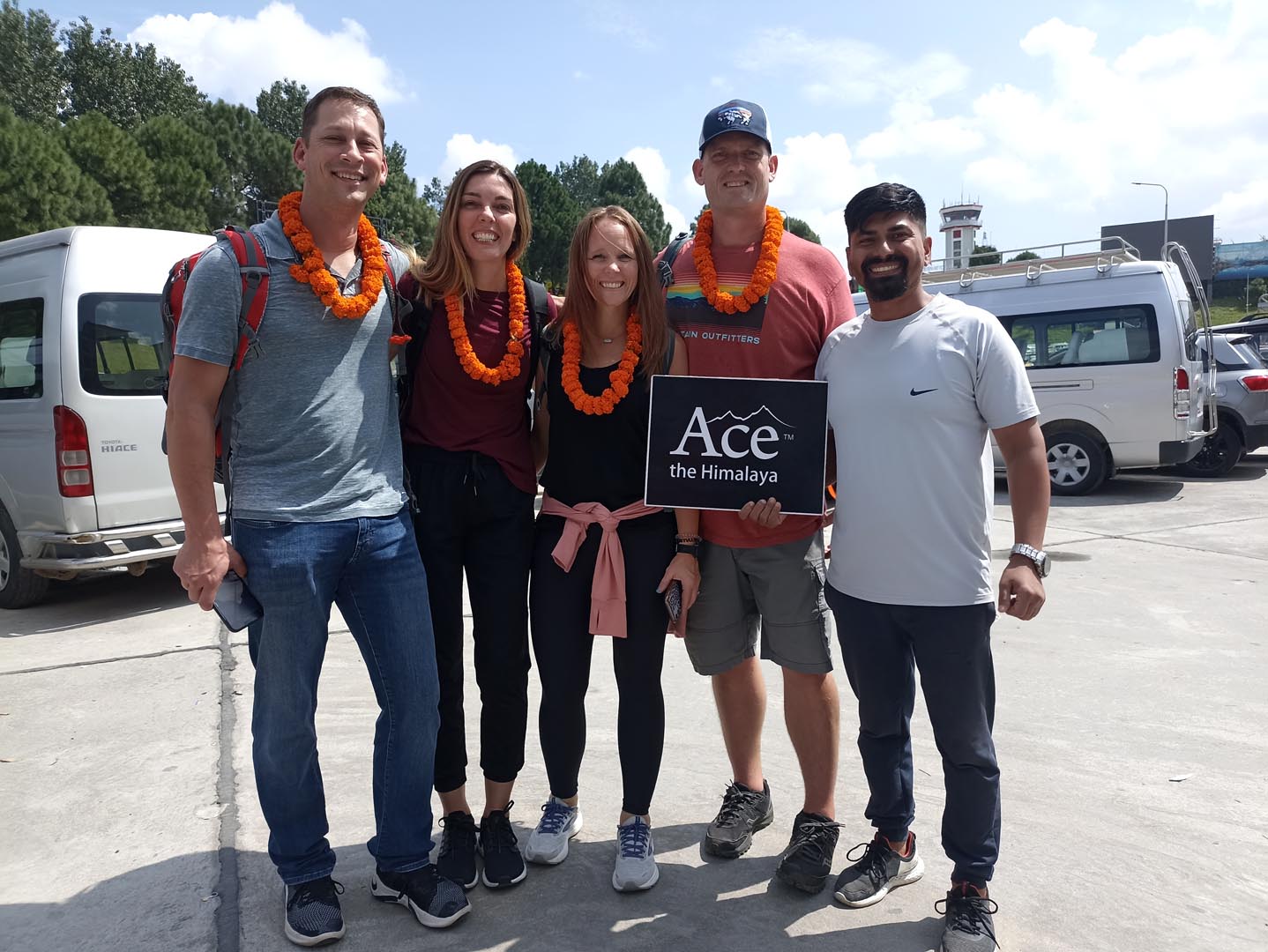
Note : Pre-trip meeting will be done at the office if you arrive before 4 pm and in your hotel itself if you arrive later in the evening. Be sure to bring two copies of passport-sized photos and a readable copy of your travel insurance policy to the meeting. These documents help to acquire trekking permits and related documentation during the trek. Pay the remaining balance of your invoice and sign in the legally binding trip form and non-liability disclaimer.
Day 02: Fly to Lukla from Kathmandu or drive to Manthali (Ramechhap) & flight to Lukla and then, trek to Phakding
Manthali to Lukla Flight (March, April, May, October, and November) During peak seasons, such as March, April, May, October, and November, the flight to Lukla will be operated from Ramechhap/Manthali due to air traffic expansion. The Manthali/Ramechhap airport is about a 5 to 6 hours drive away from Kathmandu. On this day we wake up at 1:30 to 2:30 am and take an escorted shuttle to Manthali airport on a shared tourist vehicle and board a 20-minute flight to Lukla.
Kathmandu to Lukla Flight (January, February, June, July, August, September, and December) The flight to Lukla is typically operated from Kathmandu during nonpeak seasons, which include January, February, June, July, August, September, and December . Please be aware that the decision regarding the operation of flights solely depends on the airline and is influenced by the volume of travelers during a specific month. On this day we wake up at 5 to 6 am. Our staff will escort you to the domestic airport terminal in Kathmandu and board a 35-minute flight to Lukla.
Helicopter Option
You have the option to book a direct helicopter flight from Kathmandu to Lukla for an extra charge of USD 550 per person. This price is quoted on a 5-people sharing basis. This is the best alternative to avoid the long drive to Manthali airport during peak season (March, April, May, October, and November).
Flight to Tenzing-Hillary Airport usually takes place early in the morning. We suggest you make all the sorting and packing the day before, so there is no rush on Day 2. Once you reach Lukla, have your breakfast while our guide will make an arrangement for porters. We assign one porter to every two clients. Begin the trek by descending towards the Dudh Kosi River where you join the main trail to Namche Bazaar, located just above Chaunikharka (2,713 m/8,900 ft). The walking is easy and after passing through the small village of Ghat (2,550 m/8,366 ft), it is a short walk to Phakding.
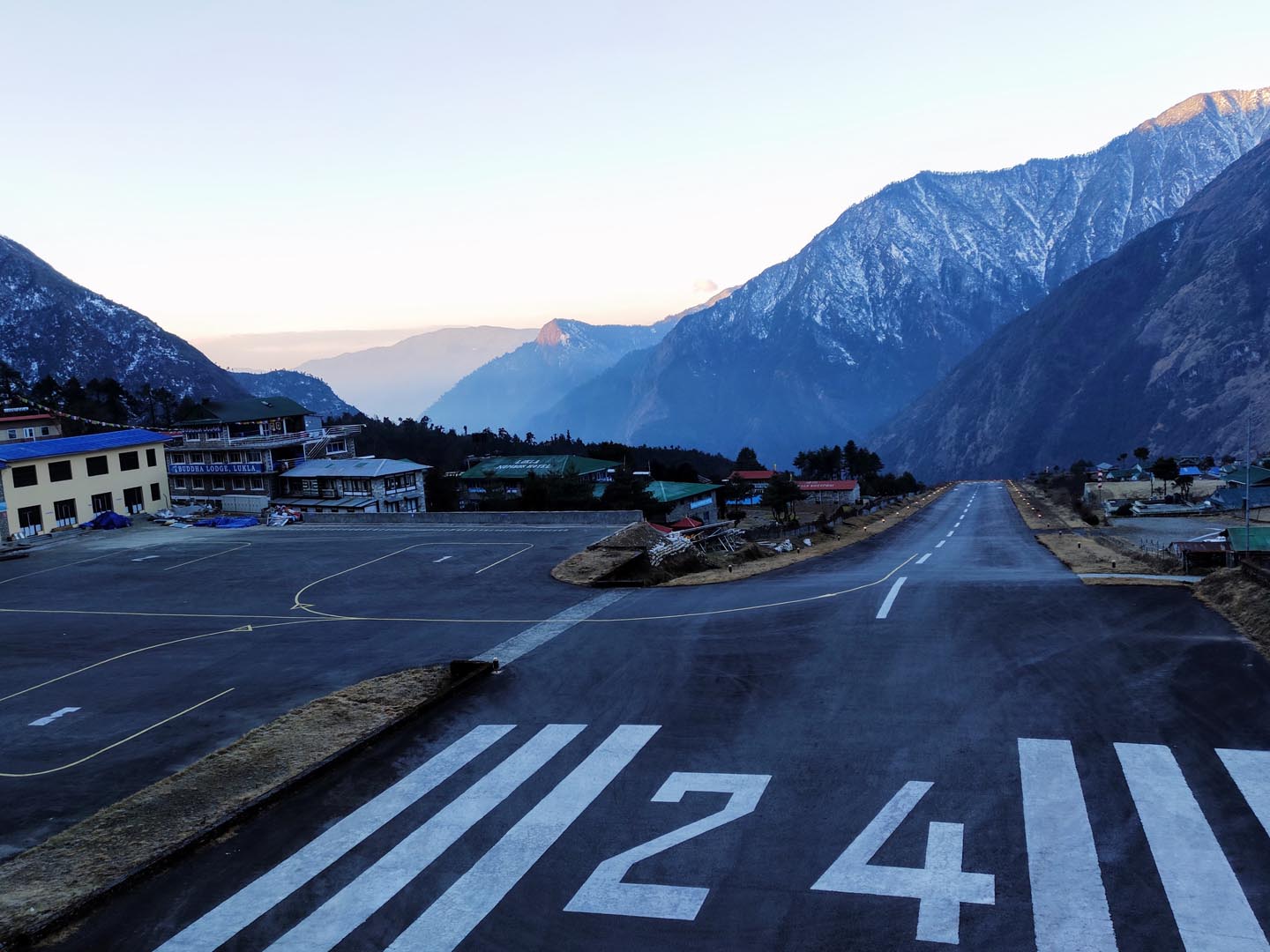
Day 03: Trek to Namche Bazaar from Phakding
There are many suspension bridges laden with prayer flag where Dudh Koshi River is following our way up to Namche Bazaar. Namche Bazaar is the main trading center in Khumbu region.
It is also known as Gateway to Everest. There are many good facility hotels and restaurant along with proper pubs and cyber cafés.
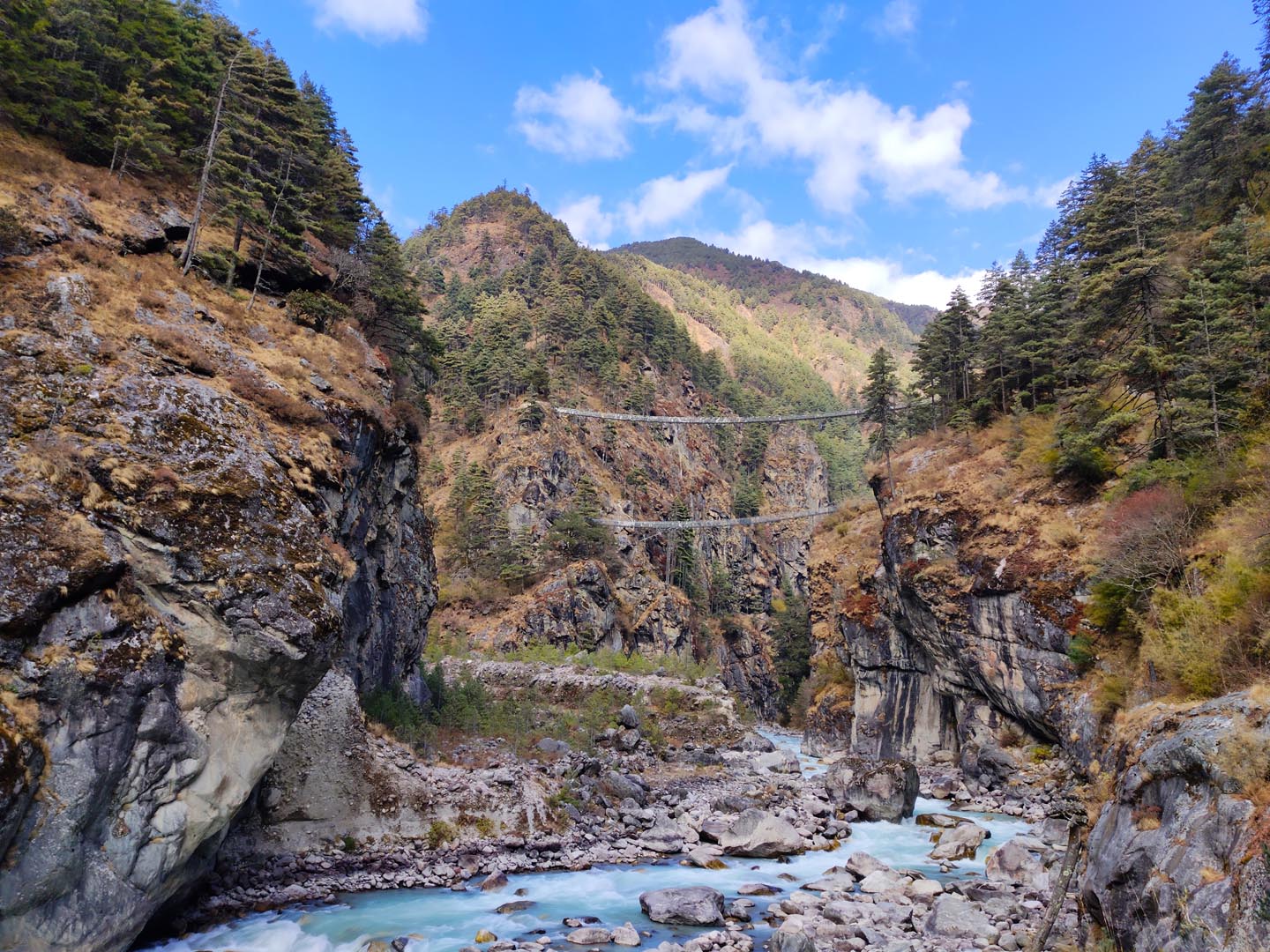
Day 04: Acclimatization Day at Namche Bazaar. Hike to Hotel Everest View and back
We will spend a day in Namche Bazaar in order to acclimatize and adjust to the thinning air. We will trek a short distance to a museum that is celebrated for its exhibits of the traditional customs of the Sherpa people.
We will also hike up the Syangboche Airport and the Everest View Hotel, one of the highest-placed hotels in the world. From this point, we can see rewarding views of the Himalayas including Mt Everest.
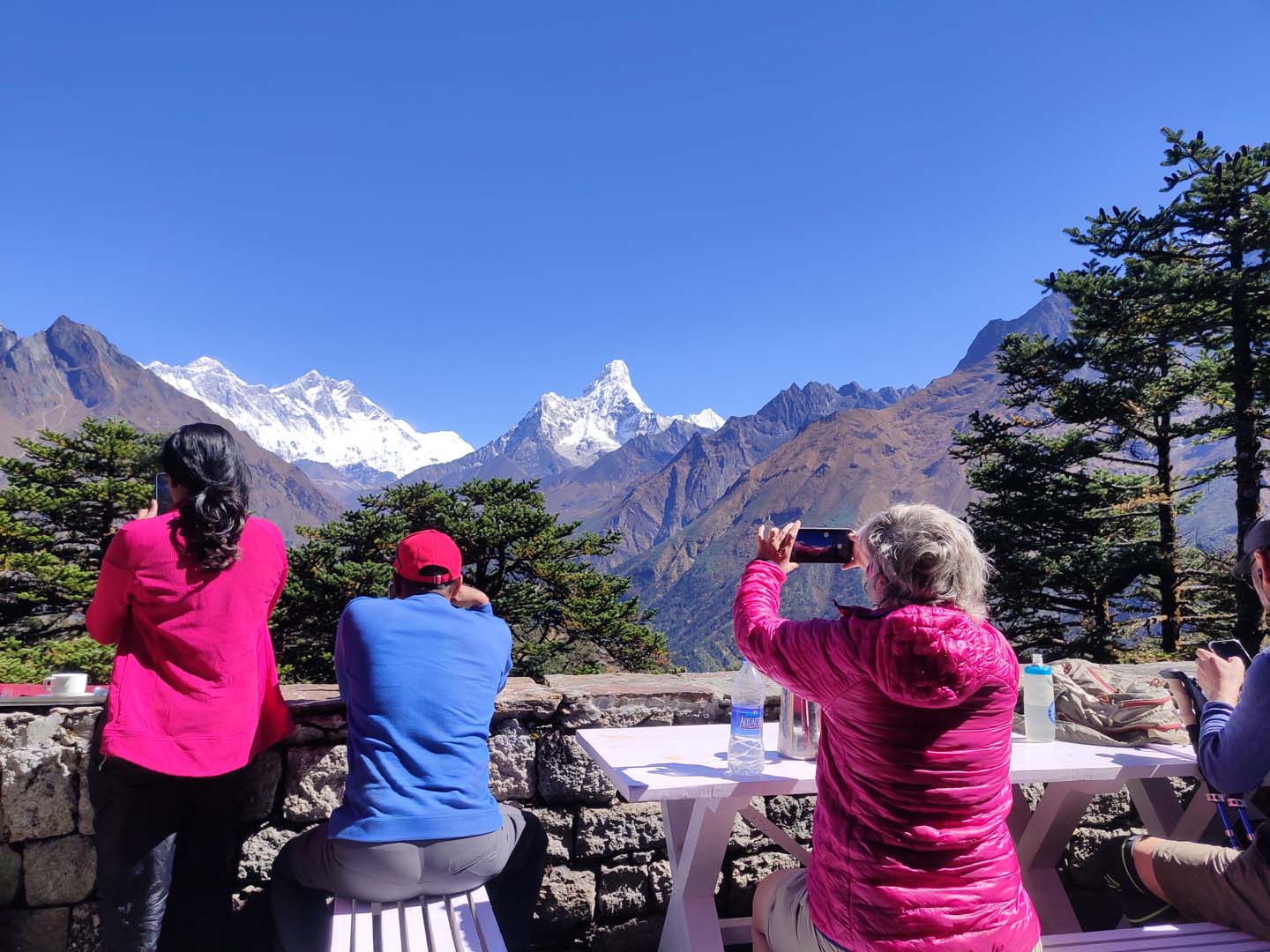
Day 05: Trek to Tengboche from Namche Bazaar
The views of Khumbi La and Taboche are magnificent throughout the day. We should dress warmly because cold wind blows throughout the trail. In the middle of the trek, there are two trails which divides into lower and upper trail. To continue our journey, we take left.
In Phorste Thanga there are few houses and lodges. After some hours of walking we reach our today’s destination Tengboche. It is inhabited by Sherpa’s where their main source of income comes from tourism.
There is an important and largest Buddhist Monastery, Tengboche Monastery where Ama Dablan lies behind.
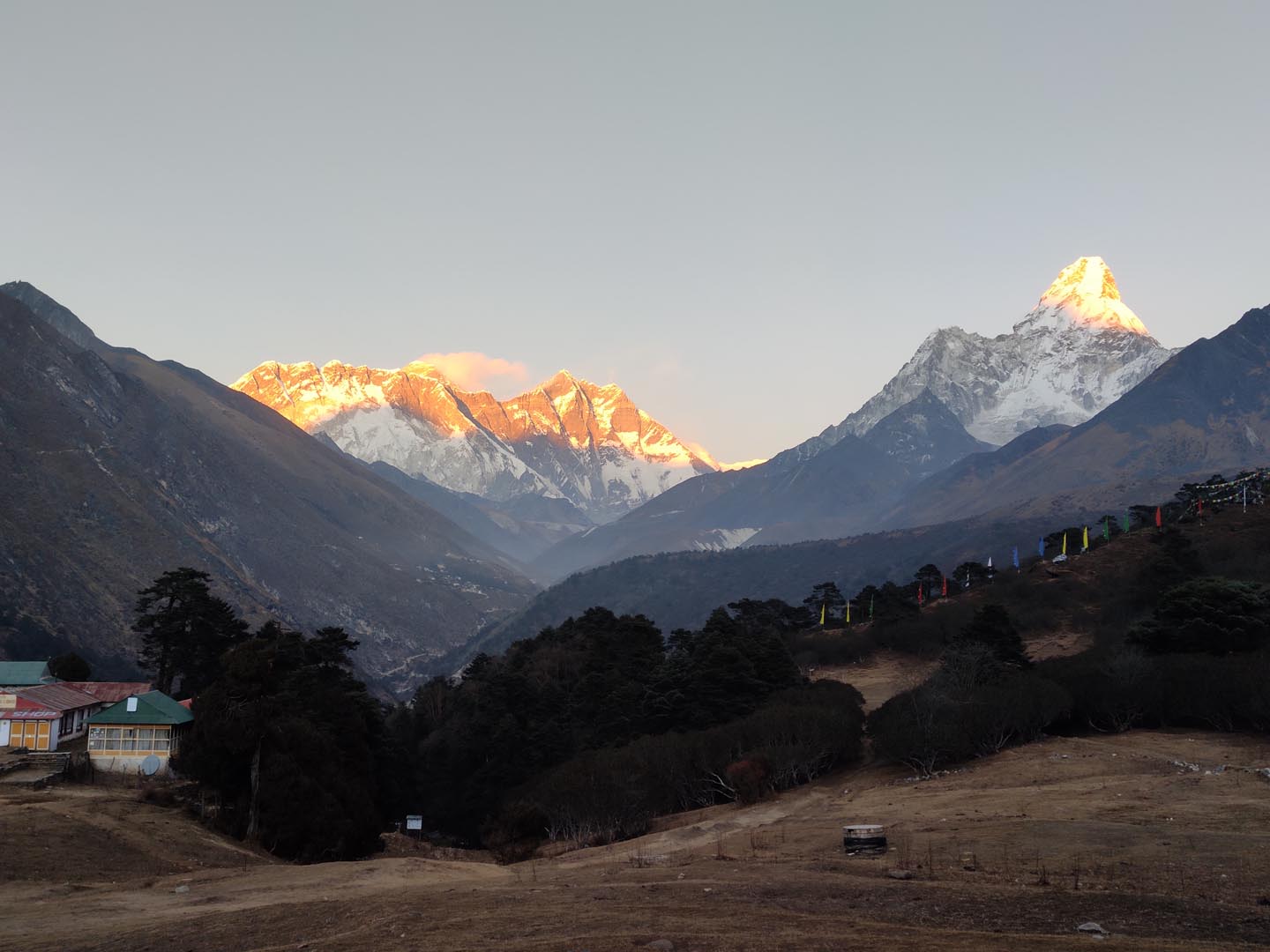
Day 06: Trek to Dingboche from Tengboche
After breakfast we start our trek towards Dingboche. Today’s trek covers 9.1Km and its easy trail with going downhill on a fairly wide path covered with beautiful rhododendron trees.
After few hours of walk and crossing bridge over Imja River, it takes us to Pangboche. In the whole trek, we can see wide open areas where trekkers can view more beautiful landscapes.
Walking trail above Pangboche, we get a magnificent view of Himalayas and Pangboche Monastery. We move ahead towards the Imja valley and finally we reach Dingboche.
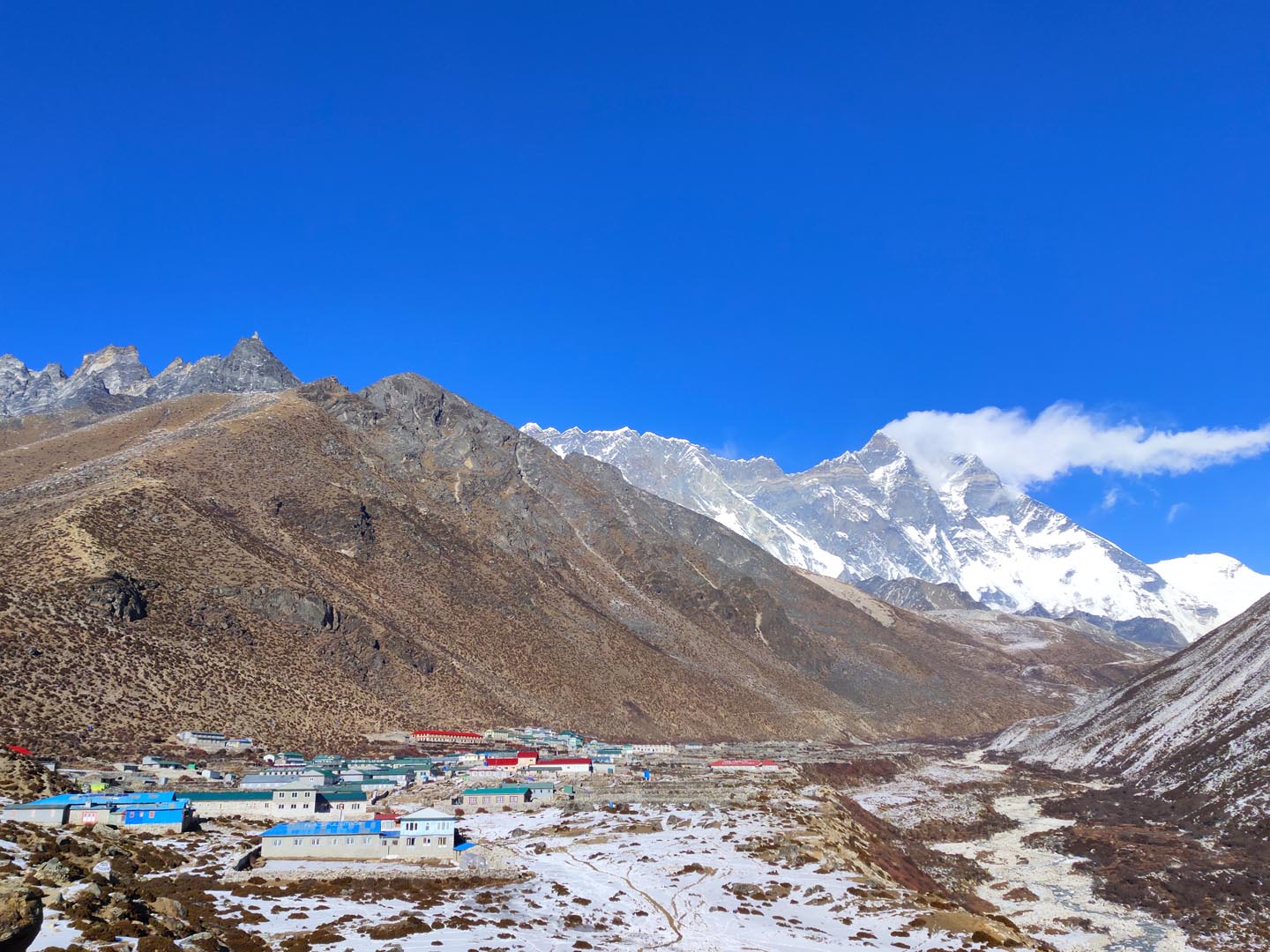
Day 07: Acclimatization Day at Dingboche. Hike to Nangkartsang Peak and back
Dingboche is a popular stop for trekkers and climbers headed to Mt. Everest, Ama Dablam and Imja Tse. It is a Sherpa village. According to the 2011 census, its population was around 200. There is also a helicopter landing pad with internet café (using satellite technology) and one of the world’s highest billiard parlors.
One can see great view of many Himalayas from Nagarjung Hill which may take some hour of hike from Dingboche.
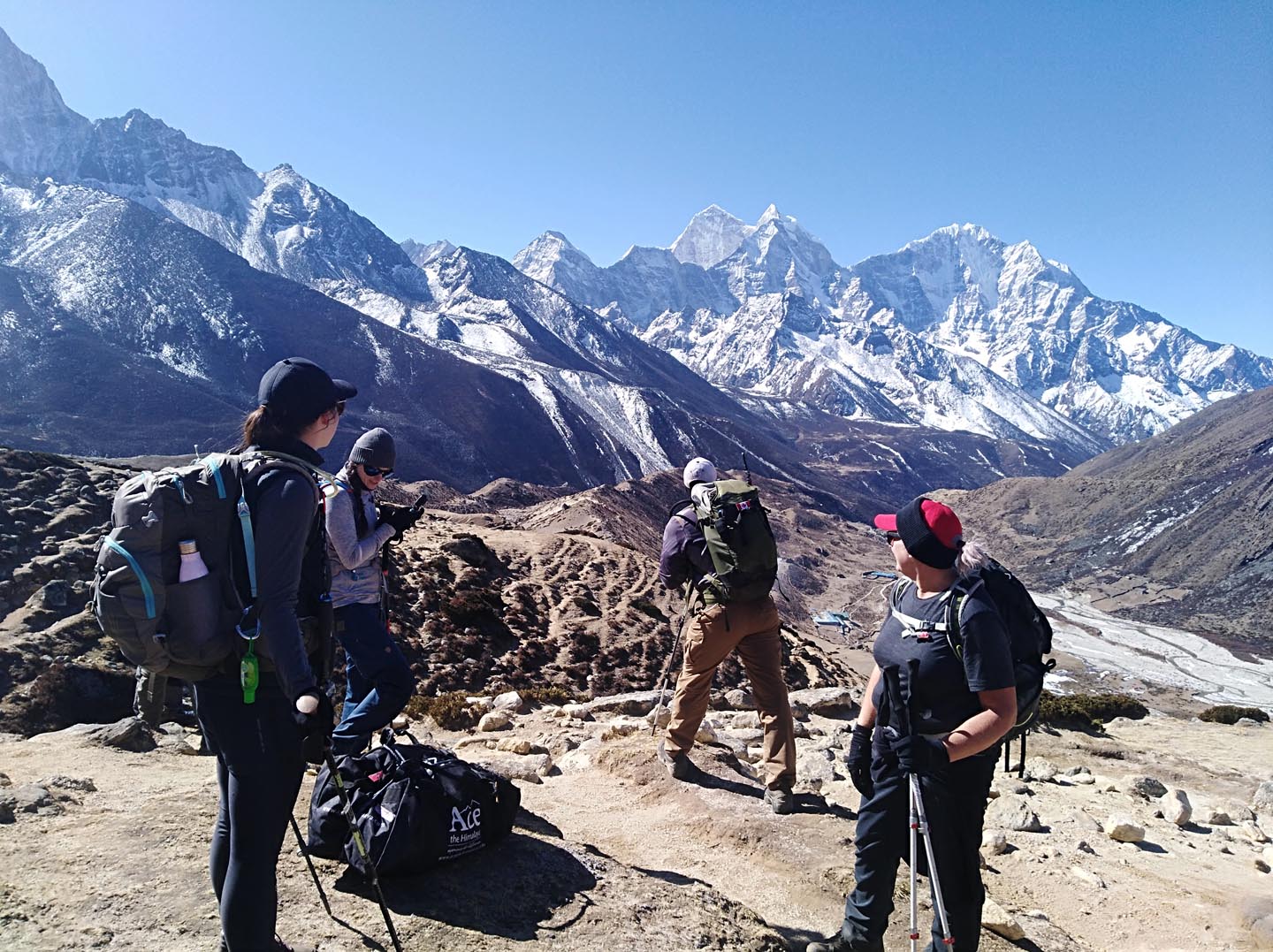
Day 08: Trek to Chhukung from Dingboche
Today, the trail is combined with some uphill and downhill climbs. After breakfast in Dingboche, we move towards Chhukung and have our lunch over there. As our last destination is Chhukung for the day you can slowly and steadily walk on the trails.
Along the trail, you can see several traditional farms and fences built from local stones. And then pass through Imja Khola valley, Bibre (which is a yak herdsman place). After half an 4 to 5 hours of walking, we reach to Chhukung where we will have lunch and stay overnight.
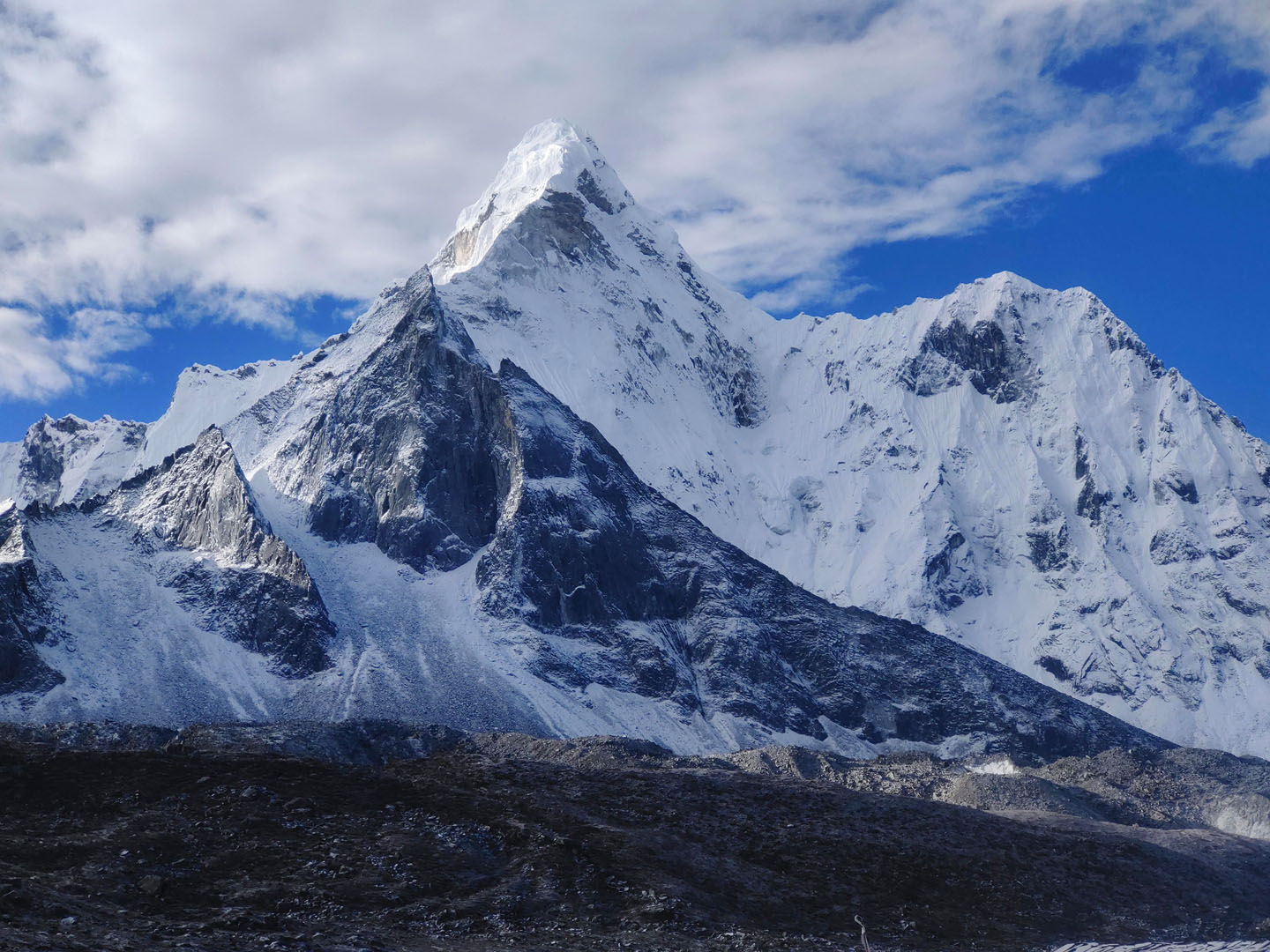
Day 09: Trek to Lobuche via Crossing Kongma La Pass
Today we climb for about 8-9 hours to reach the top of Kongma La pass. There are two trails for Kongma La pass; one is to the northwest of Chhukung over the Nuptse Glacier moraines and another one is back to Bibre and trek on the trail above the Niyang Khola.
As there aren’t any hotels, shops and tea houses, we carry our own packed foods and water. At the top of Kongma La pass, we can see beautiful Buddhist prayer flags. By turning north of Khumbu Glacier, we reach Lobuche.
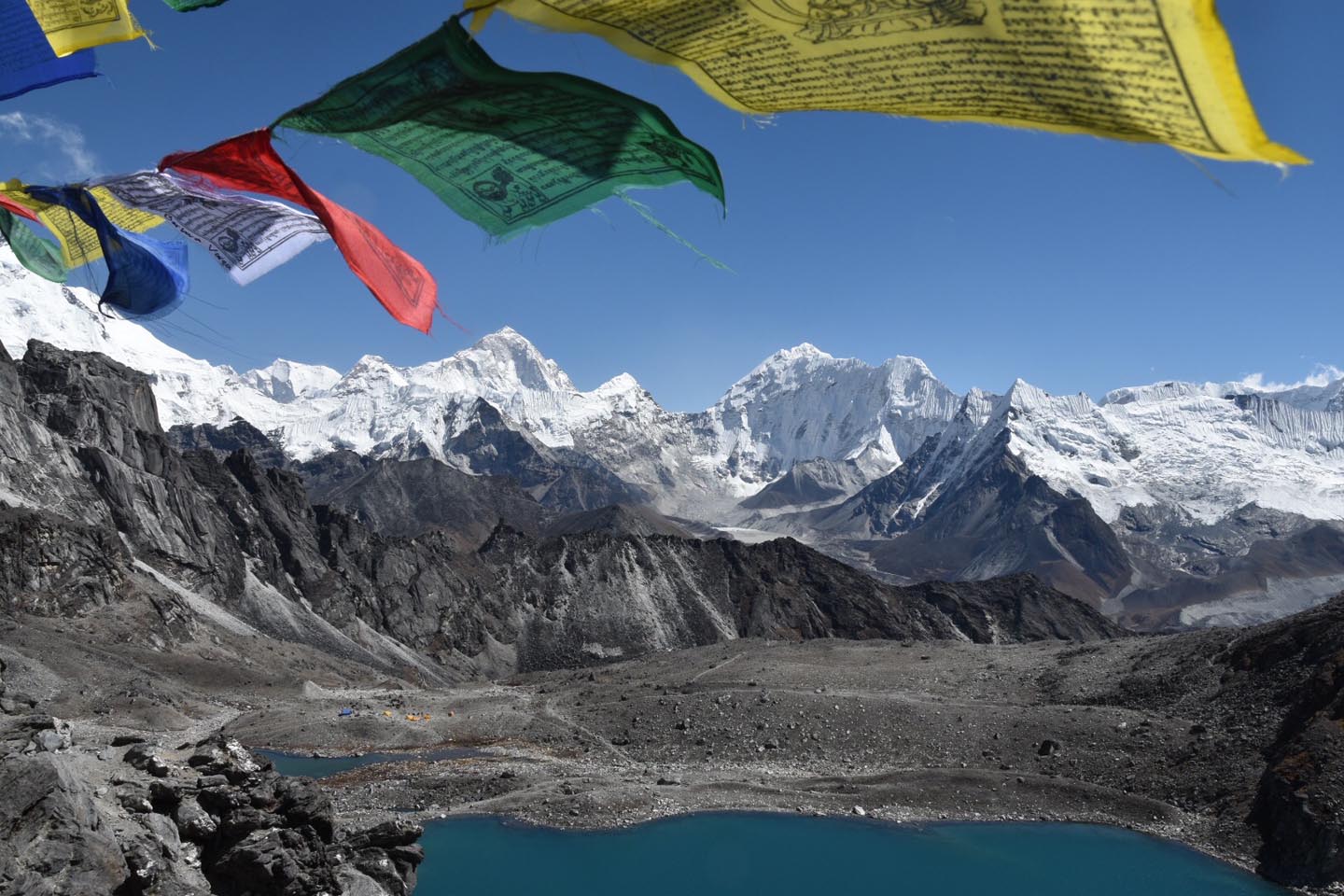
Day 10: Trek to Everest Base Camp and then back to Gorak Shep
Today the trail is of average level up to Gorak Shep. Before heading off to Everest Base Camp, we take lunch and rest at Gorak Shep which takes around 2 hours.
If the weather is good, we will be able to see beautiful Himalaya’s all-round. Then we head towards Everest Base Camp. Everest Base Camp is the closest you can get to Mt. Everest without mountaineering equipment and also highest altitude that most will reach without a climbing permit.
The view of the Khumbu Icefall from Base Camp is spectacular. The earthquake which occurred on 25 th April 2015 caused some damage on the route of the Everest Base Camp. We return back to Gorak Shep for the night.
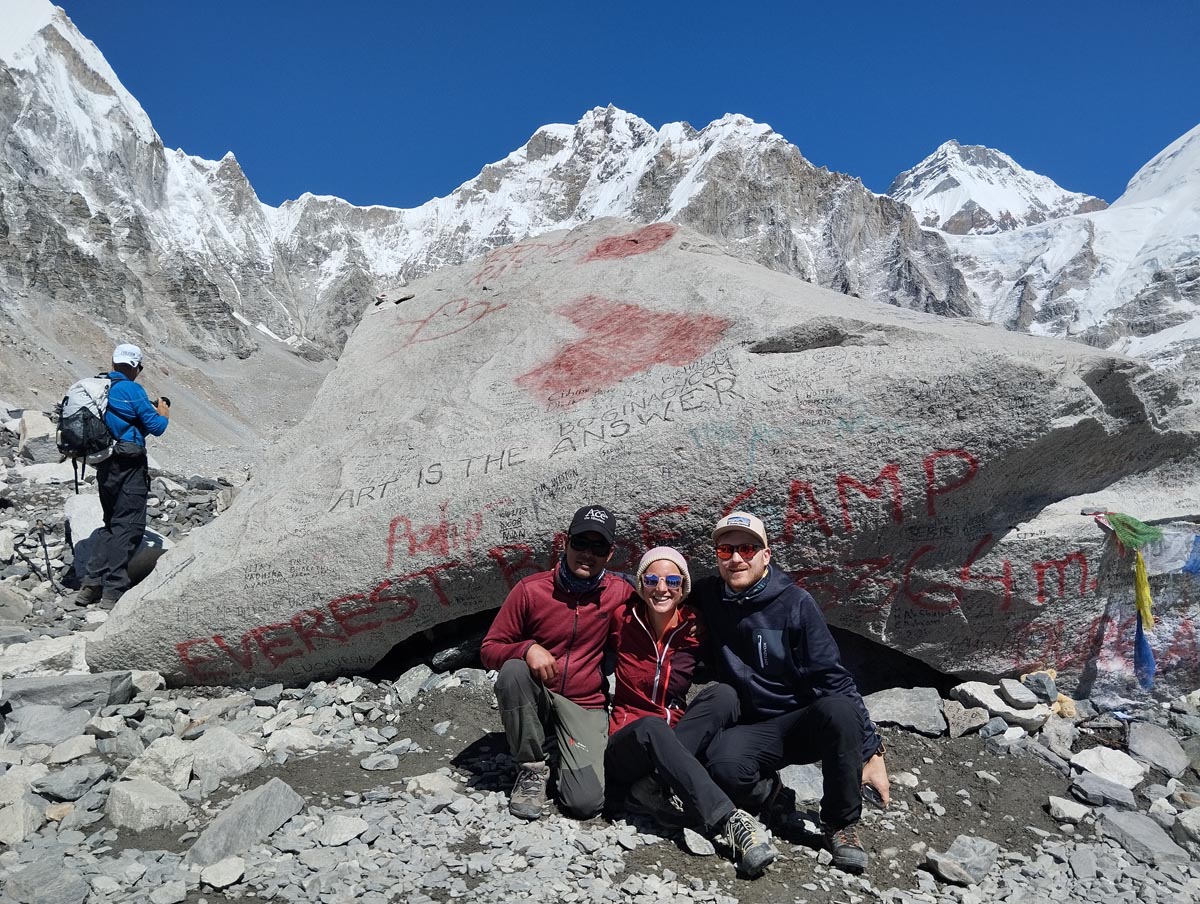
Day 11: Early morning hike to Kala Patthar and then, descend to Lobuche
This will be one of the most difficult yet rewarding days of the trek. Most of this day is spent climbing Mt. Kala Patthar at 5,555 m. From Mt. Kala Patthar one can see the superlative views of Everest.
After spending some time in Kala Patthar we move downwards toward Lobuche. It is a small village surrounded by the Rocky Mountains and the Himalayas. There is a mostly old ancient types of lodges but in recent years more facilitated lodges have been opened where some of them provide internet as well as oxygen serves.
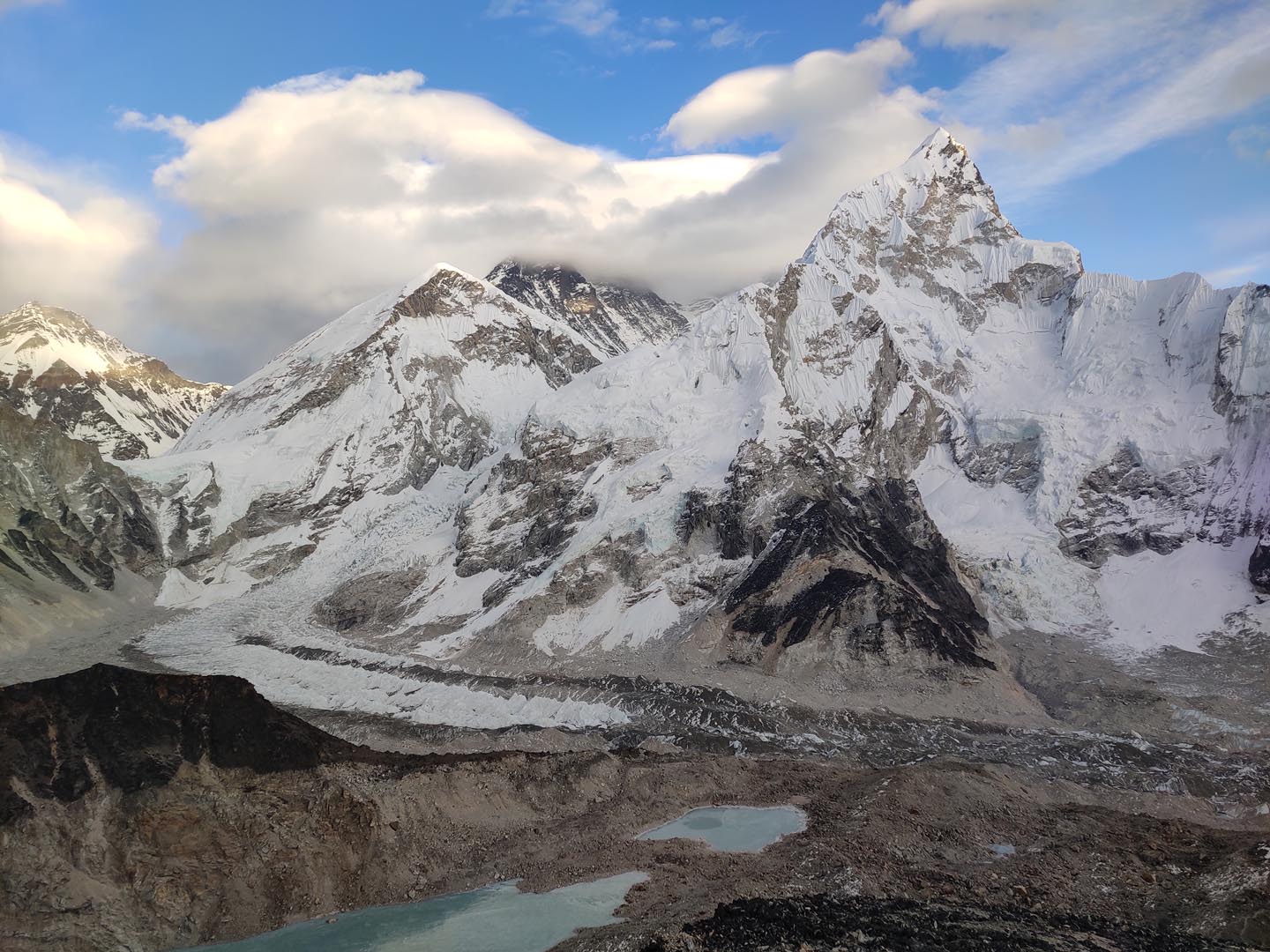
Day 12: Trek to Dzongla from Lobuche
From Lobuche we start to walk downwards where after few hours, trail divides into two and we take right side for Dzongla. We can see stupa and tombstones in the distance. After that we trek upwards where we can see Chola Tsho Lake nearby. We continue to trek by crossing Chola Khola on a bridge before reaching Dzongla.
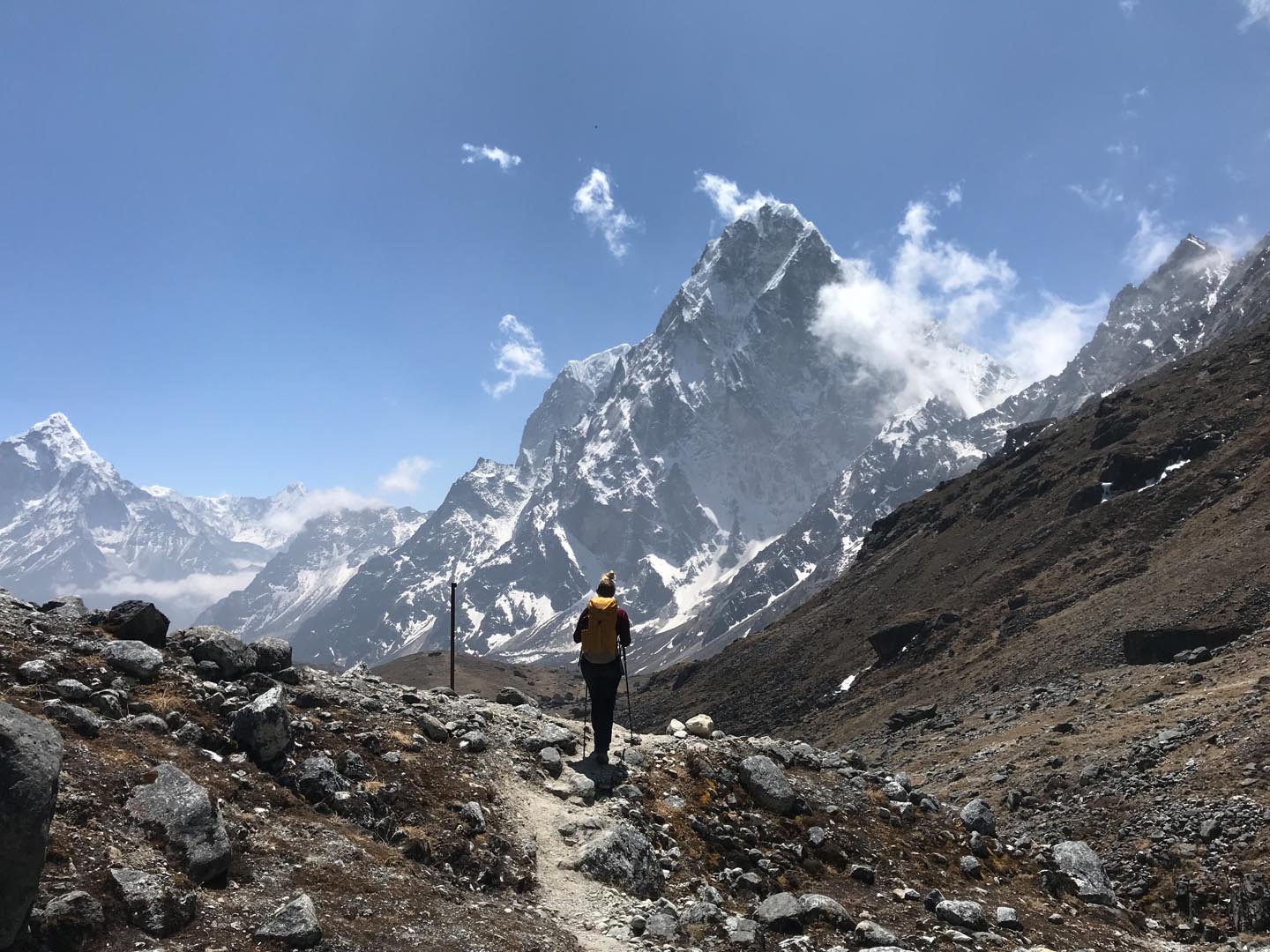
Day 13: Trek to Gokyo from Dzongla via Crossing Cho La Pass
Today we have to start our trek before 4-5 am so we can cross Cho La pass before mid-day and re-assess the hike when the weather turns bad. Today the route maybe little difficult due to high altitude and steeply loose rock.
Snow may cause some problem while crossing Cho La pass and rock fall can also be the problem although weather is good. As a result you can see magnificent view from the top of Cho La Pass then we will descend to our destination, Gokyo (4,800 m).
We have to cross Khara, Pangka, and Ngozumpa glacier (which is the longest glacier in Nepal). We can see the beautiful view of Kantaga and big Mountain Cho-oyu. There are series of six lakes where third one is the Gokyo Lake.
There is a small village near the Gokyo Lake where we will stay 2 nights as we will have sightseeing and hiking trip around Gokyo.
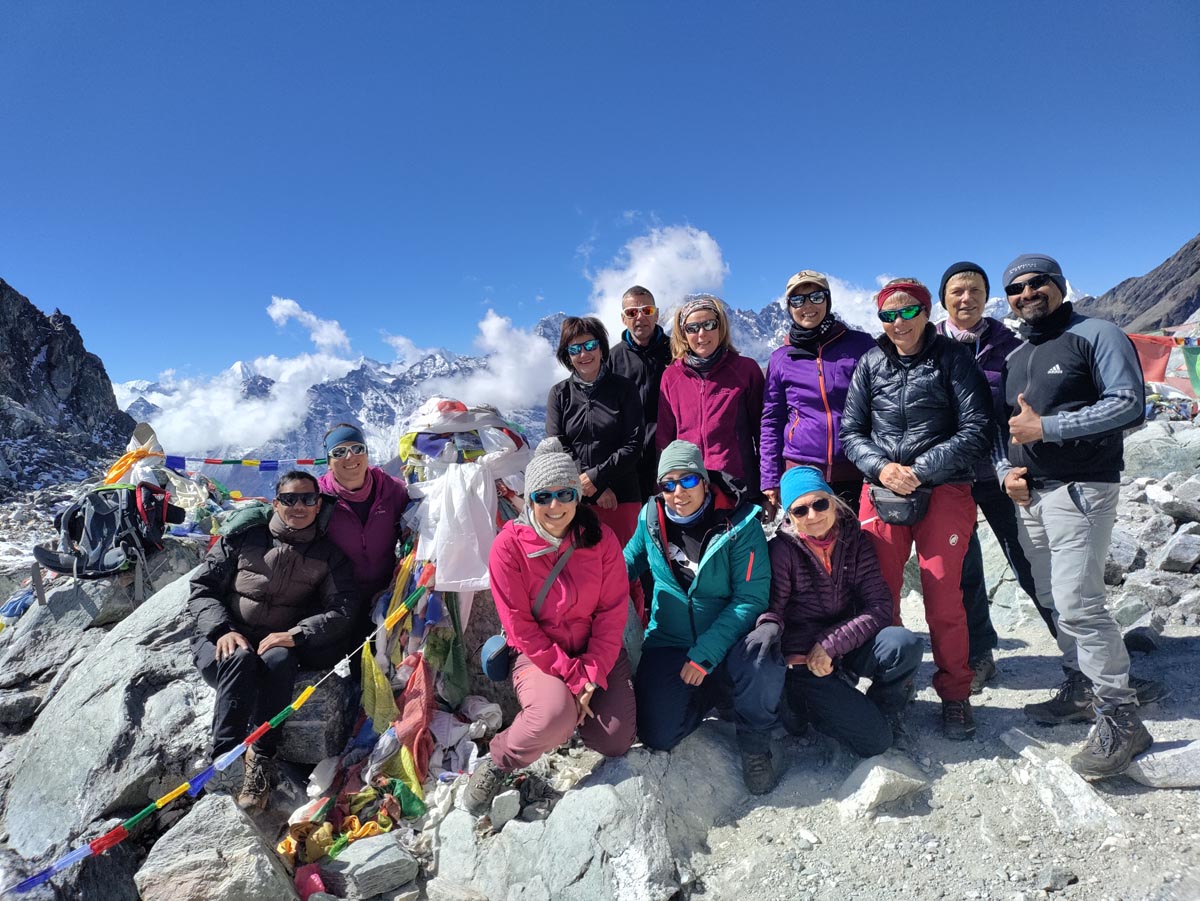
Day 14: Climb Gokyo Ri and return back to Gokyo
Early in the morning, we have a steep climb up to the top of Gokyo Ri at an elevation of 5,483 m. There are ample rewards for those who attempt this trip. You get stunning views of the super Gokyo valley, the massive Ngozumpa glacier and an incredible panoramic view of the whole Khumbu Himalayas, including the giants; Everest, Lhotse, Nuptse, Makalu, Cho-Oyu and Gychung Kang.

Day 15: Trek to Lunden from Gokyo via Crossing Renjo La Pass
Today we start our trek in the morning. Our trek for today is long but on the normal trail. We can see amazing view of Mt. Everest from the top of the Renjo pass. Then we descend down to Lunden for our today’s final destination.
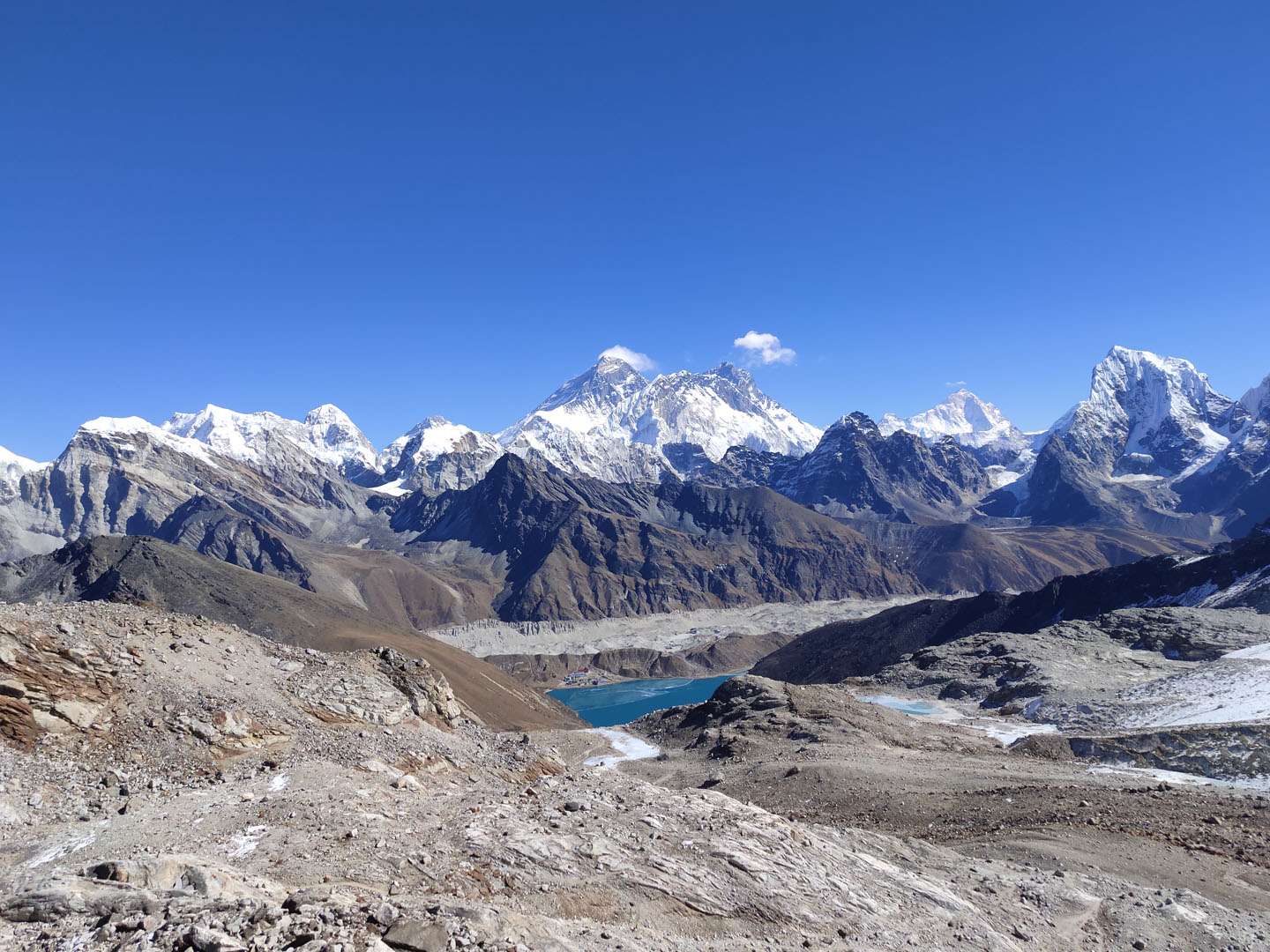
Day 16: Trek to Thame from Lunden
We start our trek after breakfast. Today, the trail will mostly descend down to to Thame.
While on the trail we can see amazing snow peaks. About 150 meters above Thame, there is a Thame Monastery, a picturesque monastery set among the many homes of monks and lay people.
It resides on the side of a hill overlooking the valley. This is the site for the spring celebration of the Mani Rimdu festival, held about the middle of May each year.
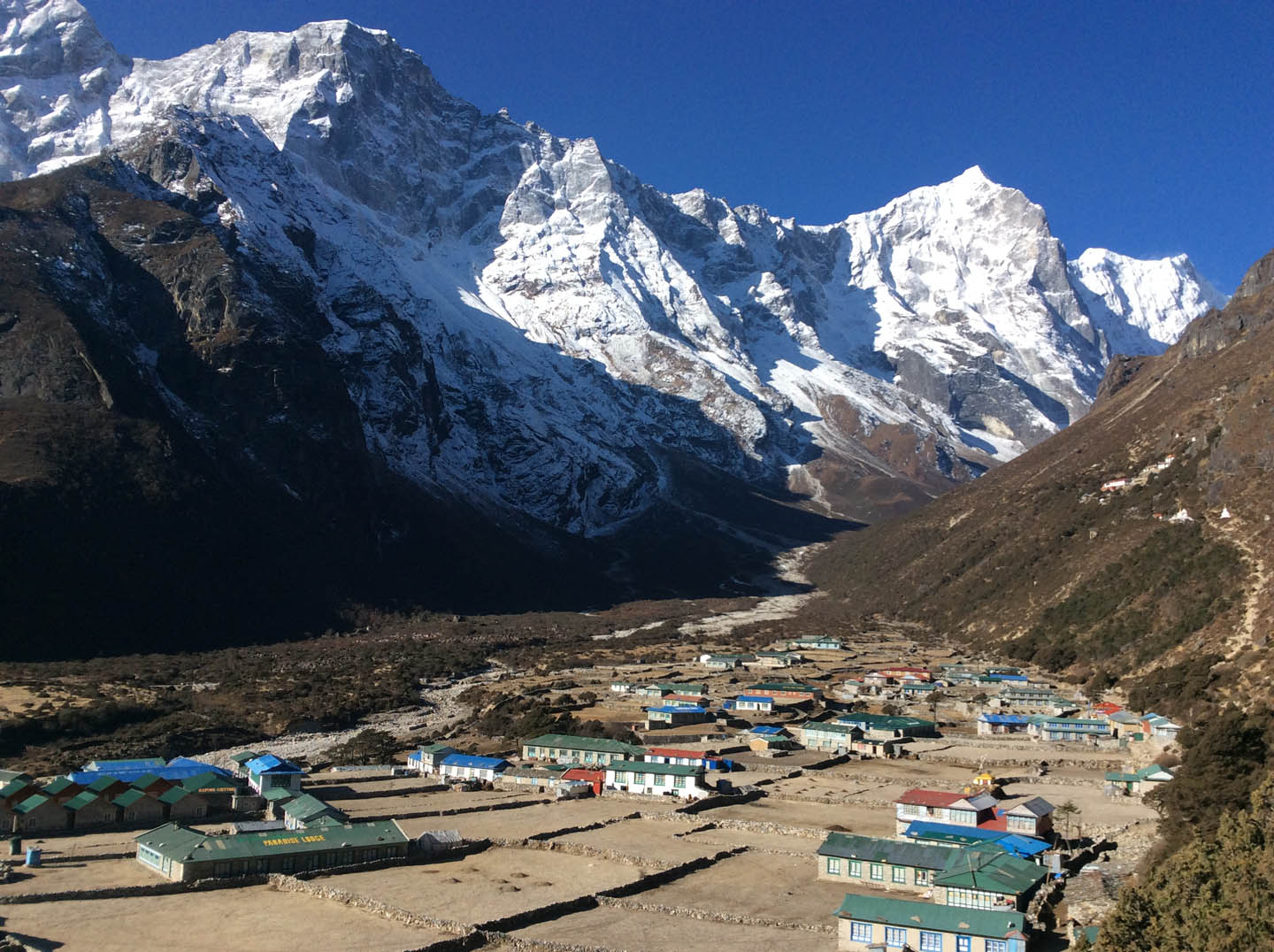
Day 17: Trek to Namche Bazar from Thame
Thame is a traditional Sherpa village that has escaped the crowds trekking to Everest and has one of the oldest monasteries in the region. The village is notably the hometown of Apa Sherpa who has made it to the summit of Everest 21 times!
The walk itself is peaceful with excellent views of the mountains as it winds in and out of the forest on the side of the canyon. This day, we continue our journey walking down the hill from Thame.
The trek will be easy and short and the final destination for the day and the trip will be at Namche Bazar.

Day 18: Trek to Lukla from Namche Bazaar
Finally we return back to Lukla where the trek began, which will seem like ages ago. It will give you time to reflect on the trek also giving you time to explore the town.
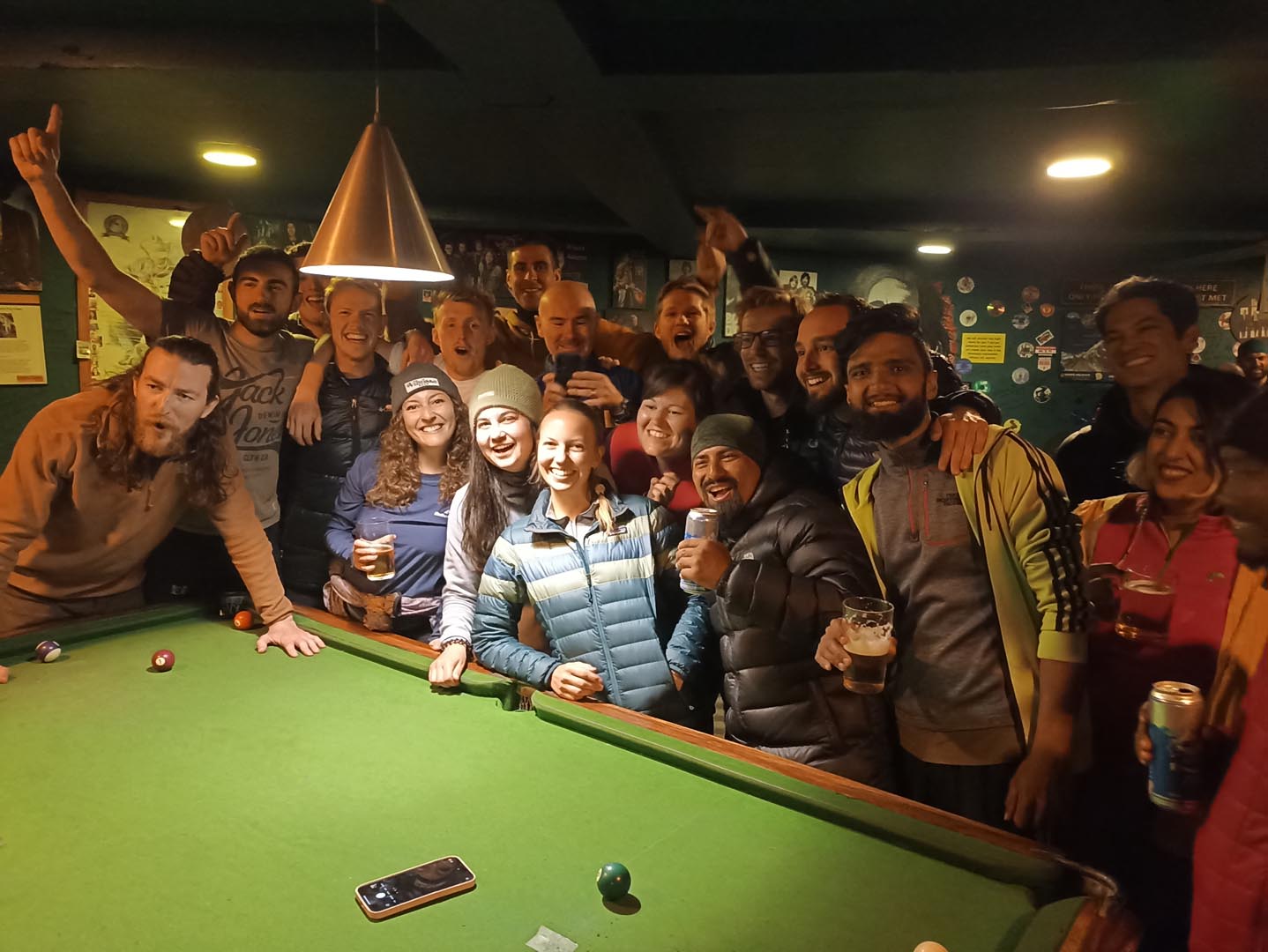
Day 19: Fly back to Kathmandu or Manthali from Lukla and same day drive to Kathmandu
Lukla to Manthali Flight (March, April, May, October, and November) The flight from Lukla to Manthali is a 20-minute flight. After that, it is about a 5 to 6 hour drive to Kathmandu. Please note that the driving hours may vary according to the highway traffic condition. You’ll be transferred to the hotel in Kathmandu on a shared tourist vehicle.
Lukla to Kathmandu Flight (January, February, June, July, August, September, and December) The flight from Lukla takes about 35 minutes. After arriving at the airport, you will be transferred to the hotel in Kathmandu via a shared tourist vehicle. Please be aware that the decision regarding the operation of flights solely depends on the airline and is influenced by the volume of travelers during a specific month.
You have the option to book a direct helicopter flight from Lukla to Kathmandu for an extra charge of USD 550 per person. This price is quoted on a 5-people sharing basis. This is the best alternative to avoid the long drive to from Manthali airport to Kathmandu during peak season (March, April, May, October and November).
You might want to stay a little more in Nepal. If you are looking for extending your trip, there are options such as a visit to Chitwan National Park, known for wildlife viewing, and to Pokhara, considered one of the most beautiful cities in Nepal. You can also extend your trip to Tibet, India, or Bhutan.
You will be served a farewell dinner in a fine restaurant.
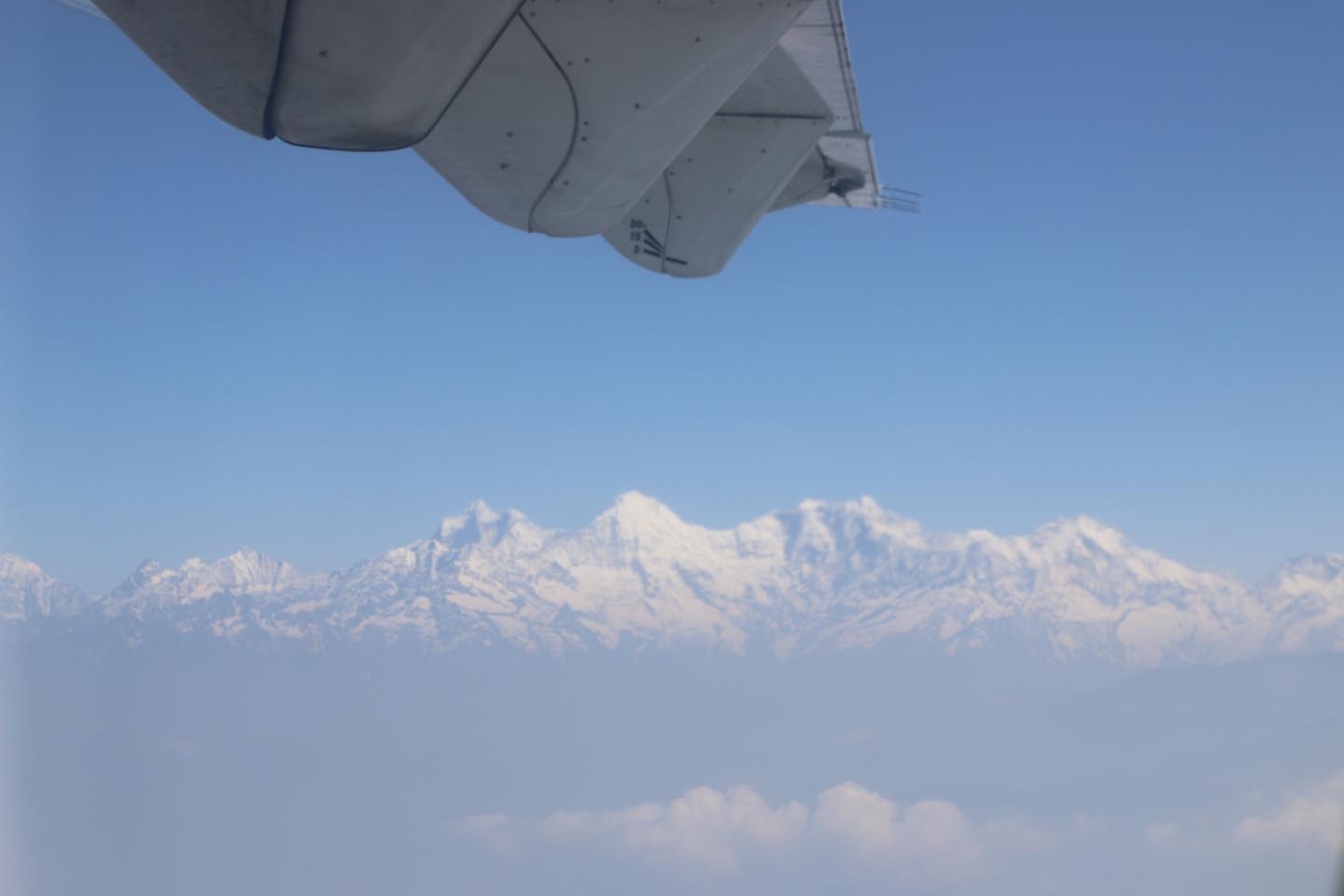
Day 20: Transfer to the International Airport for Your Final Departure
The trip concludes – our airport representative will drop you to Kathmandu’s Tribhuwan International Airport for your flight departure from Nepal.
Packing list for Everest three passes trekking
Here is a list of what you might want to pack for the hike. Please take this as a starting point. You’ll need layers of warmer clothing during the winter. We provide a 75 liter duffel bag for you to use for the trek.
It will be given to you during your pre-trip meeting in Kathmandu. The duffle bag is yours to keep. Also, you can rent sleeping bag and down jacket with us at the additional fee of USD 35 for each once you are in Kathmandu.
- Four-season (zero degree) sleeping bag (We have rental sleeping bags available for an additional USD 35)
- Puffy down jacket ( We have rental jackets available for an additional USD 35)
- Daypack (35-45 liters recommended) with rain cover
- Sleeping bag liner
- Sun hat or cap (We'll provide you with a free Ace the Himalaya baseball cap.)
- Knitted hat/Beanie
- Technical fabric base layer (light for warmer months, heavy for colder months)
- Technical fabric short (2) and long sleeve (2) shirts
- Waterproof, windproof shell
- Fleece jacket or pullover
- Hiking pants (2)
- Comfortable pants for inside the teahouses
- Hiking shorts
- Wool or technical fabric liner gloves
- Hard-shell outer gloves (insulated for colder months)
- Wool or technical fabric warm socks
- Hiking socks
- Liner socks (optional such as silk)
- Trekking/hiking boots (waterproof recommended)
- Ice Cleats /Micro Spikes (For trekking from November to March, it's recommended to include Ice Cleats/ Micro Spikes to prevent slipping on icy or wet surfaces.)
- Casual shoes
- Gaiters (lightweight for dust or heavy for snow in colder months)
Undergarments
Note: The quantity of each article of clothing can be adjusted to suit the preferences of each participant.
- Technical fabric/quick drying is best for underwear (opportunities to launder during the trip)
- Sports bras (women)
- Pajamas or sleeping clothes
First Aid Kits and Medications
- ( Note : Guides carry medications and first aid kits during the trip. However, personal kits and medications are highly recommended.)
Other Essentials
- Extra copies of passport-sized photos
- Reusable water bottle
- Toiletry kits
- Water purification tablets or UV water purifier (if you plan to treat water)
- Hydration bladder
- Toilet paper (2 rolls)
- High protein snacks (such as protein bars or nuts)
- Waterproof/dry bags for carrying important documents and money
- Airline tickets (Please leave a copy at our office in Kathmandu. This can be useful if there is a change in the date of the flight.)
Once in Nepal, if you have the time, you can purchase supplies and gear for hiking. Thamel, Kathmandu’s tourist hub, is home to many shops where you can get a variety of reasonably priced trekking equipment.
- Power bank or extra batteries
- Cameras and mobile phone
- Trekking poles
- Thermos for hot water
Important Information
- We give you a free duffel bag and baseball cap during your pre-trip meeting in Kathmandu. The duffel bag will be used to pack your trekking supplies.
- For every two participants, we assign one porter. The duffel bag, which should weigh around10 kg/22 lbs, will be carried by the porter throughout the walk.
- To carry your daily necessities like cash, crucial papers, a water bottle or bladder, a camera, toiletries, sunscreen, a notebook, clothing, etc., you must have your own daypack (with a waterproof cover).
- You can store your luggage (non- trekking items) at the hotel in Kathmandu.
- Total luggage allotment allowance for Kathmandu-Lukla flight is 15 Kg/33 lbs including both duffel (10 Kg/22 lbs.) and backpack (5Kg/11 lbs.)
- Down jacket with a hood is a must for altitudes above 4,000 m to keep warm. You can rent a down jacket for USD 35. Please note that in case of loss or damage, you need to reimburse the cost of USD 200 per item.
- You can rent a 4-season sleeping bag for USD 35. Please note that in case of loss or damage, you need to reimburse the cost of USD 200 per item.
Note: Some clothing, especially form-fitting, figure-hugging items made of elastic material (like yoga pants), may offend locals. Therefore, if you choose to wear these clothes for comfort, please make sure to wear something over them.
Everest High Passes Trek Map & Elevation
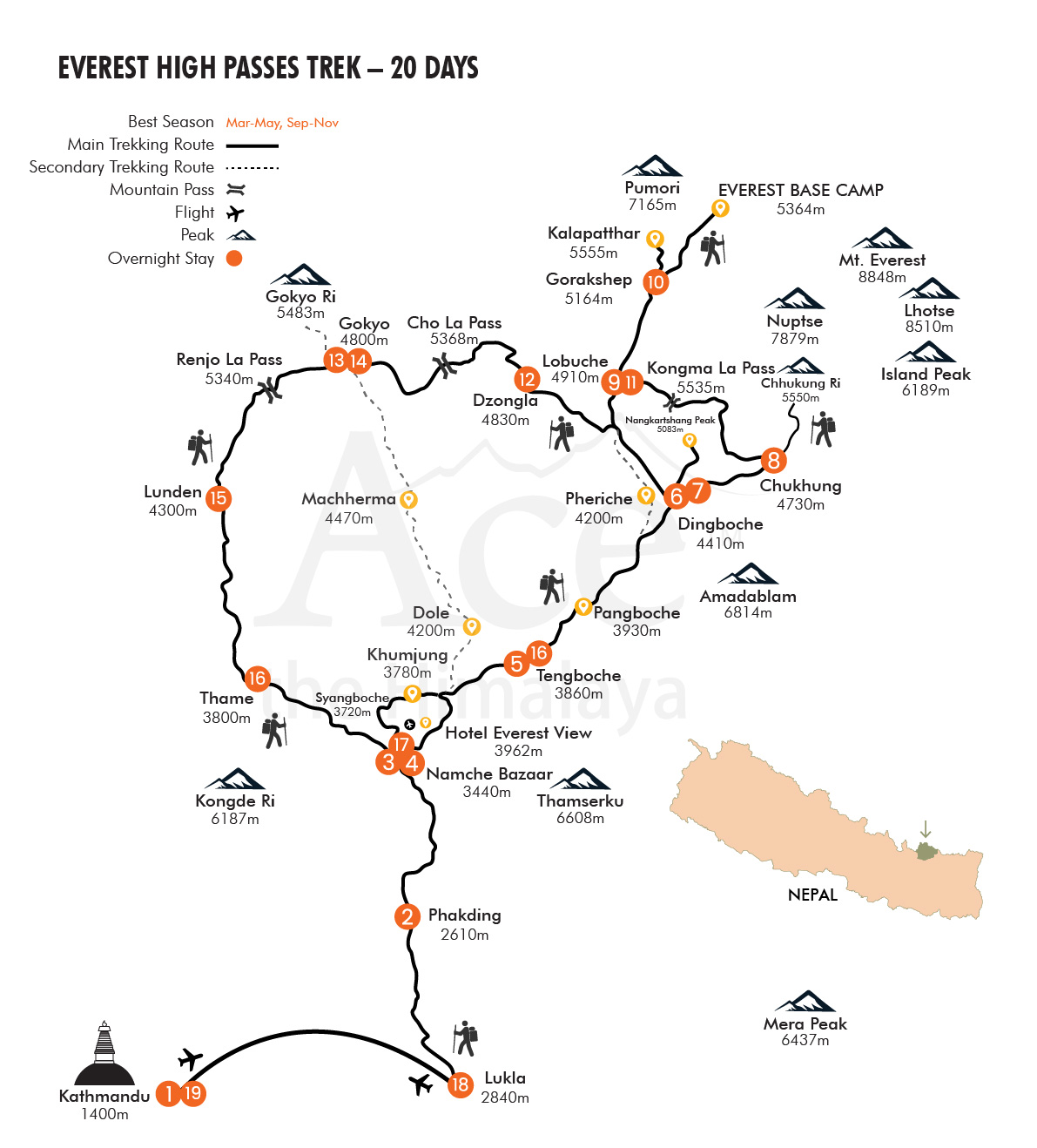
FAQs for Everest Three Passes Trek
Why trek with ace the himalaya.
Ace has a reputation for successfully leading treks with knowledgeable leaders and staff taking care of all your travel needs. We are a certified sustainable travel company that also endorses the idea of giving back to the community by participating in various philanthropic activities. Here are 17 reasons why you should choose Ace the Himalaya for your next adventure!
Is Nepal open to travelers following the Covid-19 pandemic?
Indeed, Nepal is entirely open. Travelers are welcome in Nepal without any restrictions. Arriving travelers can obtain a visa on arrival at the Kathmandu airport as well.
What are the conditions to travel to Nepal post Covid-19?
Traveling to Nepal is now hassle-free. You don’t need a vaccination certificate or negative PCR test, but check with your airlines and transit countries for any specific requirements.
We suggest you look at the Nepal immigration site https://www.immigration.gov.np for the most up-to-date information.
What additional documents do I need?
- Two passport-sized photos (2×2 inch) to give to our office staff
- A copy of your international flight ticket to give to our office staff
- A copy of travel insurance to give to our office staff
What should I know about booking my flights to/from Nepal? Do I need to plan extra days in case of delays?
The best course of action is to add a day or two before and after your intended trek days in case of flight delays or cancellations. It also gives you time to buy clothing equipment and gear required before your trip.
Please be aware that Ace the Himalaya is not responsible for any inconveniences or missed international flights resulting from unforeseen events like airport changes, flight delays or cancellations, etc.
Is hiring a guide necessary even if I have trekking experience?
You can hike in Everest Region without a guide. A guide is there to assist you in going forward and making alternative plans and arrangements when unanticipated occurrences happen or when things get difficult.
Our hiking leaders are qualified experts. When talking about their trip, our guests frequently remark on how much fun they had and how crucial their guide was to make it successful.
Can the guide speak English?
Our guides are fluent in English. All the guides that we assign speak and understand English. They’ll share with you the fascinating stories, traditions, and folklore of the mountains. The guides will also help you communicate with the locals since many shopkeepers and hosts of teahouses don’t speak English.
Weather and Temperature
What is the best season for this trek.
The best seasons to hike Everest high passes trek are autumn (Mid-September to November) and spring (March to early June). This trek is possible year-round, and we can organize it when it suits your schedule.
However, we generally suggest doing this trek in the favorable seasons and keep away from rainstorm season (July and August). In cold months of January and February, the temperature can be a little harsh in the mountains.
However, some prefer to travel during these months as it is less crowded given that you are well prepared with appropriate winter wear and other gears.
What kind of weather and temperature can I expect while trekking?
Due to its tendency to be localized, the weather in the Everest region is challenging to forecast. You could see rain, fog, cold, or hot and sunny weather while trekking. It is best to be equipped to handle various weather situations. In the Everest region, nighttime temperatures are significantly lower than midday temperatures. In less than a day, the temperature can change from a high of 25°C (77°F) to a low of – 20°C (-4°F). The weather and temperature ranges are typically predictable based on the month and season, even though it might be challenging to predict what each day in the mountains will bring.
Spring – March/April/May/June
Despite being the busiest season, spring is perhaps the best time to visit the Everest region. Activities assisting the expedition teams take place in Everest Base Camp. The many varieties of blossoming trees should be visible, and the sky should be clear with stunning vistas. During springtime, the average temperature is 20°C (68°F), with a high of 25°C (77°F) during clear days and a low of – 15°C (5°F) overnight above 4000 meters.
Monsoon season – July/August through Mid-September
Since it rains heavily at elevations below 3500 meters, this season isn’t exactly ideal for travel in the Everest region. While it can occasionally be dry in areas above 4000 meters, it frequently rains so therefore not many people travel during this season. Trekking during the monsoon season has some advantages, such as a greater possibility of seeing waterfalls and the best opportunity to escape crowds. During the monsoon, the average temperature is 22°C (71.6°F), with a high of 30°C (86°F) during clear days and a low of- 5°C (23°F) overnight above 4000 meters.
Autumn – End of September/October/November
In the Everest region, autumn is equally as busy as spring. It is one of the best times to go, too. While the plants and trees are not in bloom, the sky is often clear, offering breathtaking vistas from almost every viewpoint. The average temperature in autumn is 17°C (62.6°F), with a high of 20°C (68°F) during clear days and a low of – 15°C (5°F) overnight above 4000 meters.
Winter – December/January/February
Due to fewer tourists, some people like winter travel. Even while the views are still beautiful, it can be cloudy, thus adding extra days is highly advised during this time. The average temperature is 10°C (50°F), with a high of 17°C (62.6°F) during clear days and a low of – 20°C (- 4°F) overnight above 4000 meters. The teahouses provide extra blankets for warmth at night.
What is the temperature rating of the sleeping bag that you lend to trekkers?
The temperature rating of the sleeping bags that we rent to trekkers is about -10°C (14°F). Also, our guides can obtain extra blankets if needed at the teahouses.
Arrival and Visas
Is it possible to obtain a visa for nepal upon arrival at the airport.
Yes, you can obtain a Nepal visa upon your arrival at the airport. There are kiosks in the arrival hall that you use to complete the necessary forms. The cost is USD 30 for a 15-day tourist visa, including numerous entries, or USD 50 and USD 125 for a 30-day or 90-day tourist visa including numerous entries respectively. You should carry cash (USD) with you to pay your visa fees quickly and easily, as digital payments are frequently unavailable.
Who will come to pick me up at the airport upon my arrival?
Our staff will be waiting for you outside the airport terminal with our signboard (Ace the Himalaya). You will be accompanied to a hotel in a private tourist vehicle.
Everest three passes trek cost
How much additional money do i need per day.
Typically, USD 15 to 20 per person per day will be sufficient. This is to purchase water, tea/espresso, snacks, and hot showers in the mountains and for lunch or dinner in Kathmandu. Additionally, if you want to buy souvenirs or native Nepali goods, you can bring extra cash with you.
Is it possible to use credit cards in the places I visit during the trek?
Nepalese Rupees cash is preferred to a credit card while trekking in the mountain region. Exchanging your cash into Nepali Rupees in Kathmandu before the beginning of the trek is ideal. This can be accomplished at the airport, at banks, or at your hotel. Please note the hotels will exchange up to about USD 100 for each transaction only. There are ATMs up to Namche Bazaar but can be unreliable. The currency exchange rate is better in Kathmandu.
Is it possible to reserve a trip now and pay a deposit later, or do I have to pay a deposit at booking/reservation?
When you book, you must pay a 30% deposit to secure your itinerary. The remaining balance can be paid upon your arrival at Kathmandu or before arrival. US Dollars cash and credit cards (Visa, Master, and American Express) are accepted once in Nepal. Please note a 4% transaction fee will be added for all credit card transactions.
How do I pay the remainder of my balance upon arrival in Kathmandu? US Dollars cash or credit card?
You can make payments via US Dollars cash or credit card (Visa, Master, and American Express). A 4% transaction fee is added if paying with a credit card. Thus, we encourage you to pay with USD cash if you are planning to pay upon your arrival in Kathmandu.
We prefer you pay with larger bills (USD 50 or 100). Please note that the cash should not be older than 2009 and in good condition, as banks do not accept worn, torn, or crumpled bills.
How are the ATM and money exchange facilities in Kathmandu?
There are ATM and money exchange facilities almost every few meters in Thamel, where you will be staying in Kathmandu. So, you can easily use your cards to cash out limited sum of money to which a minimum charge is deducted by the ATM facility itself. You can easily exchange your foreign currencies in currency exchange centers for an exact rate.
Who Can Trek?
Do i need prior trekking experience.
Previous trekking experience is not required if you are physically healthy and have enough enthusiasm for the trek.
Are there any age requirements for mountain trekking?
Our treks have no age restrictions if members are healthy and willing. We have had families with kids as young as 5 years do the treks along this region, and our oldest adventurers have been in their late 70s.
Is trekking to mountain regions safe for solo female travelers?
It is safe for a female to trek alone in Nepal. Nepal is usually regarded as a safe nation for female visitors traveling alone. It is entirely safe for a solo woman to trek with Ace the Himalaya on any of our treks.
Physical Fitness
How challenging is the trek.
The Everest high passes trek is somewhat challenging due to the higher elevation and long duration of the trek . It is a very strenuous journey that comprises walking 5 to 8 hours a day.
How quickly do you walk on the trail?
The average walking speed for a reasonably fit person is 4 kilometers per hour. At higher elevations, it is highly recommended that you walk slowly to help with acclimatization.
What kind of physical training is necessary for trek preparation?
For trekking, you must prepare your body to walk over uneven, hilly landscapes while carrying a backpack. Walking at an incline, jogging, cycling, and going for long-distance hikes are all good ways to exercise. You should work out for at least one hour four to five times a week for at least two months before trekking.
What are the physical standards that I need for the trek?
Participants in good physical condition should be able to complete this trek. If you are not physically active, we advise starting an exercise regimen two months before the trek that includes at least an hour of walking at an incline, running, or biking four to five times a week.
Incorporating hiking into your workouts is ideal. It is advised to speak with a doctor before making travel arrangements if you have any health conditions that could affect your ability to complete the trek.
Trek Preparation and Packing
What is the weight limit for the lukla flight.
The weight limit for the Lukla flight is 15 kg (33 pounds), including your duffel bag and daypack. If your daypack weighs more than the allowed weight, you can pay an extra USD 2 to USD 5 per kilogram. Despite the extra pay, the baggage allowance is occasionally withheld. Therefore, we recommend you pack within the 15 kg weight limit.
What are the procedures after I make my deposit?
After making the deposit, one of our staff will email you for further information. We will require a copy of your passport photo page and your arrival/departure flight details. We will also provide you with additional trip information.
What sort of insurance do I need? How can I obtain a policy?
Travel insurance is mandatory for our hiking itineraries. We require your policy have medical evacuation coverage for the maximum elevation of your itinerary. Insurance may also cover additional costs in the event of a flight delay or cancellation caused by bad weather, medical costs, theft, loss, and damage to your items while traveling.
Travel insurance can be obtained online by one of several travel insurance companies. Please note that insurance obtained from an airline at the time of booking your flight may not cover medical evacuation coverage.
What are the necessary items that I should pack for my trip?
You can find the necessary items to pack for the trek on the Equipment Section of this trek. Gear and equipment can be bought or rented upon your arrival in Kathmandu. If you plan on buying or renting gear in Kathmandu, please allow extra time.
Do you provide sleeping bags or down jackets for rent?
Yes, we do provide sleeping bags or down jackets for rental costs of USD 35 each. Do let us know before initiating the trek and we shall provide items.
What type of bag will the porters carry?
We provide you with a free duffel bag of 70 to 80-liter capacity that our porters will carry. The maximum weight that porters can safely carry is 30kg, and each porter is assigned to two people.
What type of daypack should I bring?
We suggest a 30 to 40-liter capacity daypack. Wider straps and hip belts are recommended to assist you in carrying weight evenly and reduce pain.
What about my passport, medications, and belongings?
Bring copies of your passport, insurance papers, and other essential items in your carry-on during your flight. If you need to take medications daily, keep them in your daypack with your other essential possessions. You can store other non-trekking essentials in the office of Ace the Himalaya or at the hotel in Kathmandu.
Accommodation
What kind of lodging is available on this trip.
In Kathmandu, we use three-star hotels including breakfast. We use Hotel Thamel House, Gaju Suite Hotel, Hotel Jampa, or comparable-class lodging in Kathmandu. Teahouses with clean rooms are used during the trek. For further information see Teahouses in the Everest region trek
Is it possible to have private rooms while trekking in the Everest region or while in Kathmandu?
A private room in the teahouses and in Kathmandu can be guaranteed for an additional cost.
Do the rooms at the teahouse have a private attached toilet or do we have to use a common toilet?
Yes, we provide you with attached toilets in the teahouse in some places like Lukla, Phakding, and Namche only. You will have a shared toilet available in the teahouse for the rest of the places.
What happens if I end up staying an extra night/s in Kathmandu due to an unforeseen delay or cancelation?
In case of unforeseen circumstances such as flight cancellation, your health, or for any reason you decide to discontinue the trip and arrive early in Kathmandu then you will need extra accommodations in Kathmandu.
The cost of the teahouses in the mountains is not equivalent to the cost of a hotel in Kathmandu. In such cases, we will arrange your accommodations, but you will need to pay a supplemental charge.
Is it necessary to bring toilet paper for the trek?
You can buy toilet paper in the guesthouses during the trek, but it can be expensive, so we suggest you bring some with you. You also need to bring personal items such as towels, soap, hand sanitizers, and so on.
Are there restrooms along the trail?
There are toilet facilities in the teahouses/lodges during the trek. Trekkers can also find private areas along the trail for emergencies.
What sort of food can I expect in trekking?
Multiple food choices are available in the guesthouses. Options include daal bhat (rice and lentil), bread, eggs, potatoes, noodles, soup, pasta, and pastries. We suggest eating vegetarian during the trip.
You will find a great deal of garlic on the menu since it helps with acclimatization. Each meal includes one hot drink. Hot drinks include coffee, hot chocolate, tea, and hot lemon drinks. You can purchase an additional hot drink or sometimes soda at your own expense. You can also purchase candy or cookies (crisps) at your own expense.
Is the food in the mountains prepared to international standards in terms of safety?
Indeed, the guesthouses follow international guidelines while setting up the food and serve you clean, protected, and warm meals .
I'm a vegetarian. Is that a problem?
Most of the teahouses in the mountains offer vegetarian meals. So, being a vegetarian is not a problem. Vegetarian meals are preferable to avoid food poisoning and indigestion.
Is the water okay to drink? Do I need to bring purifying tablets or filters?
Natural spring water or tap water can be found along the trek and in guesthouses but must be treated. We use Katadyn filters to purify the natural water sources to make them safe to drink. This way, it is sustainable and pocket friendly as you need not buy bottled mineral water. You must carry a water bottle that can hold both hot and cold water and a hydration pack.
If the temperature drops too low for the Katadyn filter to function properly or if any technical issues occur, it is recommended to buy boiled water from the teahouse to ensure safe drinking water as an alternative.
Can we get hot or boiled drinking water? Does it cost extra?
Yes, teahouses do provide hot boiled water for an extra charge of USD 2 to 5 per liter. The cost varies and increases at higher altitudes.
Can I shower/bathe during the trek?
Yes, hot showers are available from Lukla upto Namche Bazaar for an additional cost. Some villages at higher elevation too might have shower availability. However, you can purchase a pail of warm water at higher elevations to bathe with.
It is not recommended to take showers above the village of Dingboche to avoid sickness. Depending on the location, it will cost an additional USD 5 to USD 8 for each shower during the trip.
Are there any laundry services available on Everest Region?
Some teahouses provide laundry services in the Everest region for an extra charge. However, it’s not guaranteed that your clothes will dry on the same day.
There is a possibility that you can wash your clothes yourself during acclimatization days in Namche and Dingboche. However, we recommend you pack enough clothes for your trek and do not rely on laundry services.
Can I charge my electronic equipment during the trek?
Yes, you can charge your equipment during the trek for an additional cost. The cost will vary but is around USD 1-5 per charge. Two pins (type C) and three pins (type D) adaptors are highly recommended. Bring these adaptors or purchase them while you are in Kathmandu.
Health and Safety
Do your guides have the trekking guide certificates from the hotel management and tourism center have they received first aid training for high altitudes.
We provide licensed trekking guides with fluent English. Our guides are certified by the Hotel Management and Tourism Center after receiving 45 days of training. Similarly, the guides receive high-altitude training from Kathmandu Environmental Education Project (KEEP).
What are safety measures in place? What safety equipment do your guides carry on the trek to deal with sickness/accidents?
Our guides are well trained and certified in first aid. Throughout the journey, our guides will evaluate your condition and your oxygen level using an oximeter. Our head office receives continuous updates on your condition and location through the guides. In places without a phone signal, your situation will be updated through a satellite phone during emergencies.
How do you allocate guides and porters in a group?
We allocate one guide for groups of up to 8 participants. For groups of over 8 participants, we allot an associate guide. As per the size of the group, we may add more guides or divide them into sub-groups.
We provide one porter for every two clients. Two clients’ duffel bags will be carried by one porter. The weight limit is 30kg or 15kg for each client. For an additional cost, we can arrange for one porter to carry one participant’s duffel.
Is Ace the Himalaya's staff insured?
Our company insures all our trekking staff members, including guides, cooks, Sherpa, and porters. Please browse through our legal docment page to view insurance details.
What vaccinations will I need?
- Typhoid vaccination is recommended but not required
We suggest you have a dental checkup before your trip and know your blood type. It is helpful if you inform us of any medical condition that is relevant so we may convey this information in the event of an emergency. Ace the Himalaya keeps your medical condition confidential unless treatment is necessary.
What if I am very sick in the mountain?
Our guides are 24 hours available for the services during the trek. They are trained to use first aid kit and have knowledge to use Oxy meter. They are very much aware that higher the altitude the oxygen level gets lesser so to get updated on the oxygen level of our client and to know whether they are fit enough or needs extra precautions to continue.
Guides carry local sim cards both Nepal Telecom and Ncell in order to update whereabouts and situation of our every client. During the time of emergency our guides are alert and keeps updated to head office in Kathmandu that is available 24 /7 to arranging from horse to mules or helicopters in the must needed cases especially when client is seriously sick in the mountain and needed to be hospitalized.
Do you guys have a PAC (Portable Altitude Chamber)?
Yes, we have access to a portable altitude chamber in case of an emergency. It is not essential to carry during the trek. Though, we can use arrange it upon request for an extra cost of USD 200.
Do you provide oxygen supply if needed?
Yes. Guesthouses at higher elevations such as Lobuche and Gorak Shep offer oxygen at an extra cost if needed. The cost of oxygen can be high so we recommend having travel insurance so they can reimburse you.
We can also provide pre-booked oxygen for an extra cost of USD 150 for 1 tank that can be carried along with you during the trek starting from Namche to higher elevations.
How are acclimatization and altitude related?
Altitude sickness is a possibility during the Everest Region. Air at higher elevations has less oxygen available. To avoid altitude sickness, acclimatization days and slow climbs are recommended at higher elevations.
Along the trek, you’ll be assisted by our professional guides in recognizing and preventing altitude sickness.
What kind of trekking boot would be best for the trek?
An important piece of equipment is your trekking boots. Invest in a durable and comfortable pair, preferably with water-proof lining. Boots that provide ankle support on rough ground and have stiff soles are recommended.
What is necessary for sun protection during the trek?
Even when the sun isn’t shining, sun protection is essential. UV rays are reflected by the snow and the harshness of the sun will damage your skin before you notice it at high elevations. Therefore, proper clothing and sunblock are necessary. Hat, sunscreen, sunglasses, clothes, etc. are vital for sun protection.
Practical Matters
What is your cancellation policy.
Notice should be provided 20 days before the trip start date in case of cancellation. The trip can be canceled for justifiable reasons. Once the trip is canceled, a fee of 30% of the trip cost is retained for administrative costs.
However, the trip amount is entirely non-refundable if the cancellation is not made before the 20 days as per our terms and conditions. For submitting a claim to your insurance company after the cancellation, we can assist with documentation such as a receipt of monies paid. Refund will not be provided for unused accommodation in case of trip cancellation caused by personal reasons/sickness/weather.
More information about our cancellation policy can be found here in Terms and Conditions page.
Do I need to tip my guide and porter? How much would that be?
Tipping is expected and appreciated. You can tip your trekking guides and porters based on your satisfaction and enjoyment. We suggest you spend at least 10% of your total trek cost for tipping staff. You’ll learn more about how much to tip your group’s guides and porters during our pre-trip briefing in Kathmandu.
Is there any communication while we are trekking?
Yes. The guides carry local cell phones, so you can use their cell phones if necessary and reimburse them. Assuming you have brought your cell phone, you can obtain a local SIM card and use it. Our guides or representatives can help you get a local SIM card after your arrival. There is the availability of Wi-Fi at most teahouses for an additional cost. We utilize satellite telephones for emergencies.
What is the Internet availability in the Everest region?
For internet usage, the Everest region has a network “Everest Link” which can be bought for around NPR 600-800(USD 5-7) for 6GB that can be used at one destination, or you can pay NPR 2500(USD 21) for 10GB data that can be used in the regions that have access to Everest link.
The purchase is valid for one device only. Some teahouses will have internet access and offer Wi-Fi hotspots for a charge. These are usually unreliable and not all teahouses will have connections, so it is recommended you purchase Everest Link or a 3G/4G SIM card to use for the duration of your trek.
Does it cost an extra amount if I am a solo traveler?
If you are a solo traveler and book one of our published dates, there is no additional fee. If you sign up for a private trip or change the trip date from one of our published trip dates, you will be charged an additional fee.
Is there a provision for a refund policy if I don't accomplish the trek?
Trekkers occasionally fail to complete the journey for medical or personal reasons. In this situation, be aware that we do not issue any refunds for products purchased or unused trek days. We must pay our administration staffs, guides, and porters, purchase trekking permits, and all other booked accommodations in advance, so our expenses remain the same.
Who else will be joining my trekking group?
If there are any, you will be allocated to a trekking group. The details of the personal data of your group members cannot be disclosed. However, feel free to contact us if you have queries about other trekkers in the group and we shall give you a general idea of the ages, nationality, and sex of your group members. Chances are you will be trekking with others unless you have booked a private trip.
Can I add extra days to my trekking trip?
You can extend your trekking trip for an additional cost. Potential arrangements will be made if we get a request from your guide. This is applicable for private or solo trips as the itinerary can be easily adjusted. The addition of extra days is bound by time when you are in a group. Therefore, discuss with your group and guide, what changes can possibly be made.
I want to extend my holiday, any recommendations?
Yes, you can extend your holiday. Ace the Himalaya offers many options and alternatives for your holiday extension. For more information, you can visit our Day trips pages.
Transportation and Flights
Do i need to book my international flights for the travel to nepal.
Yes, you must book your international flights. We are a local agency and do not make international flight arrangements. You can easily browse through flight tickets in airlines sites to book ones most feasible for you.
What form of transportation do you utilize?
We utilize private tourist vehicles for touring, city visits, and airport pickups. Based on the group size, we use cars, minibuses, or vans. We use 4WD when necessary.
Can we fly by plane to Lukla directly from the Kathmandu airport?
The flight to Lukla depends on the trekking season. During peak trekking seasons (March, April, May, October and November), the traffic in Kathmandu airport is congested so, the flight to Lukla may be from Manthali airport in the Ramechhap district. However, during the off-season, you can take a flight to Lukla directly from Kathmandu airport.
How can I reach Manthali Airport, Ramechhap? Do the airlines provide shuttle services to get to Manthali from Kathmandu?
You can reach Manthali airport by traveling in a vehicle. The journey is about 4 to 5 hours (depending upon traffic) by road.
Usually, the airline companies provide shuttle services at 3 am to get to Manthali airport, Ramechhap from Kathmandu (depending upon flight time). If airlines’ shuttle services are not available, Ace the Himalaya will arrange for a vehicle to Manthali airport.
To catch your Lukla flights, you will travel to Manthali early in the morning around 2 to 3 am from Kathmandu. If your departure time is early in the morning, you must arrive in Manthali the day before and spend the night there. More information will be shared 2 to 3 weeks before you arrive in Kathmandu.
The return journey from Manthali to Kathmandu will remain like your outward journey.
What sort of bus services can I expect to reach Manthali Airport from Kathmandu?
Generally, vehicles such as Toyota HiAce, Mahindra Scorpio, etc. are used for shuttle services between Kathmandu and Manthali. Even though the roads leading to Manthali are bumpy, sloping, and winding, the transportation options offered will be comfortable during the trip.
Is there a possibility of flying to Kathmandu from Lukla by plane directly after the trek?
The flight to Kathmandu from Lukla depends on the trekking season. Direct flight may not be possible during peak trekking season (March, April, May, October, and November) due to heavy air traffic in Kathmandu. Therefore, the flight arrives at the Manthali airport, Ramechhap.
What are the main reasons for Lukla flight delay or cancellation?
Bad weather conditions are the major reason for Lukla flight delay and cancellation. Other reasons can include congested air traffic at the Kathmandu Airport, staffing shortages, and other difficulties cause flight delays/cancellations.
Is there any alternative option if my flight to and from Lukla is canceled or delayed?
For an additional cost, a helicopter flight is an option in the event of delay or cancellation. This assists with getting you to your planned international flight.
Is it possible to book a helicopter flight instead of regular flight between Lukla and Kathmandu?
Yes, you have the option to book a seat on a helicopter between Kathmandu and Lukla for an extra charge of USD 550 per person for a one-way flight. This price is quoted on a 5-people sharing basis.
How much should I pay for a private Helicopter charter?
A private helicopter can be reserved for an additional cost of USD 3,500 for one way in addition to the flight cost between Kathmandu and Lukla. Similarly, a helicopter charter from Manthali to Lukla costs an extra USD 2,500 for a one-way flight. The seat limit is five. Meaning you will be sharing the cost with your fellow passengers. Sometimes, if you are lucky, the cost can get cheaper if there are passengers from Ace the Himalaya sharing the cost for both ways. We can give more information at the time of booking.
What is the weight limit in a helicopter?
Assuming the five-passenger weight limit of 80kg and a baggage limit of 15kg each, with a captain on board, the helicopter carries 475 to 575 kg on a single helicopter flight.
Traveler Reviews
These full and frank reviews are from travelers who have traveled with Ace the Himalaya previously. The reviews and experiences shown here are from reputable travel websites like TripAdvisor, Google, Facebook, and Trust Pilot, etc.

Google Reviews

What makes this trip different ?
Our csr with sambhav nepal.
- Ace the Himalaya believes in giving back to the communities that surround and support tourism in Nepal. Ace provides logistical support and, if needed, cash donations to the projects of Sambhav Nepal (a local NGO).
- Sambhav Nepal and Ace work together to plan volunteer programs that will bring in foreign volunteers and make use of their enthusiasm, time, and talents in a variety of projects.
Sustainability and Responsible Tourism
- Of the few Travelife Partners in Nepal, Ace the Himalaya is one. We respect the procedures for sustainable tourism. Our excursions are socially and environmentally conscious, leaving the lowest possible impact in the Himalayas.
- About 80% of Ace the Himalaya’s staff members are natives of the regions where our trips are organized. It is one of our sustainable and responsible efforts to help local communities, support small businesses, and promote regional culture and way of life.
Other Treks like Everest High Passes
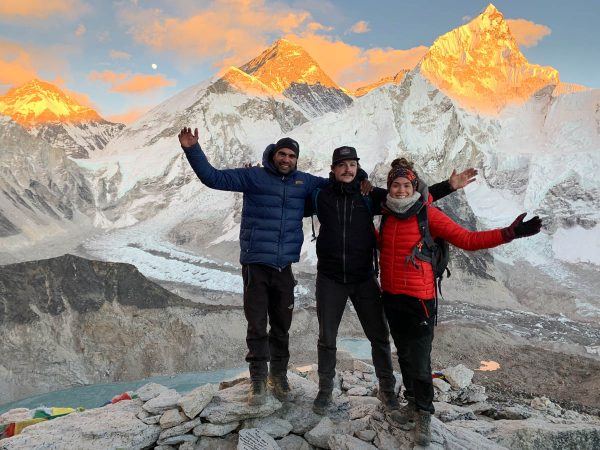
Everest Base Camp Trek
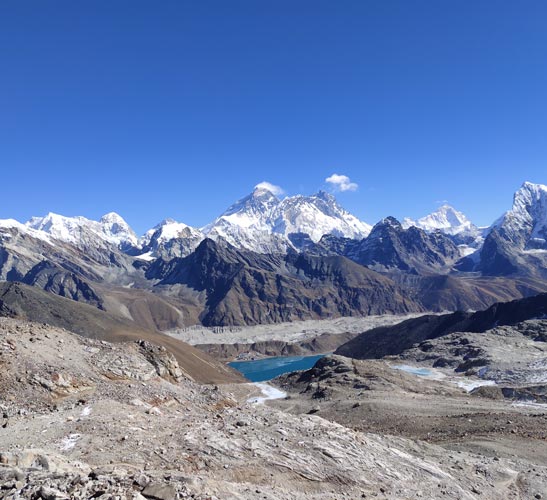
Gokyo and Renjo La Pass Trek
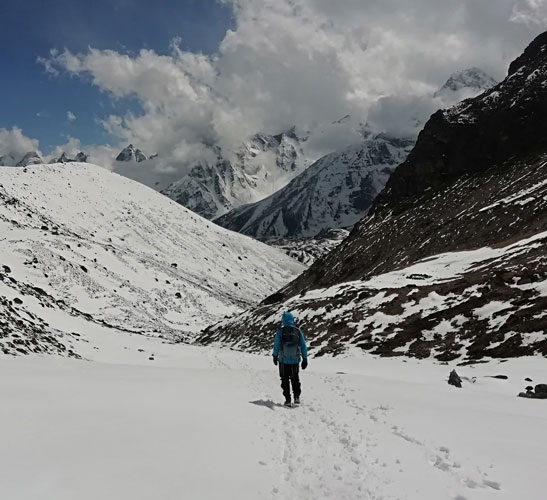
Everest High Passes and Island Peak
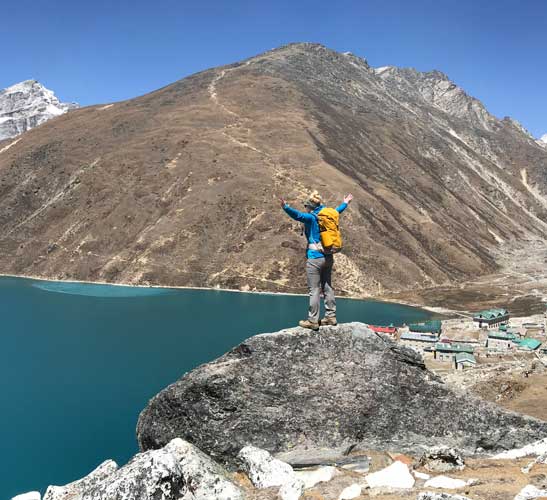
Gokyo to Everest Base Camp Trek
Speak to an expert.
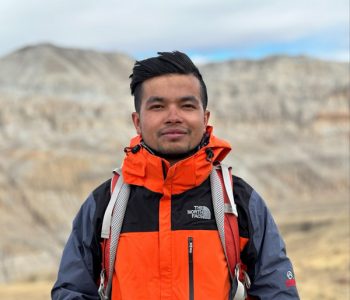
- Availability
Make An Inquiry for
- Full Name *
- Nationality * Nationality Afghanistan Albania Algeria American Samoa Andorra Angola Antigua and Barbuda Argentina Armenia Australia Austria Azerbaijan Bahamas Bahrain Bangladesh Barbados Belarus Belgium Belize Benin Bermuda Bhutan Bolivia Bosnia and Herzegovina Botswana Brazil Brunei Bulgaria Burkina Faso Burundi Cambodia Cameroon Canada Cape Verde Cayman Islands Central African Republic Chad Chile China Colombia Comoros Congo, Democratic Republic of the Congo, Republic of the Costa Rica Côte d'Ivoire Croatia Cuba Cyprus Czech Republic Denmark Djibouti Dominica Dominican Republic East Timor Ecuador Egypt El Salvador Equatorial Guinea Eritrea Estonia Ethiopia Faroe Islands Fiji Finland France French Polynesia Gabon Gambia Georgia Germany Ghana Greece Greenland Grenada Guam Guatemala Guinea Guinea-Bissau Guyana Haiti Honduras Hong Kong Hungary Iceland India Indonesia Iran Iraq Ireland Israel Italy Jamaica Japan Jordan Kazakhstan Kenya Kiribati North Korea South Korea Kosovo Kuwait Kyrgyzstan Laos Latvia Lebanon Lesotho Liberia Libya Liechtenstein Lithuania Luxembourg Macedonia Madagascar Malawi Malaysia Maldives Mali Malta Marshall Islands Mauritania Mauritius Mexico Micronesia Moldova Monaco Mongolia Montenegro Morocco Mozambique Myanmar Namibia Nauru Nepal Netherlands New Zealand Nicaragua Niger Nigeria Northern Mariana Islands Norway Oman Pakistan Palau Palestine, State of Panama Papua New Guinea Paraguay Peru Philippines Poland Portugal Puerto Rico Qatar Romania Russia Rwanda Saint Kitts and Nevis Saint Lucia Saint Vincent and the Grenadines Samoa San Marino Sao Tome and Principe Saudi Arabia Senegal Serbia Seychelles Sierra Leone Singapore Sint Maarten Slovakia Slovenia Solomon Islands Somalia South Africa Spain Sri Lanka Sudan Sudan, South Suriname Swaziland Sweden Switzerland Syria Taiwan Tajikistan Tanzania Thailand Togo Tonga Trinidad and Tobago Tunisia Turkey Turkmenistan Tuvalu Uganda Ukraine United Arab Emirates United Kingdom United States Uruguay Uzbekistan Vanuatu Vatican City Venezuela Vietnam Virgin Islands, British Virgin Islands, U.S. Yemen Zambia Zimbabwe
- Phone Number *
- Email Address *
- Prove your humanity : 9 minus 1 =
- Phone This field is for validation purposes and should be left unchanged.

Trekking in Nepal
Climbing and expedition, cultural tour and sightseeing, cycling and mountain biking, luxury treks, luxury tours, multi country tours, voluntourism trips, extend your trip.
- Everest Panorama Trek – 9 Days
- EBC Trek with Helicopter Return – 12 Days
- Everest Base Camp Trek – 14 Days
- Gokyo Lake Trek – 13 Days
- Gokyo and Renjo La Pass Trek – 14 Days
- Everest Base Camp Trek without Lukla Flight – 17 Days
- Gokyo to Everest Base Camp Trek – 17 Days
- Everest Base Camp with Island Peak – 19 Days
- Everest Three Passes Trek – 20 Days
- Everest High Passes and Island Peak – 23 Days
- Classical Everest Base Camp Trek – 21 Days
- Langtang Valley Trek – 10 Days
- Langtang Valley Ganja La Pass Trek – 14 Days
- Langtang Helambu Trek – 17 Days
- Ghorepani Poon Hill Trek – 9 Days
- Mardi Himal Trek – 10 Days
- Annapurna Base Camp Trek – 13 Days
- Himalayan Highlights – 13 Days
- Nar Phu Valley Trek with Annapurna Circuit – 18 Days
- Annapurna Circuit Trek – 19 Days
- Tilicho Lake Trek With Thorong La Pass – 19 Days
- Khopra Danda Trek – 11 Days
- Shivapuri-Chisapani Trek – 4 Days
- Upper Mustang Trek (Drive & Trek) – 16 Days
- Tsum Valley Trek – 16 Days
- Manaslu Circuit Trek – 15 Days
- Dhaulagiri Circuit Trek – 21 Days
- Upper Dolpo Trek – 25 Days
- Kanchenjunga Base Camp Trek – 29 Days
- Yala Peak Climbing – 13 Days
- Island Peak Climbing – 15 Days
- Mera Peak Climbing – 19 Days
- Everest Base Camp and Lobuche East – 18 Days
- Tent Peak Climbing with Annapurna Base Camp – 18 Days
- Pisang Peak and Thorung La Pass – 21 Days
- Ama Dablam Expedition – 29 Days
- Kathmandu Cultural Heritage Tour – 3 Days
- Kathmandu Heritage – 3 Days
- Inheritances of Kathmandu – 4 Days
- Glimpses of Kathmandu & Nagarkot – 5 Days
- Kathmandu and Pokhara Unveiled – 5 Days
- Explore Kathmandu – 6 Days
- Glimpse of Nepal – 8 Days
- Nepal Heritage Tour – 10 Days
- Nepal Adventure Tour – 11 Days
- Nepal Multi Sports Adventure – 11 Days
- Nepal Vista – 10 Days
- Nepal Highlights – 14 Days
- Experience Nepal – 15 Days
- One Day Biking Trip – Kathmandu – 1 Day
- Annapurna Circuit Biking – 14 Days
- Upper Mustang Biking – 16 Days
- Kathmandu Valley Rim Biking – 8 Days
- Annapurna in Luxury – 9 Days
- VVIP Everest Base Camp Trek – 10 Days
- Everest View Luxury Trek – 11 Days
- Everest Base Camp Luxury Trek – 14 Days
- Everest Base Camp Deluxe Trek – 16 Days
- Mt Everest Base Camp to Gokyo Trek – 19 Days
- Kathmandu Luxury Tour – 3 Days
- Kathmandu and Pokhara Luxury Tour – 5 Days
- Nepal Multi Sport Luxury Adventure – 11 Days
- Best of Nepal – 14 Days
- Trishuli River Rafting – 1 Day
- Everest Base Camp Helicopter Tour – 1 Day
- Everest Base Camp Heli Tour with Gokyo Extension – 1 Day
- Langtang Heli Sightseeing – 1 Day
- Pokhara and Annapurna Heli Sightseeing – 1 Day
- Paragliding in Nepal (Pokhara) – 1 Day
- Scenic Mountain Flight (Everest Flight) – 1 Day
- Ultra Light Flight – 1 Day
- Jamacho Day Hike-One day hiking trip – 1 Day
- Kathmandu Uncovered with Nagarkot – 1 Day
- Day Tour to UNESCO Heritage Sites – 1 Day
- Nepal and Tibet – 15 Days
- Nepal and Bhutan – 15 Days
- India, Nepal and Bhutan – 19 Days
- Nepal, Tibet and Bhutan – 20 Days
- Arupokhari School Volunteer Program – 14 Days
- Rebuild Home Volunteer Program – 9 Days
- Bardiya Jungle Safari – 4 Days
- Chitwan Jungle Safari – 3 Days
Trekking in Bhutan
Festival tours, motorcycling.
- Druk Path Trek – 8 Days
- Chomalhari Trek – 12 Days
- Laya Ghasa Trek – 18 Days
- Bhutan Vistas Tour – 5 Days
- Cultural Heartland Tour – 10 Days
- Hidden Valley – 11 Days
- Bhutan Multi Sports Tour – 11 Days
- Paro Tshechu Festival – 8 Days
- Punakha Tsechu – 9 Days
- Trongsa Lhuntse Tshechu – 9 Days
- Bumthang Tangbi – 11 Days
- Bhutan Ura Yakchoe – 12 Days
- Tamshingphala Choepa – 12 Days
- Mongar and Trashigang – 16 Days
- Bhutan Biking – 8 Days
- Bhutan Motorcycle Tour – 12 Days
Trekking in Tibet
- Tibet Advance Everest Base Camp – 21 Days
- Cho Oyu Expedition – 45 Days
- Shishapangma Expedition – 47 Days
- Everest Expedition via North Side – 63 Days
- Kathmandu and Lhasa Tour – 7 Days
- Tibet Heritage Tour – 8 Days
- Overland Tour to Everest Base Camp – 10 Days
- Mount Kailash Mansarovar Lake Tour – 15 Days
- Everest Base Camp Biking Tour – 21 Days

- Everest Region
- Annapurna Region
- Manaslu Region
- Langtang Region
- Makalu Region
- Kanchenjunga Region
- Dolpo Region
- All Tours and Activities
- Nepal Trekking
- Nepal Yoga Retreat
- Nepal Cultural Tour
- Nepal Climbing
- Nepal Heli Tour
- Nepal Jungle Safari
- Everest Flight Tour
- Spa Package in Kathmandu
- Nepal Biking Tour
- Nepal River Rafting
- The Life and Legacy
- About Nepal Hiking
- Official Documents
- Vision Statement
- Responsible Travel
- Testimonials
- Tailor Made Holidays
- Become a Partner
- Terms & Conditions
- Privacy Policy
The Three Passes Trek : Exploring Nepal’s Everest Region
- Guided Small Group Departure It's a guaranteed departure
- Guided Private Departure Contact through the Enquiry Form to check the availability of private departures.
Proceed Booking
Already a member, don't have an account create one., or continue as guest, adding item to wishlist requires an account, latest news and articles, stay updated with the latest news and exclusive offers.
Estimated reading time: 2 minutes
Embarking on a once-in-a-lifetime journey, the Everest Base Camp Trek through the three high passes of Renjo La, Chola, and Kongma La commences in Lukla (2804m), where you’ll take a flight from Kathmandu. The flight itself is incredibly short and rarely takes more than 35 minutes; this gives you time to take in the glorious green, peaked terrain and promises to be an exhilarating flight you won’t forget.
Once you reach Lukla Airport , the trek begins, and you will trek to Phading (2610m), a nice local settlement. On the second day, you’ll trek to Namche Bazaar (3400m), a unique hillside village. At just over 3400m above sea level, it’s an ideal spot for acclimatization, higher than many are accustomed to without reaching the trek’s dizzying heights. The trek then heads towards Thame and then Nangpa Valley.

Three Passes Trek of Everest Base Camp
After this, you’ll encounter Renjo La (5340m) – the first of the three high passes – particularly challenging. Therefore, a good level of fitness is vital while crossing the passes. After crossing the Renjo La, you’ll have a stunning view of Mt. Everest and the Crystal Gokyo Lake.
During your stay at Gokyo Lake, you’ll spend two nights exploring the hidden valley. This includes visiting the 4th Lake and a half-day hike to Gokyo Peak (5483m). You will then cross the 2nd Pass – Cho La (5420m) in a 2–day trek, rejoin the main Everest trail and head towards Lukla Airport. You’ll then trek downwards to Lobujue before making your way to Kongma La (5400m), the last of the high passes, followed by the summit of Chukhung, the final peak. Here, you’ll find unparalleled views of the North Ridge, the surrounding area, and Cho Oyu.
Return to Lukla after successful completion of the Three Passes Trek
Coming around in a full circle, it brings you back to Lukla through many villages rich in culture and tradition, such as Dingboche, Pangboche, Thyangboche, Namche Bazar, Manjo and Phakding. Once back in Kathmandu, you’ll have a chance to discover the city properly, get a hotel to rest in or allow yourself to take in what you’ve just achieved.
Essential Permits for Three Passes Trek
Securing permits is crucial for trekking through Nepal’s Three Passes region, renowned for its breathtaking landscapes. Here’s what you need:
Firstly, obtain the TIMS Card, mandatory for all trekkers, aiding in safety and emergencies. Secondly, the Sagarmatha National Park Permit for park entry should be secured to support conservation efforts. Lastly, acquire the Khumbu Rural Municipality Entry Permit for accessing Khumbu region trails. Obtain these permits through authorized agencies or government offices in Kathmandu or trekking starting points, such as Lukla. Throughout your journey, ensure compliance with regulations and conservation practices by carrying them along.

Related Links
- Discovering Nepal’s Majestic Mountain Passes: A Trekker’s Paradise
- Langtang Valley and Gosaikunda Lake Trek- Discovering Himalayan Majesty
- Gokyo Lake Trek
- Dhaulagiri Base Camp Trek
- The Everest Base Camp Trek with Premium Accommodation and Helicopter Travel
Tour Details
Departure & return location.
Kathmandu Suite Home, Thamel ( Google Map )
Departure Time
Between 7-8 am
Price Includes
- Airport pick up and drop off
- Accommodation in Kathmandu, including breakfast (pre and post-trek)
- Accommodation at guest houses during the trek
- Meals during the trek (breakfast, lunch and dinner)
- Friendly English-speaking guide and strong porter (sharing between 2 members)
- Entrance Fees (National Park, TIMS and Local Government Fee)
Price Excludes
- Tipping for guide and porter
- Any private expenses
- Any bottled drinks (including tea/coffee, mineral water etc.)
- Trekking items (sleeping bag etc.)
- Travel Insurance
Complementaries
- Company T-Shirt
- Trekking Duffle Bag
What to Expect
The route to Everest Base Camp is said to be one of the most gruelling treks around, covering over 60km and climbing up to 5545m, and none are more challenging than this 3 passes trek. Test yourself by trekking with us through the high passes – Renjo La, Cho La and Kongma La – which tower at over 5,000m each and aren’t featured on the standard Everest Base Camp (E.B.C.) trek.
- Better than the best adventure trek in Khumbu Region for Adventure lover
- Unbeatable views of the Himalaya Ranges from 3 Passes
- Amazing crystal view of Gokyo Lake
- Pyramid view of Mt. Everest
Day 1 Arrive in Kathmandu, Nepal
Upon arrival, you’ll be assisted and escorted to the hotel. Breakfast included.
Day 2 Fly to Lukla (2800m) and trek to Phakding (2610m)
Fly to Lukla and then embark on a 3-hour trek to Phakding. Spend the night at a local lodge, with meals including breakfast, lunch, and dinner.
Day 3 Namche Bazar (3400m)
Trek from Phakding to the bustling Namche Bazar. Spend the night at a traditional local lodge, with meals including breakfast, lunch, and dinner.
Day 4 Acclimatization day
Day of acclimatization in Namche with a hike to Khumjung and Khunde for breathtaking Everest views. Stay the night at a local lodge; meals are provided: breakfast, lunch, and dinner.
Day 5 Trek to Thame (3820m)
Journey to Thame (3820m) through Phurte and Thamo. Spend the night at a local lodge with breakfast, lunch, and dinner included.
Day 6 Trek to Lungden (4350m)
From Thame, climb to the higher altitudes of Lungden at 4350m, traversing the majestic Himalayan landscapes. Stay overnight in a local lodge with meals: breakfast, lunch, and dinner provided.
Day 7 Acclimatization day
Acclimating at Lungden, take a day trip to the viewpoint for breathtaking views of the Renjo Pass range and the mountainous borders of Tibet. Overnight at a local lodge, with breakfast, lunch, and dinner included.
Day 8 Renjo La Pass (5340m) and Gokyo Lake (4790m)
Trek via the Renjo La Pass (5340m) to reach Gokyo Lake (4790m), with a stunning view of Mt. Everest en route. Stay the night at a local lodge with breakfast, lunch, and dinner provided.
Day 9 Hiking to Gokyo Ri (5483m)
Early ascent to Gokyo Ri (5483m) and a return to Gokyo Lake for lunch. The trek then progresses to Dragnag (4700m) through the Ngozumpa Glacier. Overnight stay at a local lodge, with breakfast, lunch, and dinner included.
Day 10 Cho La Pass (5420m) and Dzongla (4830m)
Trekking through Cho La at 5420m to reach Dzongla at 4830m. Stay the night at a local lodge with breakfast, lunch, and dinner provided.
Day 11 Trek to Gorakshep (5140m)
Journey to Ghorak Shep at 5140m, passing through Labuje at 4910m. Spend the night at a local lodge with breakfast, lunch, and dinner included.
Day 12 Trek to Everest Base Camp (5400m)
Embark on a trek to Everest Base Camp at 5400m, then head back to Gorak Shep at 5140m. Stay the night at a local lodge with breakfast, lunch, and dinner provided.
Day 13 Kala Pathar Hiking (5545m)
Ascend to Kala Pathar at 5545m to witness the majestic Mt. Everest standing tall at 8848m. Afterwards, make a descent to Gorakshep for a midday meal, followed by a further descent to Labuje at 4910m. The night is spent in a local lodge, complete with breakfast, lunch, and dinner.
Day 14 Kongma La (5400m) and Dingboche (4360m)
Journey across the Kongma La at 5400m, leading to Chhukung (4750m) or Dingboche at 4360m. The evening is reserved for relaxation at a local lodge, with meals covering breakfast, lunch, and dinner.
Day 15 Trek to Tengboche (3867m)
Navigate through Pangboche on the way to Tengboche at 3867m. Spend the night at a local lodge with breakfast, lunch, and dinner provided.
Day 16 Trek to Monjo (2800m)
Journey through Namche Bazar en route to Monjo (2800m). Stay the night at a local lodge with meals covering breakfast, lunch, and dinner.
Day 17 Trek to Lukla
Follow the Dudh Koshi River as the path leads to Lukla. Settle in for the night at a local lodge, with meals including breakfast, lunch, and dinner.
Day 18 Return to Kathmandu
Taking a morning flight back to Kathmandu, with an overnight stay at the hotel. Breakfast included.
Day 19 Leisure day in Kathmandu
Additional days are reserved in Kathmandu to account for potential flight delays. Stay overnight at the hotel with breakfast included.
Day 20 Departure
Proceed to the airport for your onward journey.
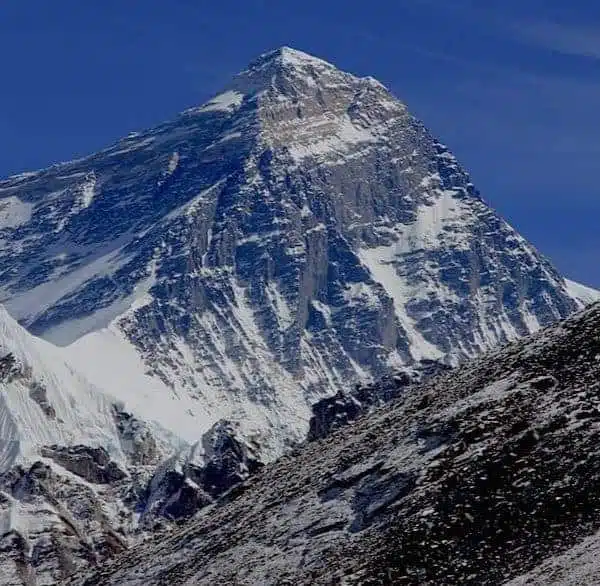
Related Tours

Nagarjun Hill Day Hike: Journey to Nature’s Serene Balcony

Everest View Flight Tour
Bill Passman
Namaste Tilak
I just wanted to thank you and your wonderful staff for my incredible trip to Gokyo Ri, Chola Pass, Kalapathar, and Everest Base Camp. It was the best trip of my life. I especially want to thank my guide, Ram, and porter, Santos, who made the trip much easier than ever imagined. The scenery was incredible and will forever be remembered by me. Your staff in Kathmandu was always there to ensure everything was running smoothly. After talking to those on the trail who did not have guides or porters about their difficulties, I cannot imagine even attempting the trip without my wonderful help.
I also had a great time on the tour of Kathmandu, river rafting, and Chitwan National Park. It was a great way to end my trip. The hotels in Kathmandu and Chitwan were especially nice. I did not expect such luxury at such a great price.
I look forward to returning to Nepal to do the Annapurna Circuit. I look forward to seeing everyone again.
Thanks again.
BILL PASSMAN NATCHEZ Mississippi, USA
- Government Registered No: 113188/070
- Tourism No: 1599
- VAT No: 601221723
Nepal Eco Adventure
Committed To Be Eco Friendly!
- +977 9851170646 (Chhatra)
Everest Three High Passes Trek
Everest region is known all around the world for its incredible Himalayan trekking routes. While the Everest Base Camp trek is quite famous, there are other trekking opportunities in the area. Everest Three High Passes Trek is a spectacular trekking package in the beautiful Everest region.
This trek package from "Nepal Eco Adventure" takes you through various natural landscapes. Trekkers will pass through high mountain passes, serene rivers, glacial lakes, and other landmarks of Sagarmatha National Park.
Sherpa, Bhotiya, Walangpa, and Tamang are the ethnic groups in the majority in this region. Moreover, you will also get to explore various Buddhist monasteries, village settlements, and others along these trails. This trek takes you through three high mountain passes, including Kongma La Pass (5,535m), Renjo La Pass (5,385m), and Cho La Pass (5,360m).
This trek will take you to other significant landmarks of this region, including Mt. Everest Base Camp (5364m), Kalapathar (5,643m), Gokyo lakes, and others. This Everest Three High Pass trek itinerary starts from the capital city Kathmandu and takes you to Lukla on a flight.
Lukla is the entry point of the Mount Everest region for many adventurous activities like trekking and peak climbing. Phakding is our next destination on this trek. Phakding is a beautiful Himalayan settlement from where you will continue your trek to Namche Bazaar.
Moreover, the trails pass through the natural pathways of Sagarmatha National Park. There are forest trails of Rhododendron, Pine, and Oak trees. The beautiful town is a commercial hub of the region with many cafes, hotels, pubs, restaurants, and souvenir shops. The Sherpa culture and heritage will enchant travelers.
Tengboche is our destination from Namche, which is famous for the ancient monastery. Then, you will continue your journey trekking through various settlements of Dingboche. From there, we head towards Chukkung. We will finally cross Kongma La Pass to arrive at Lobuche.
We will trek from Lobuche along beautiful trails to arrive at the settlement of Gorak Shep. You will then start your trek to Everest Base Camp, where you can observe the entire vista of snow-capped mountains. There you can find colorful tented camps of climbers, especially if you travel in peak seasons.
The trail of this trek is quite challenging as you will need to trek uphill and downhill at regular intervals. Trekkers will then hike to Kala Patthar (5545m) early in the morning to get gorgeous views of Himalayan sunrise. Mt. Everest (8848.86m), Khumbutse (6636m), Pumori (7161m), Lingtren (6749m) and others are some of the mountains observable from Kalapathar.
After arriving at Kalapathar, you will explore around and take incredible pictures of the region. You will then trek to Dzongla from Kalapathar. From there, you will cross the majestic Chola pass to arrive at Dragnak. You will then travel to various Gokyo lakes and rest at Gokyo village.
From Gokyo, you will arrive at Lungden by passing through Renjo la pass. Thame is our next stop from where we will make our way to Namche Bazar. The final day of the trek takes you to Lukla from where a flight will lead you to Kathmandu. Besides that, you can also observe the endangered animal species like Snow leopard, Musk deer, Red panda, and others.
Overall, this incredible trek is an exciting way to explore nature trails and observe snow-capped Himalayan vista. This extensive article covers the Everest Three Passes trek itinerary and other topics in detail.
Note: Want to explore the city of the temple (Kathmandu) with us? If so, we have 19 days Everest Three Passes trek itinerary package @ USD $ 1950
Highlights of the Trip
- Spectacular Himalayan sunrise and sunsets overlooking the snow-capped mountains from Kala Patthar.
- Passing through three high mountain passes of the region
- Experiencing the Everest Base Camp where climbers camp in colorful tents
- Scenic mountain flight observing majestic mountain vista
- Exploring Namche Bazaar and its surroundings.
- Passing through natural landmarks of the area.
- Exploring Tengboche monastery and other Buddhist heritages.
- Exploration of Sherpa culture and heritage
Day 19: Departure
What is included.
- Three meals a day (Breakfast, Lunch and Dinner) with a cup of hot drink( Tea/Coffee).
- Fresh fruits every night after dinner.
- Trekking lodge(Tea house)accommodations during the trek.
- Sagarmatha National Park Permit Khumbu Pashang Lhamu Rural Municipality fees.
- Kathmandu-Lukla-Kathmandu flight including airport transfer( High season flight to and from Lukla are operated from Ramechhap airport which is 4-5 hours east of Kathmandu)
- English speaking well trained, Government license holder guide with all his salary, food, drinks, accommodation, Transport and insurance.
- A Strong, helpful porter with proper equipment including his meals,accommodation and insurance (one porter for two people).
- Arrangement of Emergency Helicopter service (paid by your Travel insurance company).
- Use of sleeping bag, down Jacket and walking Poles (if you don’t have your own, To be return after trip completed). Using these 3 items you pay $10 USD each as maintenance and washing charge.
- Nepal Eco Adventure T-shirt, cap and duffel bag.
- Government taxes, service charge and official expenses.
- Oxymeter to check your pulse and oxygen saturation and heart rate twice daily (Very useful to check Altitude Mountain Sickness(AMS) symptoms) Which will ensure you trek is in the safest hands possible for all levels of trekker.
- Assistant guide group size above 6+ person.
What is Excluded
- Airport pick up and drop for international flight.
- Hotel and Meals whilst in Kathmandu Lunch and Dinner.
- Nepal entry visa fee $50 USD for 30 days visa on arrival.
- International airfare.
- Travel and medical insurance (recommended).
- Your personal expenses.
- Alcoholic and non alcoholic cold and hot drinks.
- All desserts and sweet things like,chocolate, cake, pie and pudding. ( i.e. those you choose to purchase along the way and during evenings in the Tea Houses).
- Hot shower and battery charging during the trekking.
- Tips for the guide, porter and driver (Tipping is expected).
- Excess baggage more than 15kg for Lukla flight.
Join Our Fixed Trip Starting Date
Load More Show Less
The maximum point of Everest Three High pass Trek is Kalapathar at 5643 meters. Besides that, the Everest base camp and three passes are above 5000 meters.
The Everest 3 Passes Trek is relatively challenging than the regular Everest Three High Passes Trek. The rough and steep trails can get complicated, especially for first-time trekkers. You should prepare well for this trip as there are uncertain weather conditions in these high altitudes.
This Everest Three Passes Trek itinerary is 16 days long but you can customize the itinerary as per your free days and willingness to spend the time on Mountains.
The Everest Three High Pass Trek routes are off-beat with some steep climbs. This makes the trail challenging but not impossible. With proper preparation, guidance, and trekking equipment, you can complete this trek with ease.
Altitude sickness is quite common in high-altitude regions due to the changing altitude. Therefore, proper acclimatization and rest are essential to tackle altitude sickness along these trails. Besides that, you should also remain hydrated along these trails. You should avoid smoking and drinking alcoholic products to prevent altitude sickness. The "Diamox" tablets also help you to tackle symptoms of altitude sickness along these trails.
The Everest Three High Pass trek requires proper fitness and stamina. Hence, you should perform some physical exercises, cardiovascular exercises, and others to remain fit for the trek. You should also keep yourself positive, as mental fitness is essential to complete this high-altitude trek.
The Everest Three High Pass trek Permits are the Sagarmatha National Park Entry Permit and the Pasang Lhamu Rural Municipality Entry Permit.
The accommodation facilities in this Everest Three High Passes Trek are in teahouses. The room includes twin beds, a mattress, a pillow, and a warm blanket. You can get hot showers and electronic charging at some lower region teahouses if you pay extra.
You will get served traditional Nepali Dal Bhat along with these teahouses for lunch and dinner. You can get eggs, bread, and hot beverages like tea, coffee, garlic soup, and others in the tea houses.
Spring and Autumn are ideal for the Everest Three High Passes trek as they provide stable weather conditions and moderate temperature. This Spring season starts from March and lasts till May, whereas the Autumn season starts from September and lasts till November. You will get clear blue skies in this season and majestic views of snow-capped mountains. You can trek without the hassle of any unpredictable weather conditions.
For the Everest Three High Passes trek, you will require trekking boots and trekking clothes. You can also rent this trekking equipment if you do not wish to buy it. You should carry your sleeping bags as blankets in these teahouses are not enough in frigid climates.
The starting point of this trek is Lukla, from where we will trek to Phakding. Moreover, the ending point of this trek is Lukla as well.
The Everest Three High pass trek cost around $1700. The cost of food, accommodation, and domestic transportation gets included in these costs.
The Everest Three High Passes is not recommended to trek solo. It is a challenging high-altitude trek with many ups and downs in rugged and remote terrains. Therefore, you should only trek with a licensed trek guide.
Guides and porters are essential for this Everest three-high passes trek. They will help you navigate these trails. They will provide you with cultural exploration opportunities by providing local insights and translation of local languages. Porters carry your heavy luggage along these trails so that you can trek without any hassle.
Yes, travel insurance is a must when it comes to high-altitude Everest region treks. This high-altitude trek is quite challenging and full of various risks. Hence, you need to get proper travel insurance to cover all these, including medical injuries, altitude sickness, accidents, property loss, thefts, and others.
Best Season for Everest Three High Passes Trek
This high-altitude trek in the Everest region is ideal in peak seasons. Autumn (September-November) and Spring (March-May) are two peak seasons for trekking. There are stable weather conditions throughout these seasons. They come with moderate temperatures and climate, making for perfect trekking conditions.
Weather in Spring
Spring is ideal for trekking and other adventures in the region. This season brings stable weather and less rainfall. Moreover, there are moderate temperatures in the daytime. A serene trekking environment makes this trek quite favorable in Spring. Trekkers will get to hike in a peaceful environment. There are no such challenges of heavy rainfall, snowfall, avalanches, landslides, etc.
Weather in Autumn
Autumn is another beautiful time for trekking in the Everest region. There is less precipitation and other challenges like floods and landslides in the area. There is stable weather throughout, with daytime temperatures ideal for trekking and traveling. Besides, it is also a festive time and hence also the perfect time for cultural exploration. There is an incredible atmosphere with locals busy in their festivities.
Offseason treks
The off-season treks in winters and monsoons are pretty challenging. The weather remains quite unpredictable, with heavy rainfalls and snowfall. There are extreme cold conditions in winters with heavy snowfall. High precipitation with floods, landslides, and avalanches are typical in the monsoons.
Hence, you should choose the peak seasons of Spring and Autumn for a safe and comfortable trekking experience. However, if you want to take off-season treks, you should prepare and pack well.
Everest Three High Pass Trek Difficulties
This Everest Three High Passes trek passes through remote and rugged trails that move up and down a lot. These challenging terrains in the diverse Himalayan landscapes take you through high-altitude mountain passes.
Altitude sickness is a significant problem in these trails. Hence, acclimatization is necessary while trekking in these high-altitude terrains. Moreover, proper rest and regular hydration are essential as well. Diamox tablets will help you tackle altitude sickness symptoms.
Moreover, the steep and harsh terrains can get quite strenuous even for highly experienced trekkers. Trekkers must have proper strength, stamina, and endurance to complete this trek with ease. Accommodation facilities in teahouses and lodges are pretty basic. Hence, you need to compromise along these trails in these aspects.
Food ingredients must get transported through porters or yaks high up in these trails. Hence, there is a limited variety, and they cost you more as you move up. Besides that, you will also need to face unexpected challenges of unpredictable weather, including heavy rainfall, snowfall, landslides, and others. With packing, preparation, and training, you can complete this trek with ease.
Why Take Everest Three High Passes Trek?
Spectacular view of himalayan vista.
This incredible trek in the Everest region provides you with majestic views of snow-capped mountains. Some of the mountains you can observe are Mt. Everest (8848.86m), Lhotse (8414m), Nuptse (7861m), Khumbutse (6636m), Lingtren (6749m), Pumori (7161m), etc.
Besides, you can also observe other natural landmarks of this region. There are green hills, mountain valleys, serene waterfalls, icy glaciers, and lakes as well. Hence, these incredible views of the Himalayan vista are a highlight of this trek.
Exploration of local culture
Cultural exploration is another excellent aspect of this trek. These trails pass through various Buddhist monasteries, mani walls, chortens, gompas, and other settlements. These cultural landmarks of this region make this trek stand out among others.
Besides, you can also experience a festive atmosphere, especially if you travel in the Autumn season. Locals will also get the best views of ancient trails with Sherpa settlements. You can interact with locals and learn about their rural traditions and lifestyle. This incredible culture and heritage make this trek quite appealing among travelers.
Wildlife exploration
Trekkers can also explore flora and fauna of these Everest regions. Moreover, there is various rare and endangered wildlife in these regions. These include Himalayan Tahr, red panda, snow leopard, danfe, munal, etc. You will traverse through forested trails with green vegetation and herbs all around. There are beautiful trails that will provide you with a spectacular trekking adventure.
Safe travel
We have a highly experienced team who will conduct this trek in the Everest region. A safe journey with proper logistics makes this trek quite popular among trekkers. There are safety protocols in place that provide you services in case of an emergency. First aid for medical emergencies and proper evacuation is available as well. Hence, this incredible Everest Three High Passes Trek is ideal for you.
Food and Accommodation in the Trek
The food and accommodation is another aspect that you must consider before taking on this high-altitude trek. You will stay in these tea houses and lodges along these trails. These tea houses are ideal places to stay along trails as they will provide you with warmth and safety.
Moreover, they provide you with a warm meal during your stay. There are various facilities in these teahouses, including twin beds, a pillow, a mattress, and a warm blanket. Besides that, there are squat-style toilets generally located outside of these outsides. There are various facilities like WiFi, hot water, electronic charging, and others at an added cost.
"Dal Bhat" is a staple dish that gets served along with these teahouses twice a day for lunch and dinner. This includes rice, dal, lentils, vegetables, pickles, meat, and others. You will get served various items like bread, eggs, and porridge for breakfast in these teahouses. Hot beverages, including tea, garlic soup, coffee, noodle soup, are pretty standard in the region.
Moreover, some tea houses have other cuisine and food items varieties, especially in lower regions. This includes momo, noodles, chowmein, thukpa, and others. Besides that, you can also carry various snacks, including protein bars, chocolate bars, dry fruits, and others.
Things to Consider for Everest Three High Passes trekking
Trekking guide.
Trekking guides will help you with various aspects of your Everest Three High Passes adventure. These trails of this trek pass through rugged terrain. Hence, there are high chances of trekkers getting lost, and another injured along these trails. Hence, professional trekking guide assistance is ideal for these treks. Navigating along these trails gets more accessible with a licensed professional guide on your side.
These professional guides will also take you on a cultural exploration around the region. They will help you interact with locals by translation and provide local insights around the area. Besides that, porters will carry your heavy luggage so that you can trek without any hassle along these trails.
Acute mountain sickness
Altitude sickness is quite common in the Everest high altitude region. In these high-altitude terrains, you will get lower oxygen levels and air pressure. Hence, you should acclimatize well to tackle this acute mountain sickness. Regular hydration is also required as lack of proper water intake is a primary cause of altitude sickness.
The altitude sickness can get quite severe and even fatal if not taken seriously. High-altitude conditions, therefore, require proper consideration in all aspects. You should also avoid alcoholic beverages along these trails as it can lead to altitude sickness. Besides that, professional guides will help you set up acclimatization points to explore the region with ease.
Trek Permits
Trek permits are also essential for this high-altitude trek in the region. Trekkers will pass through Sagarmatha national parks and conservation areas during the trek. Therefore, you should get these Pasang Lhamu rural municipality permits and Sagarmatha National Park during this trek. Trekkers can obtain this permit at the Nepal tourism board's office in Kathmandu.
Fitness and stamina
A basic fitness and stamina level is essential when it comes to high-altitude trekking. Therefore, you should train well with proper physical exercises. This includes strength and endurance training and cardiovascular exercises that include aerobic and flexibility exercises.
Besides that, you should also have mental preparation and maintain a positive attitude during these trials. You can perform practice hikes along these regions and other activities, including cycling, jogging, swimming, and others. You can also perform exercises with weights.
- Travel insurance
Travel insurance is essential for this Everest three high pass trek. Travel insurance coverage includes various headings like accidents, medical injuries, loss, theft of property, and others. Moreover, helicopter evacuation in these high-altitude trails would cost around $4000 to $5000. Therefore, proper travel insurance is essential for this Everest three-high passes trek.
Everest Three High Passes Trekking Permits.
Trekking permits are essential in all trekking destinations in Nepal, including this Everest Three high passes trek. Therefore, you should get these permits in advance before starting on this trek. These trekking permits include the Sagarmatha National Park permit and the Local area Pasang Lhamu Rural Area Permit.
Sagarmatha National Park permits cost NRs. 100 per person for Nepalese NRs. 1,500 per person for SAARC nationals, and NRs. 3,000 per person for foreign nationals. It is free for children below ten years.
Khumbu Pasang Lhamu Rural Municipality permit costs USD 20 per person per week for the first four weeks. It then costs USD 25 per person per week after that. A TIMS (Trekking Information Management System) permit is not required for trekking in the Everest region.
Everest Three High Passes Trek Cost
This Everest Three High Passes trek cost includes meals, accommodation, trekking permits, and others. The accommodation facilities along the trail cost around US$3 - US$5 per night in these tea houses. Guides cost around US$ 20 to US$ 25 per day, whereas porter's cost around $15-$20 in the region.
The food costs are relatively high as they need to get transported along these Himalayan routes through porters and yaks. They will cost you around $15-$20 per day. These costs include salary, food, accommodation, and insurance for these trekking guides and porters.
However, if you trek with us, you don't have to worry about these logistics as they get included in the package. Overall, Everest Three High Passes Trek Cost is around $1700.
Training Routine for Everest Three High Pass trek
This Everest Three High Passes trekking requires proper training before you start on your trek. Adequate strength and endurance training are essential to building your stamina and fitness.
Therefore, you should start training for your trek at least a couple of months before this trek. The training routine should include physical exercise, cardiovascular exercises, and mental preparation.
Strength and endurance training
Physical exercises are essential to gain physical fitness along these trails. They help you build your strength and stamina. You can trek for a long duration with the help of these physical activities. Moreover, these exercises will increase your flexibility and decrease the risk of trekking in high-altitude terrains.
You will also gain muscles in the arms, shoulders, and legs if you train well. You can prepare well with a trainer and also use weights if required. Practice hikes are essential for this trek as well.
Cardiovascular exercises
The cardiovascular or aerobic exercises will help you remain flexible and complete these rugged treks with ease. The activities you can do include hiking, swimming, cycling, jogging, and others.
These aerobic activities will help you, especially in low oxygen conditions. Squats, push-ups, pull-ups are some forms of these activities. Overall, these exercises will help you complete your trekking on the high mountain passes with ease.
Mental exercises
Mental strength is an essential aspect of any trekking journey, especially in high-altitude conditions. Trekkers require a positive attitude to trek alongside some rugged terrains for a long duration. Hence, proper mental preparation will give you an overall idea of the Everest Three Passes trek itinerary, routes, and risk factors.
You can get the opinion of veteran trekkers, take practice hikes, and research on the internet. The self-motivation and motivation of guides will help you push through rugged terrains. Overall, you can complete these difficult terrains with the help of good mental preparation ahead of this trek.
Essential Tips for Everest Three High Passes trek
- You can also rent these trekking gear from various shops in and around Thamel in Kathmandu
- Wear warm clothes and carry proper trekking gear along this Himalayan trek.
- Add extra days to your trip as unpredictable weather can lead to delays and cancellations.
- Start your trekking journey early.
- Carry water purification tablets and water bottles for hydration
- Adequate acclimatization and regular hydration will lead you to success in this trek.
- Carry sunscreens and sunblocks to tackle sunburns as harsh sun rays are reflecting from silver mountains.
- Advance book all your meals and accommodations
- Hire trekking guides to keep you safe and navigate along these trails
- Get travel insurance coverage for a safe and convenient adventure.
Packing List - Everest Three High Passes Trek
- Trekking pants
- Trekking boots
- Trekking shirts
- Down jacket
- Waterproof jacket
- Fleece jackets
- Thermal wears
- Woolen trekking socks
- Warm woolen cap
- Windproof jacket
- Woolen gloves
- Water purifying tablets
- Anti-nauseant medication
- Rehydration salts
- Insect repellent
- Quick-dry towel
- Toilet paper
- Power Banks
- Solar Charges
- Extra Batteries
- Local SIM card
- Reusable water bottles
- Everest Three High Passes Trek Map
Important documents
- Everest Three High Pass Trek Permits
Nepal is a beautiful Himalayan nation with incredible natural beauty. These foothills of the Himalayas provide you with an adventure of a lifetime. The Everest Three High passes trek in Nepal is an off-the-beaten adventure.
This trek is ideal in peak seasons of Spring and Autumn. Trekkers will get the best weather conditions with minimal precipitation in these seasons. The monsoon and Winter seasons are pretty challenging. But if you want some adventure, you can trek in these seasons too.
This trek is relatively difficult when compared to regular EBC trek. The trekkers need to have a basic level of fitness and stamina to complete this trek in the Everest region. Besides that, mental preparation and a positive attitude during these trials are a must. Everest Three High Pass Trek is ideal for all, but previous high altitude trekking experiences can come in handy.
Moreover, the incredible routes allow you to explore the natural terrains of the region. The unique trekking experience will enchant any traveler. Contact us at Nepal Eco Adventure for the Everest Three Passes Trek itinerary and book your trip now. Have a safe journey!
Write a Review Cancel reply
Thank you. Your review will appear after admin approves it.
Please fill all the fields.
Your email address will not be published. Required fields are marked *
Review Title*
Date Of Experience
Photo Gallery Invalid File Type. Supported File Type: JPEG/JPG, PNG. Drop your Image or click to browse Supported file : JPG, PNG, GIF
Save my name, email, and website in this browser for the next time I comment.
You Can Send Your Inquiry via The Form Below.
Send your inquiry via the form below, we will reply to your email as soon as possible.
- Full Name *
- Contact No.
- Trip Type * Select Trip Type Private Group Joining
- No of Travelers *
- When Will You Be Travelling? Day 1 2 3 4 5 6 7 8 9 10 11 12 13 14 15 16 17 18 19 20 21 22 23 24 25 26 27 28 29 30 31 Month 1 2 3 4 5 6 7 8 9 10 11 12 Year 2025 2024 2023 2022 2021 2020 2019 2018 2017 2016 2015 2014 2013 2012 2011 2010 2009 2008 2007 2006 2005 2004 2003 2002 2001 2000 1999 1998 1997 1996 1995 1994 1993 1992 1991 1990 1989 1988 1987 1986 1985 1984 1983 1982 1981 1980 1979 1978 1977 1976 1975 1974 1973 1972 1971 1970 1969 1968 1967 1966 1965 1964 1963 1962 1961 1960 1959 1958 1957 1956 1955 1954 1953 1952 1951 1950 1949 1948 1947 1946 1945 1944 1943 1942 1941 1940 1939 1938 1937 1936 1935 1934 1933 1932 1931 1930 1929 1928 1927 1926 1925 1924 1923 1922 1921 1920
- Your Message *
This trip is fully customizable
- Have a big group? We can help.
- We can customize your trip as per your request
- We can help you make fit it your all the itinery
Trek’s Route Map
- Trip Destination: 16 Days Everest Three High Passes Trek
- Difficulty: Challenging
- Group Size: Minimum 02 person
- Best Season: March-June and September-December.
- Maximum Altitude: 5545m
- Transportation: Aeroplane & Car
- Trip Code: NEA-EsT-04
Certificate of Excellence
Travel info.
- Getting Tourist Visa for Nepal
- Trekking in Nepal- Complete Guide
- Visa Info and Religions in Nepal
- Visa Information
- Responsible Tourism
- Trekking Seasons in Nepal
- Trekking Guide & Porter on Hire
- Trekking Equipment
- Altitude Sickness
Related Trips
Bardiya national park jungle safari, pachermo peak climbing, nar phu valley trek, kathmandu heritage tour, honeymoon tour in nepal, dhaulagiri circuit trekking.
Screen Rant
Giveaway: win a pair of 3-day passes to fan expo philadelphia.
We're going to FAN EXPO Philadelphia and want you to go too! Here's how to enter for a chance to win a pair of tickets!
- We're giving away 3-day passes to FAN EXPO Philadelphia with a star-studded guest list including Rosario Dawson and Hayden Christensen.
- Enter our giveaway for a chance to attend the event on May the 4th weekend and meet Star Wars talent in person.
- Join us at FAN EXPO Philadelphia for comics, sci-fi, horror, anime, gaming, and cosplay fun with 50,000 expected attendees.
Three days of fun-filled, fan culture begins next week at FAN EXPO Philadelphia and we'll be there helping host celebrity Q&As and conducting interviews. We want you to be there too, so we're going to give away passes!
We've partnered with FAN EXPO to host a giveaway for a pair of 3-day passes to the event taking place of May the 4th weekend, and the timing couldn't be better with a guest list packed with incredible Star Wars talent including Ahsoka stars Rosario Dawson, Hayden Christensen, Natasha Liu Bordizzo, Jedi: Fallen Order and Jedi: Survivor star Cameron Monaghan, and voice talent behind The Clone Wars , Rebels , and The Bad Batch !
How To Enter Screen Rant's FAN EXPO Philadelphia Giveaway
If the widget doesn't appear, enter here .
FAN EXPO Philadelphia Schedule
If you're into comics, sci-fi, horror, anime, gaming, or cosplay, come share our playground. You'll feel out of this world – and right at home. 50,000 in attendance are expected at FAN EXPO Philadelphia this year!
Buy Tickets
Show Hours:
- Friday 4 PM – 9 PM^
- Saturday 10 AM – 7 PM
- Sunday 10 AM – 5 PM
^ Special Preview on Friday at 2 PM for VIP, Ultimate, and 3-Day pass holders who purchase in advance.
About FAN EXPO Philadelphia
FAN EXPO Philadelphia is the ultimate go-to event for sci-fi, horror, anime, and gaming event in Center City Philadelphia that attracts hundreds of thousands of people to the Philadelphia Convention Center.
FAN EXPO Philadelphia offers exciting family-friendly attractions, events, and world-renowned Celebrities! The show, which started as Wizard World Philadelphia in 2001, has featured celebrities and creators like Stan Lee, Chris Hemsworth, Michael J. Fox, Chris Evans, Tom Hiddleston, Frank Grillo, Burt Reynolds, Patrick Stewart and many more headliners.
Everyone is a fan of something, and FAN EXPO Philadelphia is a place to celebrate all things pop culture. Get an autograph or a photo with your favorite guest then get the inside scoop about your favorite movies and TV shows at our celebrity panels! Watch professional comic artists battle it out in our popular Sketch Duels, learn from our “How To” workshops, and take photos with your favorite costumed characters! It’s also a great place to buy a unique gift (or treat yourself!) with a huge show floor for shopping madness.
FAN EXPO HQ is the largest comic con producer in the world. Collectively, it hosts over one million fans annually at FAN EXPO Canada, MEGACON Orlando, FAN EXPO Denver, CALGARY EXPO, FAN EXPO Chicago, FAN EXPO Dallas, FAN EXPO Boston, FAN EXPO Philadelphia, EDMONTON EXPO, FAN EXPO San Francisco, Toronto Comicon, FAN EXPO Cleveland, FAN EXPO New Orleans, FAN EXPO Portland, FAN EXPO Vancouver, and Dallas FAN FESTIVAL.

- April 29, 2024 | Preview ‘Star Trek: Discovery’ Episode 506 With New Images. Trailer And Clip From “Whistlespeak”
- April 28, 2024 | Interview: ‘Star Trek: Discovery’ Writer Carlos Cisco On Unmasking The Breen And Revisiting The ISS Enterprise
- April 26, 2024 | Michael Dorn Wanted Armin Shimerman To Play The Ferengi That Worf Killed In Star Trek Picard
- April 26, 2024 | Podcast: All Access Gets To Know The Breen In ‘Star Trek: Discovery’ 505, “Mirrors”
- April 25, 2024 | Prep Begins For ‘Star Trek: Strange New Worlds’ Season 3 Finale; Cast And Directors Share BTS Images
Prep Begins For ‘Star Trek: Strange New Worlds’ Season 3 Finale; Cast And Directors Share BTS Images

| April 25, 2024 | By: Anthony Pascale 15 comments so far
Work on the third season of Star Trek: Strange New Worlds continues to move swiftly in Toronto and looks to be set to wrap up next month. We have some fun bits from the set shared by the cast and a couple of directors, as well as some details on the production.
2 more episodes to go
First up, a selfie from director Jordan Canning, who previously directed the season 2 episode “Charades.” The image posted earlier this week shows the director with Ethan Peck and Rebecca Romijn and has the message, “Always happy to be the redshirt between these two.”
View this post on Instagram A post shared by Jordan Canning (@jjhcanning)
TrekMovie has confirmed that Canning directed episode 8, which has wrapped. Filming for episode 9 has already begun, with Andrew Coutts directing. This will be the directorial debut for Coutts, a co-producer and editor on the show. The 10th and final episode of the season will be directed by Maja Vrvilo, a Paramount+ Trek veteran who has directed episodes of Discovery , Picard , and Strange New Worlds . Earlier this week, she posted an image of her office door, indicated prep work for her episode had already begun.
View this post on Instagram A post shared by Maja Vrvilo (@majavrvilo)
Anson has a challenge for cosplayers
There have also been a couple of fun recent social media updates from the cast. First up, Anson Mount posted on Twitter/X that season 3 will require cosplayers to bring their “A-game” as he shared some creative fan costumes.
I will say this about season 3 of #StarTrek #StrangeNewWorlds : Cos-players, you better be ready to bring your A-game. #Cosplay @StarTrek @StarTrekOnPPlus pic.twitter.com/mZ9gMmIhsL — Anson Mount 🖖 (@ansonmount) April 16, 2024
One new look for cosplayers to try is an armed Nurse Chapel, as seen in this short video from Jess Bush showing off her phaser holster.
View this post on Instagram A post shared by Jess Bush (@onejessa)
Finally, on the day of the big eclipse, some of the Strange New Worlds team took a moment to check it out. Bush shared an Instagram story with herself and co-star Melissa Navia rocking their eclipse glasses. (They had 90% totality in Toronto.)
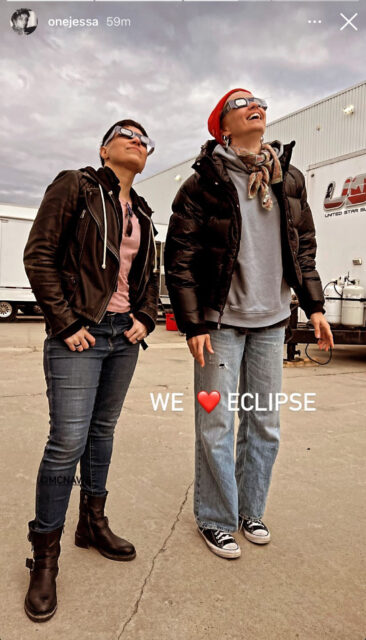
Last week brought big news for Strange New Worlds: It’s been renewed for a fourth season. Paramount+ recently confirmed season 3 will debut in 2025.
Keep up with news about the Star Trek Universe at TrekMovie.com .
Related Articles

All Access Star Trek Podcast , Discovery , Lower Decks , Star Trek Origin Movie , Strange New Worlds
Podcast: All Access Faces The Strange On ‘Star Trek: Discovery’

Strange New Worlds
Actor Talks “Authentic” Scotty On ‘Star Trek: Strange New Worlds’; Season 3 Production Passes Milestone

Lower Decks , Strange New Worlds
‘Star Trek: Strange New Worlds’ Renewed For Season 4; ‘Lower Decks’ To End With Season 5

Awards , Strange New Worlds
‘Star Trek: Strange New Worlds’ Picks Up Two Hugo Award Nominations
I LOVE holodeck dude in cosplay!
I’m curious how long their entire season shooting period actually is.
Usually 5 to 6 months. This one started just before Christmas.
I know I’ll end up watching it, but I’m just not excited for the next season. Season 2 was all over the place, in my opinion. For every episode like Those Old Scientists or Ad Astra Per Aspera, there was rubbish like The Broken Circle and Under the Cloak of War and Tomorrow and Tomorrow and Tomorrow. I like the cast, but the quality isn’t there- and for all the talk of “big swings” and pushing the envelope- Season 2 was almost painfully generic.
Same here. I’ll be tuning in, but it’s not up there on my ‘must-see right away’ list. I feel like overall, the storytelling floundered during S2, legacy characters written badly, and a distinct corny popcorn feel to it. Both Spock and Pike were reduced to bumbling sidekicks. Hoping S3 has a bit more gravitas to it. Like you said, not the fault of the cast. All blame goes back to the writer’s room. I’m more than happy to consider this show as existing in its own separate timeline, as has been confirmed.
I still can’t get over how *boring* the finale was. It felt like it went on for hours and yet nothing actually happened besides a super-quick and appallingly shot fight in zero-g. Season Two really dropped the ball.
I agree. I don’t even remember what happened in the finale, except Pike at the end hesitating like a scared junior officer when the situation called for fast decisive action. As for the season in general, it feels empty, like nothing really happens in the episodes. I hate the way they turned Spock into a moron. There are better ways if the writers wanted to put some humor in… I’m sure the 12 year olds found it funny but adults are watching too…
They seem to be testing the water for the Academy show with teen romances also. Spock, Chapel / La’an, Kirk and Pike, Batel were all shallow romances and just really boring that took up way too much time in the season. They seriously need to get back to writing some good sci fi stories or this show will go down as one of the worse Star Trek series for me. It seems more of a comedy starship show than the Orville at times. And season 1 had so much promise as well.
The SNW writers room has a chalk board titled Gimmick Board only they misspelt it Big Swing Board. Hopefully they can’t destroy Spock’s character anymore as they have already scraped the bottom of the barrel with their writing of his character.
So relieved I’m not the only one who felt this way. I hear “game changer” and “big swing” and I think “great, they’re effing with my show again to bring in the non-Trek fans”!
Yes, to them “big swing” means having the characters do things completely out of character and turning Star Trek into a Broadway play. Sure the musical was original and unexpected, but really out of place, and I will never be able to get the K-Pop Klingons out of my head.
I didn’t mind the musical episode (probably because I love musicals!) but on the whole, the season felt soulless and devoid of anything interesting to say (outside of Ad Astra Per Aspera). It’s as though the entire season was written by committee and was deathly afraid of offending the fandom by doing anything even slightly controversial.
I’ve had this feeling since the first season. Anson Mount is a wonderful lead, but they’ve completed destroyed the character that we got to know in Season 2 of Discovery. And they need to do something with Spock besides him being a complete and utter pig to women.
I’m absolutely giddy for this next season. Season two was fantastic and I cannot wait for this next season.
I really wish studios would get it together. They used to be able to turn out twice the number of eps or sometimes more every year without year-long pauses between seasons.

IMAGES
VIDEO
COMMENTS
THE ESSENTIAL GUIDE. In this guide we cover everything you need to know about the Everest Three Passes Trek in Nepal. This includes a suggested itinerary and practical information about accommodation, costs, what to pack, independent vs. guided treks, transport, and more. We also offer a route map with GPX download for use on the trek.
Three Passes Trek in the Everest region is one of the most adventurous, challenging, and extremely popular trekking trips in the Everest (Khumbu) region of Nepal which includes 3 high passes; Renjo La Pass (5,360m), Cho La Pass (5,420m) and Kongma La Pass (5,535m). Along with these other highlights of this trek are Gokyo Valley, Khumbu glaciers, Gokyo Lake, Kalapatthar, hidden Monasteries ...
EVEREST THREE PASSES TREK ITINERARY. We have outlined below what we feel is an ideal itinerary for the Everest Three Passes trekking route. This is a 19 day itinerary which includes flying to and from Lukla. We have noted the trekking distance and an approximate trekking time for each day (excluding lunch stops, breaks, etc), as well as stats ...
The Three Passes trek is the ultimate Everest experience. This route takes in all the highlights—both in terms of mountain views and local Sherpa culture—and combines them into a complete journey through the Everest region. Keep in mind, this trek is one of the most challenging teahouse treks in Nepal. N. Nick H. United Kingdom.
The Three Passes trek takes trekkers through four valleys in addition to the three passes, Kongma La (18,209 ft / 5,550 m), Cho La (17,782 ft / 5,420 m), and Renjo La (17,560 ft / 5,360 m). Kongma La is generally considered the most difficult (longest), Cho La requires you to cross a glacier (microspikes are helpful here), and Renjo La is ...
Home › Nepal › Everest Three Passes Trek. Nepal's Three Passes Trek is perhaps the greatest trekking adventure you can have in the Khumbu (Everest) region of Nepal. Also known as the Three High Passes, this loop trek wraps around Sagarmatha National Park, leading trekkers over the Khumbu passes of Kongma La at 5,550 m (18,209 ft), Cho La at 5,420 m (17,782 ft), and Renjo La at 5,360 m ...
The three passes trek is a two-week trip that follows the Everest Base Camp route before splitting off and taking you over three passes that give amazing views of the Himalayas and Mount Everest. It's been dubbed one of the most beautiful treks in the world, and for good reason! While going on the Everest Base Camp route is nice because of ...
Everest Three Passes Trek is the ultimate trekking experience to conquer Mount Everest. It's the only three-pass trekking option on the world's highest peak and the only way to visit Everest Base Camp (5,364m) and Kalapatthar Summit (5,545m). The trek offers two stunning routes: Clockwise and anti-clockwise.
The trek is more challenging than the classic Everest Base Camp Trek and its other variations as it involves traversing the three high passes that lend the trek its name - Renjo La, Cho La and Kongma La - each over 5,000m. The trek begins in the popular starting point of Lukla before heading north along the classic trek to Namche Bazaar.
Three Passes Trek offers the ultimate trekking experience in the Everest region. This 3 passes trekking explores the high pass routes in the Himalayas. This is a strenuous and less-trodden high-altitude trek in Nepal. It best suits to experienced trekkers with good physical fitness. The three-pass route links four distinct valleys in the ...
Learn everything you need to know to prepare for the Three Passes Trek. Discover the basics, see the difficulty rating and use our list of tips.
Unser Everest Drei Pässe Trek bietet Ihnen ein umfassendes Trekking-Erlebnis in der Everest-Region. Sie können drei hohe Pässe überqueren - Kongma La, Cho La und Renjo La. Dazu haben Sie noch Gelegenheit, das Everest Base Camp zu besuchen. Wenn wir in Richtung Gokyo Ri und Kala Patthar aufsteigen, haben wir einen atemberaubenden ...
The trail then goes over the Cho La pass into the Dudh Kosi valley. From here it heads up to Everest base camp. Finally it heads back down and crosses the Kongma La pass arriving in the Imja Khola valley. En route you will summit three great peaks: Gokyo Ri, Kala Patar and Chukhung Ri. One for the really devoted trekker.
8 reviews. Three Passes Trek in December. May 8, 2023, 1:33 PM. Hello, A friend and I are considering doing the Three Passes Trek in December (approx. 1-20/12. We have quite some experience doing Alpine hikes but are of course trying to prepare as good as we can, especially taking in to account additional challenges the winter months may bring.
Kongma La is a challenging mountain pass that's actually higher in elevation than Everest Base Camp. It's also the easternmost and highest of the three passes that make up the EBC and Three Passes trek. With all that in mind, today is a very good day for concentration, crampons and trekking poles, as much of the route is rocky and uneven.
Therefore, the cost of Three High Passes Trek is slightly higher that ranging from 1350 $ to 1950 $ per person. The itinerary of the trek is knitted by clubbing together all the itineraries of the above-mentioned treks. Trekkers cross the Kongma la pass at first to reach the Lobuche.
This being said, you will follow the Everest three-passes trek map that takes you along the EBC trail up to Dingboche. You take another route from Dingboche to your first high pass, called Kong Ma La Pass, at 18,209 ft / 5,550 m. This route map is better for proper acclimatization before hiking through high passes.
Three passes trek vs. Everest base camp Length is a total distance of 148 kilometers, per day hike is approximately 11.5 Kilometers, though depending on the altitude area, low altitudes can hike more than 11.5 km, and above the 5,000 altitudes is less km.
Wanderung zum Jagdschloss Holte. Die "Three-Passes"-Wanderung bringt uns auf einem etwa 180 km langen Rundkurs in die Region des Himalaya in der der höchste Berg der Welt liegt. 3 Pässe über 5.000 m Höhe müssen dabei überstiegen werden. Teil 1: Ankunft in den Bergen und Wanderung von Lukla nach Namche Bazaar. weiter lesen.
Day 08 : Trek to Chhukung (4,730 m) from Dingboche - 4 to 5 hours. Overnight at a guesthouse. Day 09 : Trek to Lobuche (4,910 m) via Cross Kongma La pass (5,535 m) - 7 to 8 hours. Overnight at a guesthouse. Day 10 : Trek to Everest Base Camp (5,364 m) and then back to Gorak Shep (5,164 m) - 8 to 9 hours.
The trek then heads towards Thame and then Nangpa Valley. Conquering the Three Passes: A High-Altitude Himalayan Odyssey. Three Passes Trek of Everest Base Camp. After this, you'll encounter Renjo La (5340m) - the first of the three high passes - particularly challenging. Therefore, a good level of fitness is vital while crossing the passes.
This trek takes you through three high mountain passes, including Kongma La Pass (5,535m), Renjo La Pass (5,385m), and Cho La Pass (5,360m). This trek will take you to other significant landmarks of this region, including Mt. Everest Base Camp (5364m), Kalapathar (5,643m), Gokyo lakes, and others.
Three days of fun-filled, fan culture begins next week at FAN EXPO Philadelphia and we'll be there helping host celebrity Q&As and conducting interviews. We want you to be there too, so we're going to give away passes!. We've partnered with FAN EXPO to host a giveaway for a pair of 3-day passes to the event taking place of May the 4th weekend, and the timing couldn't be better with a guest ...
Anson has a challenge for cosplayers. There have also been a couple of fun recent social media updates from the cast. First up, Anson Mount posted on Twitter/X that season 3 will require ...